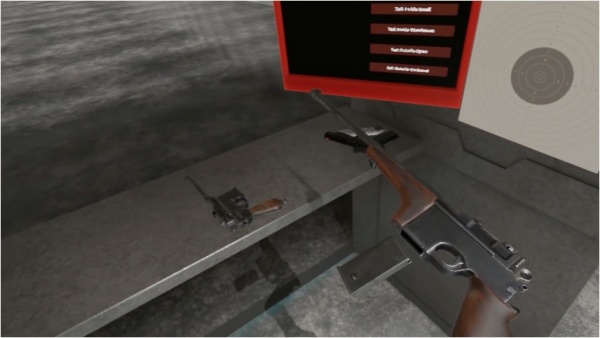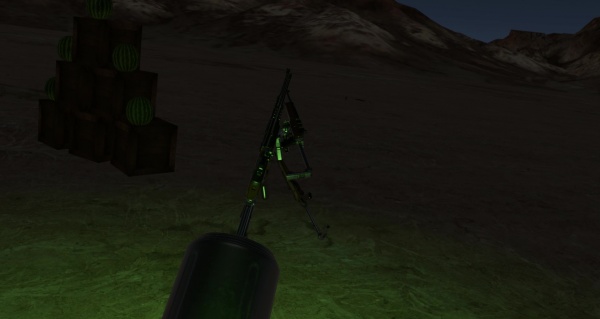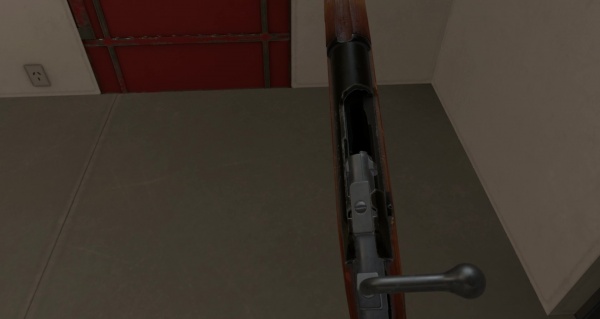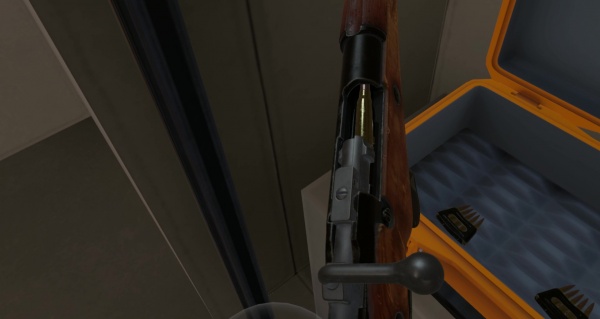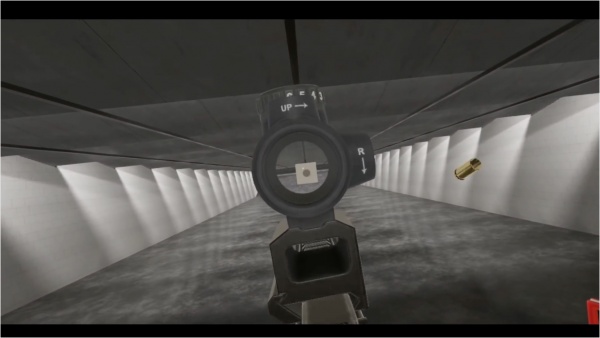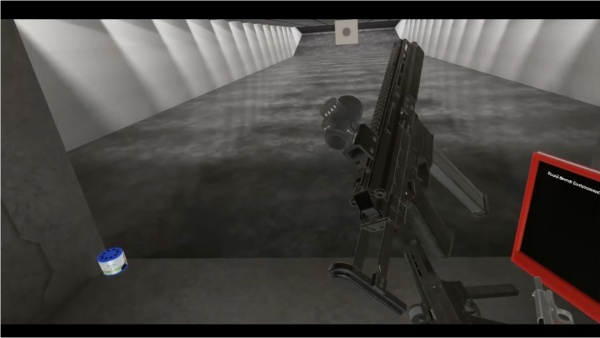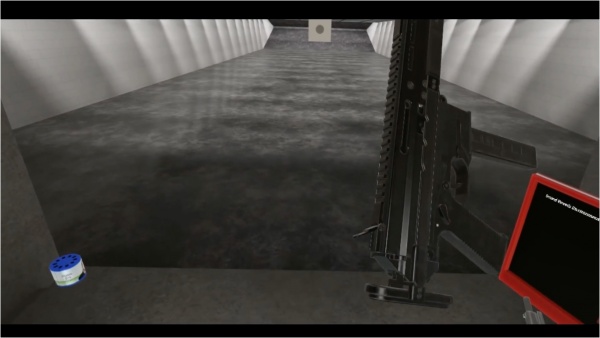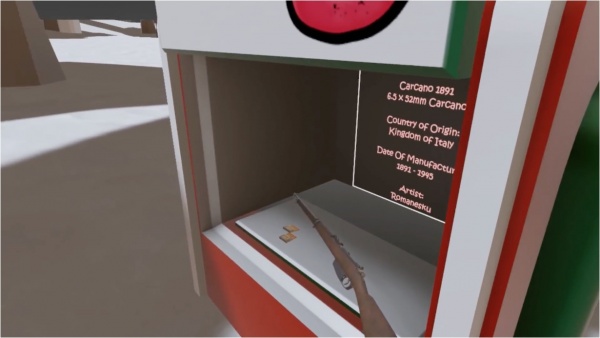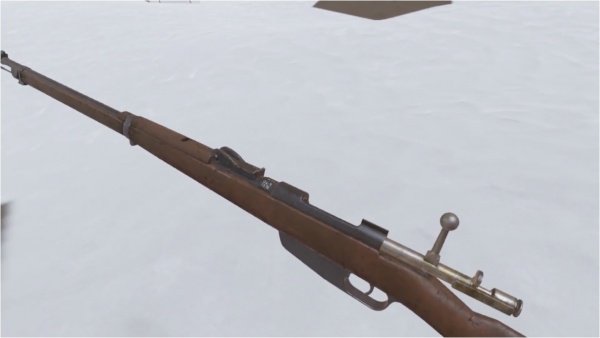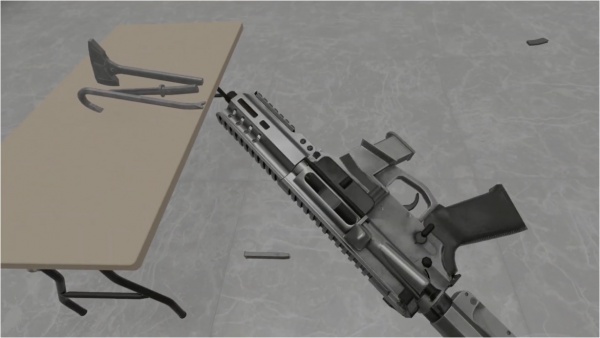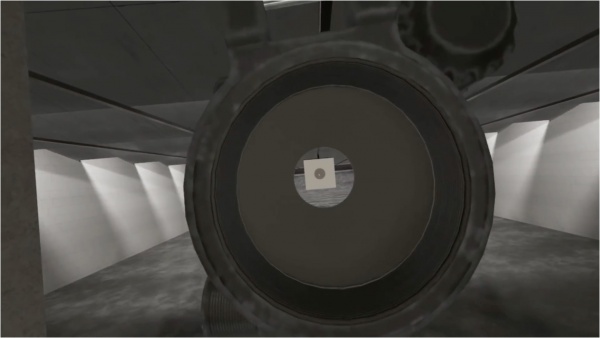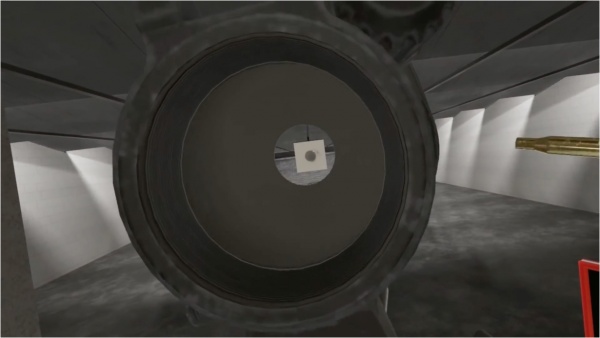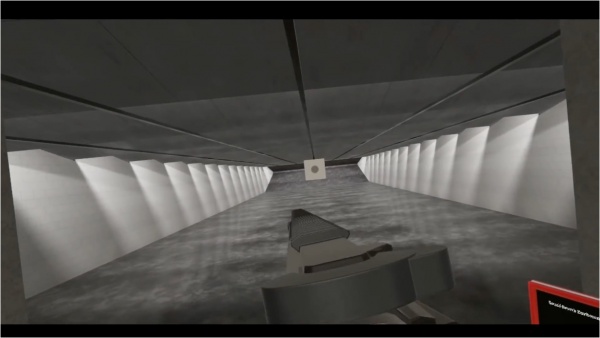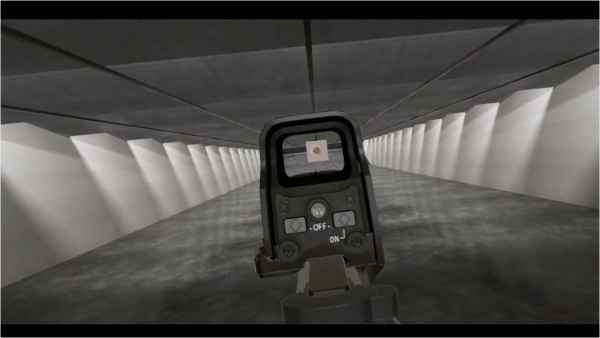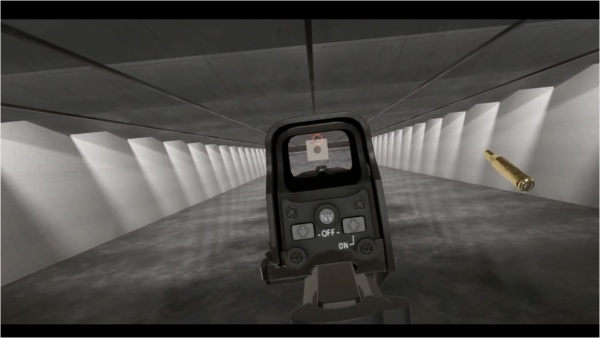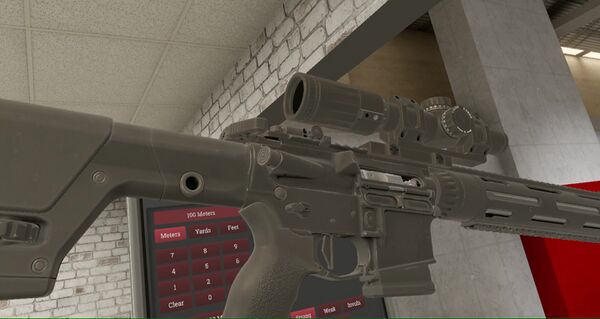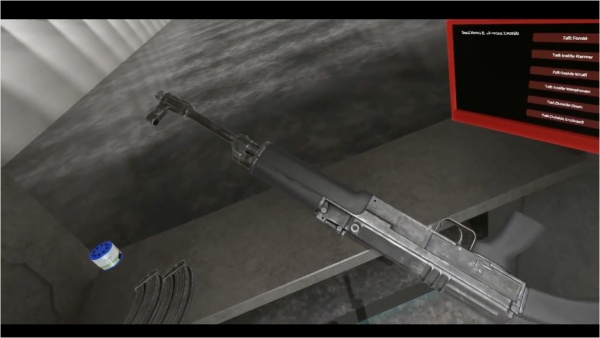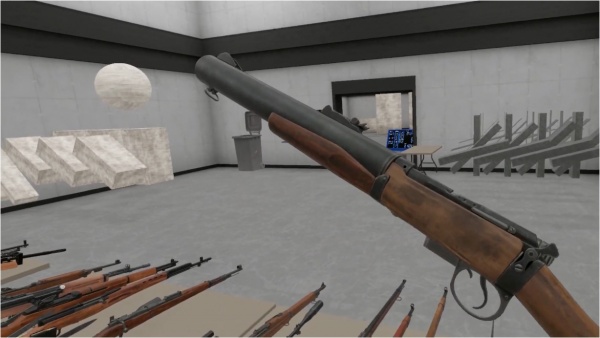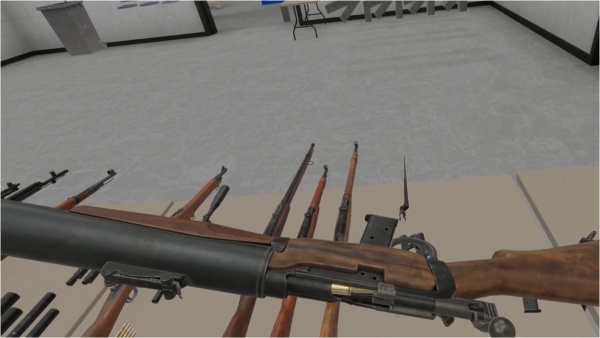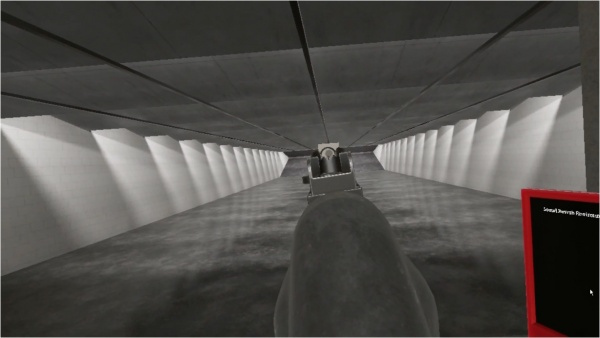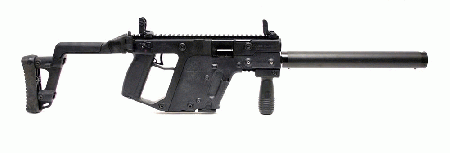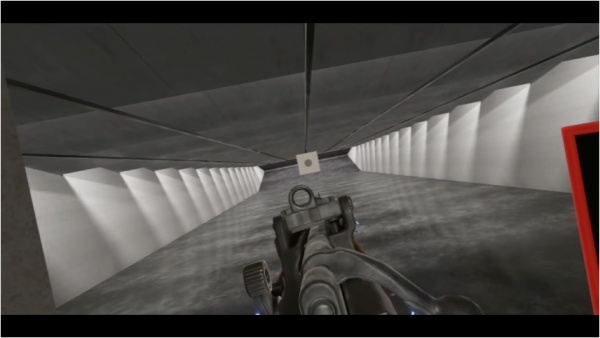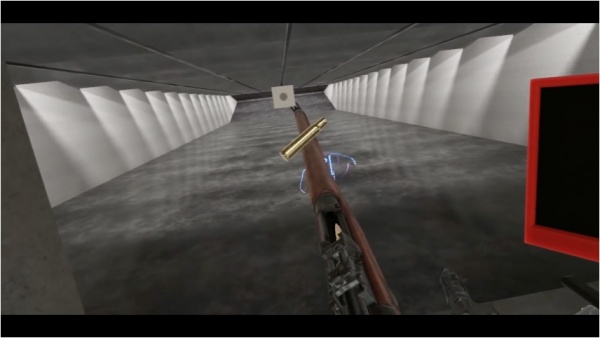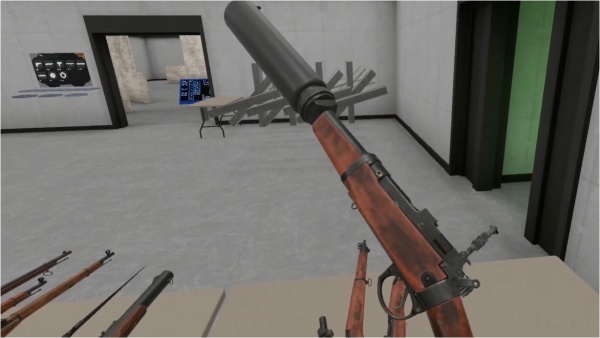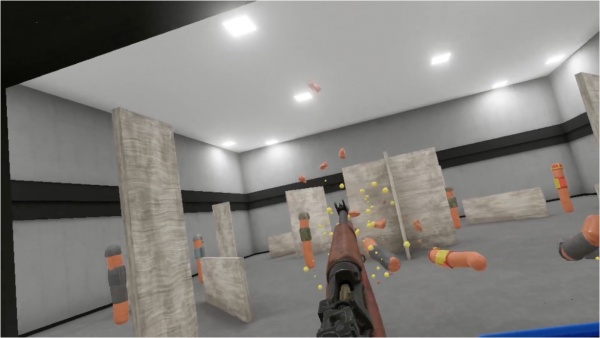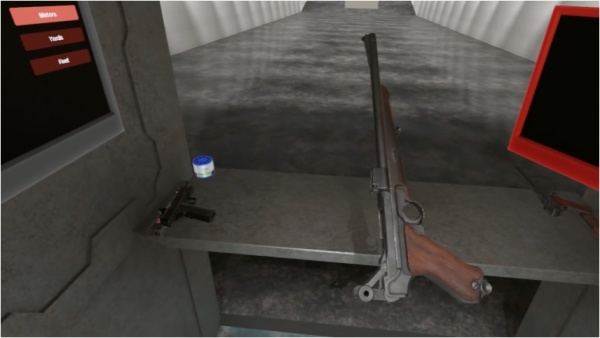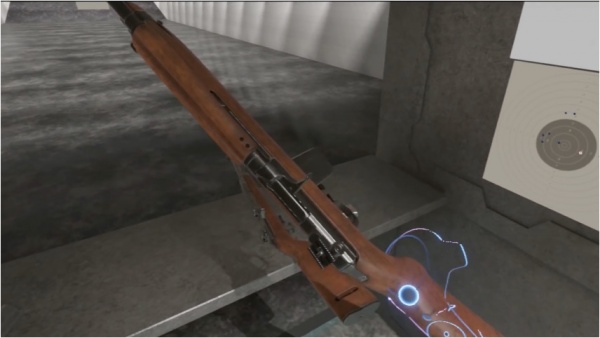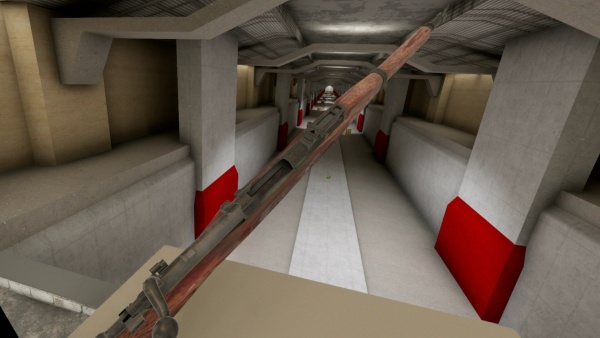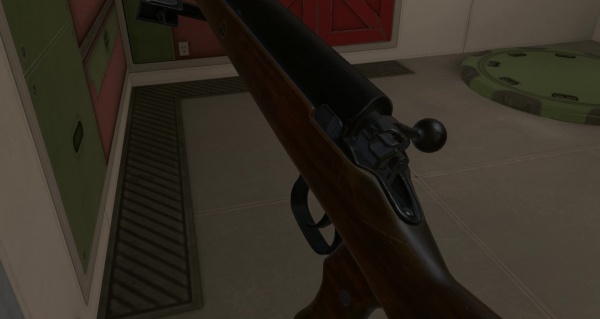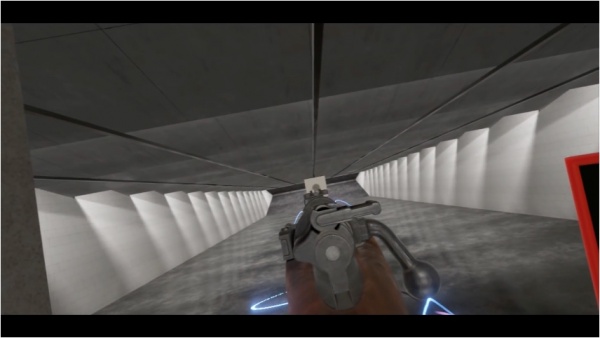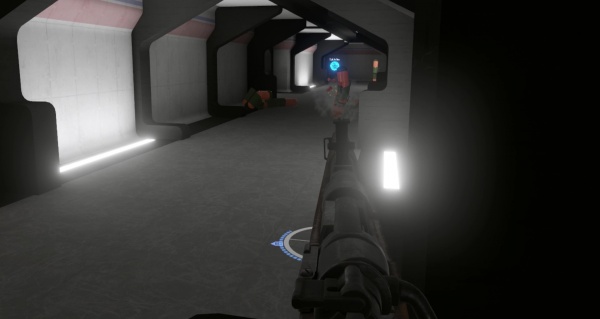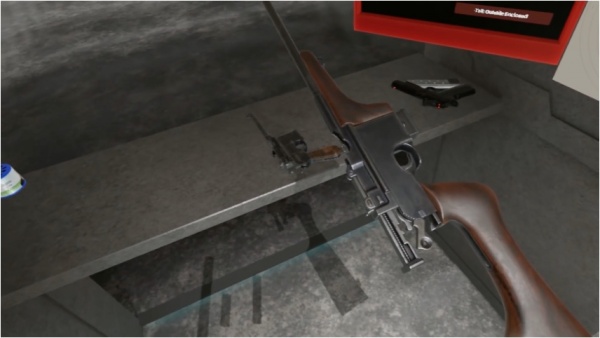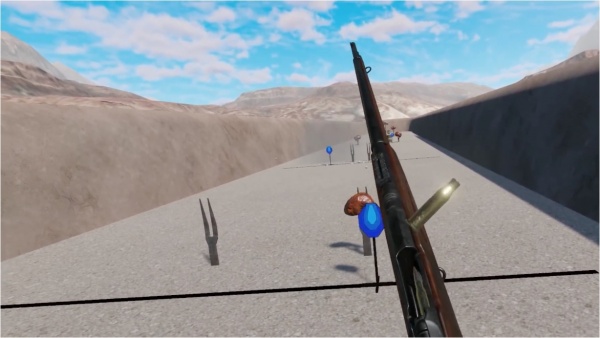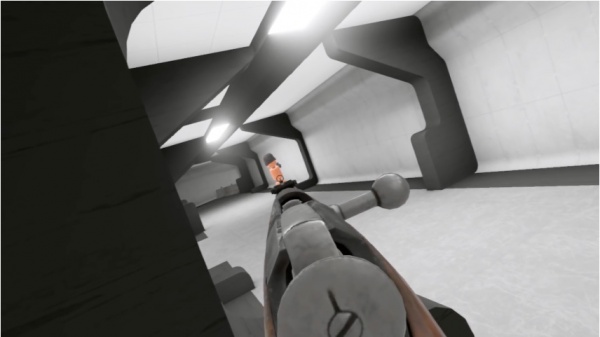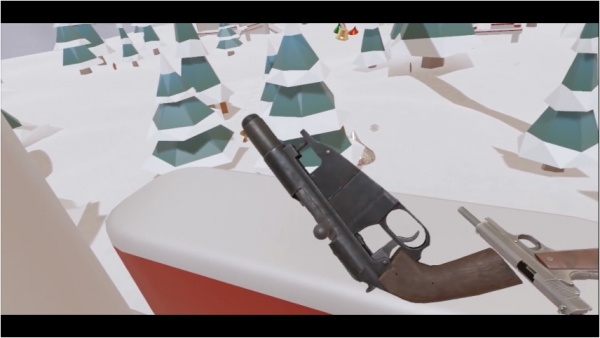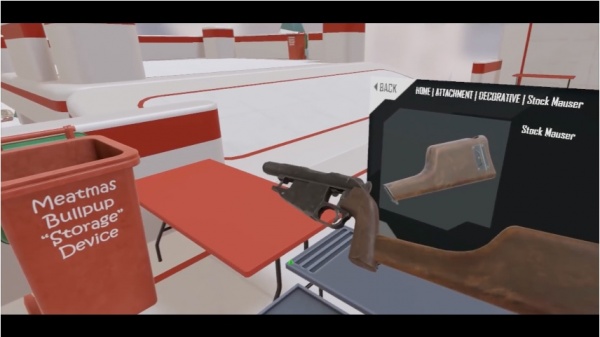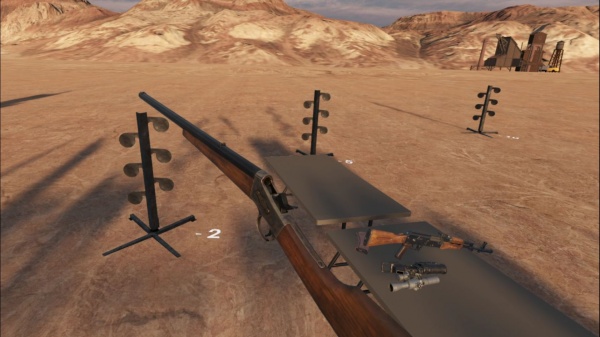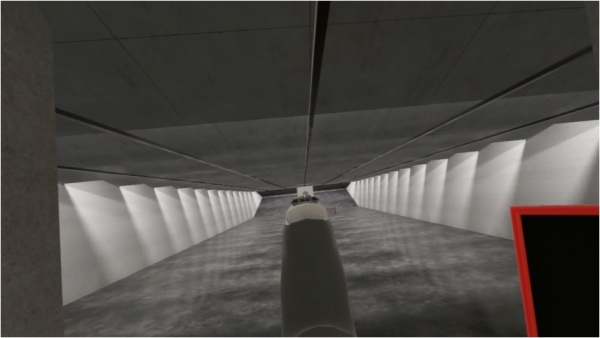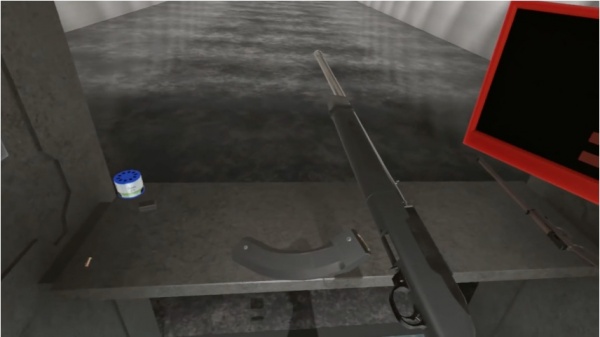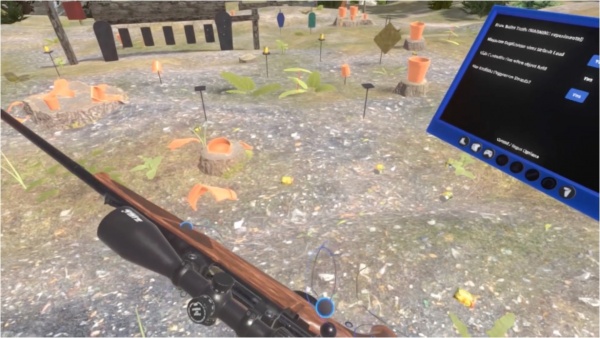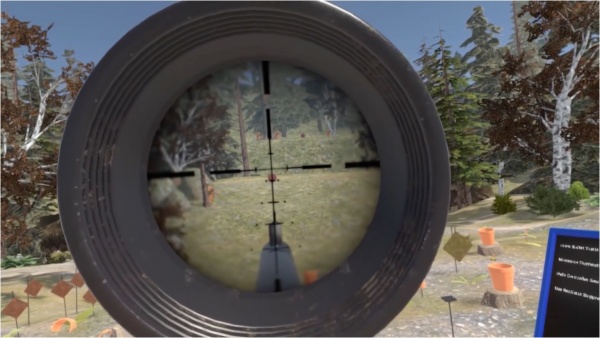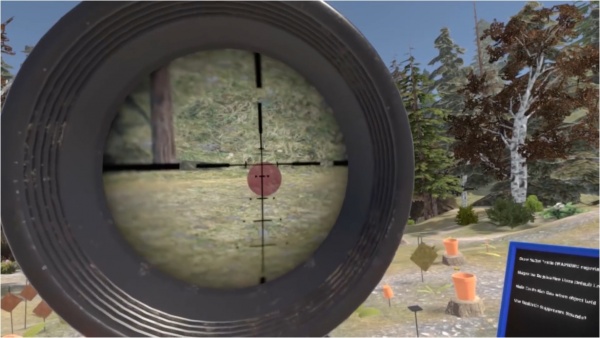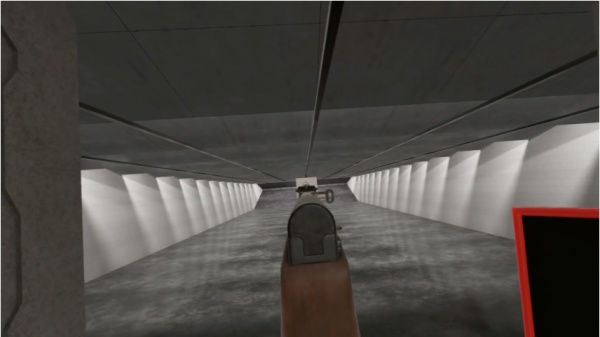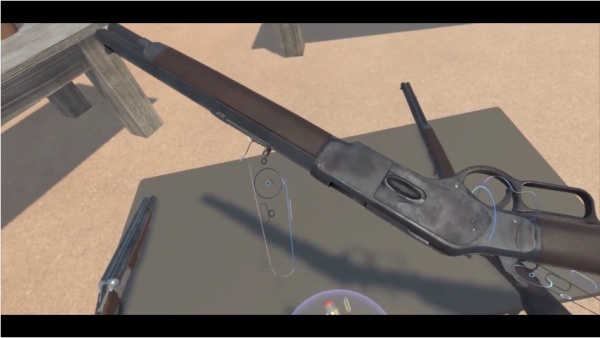Rifles & Carbines
Weapons on this sub-page are a mixed bag in terms of in-game classification; they span across the in-game categories of carbines, bolt-actions, lever-actions, breech-loaders, and even pistols (in both the automatic and bolt-action subcategories). The Carbine category includes any pistol-caliber carbine or intermediate carbine, as well as full-length intermediate rifles that are not fully automatic (such as the SKS or sporting rifles).
ArmaLite AR-180
The final of the 4 AR-18 variants added in Update #102's first experimental build was an ArmaLite AR-180, the civilian semi-auto variant of the basic rifle.

Sterling-produced ArmaLite AR-180 - 5.56x45mm NATO

Like an AR-18, but more... civilianized? Civilized? Domesticated, maybe?
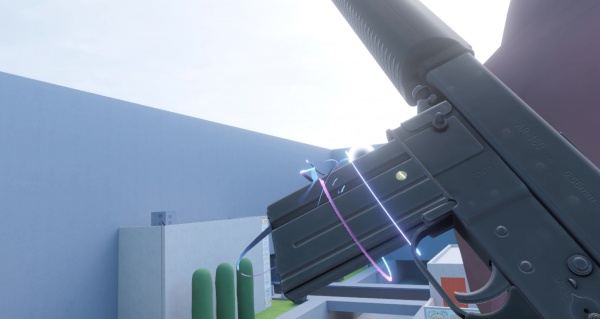
Loading in a 20-round magazine; this may be a civilian rifle, but it's not a compliant enough one to have 10-rounders. (Also, AR-180s were out of production by the time capacity restrictions started cropping up, and any subsequent modern versions just took STANAGs anyway.)
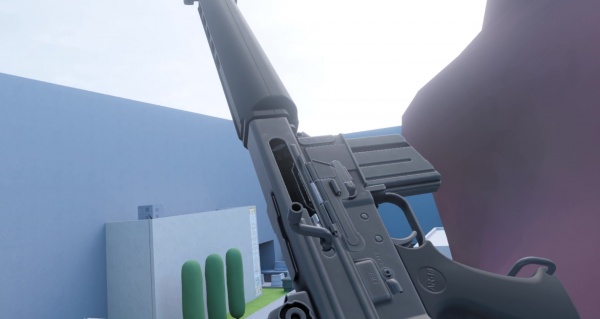
Chambering one of the aforementioned 20 rounds...
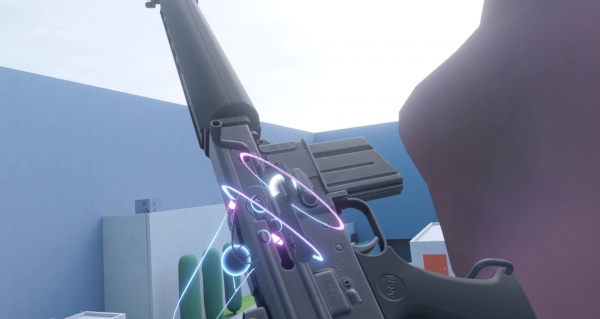
...and then shutting the dustcover, as any responsible citizen should.

The stock can also fold, though of course, any respectable citizen should have nothing to hide, and thus no reason to use this function.
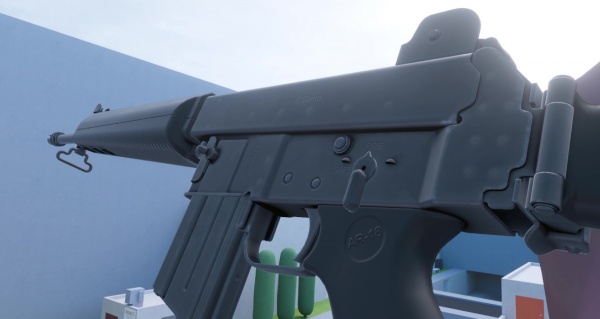
With all the proper protocols dealt with, the safety can safely be de-safed. Note the "SAFE" and "FIRE" markings on the selector, and the "AR-180" marking on the receiver, confirming that this is a proper AR-180, and not simply a copy-paste of the game's AR-18 model with only two selector positions programmed.
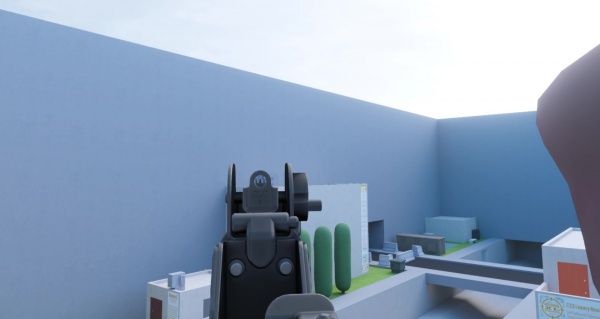
Taking careful aim through the aperture-and-post irons at a proper target - namely, a neighbor's air-conditioning unit.
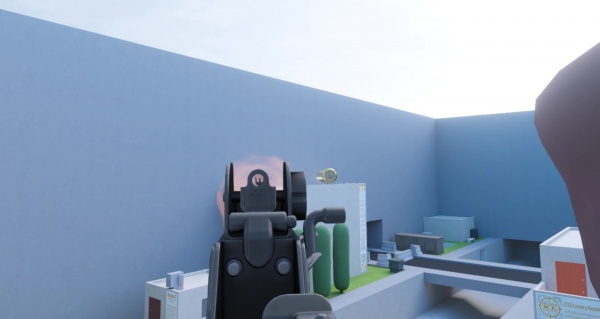
Normally, this would be considered rather un-neighborly behavior, but fair's fair.

Should you desire a more precise shot, the smaller aperture option may be for you.
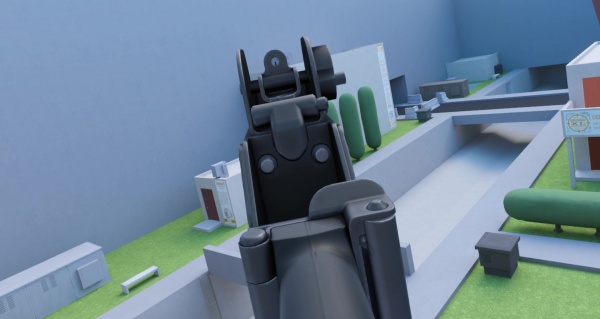
Provided, that is, that your precise shot is precisely 400 meters away, give or take.
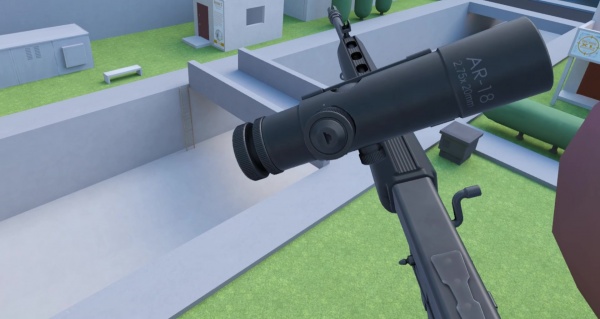
Finding neither quite suitable for his needs, the feuding neighbor decides that some glass is in order. This scope fits on the AR-180's proprietary dovetail rail, a rail so proprietary that every other variant of the rifle shares it.

It offers a simple, fine crosshair reticle, with 2.75x magnification - nothing extraordinary, but perfectly suitable for filing your grievances with the HOA.
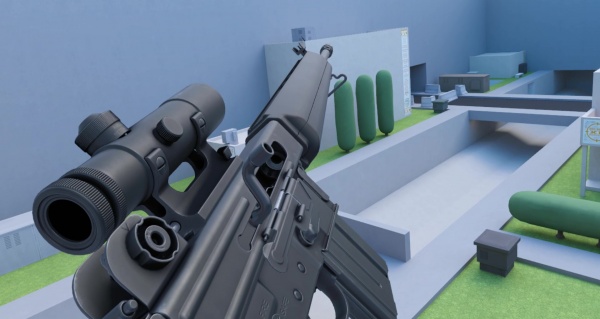
Having expended 20 rounds' worth of matters from his own hands, the beleaguered citizen's rifle locks open.

"That'll teach him to shoot at my load-bearing AC unit..." 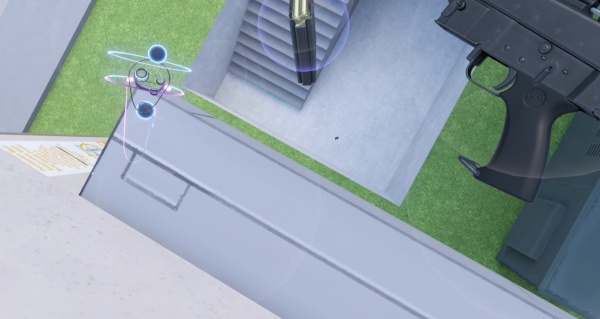
"...which I'm still standing on. Right. Should probably head inside now." Armscor M1600
Added in Update #98 as a belated April Fools' Day present, the Armscor M1600 is available in two forms - the standard "M1600", and a modified version called the "M1600A3000", which features a collapsible wire stock, a full wrap-around handguard, an optics rail in place of the carrying handle, a shortened barrel, and a railed handguard.

Out at the range with the M1600. It's... well... I'm sure it has a great personality.
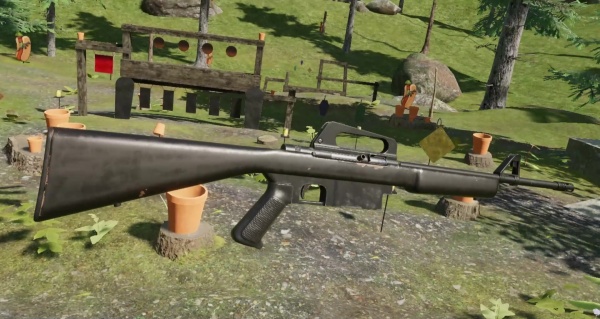
Yeah, for sure - underneath all that gradually-peeling black stock paint is a heart of gold.
"(And a lot of recessive alleles.)" "What was that?" "Nothing!"
Disengaging the M1600's simple two-position safety. Not trying to use that word in a derogatory sense or anything.

Loading in a...
(
"...is that really what it looks like? ...you sure? Alright... here we go, straight face...")
*ahem* Loading in a standard 15-round magazine; these are a proprietary design, with a STANAG-esque lower section that includes the magazine release, and an adapted target pistol magazine at the top.
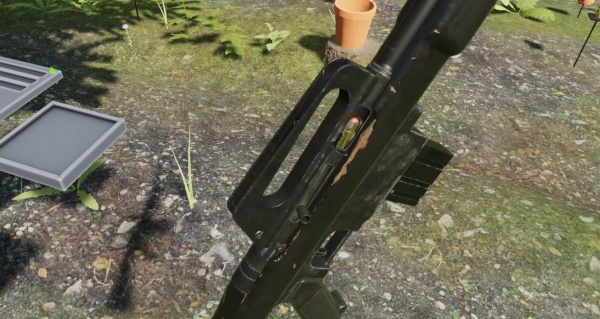
Pulling the charging handle; being...
derived from a typical tube-receiver .22 semi-auto design, this is a reciprocating affair, mounted on the right side.
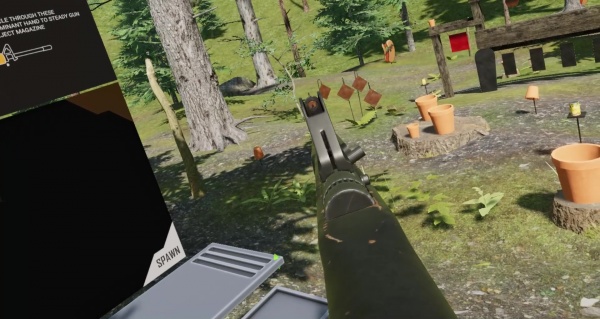
Aiming at a steel plate; the M1600 features M16-style sights that are surprisingly quite usable. Err... surprising if you didn't have high expectations of it, that is! Which I certainly didn't! Because I can tell a strong, brave, capable little gun when I see one!
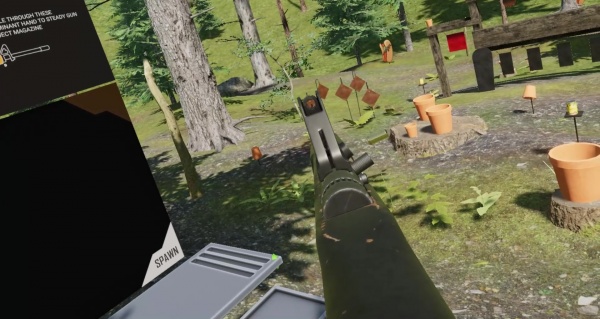
And, speaking of capable, here's the M1600 firing! Great job!
"(Not like you could really screw that up, no matter how-) Nothing! Just thinking about what I'm gonna do after work, that's all!"
Armscor M1600 with full wrap-around handguard and collapsible stock - .22 LR
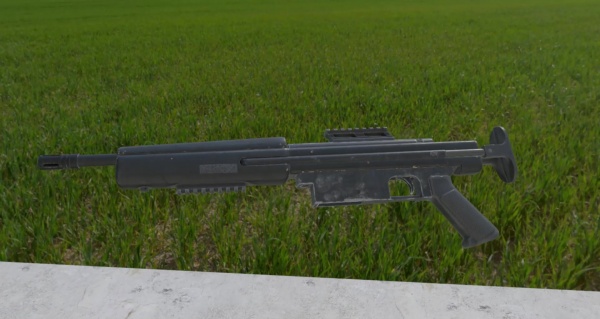
Behold, the weapon of the future!

Extending the M1600A3000's stock, after double-checking to make sure that there aren't too many zeroes in there.

Disengaging the safety. Note that it doesn't go all the way forward; this'll be important later.
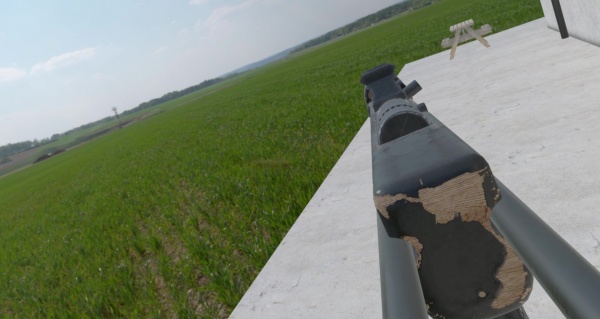
Aiming down the... hmm. Something's not right here.
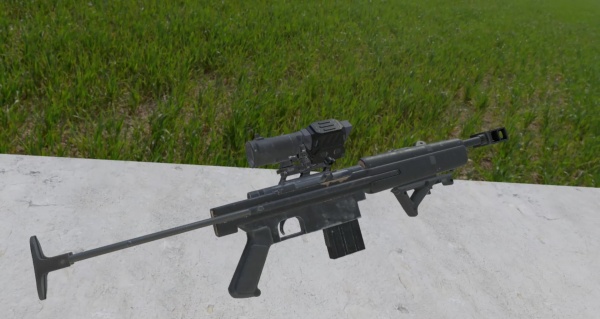
Hmmm... better, but still not quite there yet.
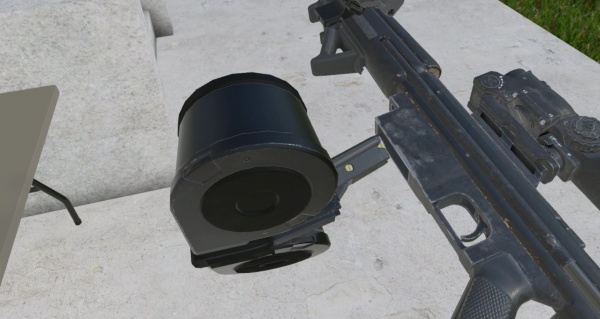
Ah-HAH! That's it, capacity! After all, who needs a 15-round box magazine when you can have a 150-round converted Beta-C! Which would really make it a Beta-C-and-a-half, I suppose.
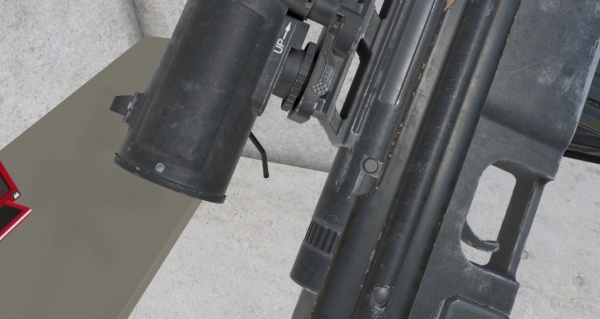
Fully disengaging the safety; the half-forward position on the A3000 is semi-auto, and the fully-forward position sets it to 3-round-burst. This technically makes it the game's second/third .22 LR submachine gun, depending on how you count the two American-180 variants.

Aiming at a hostile Sosig with 3 of the 4 available options - the ELCAN SpecterDR 4-power scope, canted DI Optical EG1 reflex sight, and AN/PEQ-15 laser sight are all in play, with only the backup irons on the ELCAN being left high and dry. Don't worry - they'll get their fun.
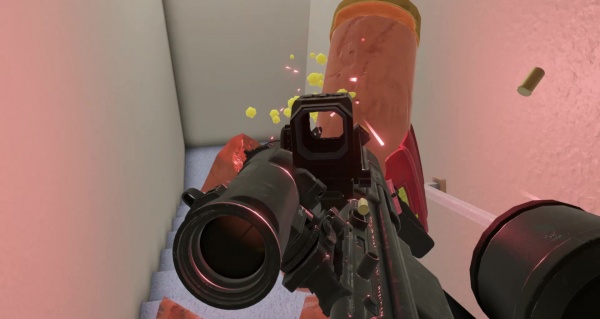
The breaching exercise went well for the breacher; unfortunately for this particular Sosig, his goals and the breacher's didn't exactly line up. Hence the present holiness of his face.
Bendix-Hyde 2nd Model Light Rifle
The second version of the Bendix-Hyde Light Rifle, a prototype carbine entered into the US Light Rifle Program trials, was made available in Update #52's 11th alpha build.
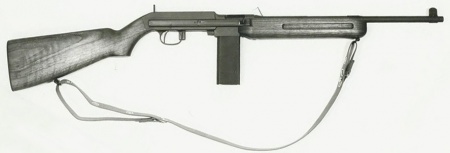
Bendix-Hyde Light Rifle (2nd Model) - .30 Carbine
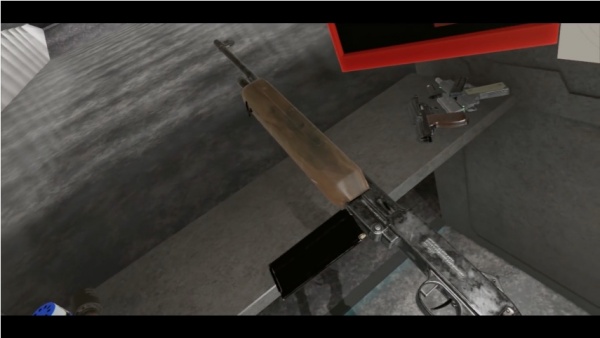
Jamming a magazine into the carbine...
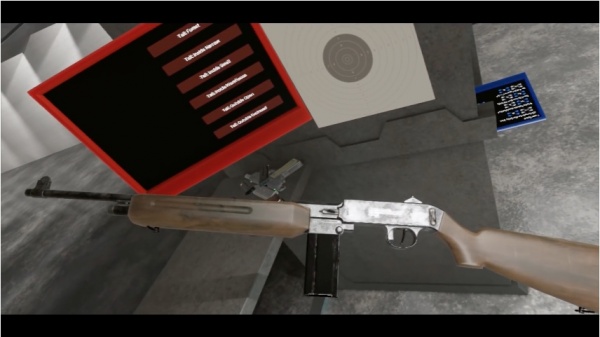
...before taking a good look at its...
interesting proportions.
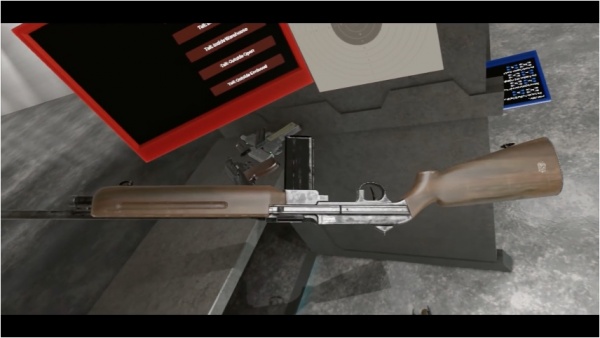
The Hyde's other side, which shows off the charging handle. This was one of the many things changed from the first variant; that one had a non-reciprocating charging handle, which the testing board requested to be changed, citing a need to be able to manually force the bolt closed if necessary.
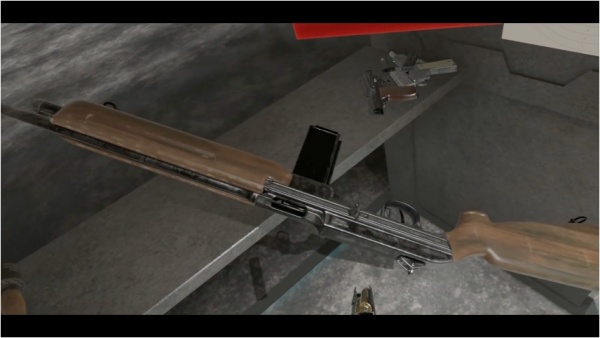
Speaking of the charging handle, it's high time for it to get pulled.
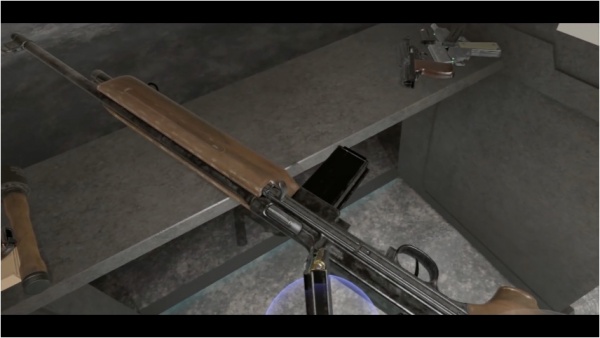
Turning off the safety, which is a piece inside of the trigger guard, rather reminiscent of the
M1 Garand (or, for that matter, the
M1 Carbine that defeated the Hyde in trials).
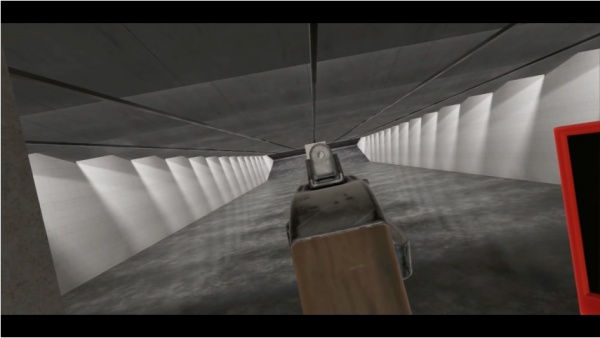
Looking through the Hyde's rear aperture sight...
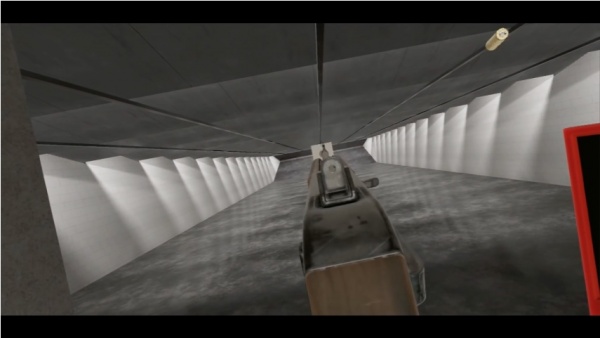
Firing a shot, thankful that doing so doesn't cause it to transform into a Jekyll Carbine.
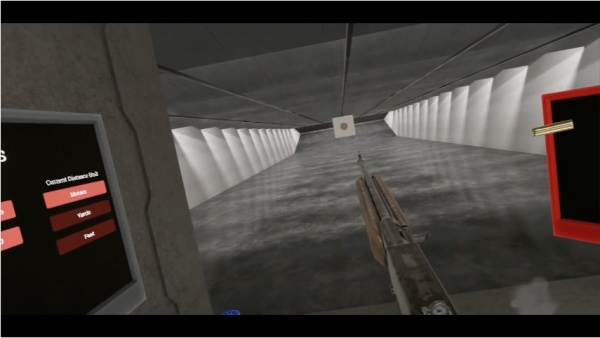
"Y'know, just because one of the complaints about the 2nd model was that it was less accurate than the first, does
not mean that it's okay to do that."
Beretta Cx4 Storm
The Beretta Cx4 Storm semi-auto carbine is available in-game, added in Update #20; it was, until the release of Update #52, permanently fitted with a foregrip. It is correctly capable of sharing magazines with the Px4 Storm added in the same update, as well as the M9A1 added earlier and the Mx4 Storm added later.
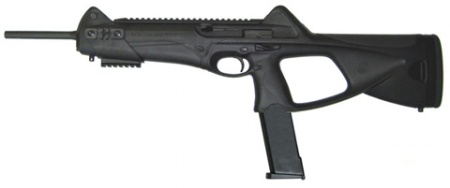
Beretta Cx4 Storm - 9x19mm Parabellum

A Cx4 Storm rests on a table. Not much else to say here.
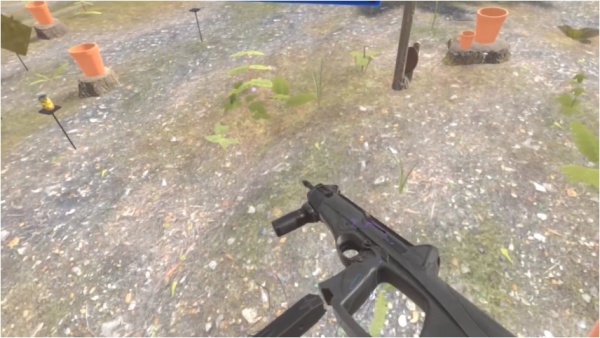
Loading a magazine into the carbine.
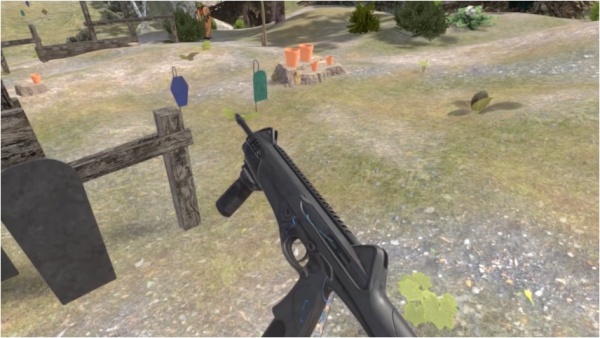
His weapon loaded, Hick-not45 proceeds down range with his Cx4, determined to get a hit on the gong.
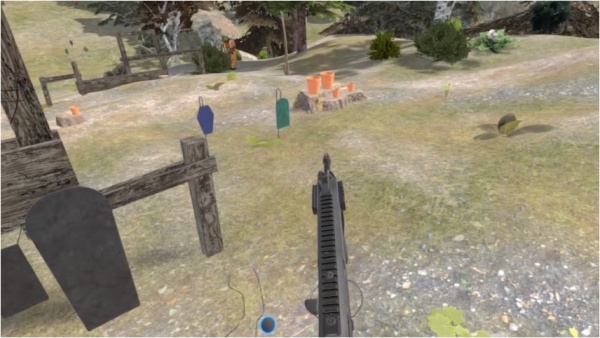
He then remembers to pull the charging handle.
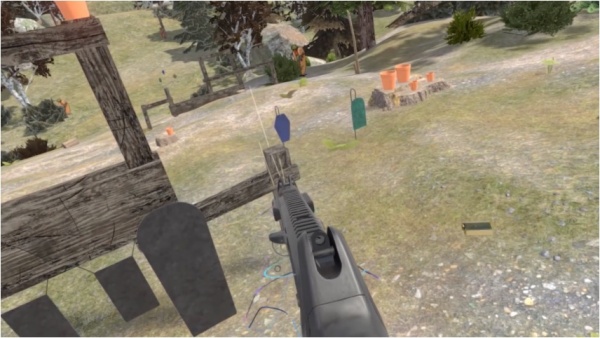
Firing the Cx4; the bullet trails demonstrate one of
H3's interesting mechanics: the ballistics system. The system assigns a material to every object in the game, and has rounds react accordingly; in this case, the FMJ 9x19mm rounds pierce through this wooden post, and are redirected this way and that in the process.
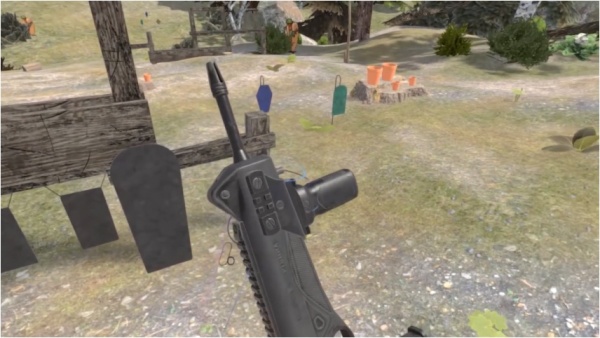
A close-up shot of the Cx4's foregrip; not only did Update #52 remove this, but it also removed the rail system it's attached to.
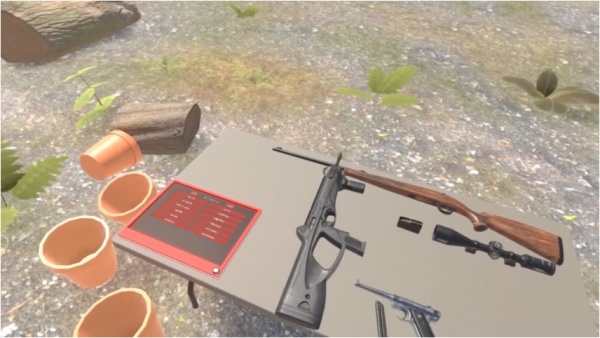
With that, Hick-not45 sets the carbine back on the table, and moves on.
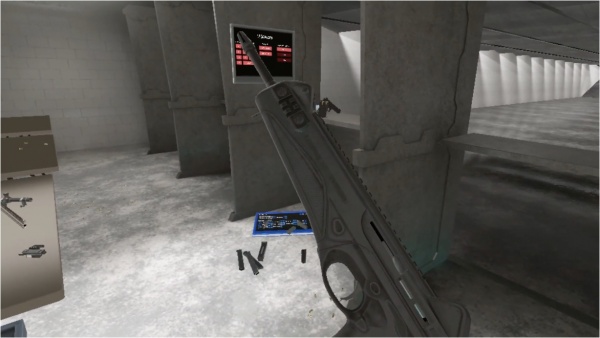
Examining (and cocking) the updated Cx4, in a far more demure setting. The main alteration caused by this update was the removal of both the foregrip and the rail system it was attached to...
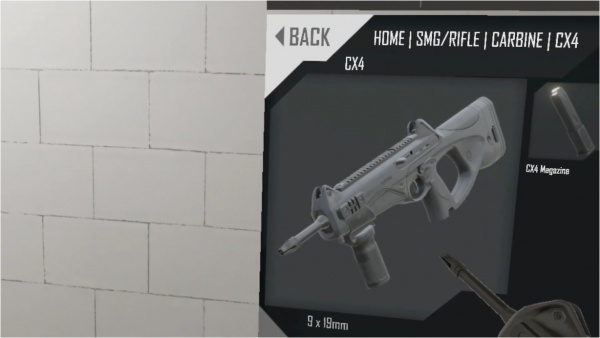
...though the item spawner evidently hasn't gotten the memo.
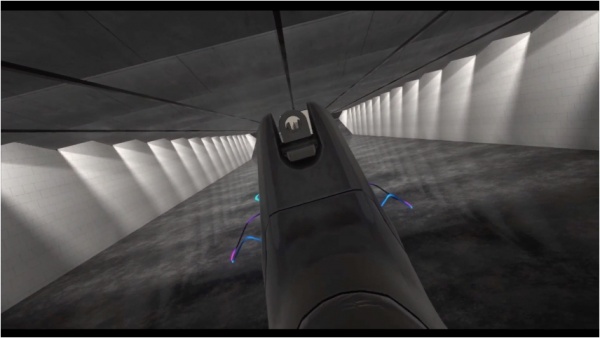
The sights of the Cx4. These didn't change or anything, we just thought that you'd like to see them.
Berthier Model 1916 Carbine
The Berthier Mle 1916 was added on day 8 of the Meatmas 2020 Advent Calendar event. It is the game's second bolt-action rifle to use en-bloc clips, and its second rifle chambered in 8x50mmR Lebel.

Berthier Model 1916 Carabine - 8x50mmR Lebel
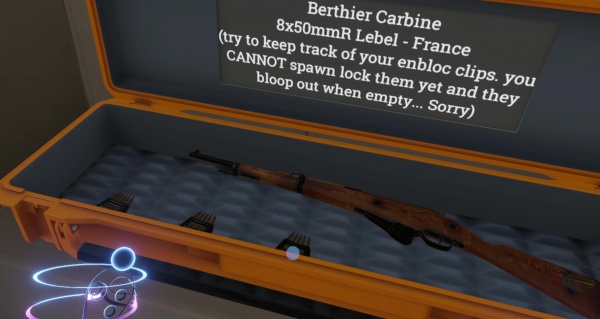
The Berthier in its gift crate, complete with quite possibly the first ever use of the word "bloop" in reference to an en-bloc clip.

Examining the Berthier. This variant is set up as a cavalry carbine, as evidenced by the side-mounted sling points (a large ring at the front, and a fixed bar at the rear).
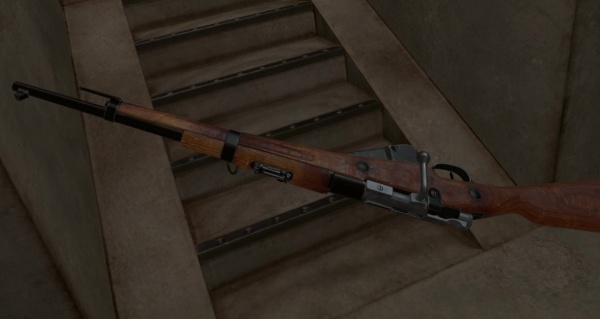
Flipping it over gives a good look at the
Lebel-esque bolt; this makes sense, as the Berthier was originally designed as a box-magazine conversion of the Lebel.

Shoving in a 5-round en-bloc clip; this was one of the primary improvements of the M1916 over earlier Berthiers, which used 3-rounders. The receiver markings are also visible in this shot, showing that this particular Berthier was manufactured at the St. Etienne arsenal.
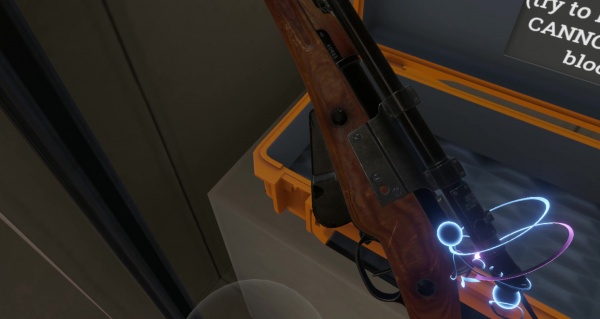
To help deal with the various threats scattered across the vast, open expanses of the Winter Wasteland, the Berthier was made compatible with the Weaver 330 scope; it apparently just screws into the stock.

Testing out the carbine's irons; while they're a bit hard to make out here, they're fantastic in-game, with a large, chunky, easy-to-acquire notch-and-post setup (reminiscent of a modern handgun, minus the high-contrast paint) for close-range engagements, and a small notch in the front sight for lining up more precise shots.

Eagle-eyed viewers may have noticed that the carbine in the above screenshot was uncocked; this is why.

Blasting the Swarm drone that someone rather inconsiderately placed directly outside of a bunker; as one would expect for such a short, light, handy little rifle in a full-powered cartridge, the Berthier is loud and jumpy.

Flashback sequence over, the Berthier can be cycled.

Chamberloading a single 8x50mmR tracer round; between the prior shot and this one came four additional shots, since single-loading a gun like this only really makes sense when there's no en-bloc clip in the magazine.

Taking aim at a distant Static drone. The practical utility of a single tracer for such an application is questionable, to say the least.
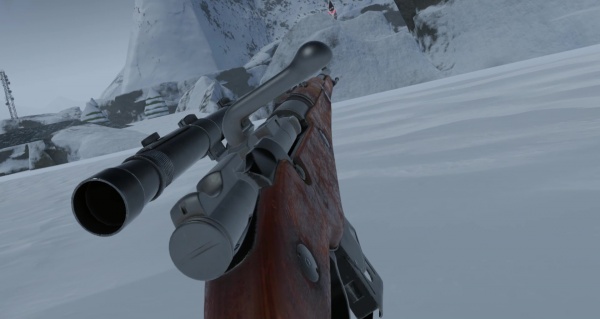
This is further supported by the fact that, in the subsequent interim, another four FMJs were fired, causing the next en-bloc clip to pop out as the fifth round is chambered. Due to the way this ejection is programmed in-game, the clip tends to, well, clip.
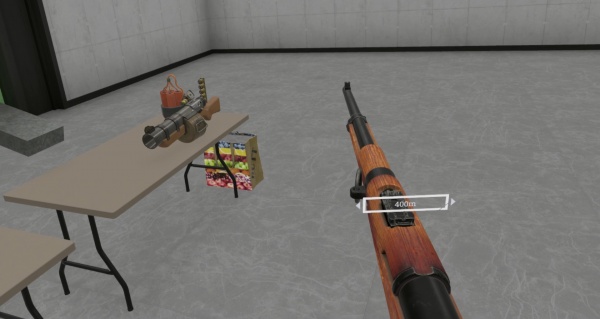
Fiddling with the weapon's sights over in the Proving Grounds. Note the arrows on both sides of the adjustment box; despite starting at a 400-meter zero, it goes down to 300 meters.

The sights max out at 800 meters; a bit optimistic, but far more reasonable than most full-length rifles of its day.
Brown Bess Flintlock Musket
The Brown Bess Flintlock Musket was added on Meatmas Day 2020. It is the second flintlock firearm added to the game and the first flintlock long arm.

Modern reproduction "Long Land Pattern" Brown Bess Infantry musket made from 1722-1768 - .75 caliber.
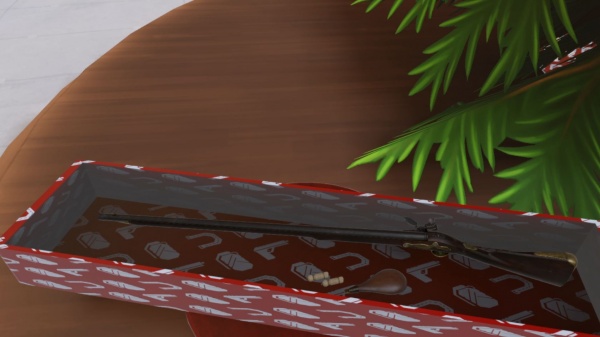
Allo, wot's oll this then? Cor blimey, its a Brown Bess, innit?
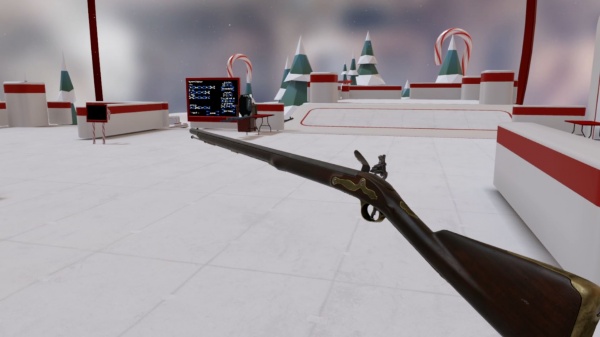
Being the longer version of the Flintlock pistol, the Brown Bess is mechanicaly identically in every major factet.
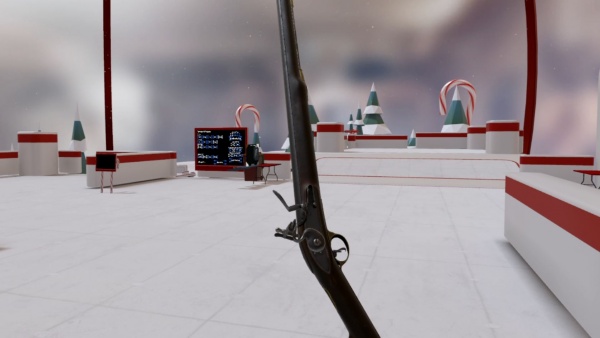
Just, you know... much bigger.

Okay, starting off this long and drawn out loading process, we begin by pouring a few grains of black powder into the flashpan.
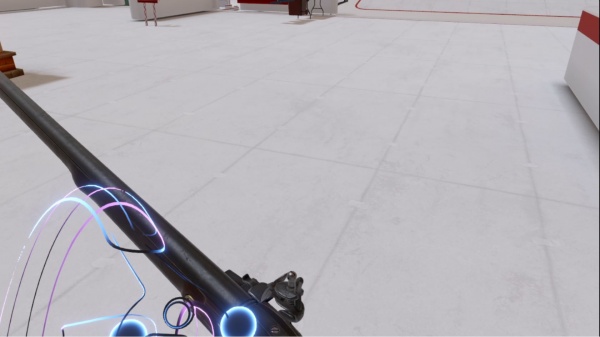
The Frizzen is closed shut, or else all the black powder in the flashpan is going to fall out in the next step.

Removing the ramrod from its hold is a bit more complicated this time around, seeing as its nearly as long as the barrel.
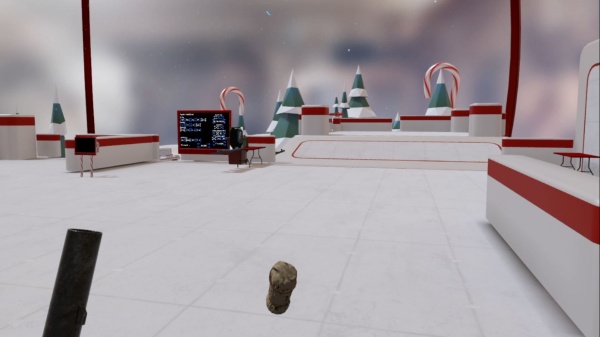
While we could just use loose powder and musket ball, we're provided with a paper cartridge for a somewhat easier loading process.
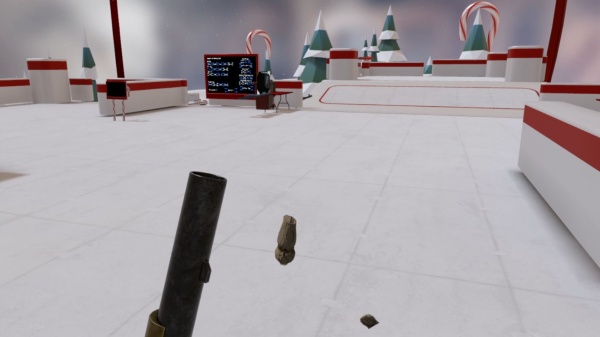
To open, bit off the tip of the paper cartridge. The player spits out the paper immediately. Which is what you should do, because black powder tastes nasty.

Next, dump the powder into the barrel, then place the cartridge and ball into the barrel.
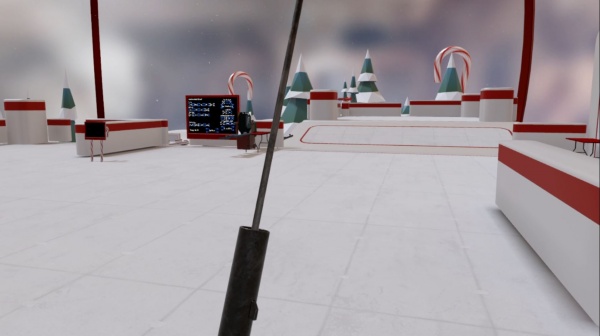
Now we just need to ram that sucker all the way down into the barrel. Because we've got several more feet of barrel to ram, this takes a fair bit longer than on the pistol.

When the ramrod is just barely poking out, you've got the ball all the way down.
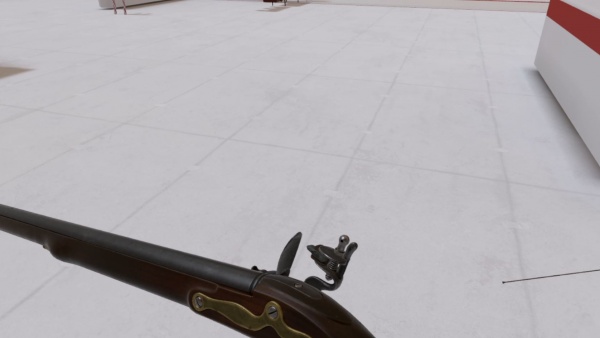
Final step is to pull the hammer into full cock, and we're ready to shoot.
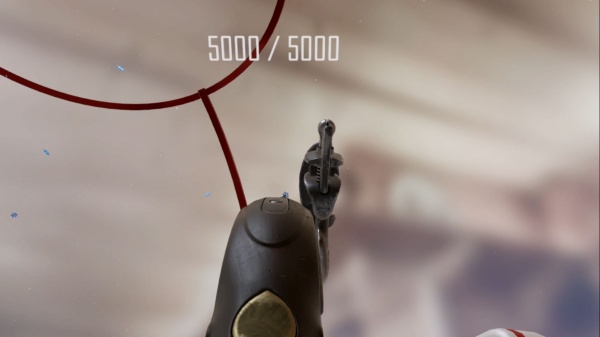
Even with just the rudimentary front sight, the long length of the barrel does make aiming a little bit more accurate.
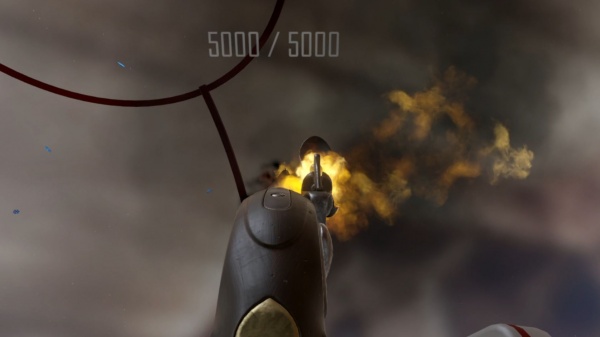
There's a slight delay between pulling the trigger and firing the musketball, depending on how much powder is in the flashpan. Either way, you're going to get a lot of smoke.

And for an unrifled barrel, its not too difficult to hit targets from farther away.
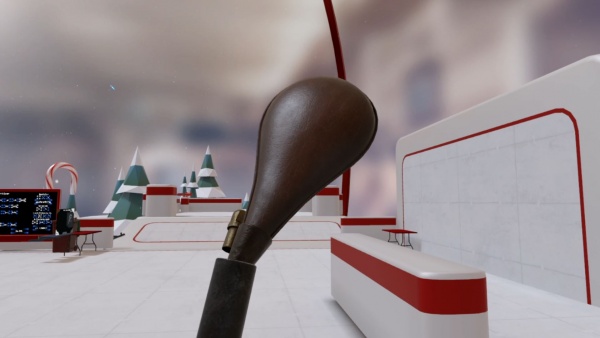
But what happens if we put in
way too much powder?
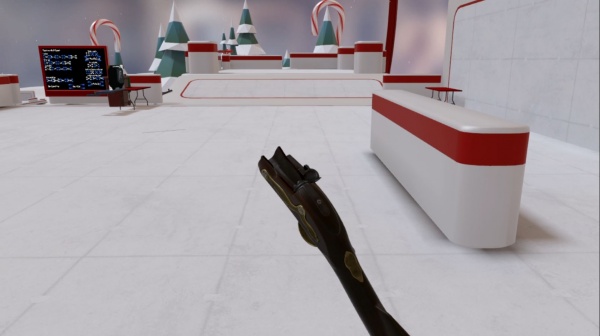
That definitely doesn't look good.
Brügger & Thomet APC45 Carbine
Update #61 added a pair of Brügger & Thomet APC-series pistol-caliber carbines, one of which is an APC45. This is possibly the APC45's first known appearance in any form of media.
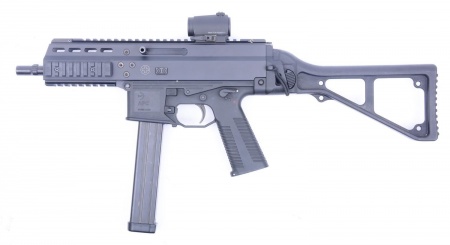
Brügger & Thomet APC45 Carbine - .45 ACP
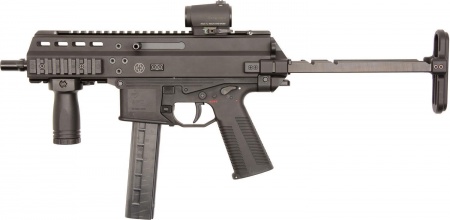
Brügger & Thomet APC9 SMG - 9x19mm Parabellum. Image provided to show the collapsible stock seen on the in-game APC45.
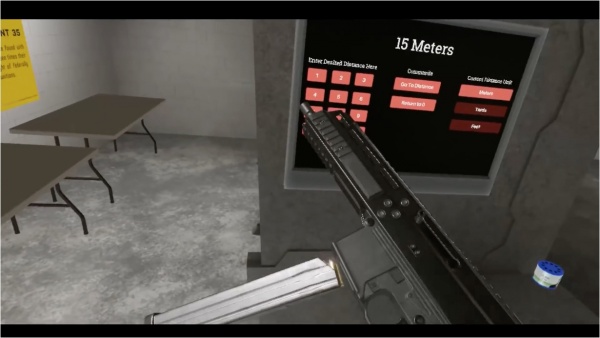
Loading a magazine into the APC45...
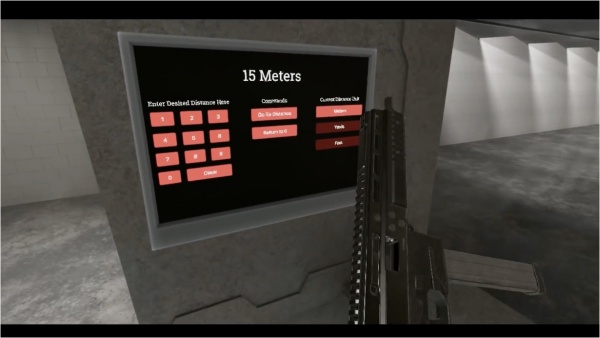
...and pulling the charging handle.
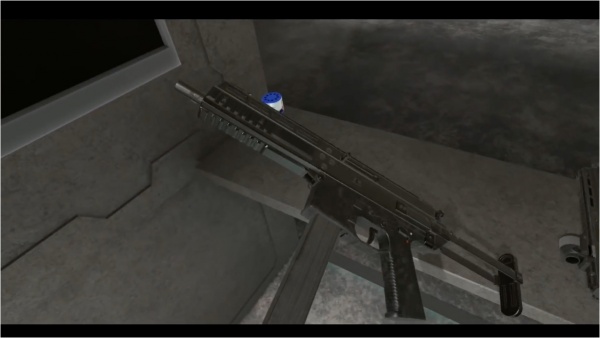
Examining the carbine; note the 2-position fire selector.
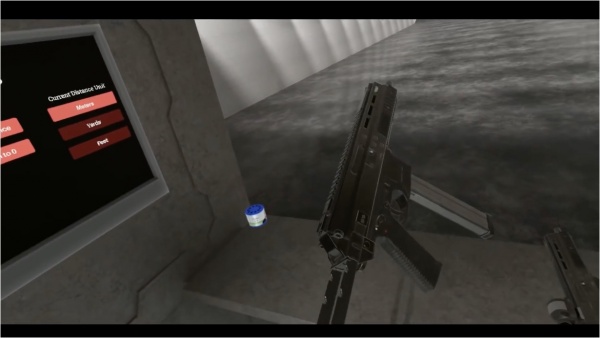
The other side, giving a good view of the collapsible stock. While not as commonly seen on the carbines, the collapsible stock is interchangeable with the side-folder, so such a configuration is entirely possible.
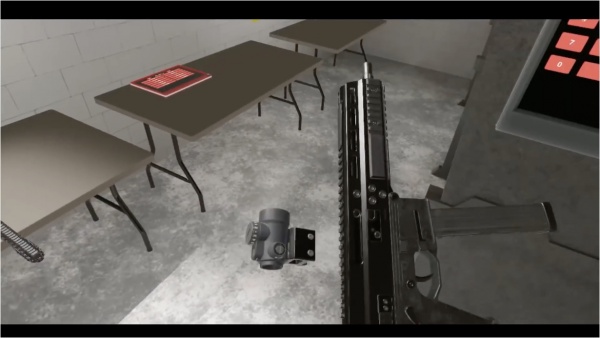
Attaching a red-dot sight, in an attempt to appease the benevolent gods of reference images.
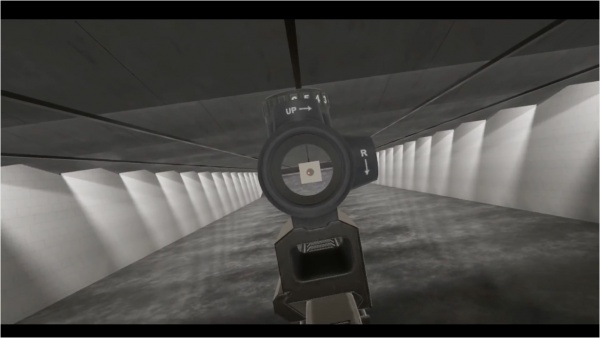
Plus it makes aiming easier.
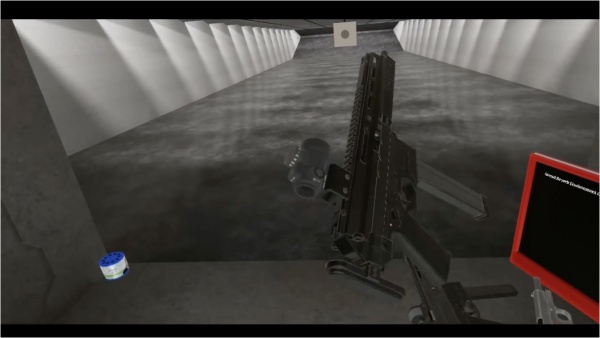
...which fits nice and flush against the back of the receiver.
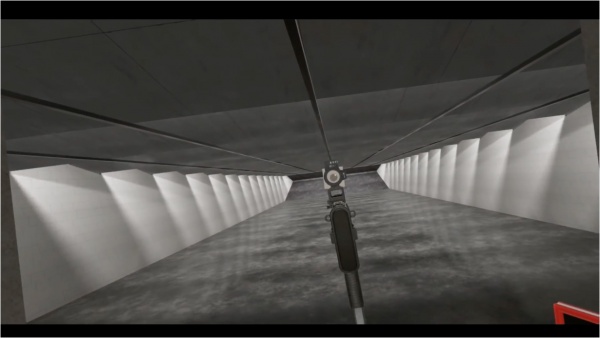
Doing this allows the APC45 to be used as a pseudo-pistol.
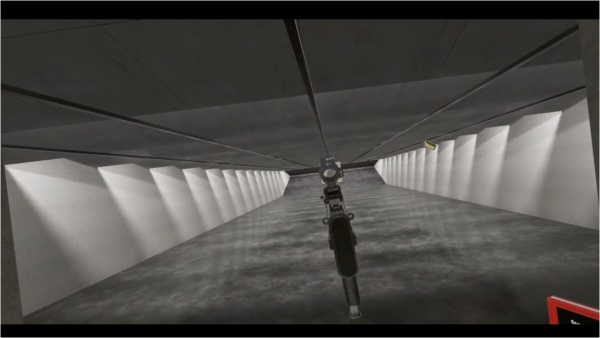
Note the word choice: it
allows the APC45 to be used as a pseudo-pistol. It does
not make doing so easy.
Brügger & Thomet APC9-P
To compliment the APC45, Update #61 added Brügger & Thomet APC9-P semi-auto carbine, a longer-barreled variant of the APC9.
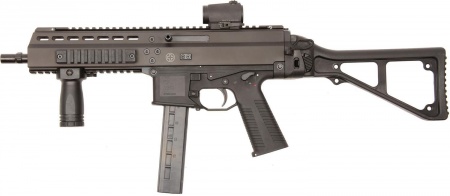
Brügger & Thomet APC9-P carbine - 9x19mm Parabellum

Brügger & Thomet APC9 SMG - 9x19mm Parabellum. As above, image provided to show the collapsible stock seen on the in-game APC9.
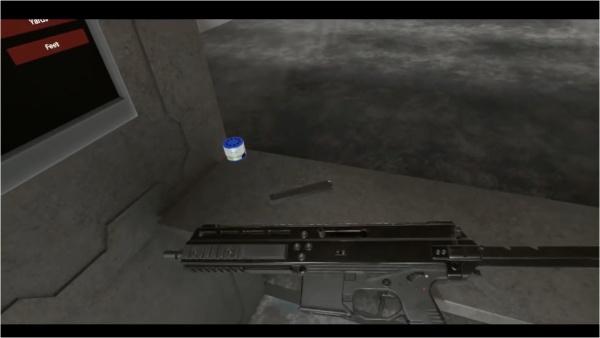
The left side of the carbine...
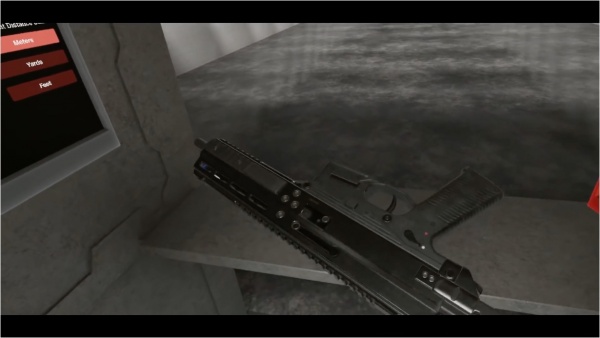
...and the right side. Without the magazine, the APC9 is nearly indistinguishable from the .45 version.
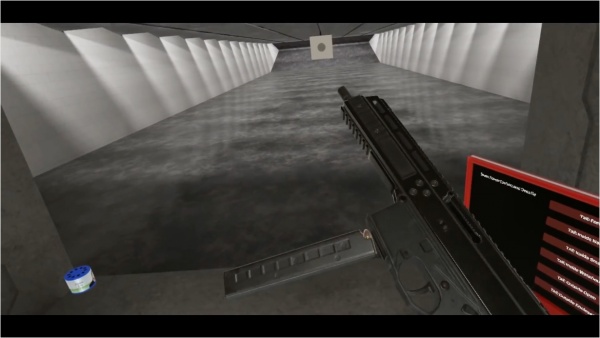
Bringing the magazine into the equation makes the difference relatively clear. These 32-round magazines are interchangeable with those of the
Brügger & Thomet MP9, which makes sense, considering that they're made by the same company.
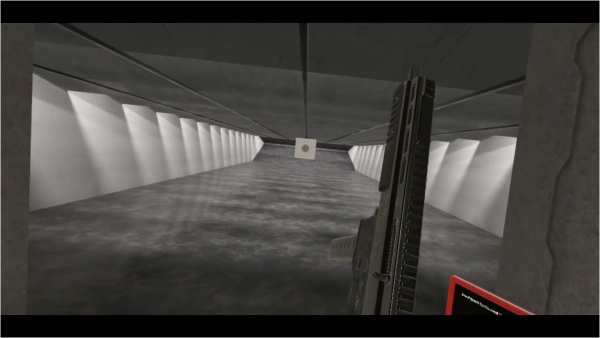
Giving the reciprocating charging handle a nice, solid tug.
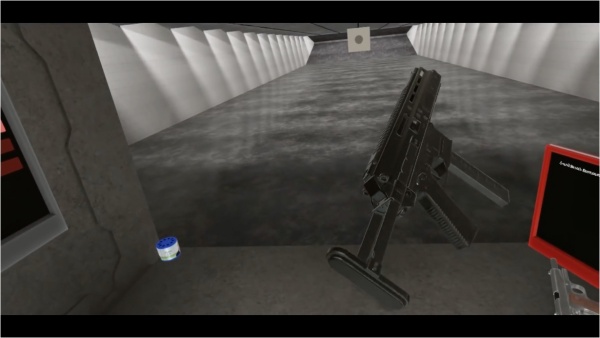
Fiddling with the collapsible stock.
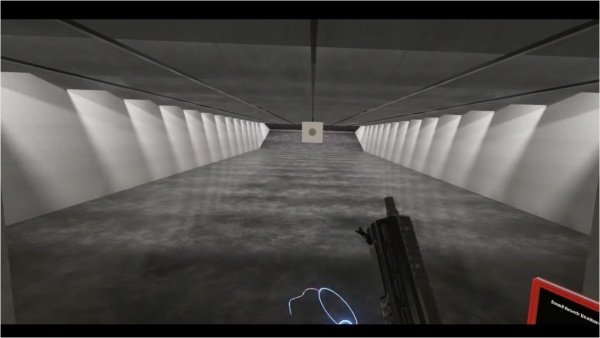
Flipping up the front sight...
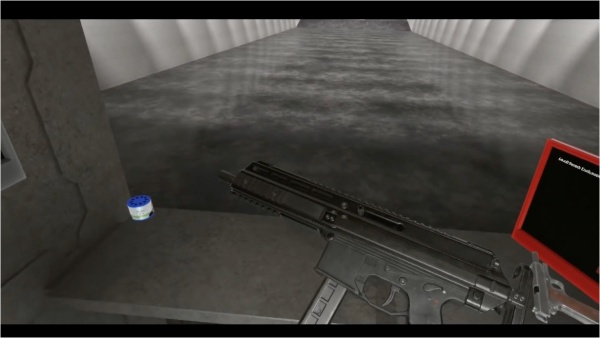
The APC9's selector switch; the civilian carbine versions have only safe and semi-auto positions, while the SMG variants have a 3rd full-auto position around the 8 o'clock position relative to the pivot, denoted by 3 red dots (see the 2nd reference image).
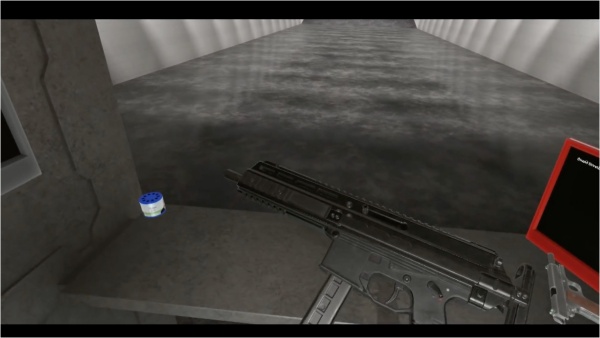
The aforementioned semi-auto position.
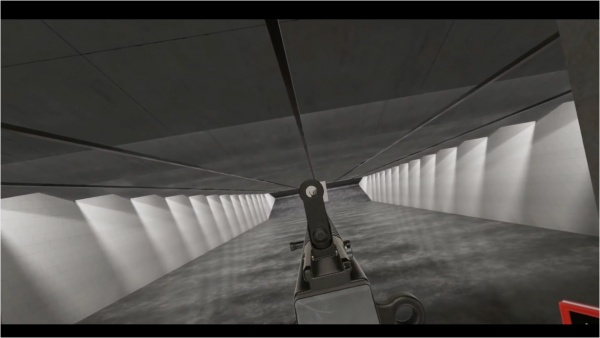
A view through the carbine's flip-up irons.
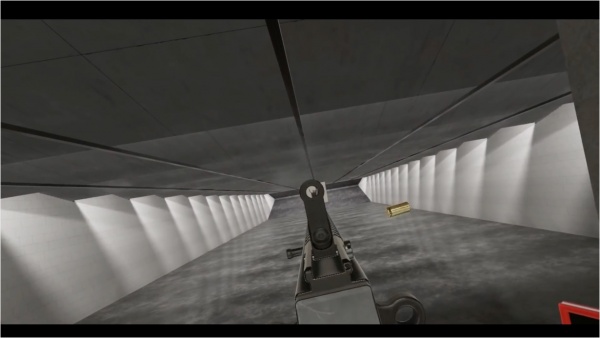
Another view of the same, this time just after firing.
Bushmaster ACR
Added in Update #58, the Bushmaster ACR is, unusually for a video game, correctly treated as a civilian semi-auto carbine, rather than the select-fire assault rifle that most games depict it as.
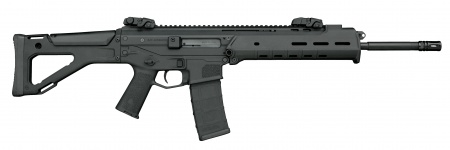
Bushmaster ACR - 5.56x45mm NATO
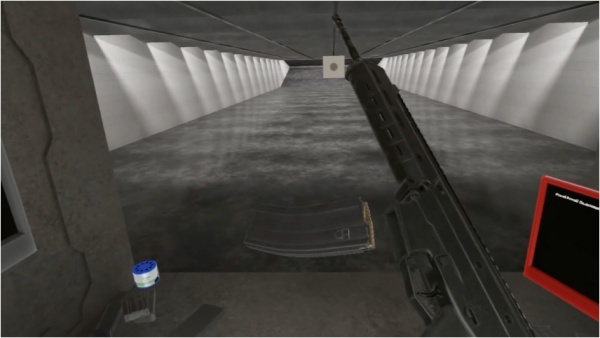
In an act of defiance against the reference image, our invisible operator loads his ACR with a 30-round USGI-pattern metal STANAG, rather than the picture's PMAG.
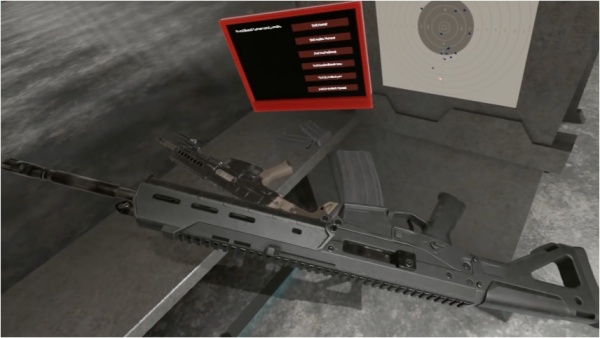
Plus, at the time these shots were taken, the game didn't have any PMAGs yet.
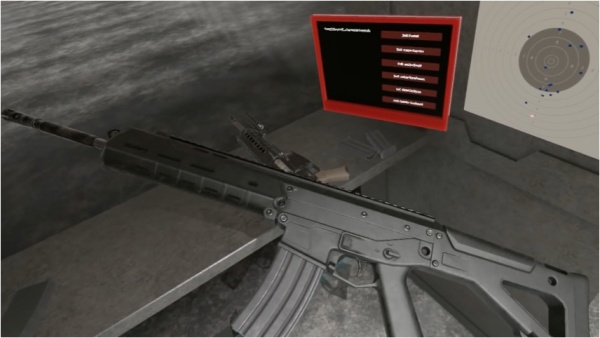
Well, making do is all we can.
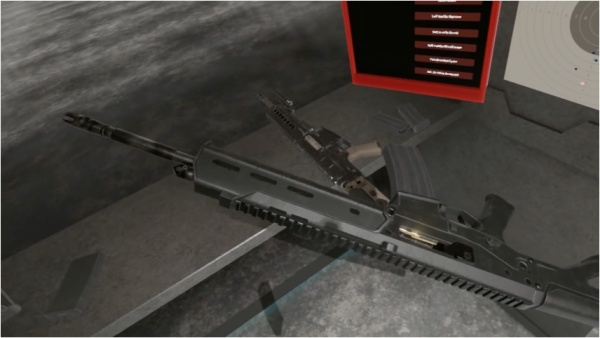
Pulling the charging handle; interestingly enough,
H3's ACR has its reversible charging handle set on the right side, in an ideal position for a left-handed user.
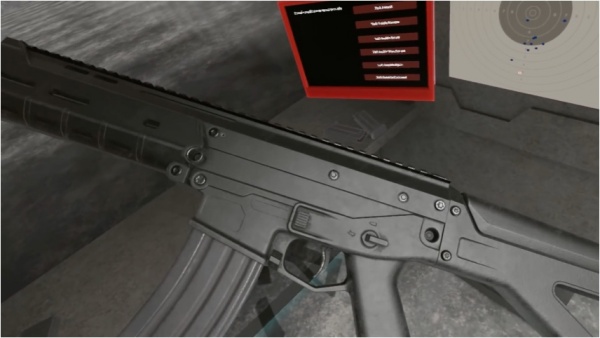
Taking a close look at the fire selector...
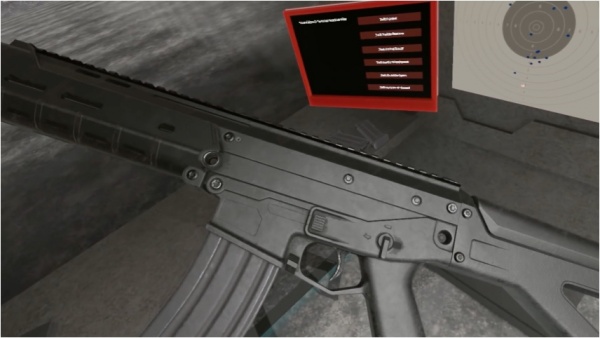
...which has two - count 'em! - settings: safe, and semi-auto.
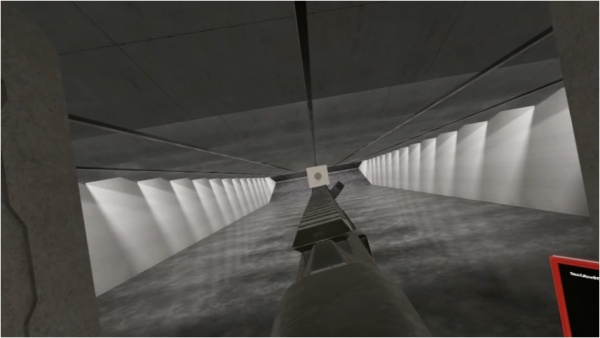
It also has zero - count 'em! - sights by default.
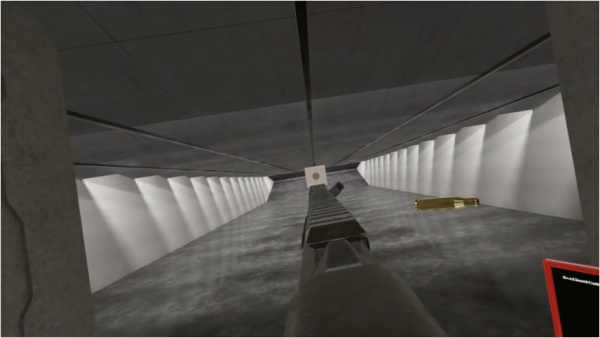
Once again, there's nothing to do but make do.
Bushmaster M17S
The Bushmaster M17S was added on Day 13 of the Meatmas 2022 Advent Calendar event. This is the first Australian firearm added to the game, and the first time the M17S has appeared in a video game.
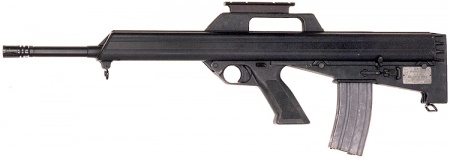
Bushmaster M17S - 5.56x45mm
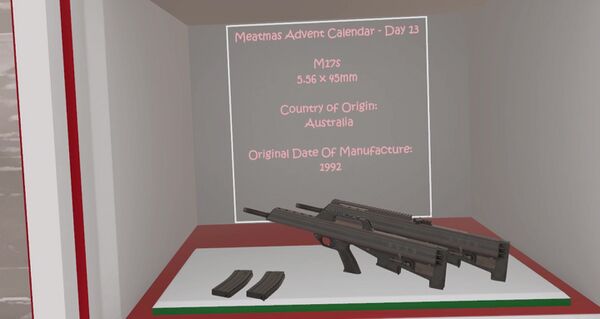
A box of Bushmasters, in a locale somewhat inconveniently devoid of any bushes to master.
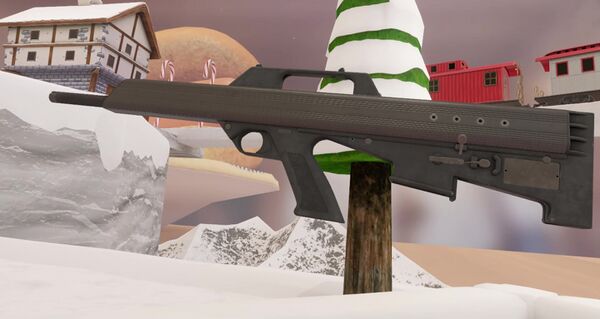
Examining the Australian rifle. Take a good, long look; you don't get to see these puppies often.
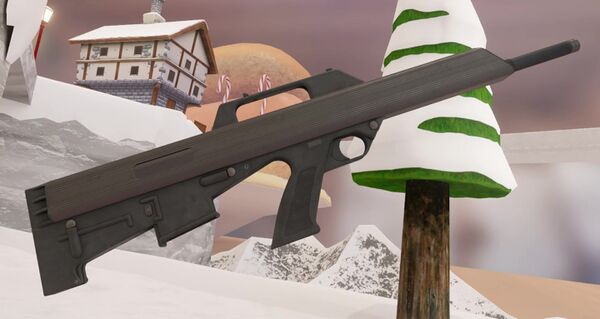
Or would "dingoes" be more appropriate?

Disengaging the safety, a simple cross-bolt button.
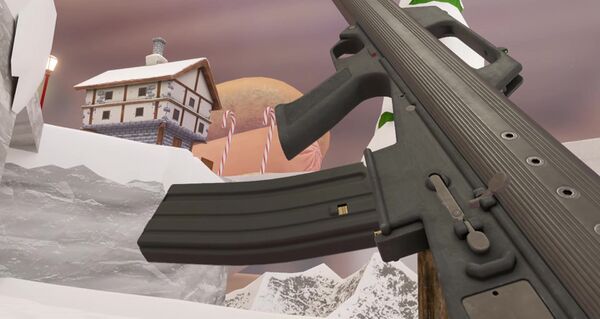
Loading in a 30-round STANAG magazine; if the lower receiver looks AR-ish, that's because it is - the design is largely
AR-18-derived.
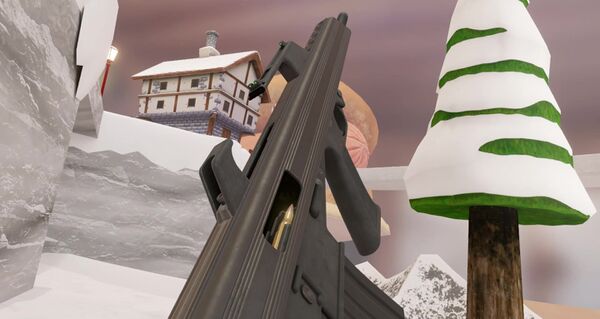
The manual of arms, however, is rather unique - the entire back section of the carrying handle serves as a (thankfully non-reciprocating) charging handle.
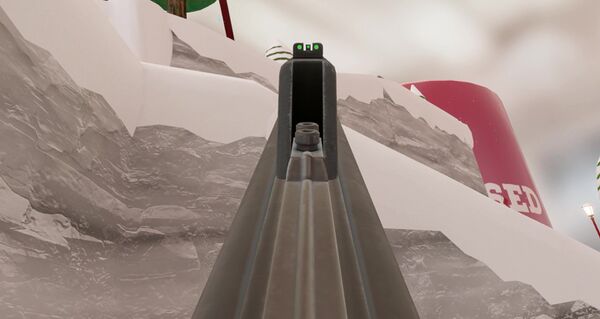
The sights atop this charging handle are a simple, pistol-esque 3-dot setup - good for quick acquisition, if a bit obtrusive at longer ranges.
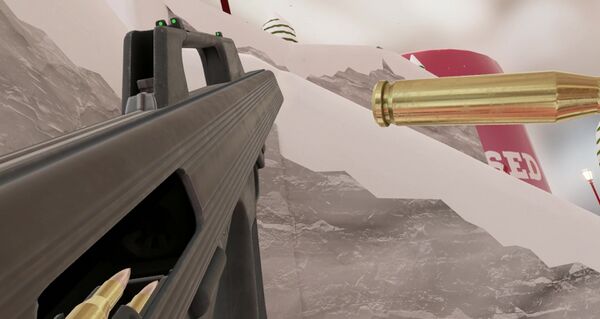
Being an intermediate-caliber bullpup with a substantial height-over-bore, firing while aiming down sights doesn't produce any particularly interesting screencaps, forcing site editors to resort to more...
creative measures.
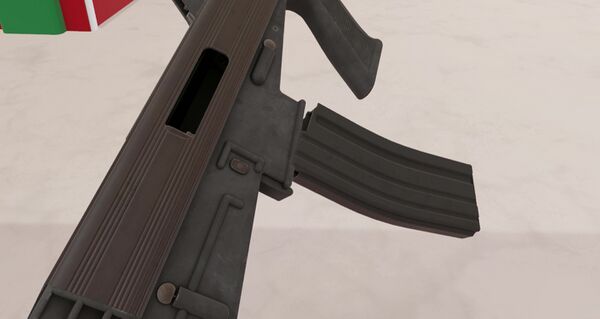
Upon emptying the rest of the magazine in a far less uncomfortable position, the gun locks open; while the magazine release is still in the same relative position as that of an AR, it is no longer hand-accessible, for relatively obvious reasons.
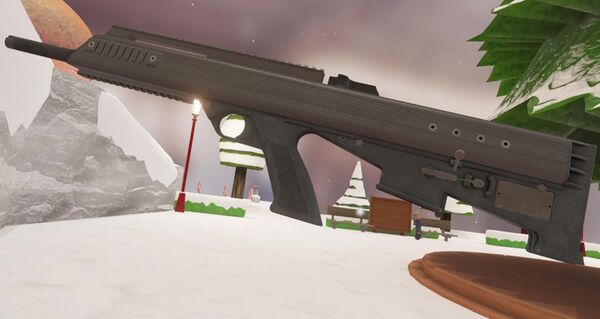
Should you find the standard version insufficiently modern (or oversufficiently tall), the fictional "M17S Mod" might be the gun for you.

Aside from the rails, the main change is the complete removal of the carrying handle; since this served as the charging handle, an
AR-15-type T-handle has been installed in its place.
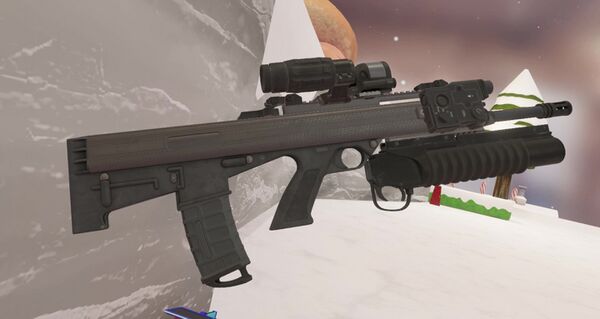
Though, of course, the rails are a significant change in their own right.
Carcano M91
On the ninth day of the 2018 Meatmas event, a Carcano M91 was added. It is (understandably) the first weapon in the game to use the 6.5x52mm Carcano round, and only the second to use en-bloc clips (the first being the earlier-added M1 Garand, which uses a slightly different system).

Carcano M91 - 6.5x52mm Carcano
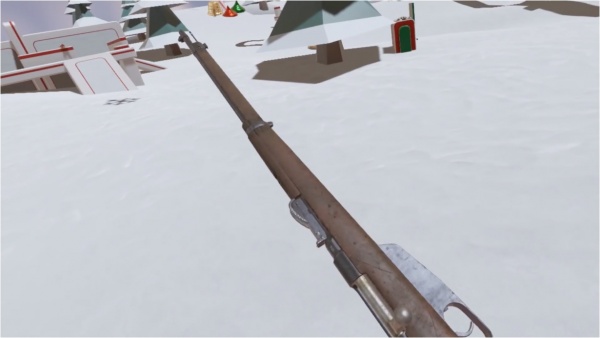
Admiring the rifle. Or, at least, attempting to; being over 50 inches (127 cm) long, the Carcano rarely actually fits in frame.
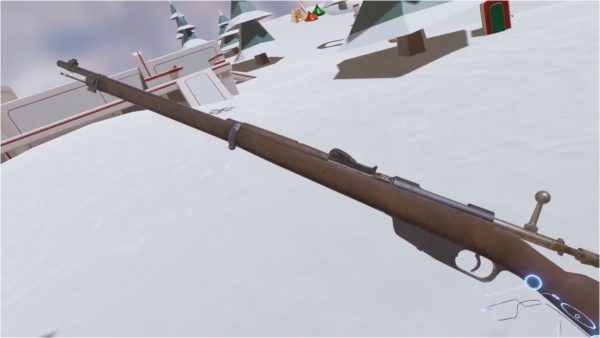
...which, unfortunately, doesn't make the rifle any shorter.
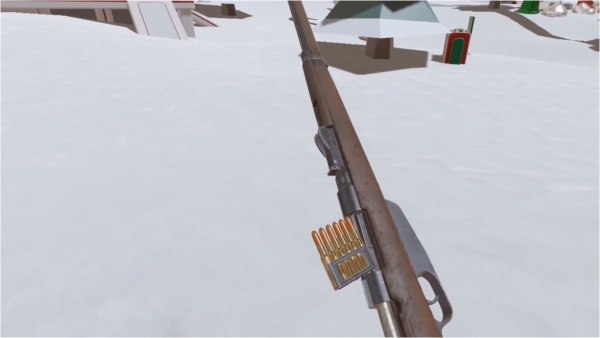
Loading in a 6-round en-bloc clip. Unlike the M1's staggered-column clips, these are based on the original Austro-Hungarian Mannlicher system (or, rather, the improved bi-directional German version developed with the
Gewehr 1888), and, as such, are single-stacked.

Another aspect of the Mannlicher system is this mysterious hole. Wonder what it could be for...
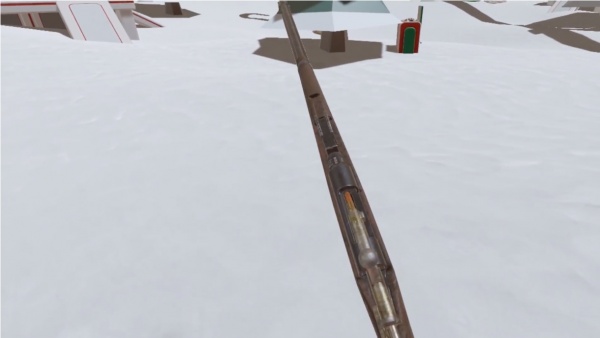
Deciding to just ignore it, and chambering a round.
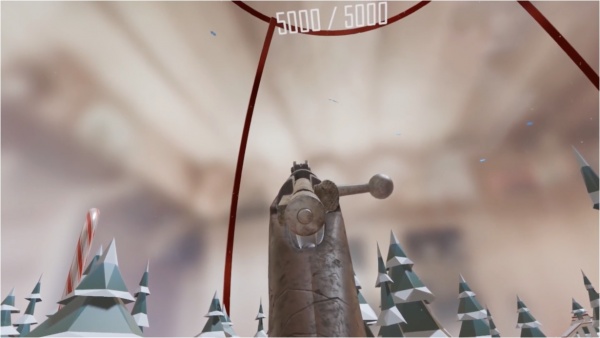
Aiming; the M91's sights are a bit small and hard to see, as was common at the time of its adoption. Which was quite a long time ago, as both the rifle's designation and poor condition make apparent. The two world wars it's been through probably haven't helped.
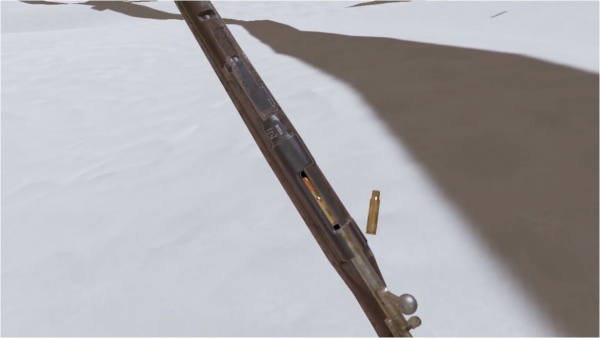
Working the action, and ejecting a spent casing. At full size, this image also shows off some of the markings on the flat-sided portion of the barrel.

Ejecting the second-to-last spent case...
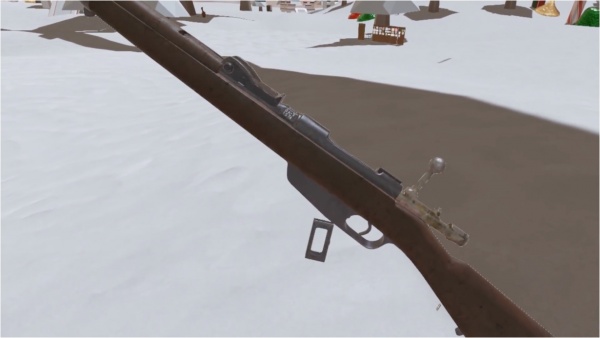
...and chambering the last live round, while simultaneously revealing the purpose of the hole in the bottom of the magazine: clip ejection. Another feature incongruous with the better-known Garand, rather than ejecting clips out the top when the last round is fired, the Carcano's clips simply fall out the bottom when the last round is chambered.
Colt AR-15 Sporter-1
The Colt AR-15 Sporter-1, the semi-auto-only civilian version of the M16, was added in the full release of Update #107. Unusually, it is referred to in-game by its model designation of R6000 SP1.

Colt AR-15 Sporter - 5.56x45mm NATO
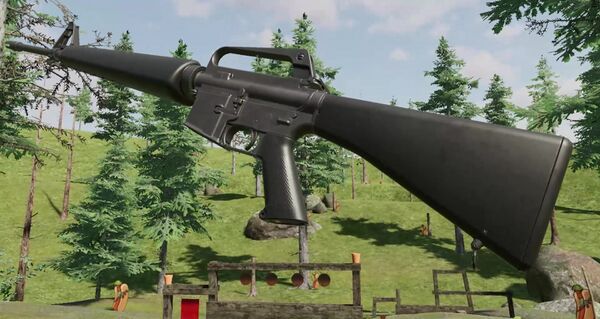
And what do we have here? An M16?

Alas, it is not; instead, we see a sight familiar to many an IMFDB editor who works on older movies - a slab-sided SP1, with no autosear pin.

Loading a post-ban magazine into the pre-ban rifle. It's pre-just-about-every-ban, in fact; having been released in the early sixties, it's almost certainly older than most of the people reading this.
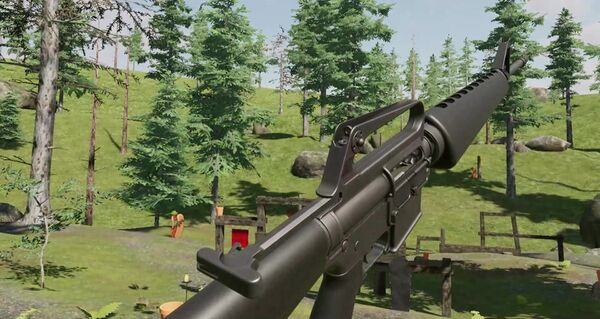
Chambering a round from the now-loaded magazine, which looks... a bit sad, really.

Disengaging the safety, and getting a good look at the markings in the process. As with all the other post-refresh AR variants, its serial number is self-referentially prefixed "H3".
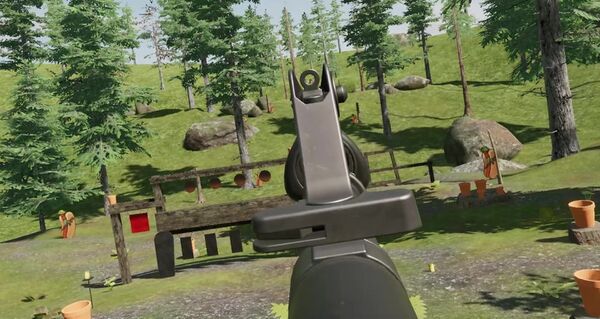
Taking aim at a distant gong through the familiar carry-handle sights. The smaller precision aperture is available...
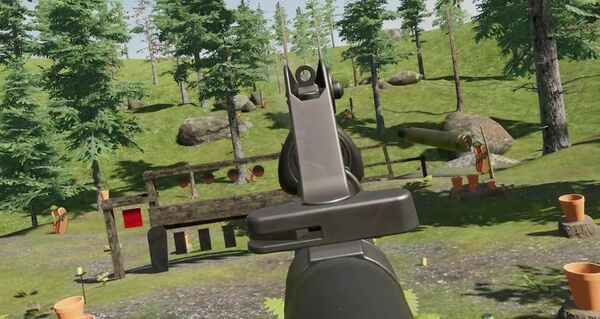
...though the larger one would ultimately prove plenty sufficient for this shot. There's not much of a way to indicate this in a screencap, so you'll just have to assume it's true. Can't replicate it yourself? Skill issue.
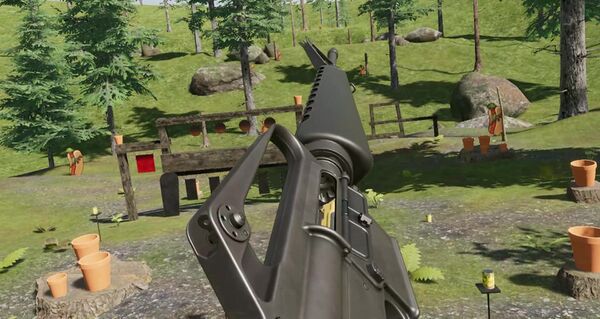
Nine more gong rings later, the mag runs empty, its yellow follower giving a much clearer indication of its presence than its external dimensions.
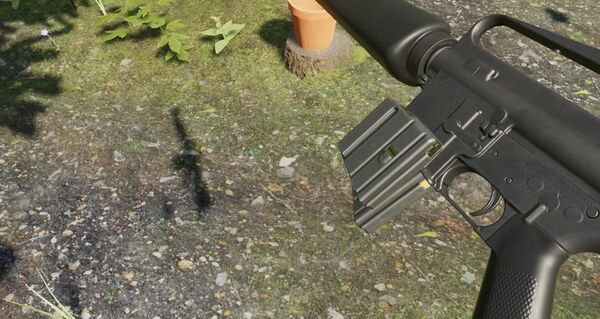
Performing a quick reload, sadly having failed to acquire any more respectable-looking magazines.
Colt AR-15 Sporter Carbine
Alongside the AR-15 Sporter, the Colt AR-15 Sporter Carbine was also added in Update #107's full release. It too is referred to by its factory model designation of "R6001 SP1".

Colt AR-15 Sporter Carbine - 5.56x45mm NATO

Heading out to the range, with one of those fancy new 16-inch AR carbines.
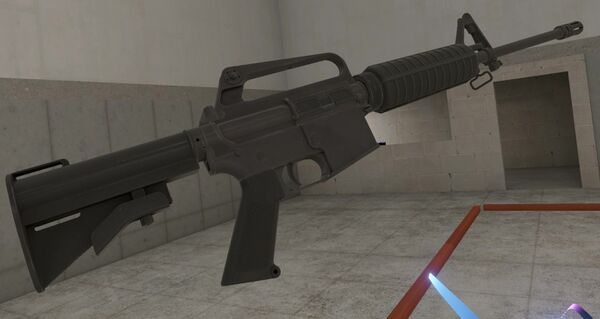
All the cool kids've got 'em, so clearly there's something to the hype.
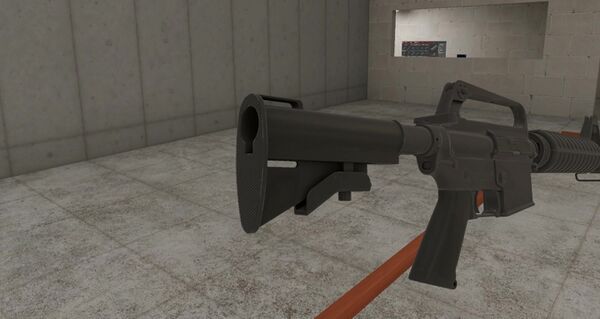
Messing with the collapsible stock - all that modern tactical configurability people are talking about nowadays.
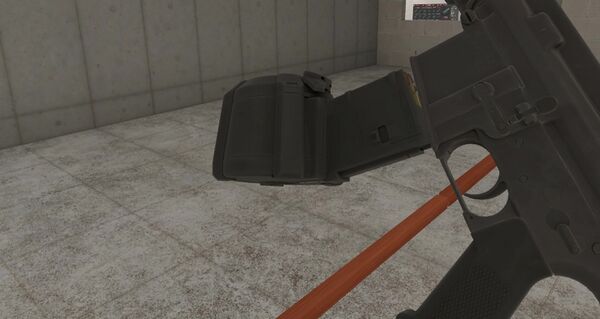
Loading in a magazine - polymer-bodied, high-capacity, what's not to love? Even comes from that company people constantly talk about - "Bag-pull" or something.

Chambering a round - only the finest surplus .223 FMJ.

Aiming at a target. The irons work nicely, but it feels like something's missing...

Aha! That's right! Nowaday's, everyone's using those high-tech optical sights! No worries, just stick a rail on the carry handle, and it locks right into place.

Disengaging the safety - nice and easy, with that short 90-degree throw.
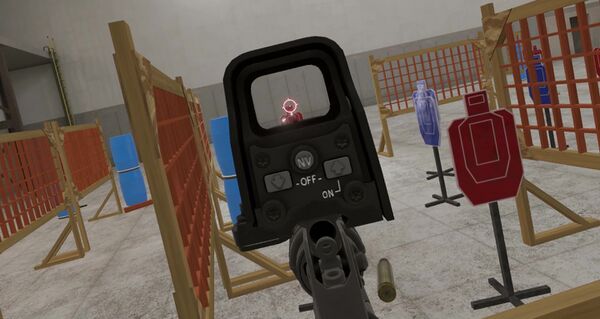
Ringing some steel. Why, with the optic up this high, you can barely even feel the gun against your face!
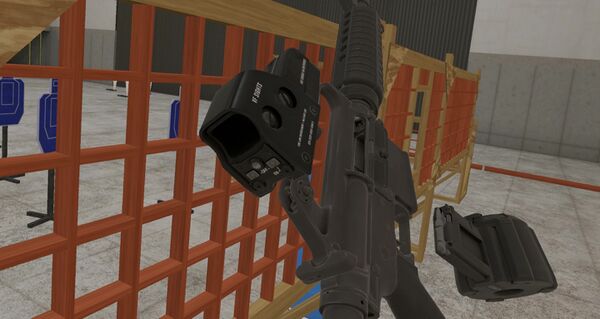
Of course, not even a 60-round drum lasts forever. Now, let's go post about it on one of those "inter-net web-sites" and see what the youngins think!
CMMG MkGs Banshee
Added in the 4th alpha build of Update #70, the "Phantom 9" pistol-caliber carbine is a CMMG MkGs Banshee in 9x19mm.
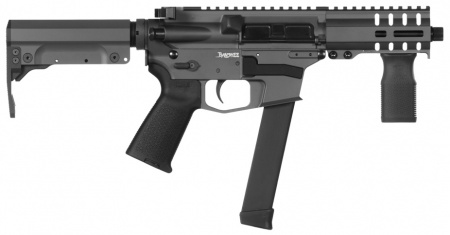
CMMG MkGs Banshee 300 with Magpul RVG foregrip - 9x19mm Parabellum
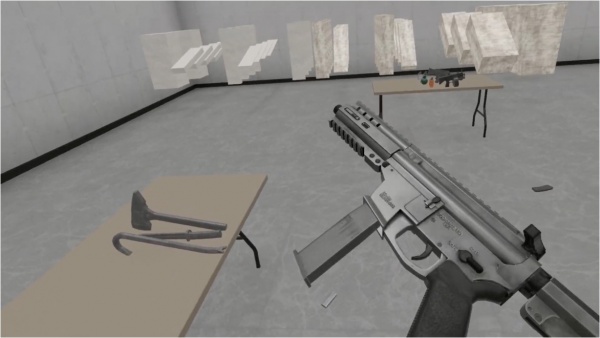
Loading the Banshee with a 15-round
Glock 19 magazine.
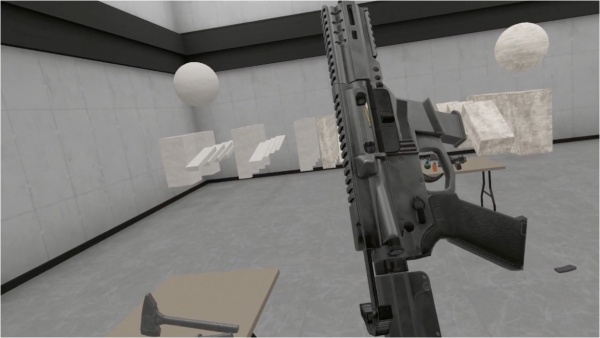
...and racking the charging handle.
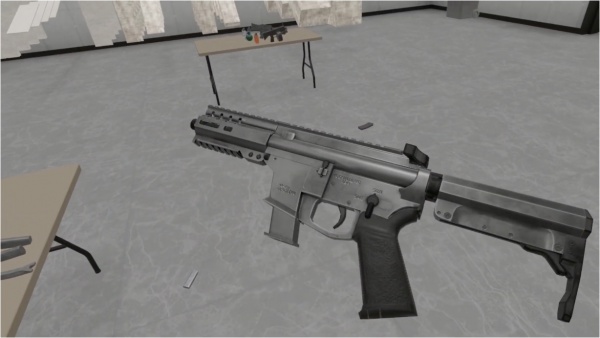
Pausing for a moment to admire the Banshee. The matte-gray finish is an interesting choice, wouldn't you say?

Toying with the adjustable stock; this is CMMG's proprietary RipStock, standard on the SBR-pattern Banshees.
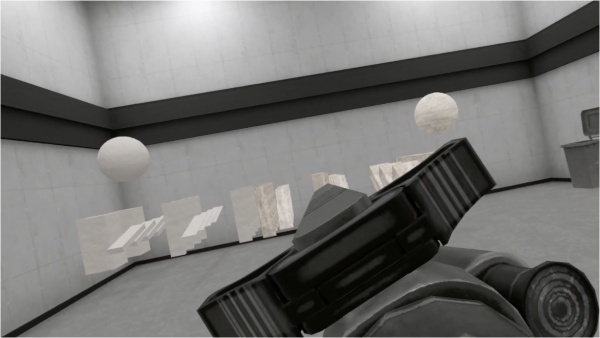
Trying to aim, before immediately discovering that the Banshee doesn't come with any sights by default, which is at least in line with how the carbines are shipped from the factory.

Popping off a few rounds in spite of this.
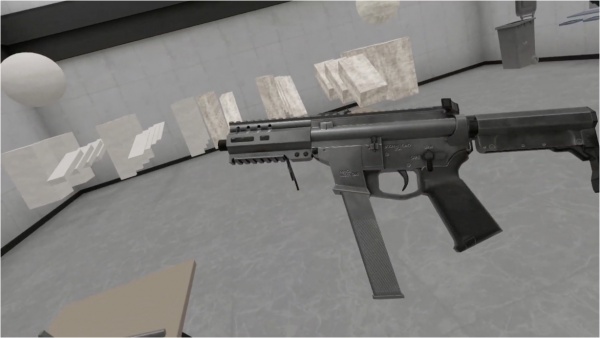
Of course, if 15 rounds is good, then 33 must be better, right?
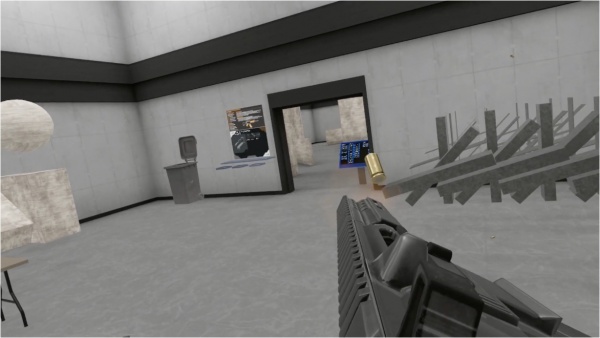
Following this sound logic, and firing some more rounds, in the ever-cool-but-impractical diagonal-firing stance. Of course, without any sights (or, for that matter, any particular target), it's a bit of a moot point.
Custom AR-15
Update #59's eighth alpha added a custom AR-15 carbine, with a short barrel and PDW-type collapsible stock. Being a civilian rifle, it fires exclusively in semi-auto. Update #61 added another custom AR, this one a full-length rifle (though still classified as a carbine, lacking a better category), known as the "Bubba-15". Update #112 Alpha 1 added several new custom AR15 builds, two of which replace the aforementioned models listed above.
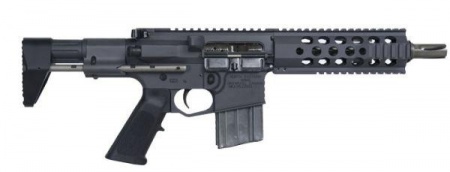
North Eastern Arms NEA-15 PDW - 5.56x45mm NATO. Similar (though not identical) to the rifle in-game.
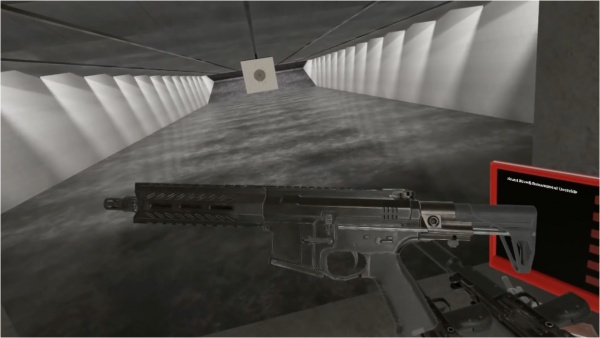
Admiring the AR. 200 extra dollars and 9+ months of waiting well spent.
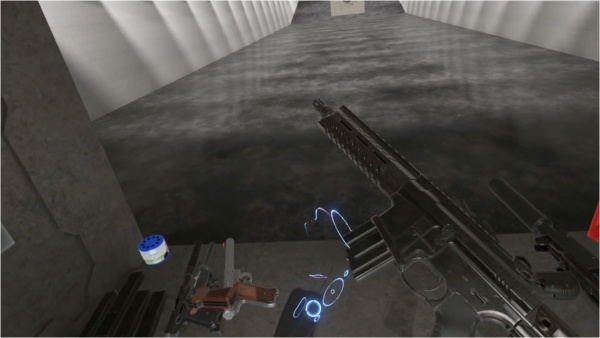
Loading in a 10-round magazine, for legality's sake, before irritatedly remembering that most states with magazine capacity restrictions have a total moratorium on SBRs anyway (SBR standing for
Short-
Barreled
Rifle, a term used in the context of US firearms laws to refer to any firearm with a stock and a rifled barrel shorter than 16 in (40.6 cm), or a front-to-back overall length under 26 in (66 cm); under the National Firearms Act of 1934, these require registration with the Bureau of Alcohol, Tobacco, Firearms, and Explosives, with a $200.00 fee, though some states simply prohibit them outright).
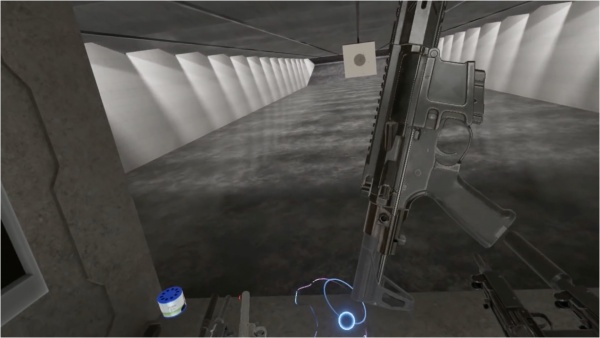
"Well, if they're going to come for my dogs, they're going to have to go through me first."
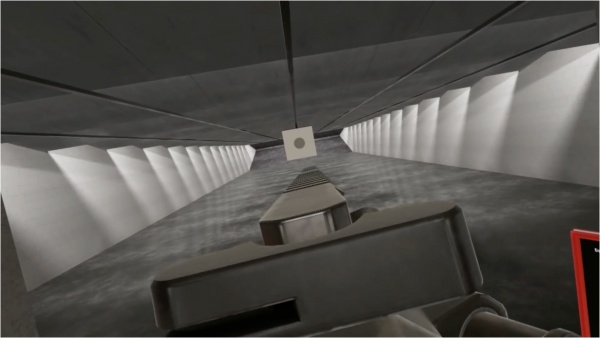
"That might be a problem."
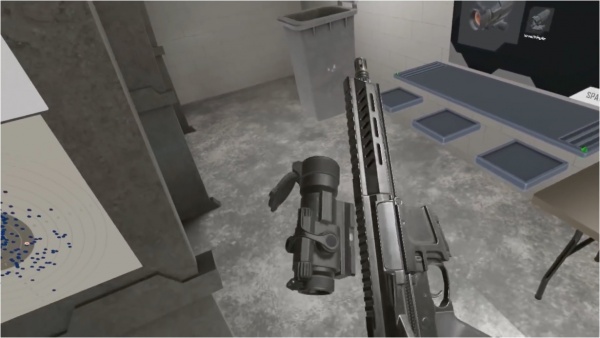
Alleviating the aforementioned problem, by attaching an Aimpoint red-dot sight.
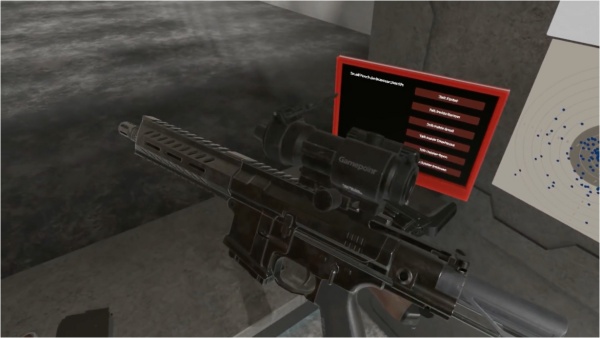
WE ARE EXPERIENCING TECHNICAL DIFFICULTIES; PLEASE STAND BY.
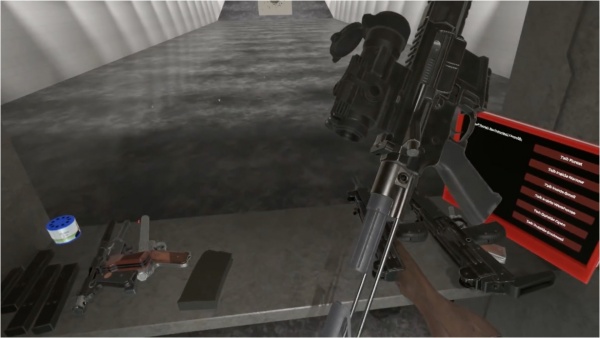
Remembering that funny little thing called "eye relief" exists, our heroic dog-defender extends his rifle's stock.
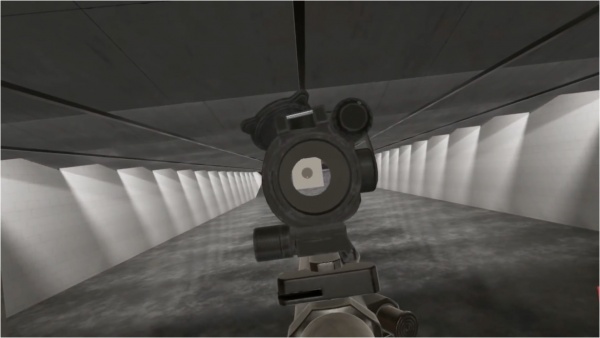
There we go, much better.
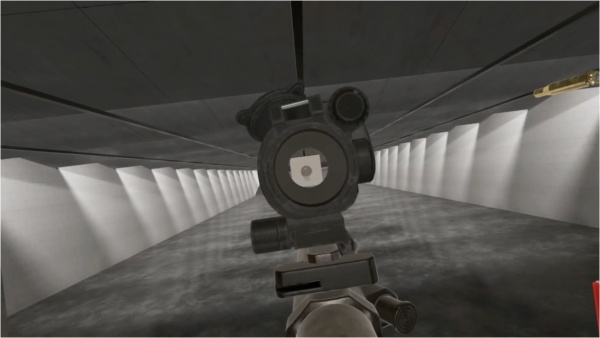
Firing again, this time without any risk of objective lens-related eye injuries.
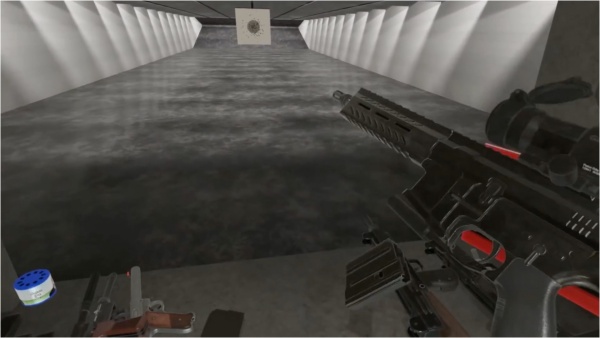
Dumping out the empty magazine. 10 rounds lasts longer than you might think, but not as long as you'd like it to.
"Bubba-15"
The Bubba-15 most closely resembles a Salient Arms International GRY Carbine with the Jailbrake muzzle device removed, even down to the bronze-colored bolt.
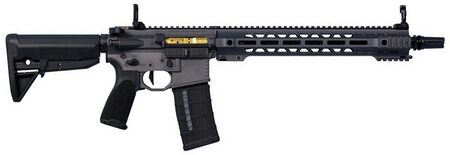
Salient Arms International GRY Carbine without a JailBrake muzzle device - 5.56x45mm NATO
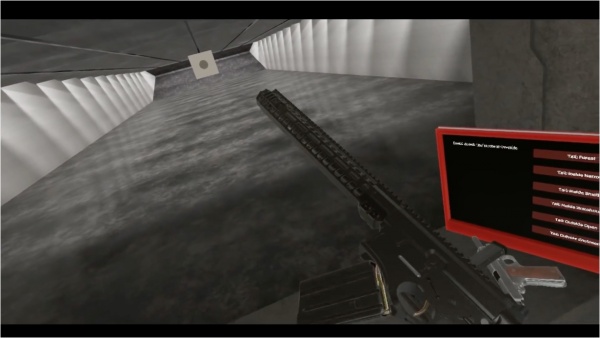
Attempting to stick a magazine into the trigger guard; Bubba isn't known for his hand-eye coordination. After all, he only has one of the latter and one and half of the former.
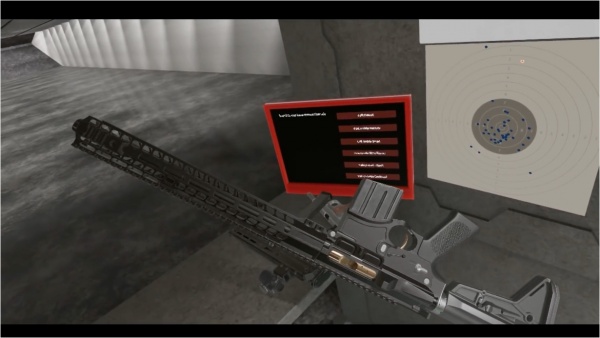
Still, depth perception isn't needed for drooling over a bronze-coated bolt carrier.
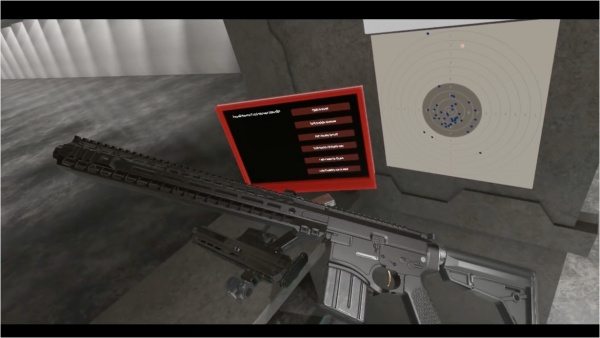
Or any of the rifle's other aftermarket components, for that matter.
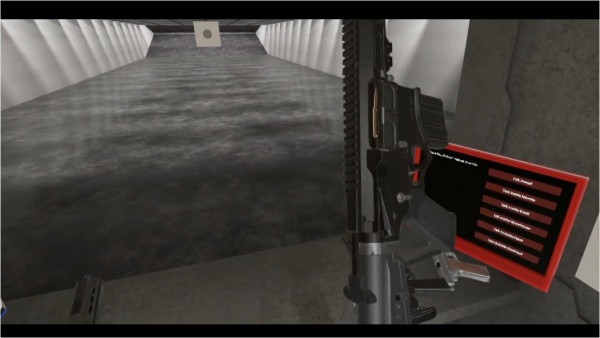
Getting back to standard Bubba business, and pulling the charging handle.
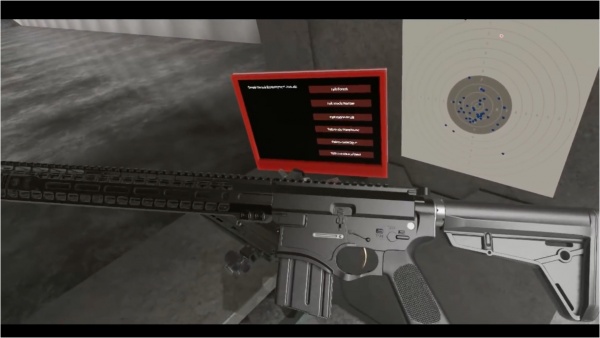
Flipping the selector, from "Safe"...

...to "this is still a civilian rifle, what'd you think its fire modes would be".
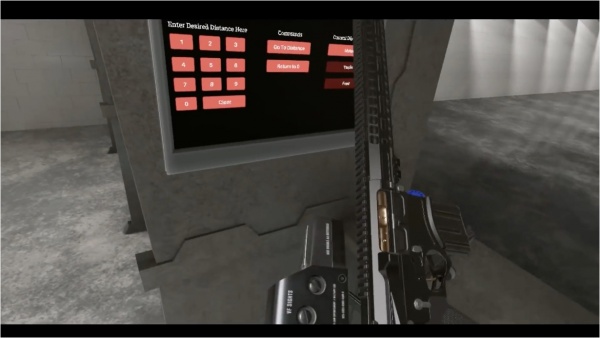
...before remembering that, of course, no expensive rifle is complete without an expensive optic.
"DMR15"
The "DMR15" is an AR-15 with a 24-inch barrel and parts made specifically to resemble the PSG-1, namely the Magpul PRS stock, JP Enterprise MK3 hand guard, and a DPMS pistol grip. The handguard also supports M-LOK attachments.

DPMS Panther Arms Mini SASS, similar to the DMR15 apart from the handguard - 5.56x45mm NATO
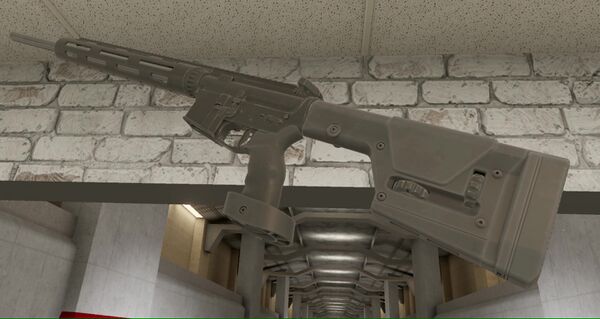
Out on the sniper range with the DMR15. Yes, "D-M-R", not "D-R-M". No obnoxious anti-piracy here.

The rifle's other side, plus a few appropriate accessories. Affixing a bipod (or anything else) to the bottom rail automatically adds a full-length Picatinny rail segment.

Loading in a 10-round PMAG full of high-quality hand-loaded ammo. Definitely not just the usual FMJ, this stuff's special. Don't try to verify it or anything; just trust me.
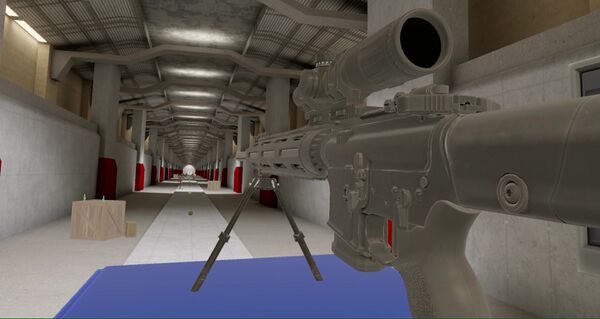
...disengaging the safety...
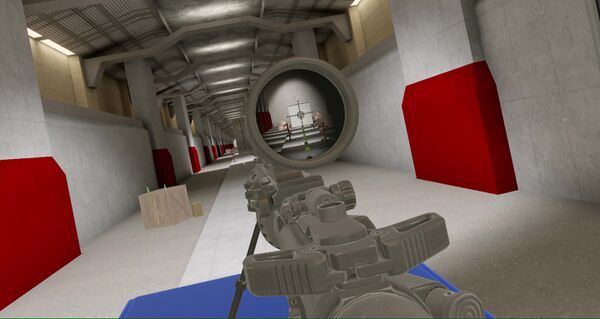
...and taking aim, after lowering the highly sophisticated shooting bench (read: the options panel) to a more appropriate height.

Putting some rounds on paper.
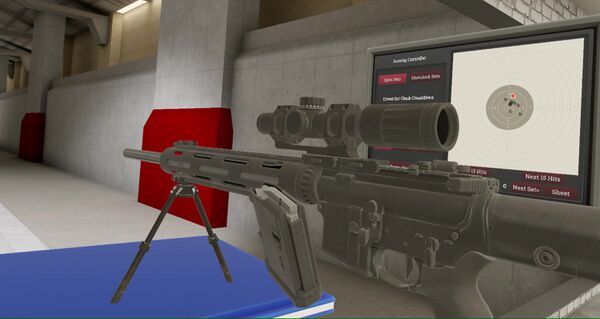
Checking the magazine, the popped-up bolt release, and the range sheet. Not bad, but could be better. The rifle can certainly manage more.
"FP15"
The "FP15" is a "Competition" style AR-15 with a 16 inch barrel. It is equipped with a Daniel Defense DDM4 V7 upper receiver and handguard, and a B5 Stock.

Daniel Defense DDM4 V7 Pro - 5.56x45mm NATO. Similar to the FP15.
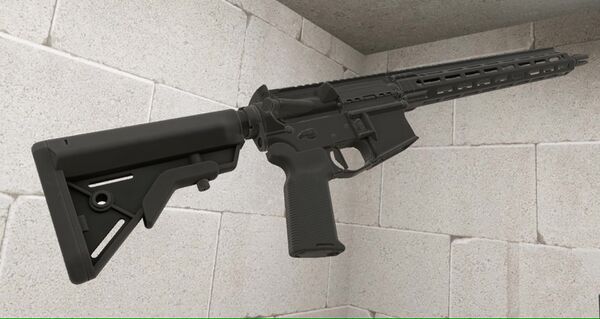
Admiring the fancy new FP15. It's a pretty tricked-out gun, sure, but it still feels like it's missing a little something.
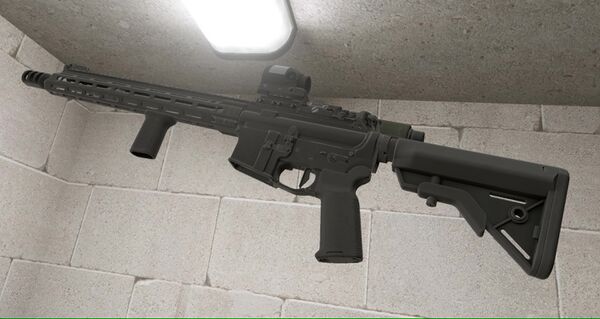
There we go. Hadn't quite dumped enough money into it.
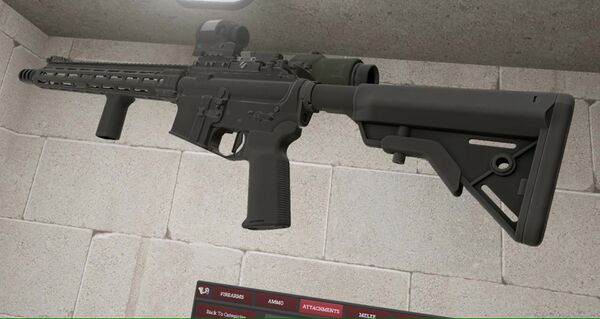
Extending the B5 Systems Bravo stock. $61.00 for that, plus shipping and handling - not too unreasonable, but not exactly cheap either.
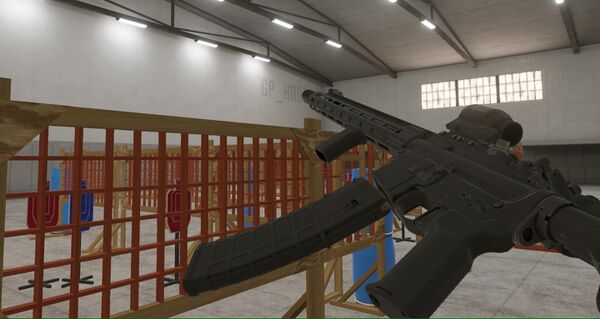
Walking up to the firing line, and loading in a 40-round Magpul PMAG. A bit too long for most normal use, but a common sight in competitions.
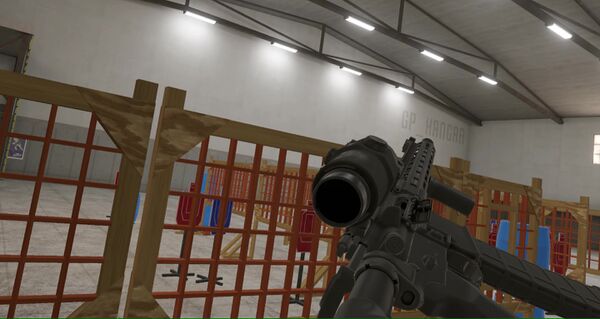
Chambering a round, and waiting for the beep.
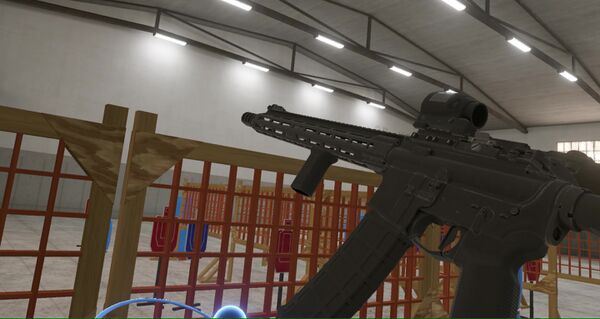
"Shooter ready. Stand by..." BEEP 
Wasting no time, and all 3 of the first set's targets - double-taps for each. Didn't even leave enough time for a proper aiming shot.

Heading up to the next shooting position, and flipping the rifle's 2-power magnifier into line with the RDS.
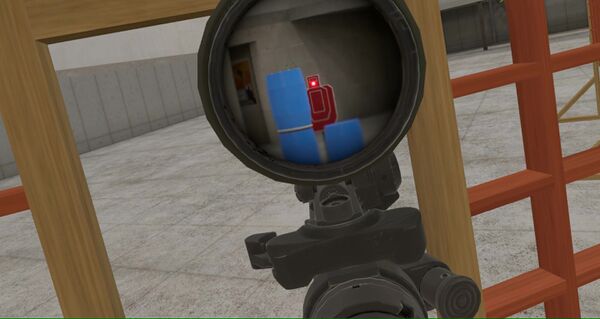
There we go, now there's a proper aiming screencap.
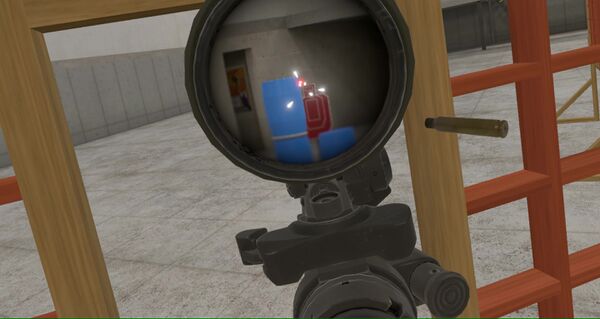
The magnification probably wasn't necessary at this distance, but whatever.
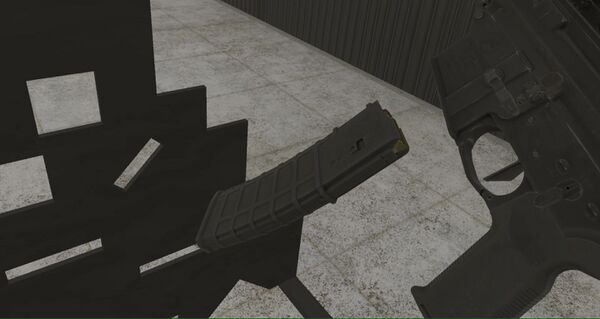
After clearing a final set of plates through a 9-hole barricade, the competitor unloads. Unfortunately, he accidentally cleared show instead of showing clear, so we don't have a shot of that to show you.
"MP15"
The "MP15" is an AR-15 with FDE-colored Magpul MOE furniture and a 16-inch barrel.

Colt Law Enforcement Carbine LE6920MPS-FDE with Magpul MOE stock, pistol grip, & handguard, MVG foregrip, PMAG, and MBUS Rear sight - 5.56x45mm NATO
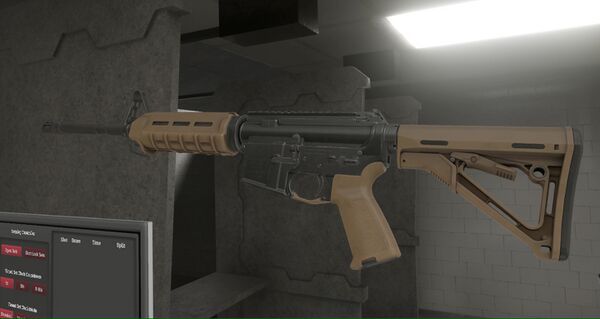
The MP-15. Contrary to what the name suggests, not a German submachine gun.

Doesn't need much more introduction - you know this gun. You've seen it before. It's always there, on the wall of the gun shop, with a relatively reasonable price tag and some 3-letter-abbreviated manufacturer that you may or may not have ever heard of before, just waiting for some newcomer to pick it up and plunge headlong into the world of ARs. The MBUS rear sight may or may not be sold separately.

Just waiting for them to shove in that first cheap USGI-pattern mag full of bargain-bin 5.56.
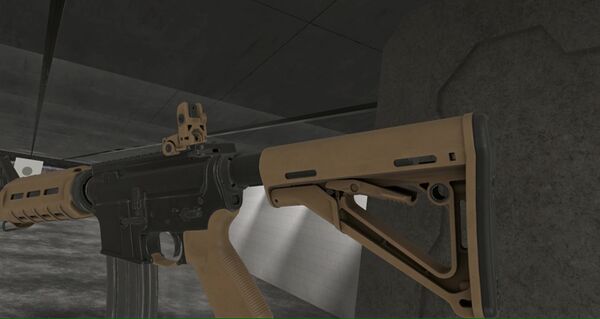
And maybe, after wondering how on Earth people like these things so much when the stock's this short, have a helpful range patron or shop owner explain that you can make it longer.
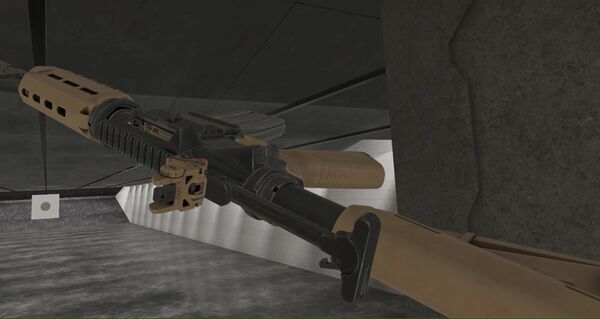
They'll probably get a bit confused about why the charging handle's all the way back there - maybe someone will explain the background, maybe they'll just say "you get used to it".

With any luck, the rear sight the gun shop's owner recommended (or included) will be decently easy to pick up.
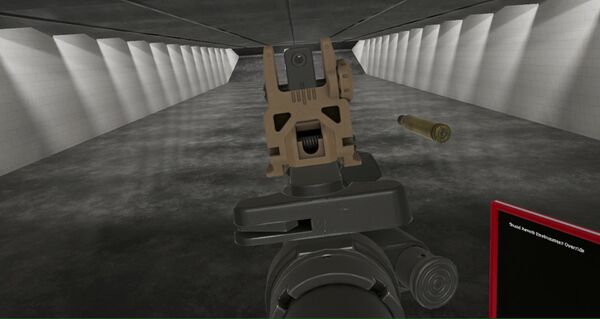
And, in that magical moment, when they pull that not-especially-remarkable mil-spec trigger, feel the surprisingly light recoil of 5.56 out of a 16" barrel, it'll just... click.
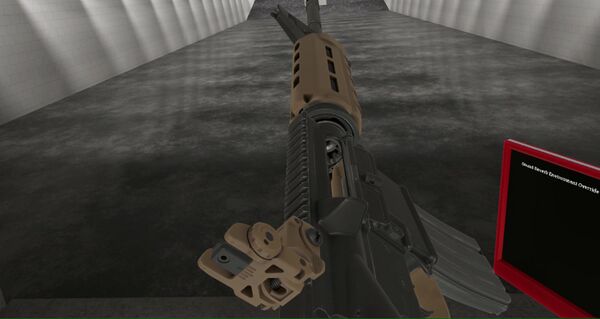
Before they know it, their 30 rounds are up, faster than guns that hold less than half that they've fired before.
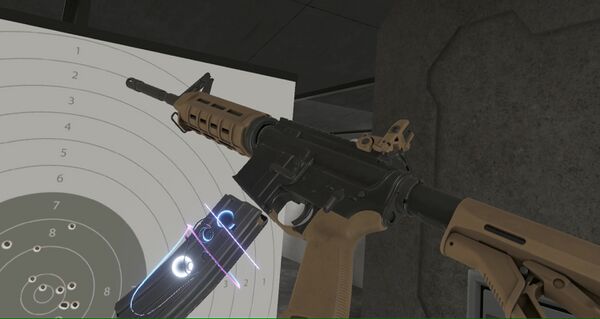
And, looking at a target sheet that's nothing to write home about, admiring the handy little rifle in their clutches, they'll decide that maybe there's something to the popularity of these things. And their life (and wallet) will never be the same.
And then they fail to properly grab the mag and drop it on the floor.
"PDC15"
The "PDC15" is a short-barreled AR-15, set to replace the above AR-15 SBR. While it overall has the same formfactor, the handguard is replaced with one that supports M-LOK attachments, and uses a slightly different arm brace and pistol grip. The furniture resembles a Daniel Defense DDM4 PDW, but with an extra-short MFR rail and a different muzzle.

Daniel Defense DDM4 PDW - .300 Blackout
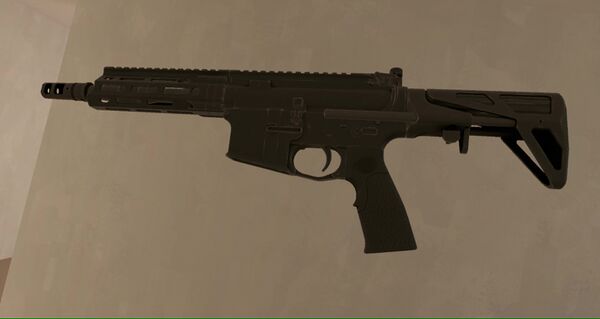
"Own a PDC15 carbine for home defense, since that's what Anton intended." 
Loading in a 20-round PMAG - unlike the reference gun (and like the other 4 civvie ARs added along with it), this one's in 5.56.
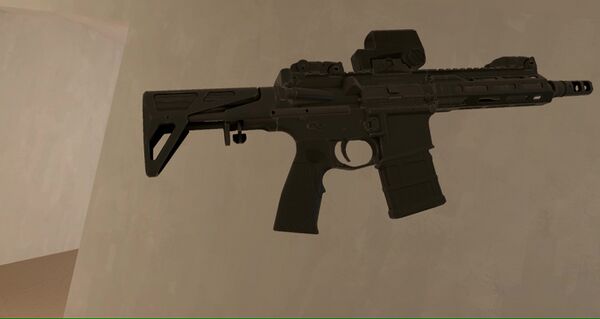
Flipping the rifle over, and pausing to examine it. Now, how'd those sights get on there?
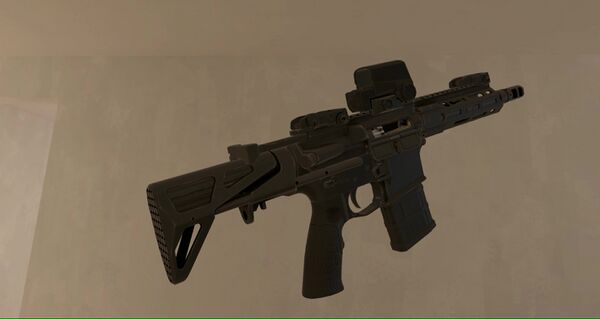
Deciding not to look a gift optic (nor gift BUIS) in the mouth, and chambering a round.

Extending the DD PDW stock - not gonna be much use pushed all the way in like that.

"Three Sosigs break into my Grillhouse..." 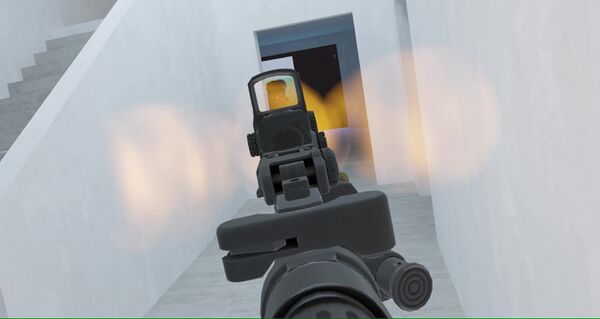
Punching a pencil-sized hole in the first Sosig; he's probably dead on the spot, though the absolutely enormous muzzle flash created by 5.56 out of a 7.5" barrel with that large of a muzzle brake makes it a bit hard to tell.
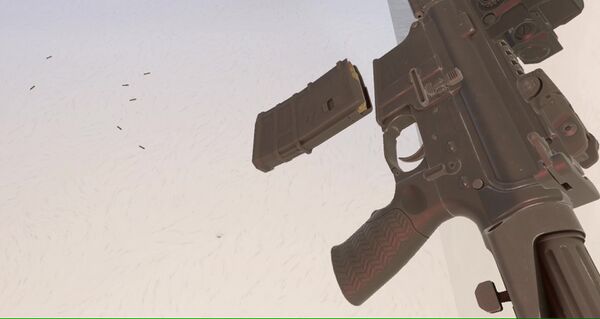
Performing a quick reload - the last mag wasn't empty, but with only 20 rounds a pop, it can't hurt to top off.

Except when the remaining Sosigs decide to seize the opportunity you just created. This shot would've been a kill, but Sosigguns are quite remarkably resilient, and have a strange tendency to wind up in the exact spot you were going to shoot. Good thing we've got more to work with.
"PEN15"
A customized AR-15 fitted with red-anodized Strike Industries parts appears as the "PEN15". In the Devlog, Anton mentions that this gun build has a few amateur builder mistakes, specifically pointing out that the feed ramp is wrong for the receiver.

Taking the PEN15 out for a spin in the hallowed halls of Take & Hold: Containment. Seems a fitting location, given that both are of somewhat questionable composition, and likely involved a considerable amount of pain medication.

The red-anodized C-More sight (bridging the receiver and handguard) and Fortis SHIFT foregrip (mounted on an MLOK-to-Picatinny adaptor, and placed a bit too close to the magazine well to really give a comfortable hold) aren't provided with the gun, but they do add a certain something to the look. As does the complete lack of backup irons.

Loading in a 60-round quad stack mag. After all, it holds more rounds, and it costs more, so that means it must be better, right?

Extending the PEN15's stock. Yes, this file is named exactly what you think it is.
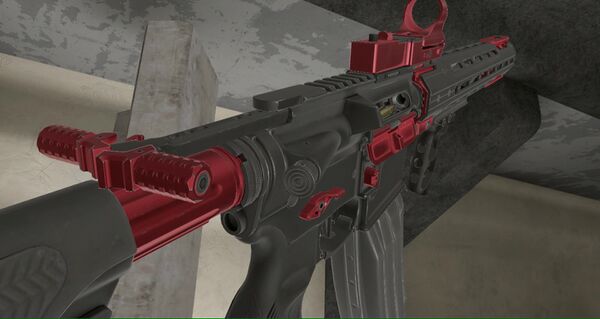
Pulling the red-anodized charging handle back over the red-anodized buffer tube, and getting a look through the ejection port (past the also-red-anodized dust cover); as mentioned, it has the wrong type of feed ramp/barrel locking extension installed, leaving a noticeable "step" between the extension and the chamber.
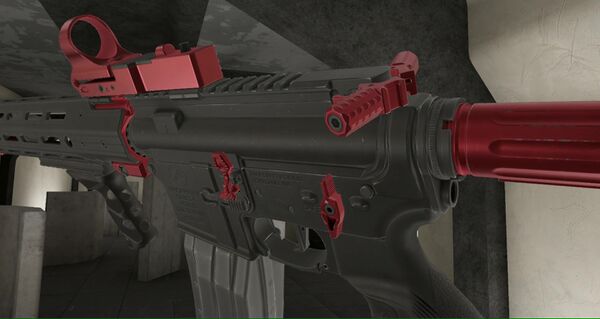
Flipping the safety (a Strike Industries Strike Switch that's been - you guessed it - anodized in red); while it might look backwards, the Strike Switch is apparently supposed to go on like that, with the larger paddle end being the one further from your thumb.
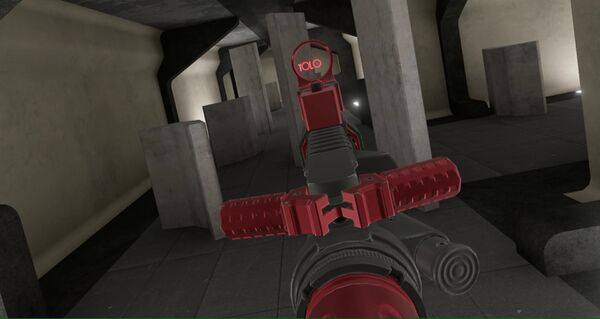
Aiming; this is the same "YOLOgraphic" sight used on the "IPSICK 2011", silly reticle and all. Well, it's hard to argue that it doesn't fit.
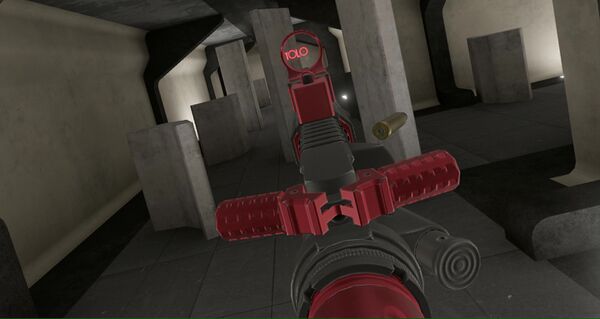
Putting a round arbitrarily into the concrete. Fortunately, a rifle like this probably isn't going to see much use beyond occasional trips to a flat range for self-aggrandizing Instagram photoshoots, so it's not like hitting precise targets is that important.
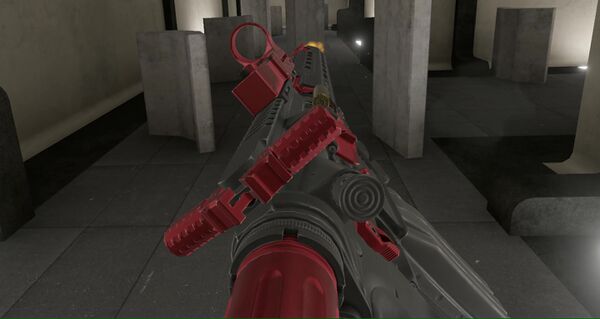
Firing some more rounds in the now-ubiquitous sideways-tilted stance. After all, it's what all the cool guys on YouTube and in action movies and games do, so clearly it's the superior ultra-tactical oper8or method.
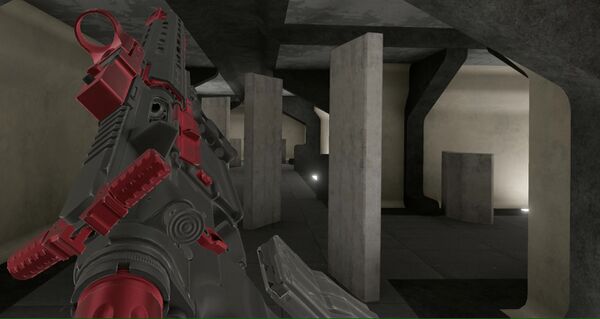
After successfully getting (self-perceivedly) cool-looking footage of the rifle being rapid-fired (with no regard for what it's being fired
at), the rifle's more-money-than-sense rich-kid owner presses the magazine catch (which protrudes further than the fencing ostensibly meant to shield it), and senselessly drops a somewhat expensive quad-stack magazine on the floor.
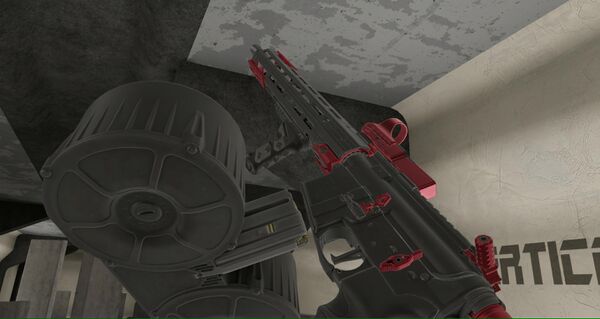
But hey, if a 60-round mag that costs $130.00 is good, then a 150-round mag that costs $433.67 must be even better, right?
CZ 858
The last of Update #59's Sa vz. 58 variants was a synthetic-stocked CZ 858 civilian sporter carbine.

CZ 858 with polymer furniture - 7.62x39mm
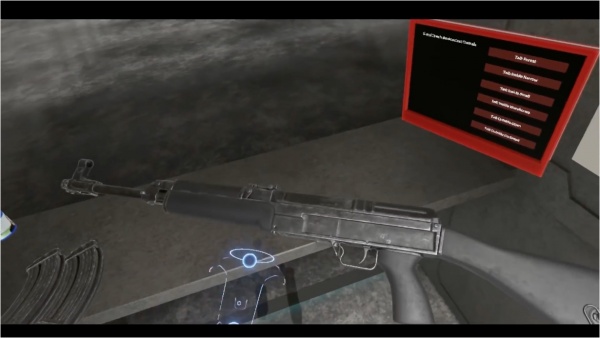
The rifle's other side. As one might expect, it's more or less the same as the standard vz. 58 from an aesthetic perspective, barring the fire selector and furnishings.
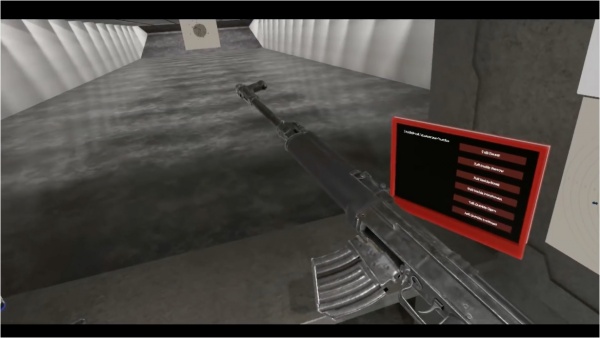
Loading a 10-round magazine into the 858. While thematically appropriate, the 10-rounder isn't the only available option; standard 30-rounders work just fine.
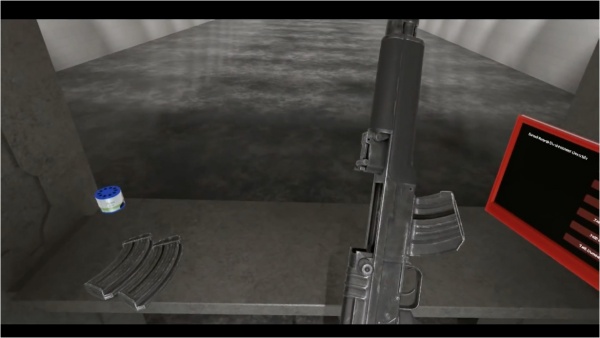
Pulling back the charging handle.
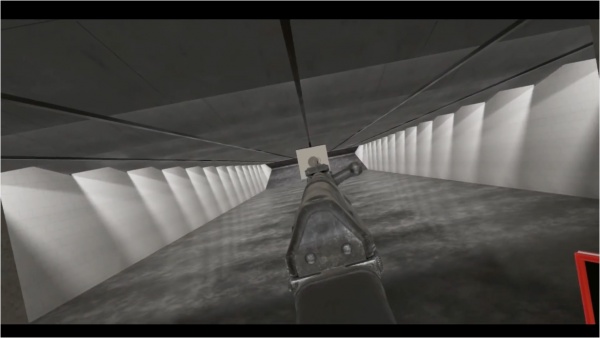
Aiming the rifle... poorly.
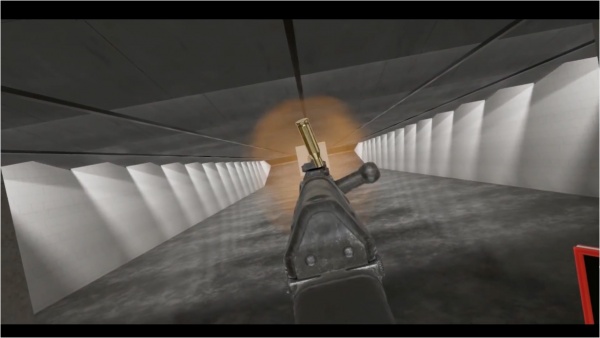
Firing the rifle in spite of this fact, with groupings to match.
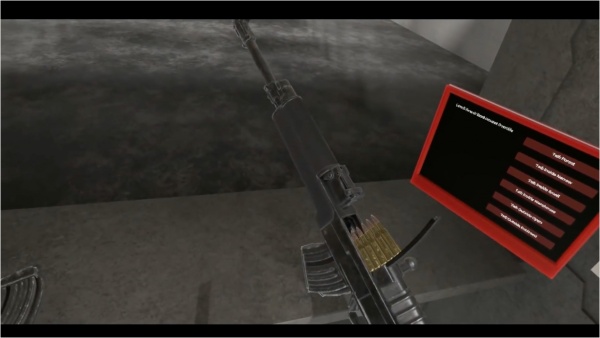
While there aren't many perks to using a 10-round magazine on a rifle such as this, one among them is the ability to fully top it off with a single stripper clip.
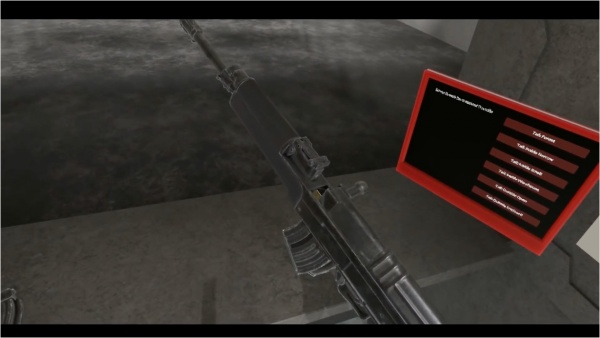
Letting the bolt slam back into battery.

The 858 was another one of the many guns that got an adjustable rear sight in Update #94; it goes from 100 to 800 meters, in 100-meter increments. This one's also been fitted with a PBS-4 suppressor - that way, if the sheer impossibility of making a target out at 800 meters without a magnified optic at HMD resolution doesn't stop you from landing a shot, the point-of-impact shift (another Update #94 addition) will.
CZ Scorpion Evo 3 S1
On Day 16 of the Meatmas 2022 Advent Calendar event, the game introduced a family of CZ Scorpion Evo 3 firearms; among them was the semi-auto-only S1 variant (not to be confused with the S1 Carbine below).
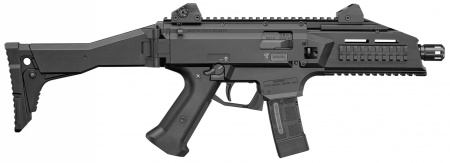
Scorpion Evo 3 S1 Carbine - 9x19mm Parabellum
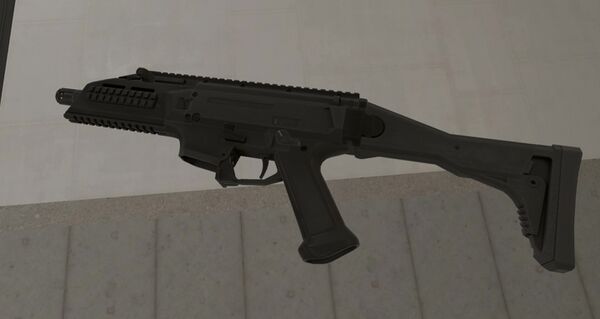
And, in a most-definitely-pre-planned move, here's the Evo 3 S1. Totally coordinated this with the rest, as the background quite clearly indicates.
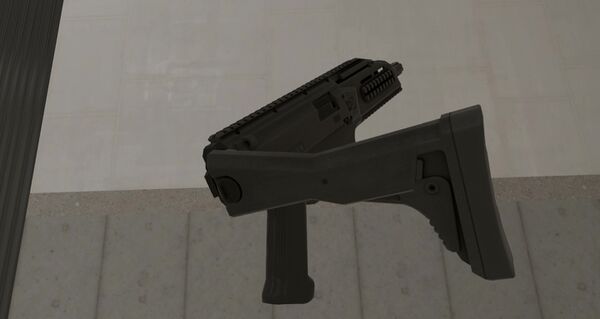
That's also why the stock-folding is being shown here, rather than earlier in the section.
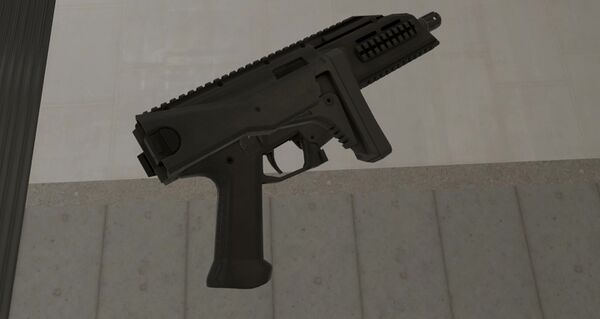
And why the resulting right-side shot is mostly blocked by said folded stock. Yep. This was definitely not an afterthought.

Locking back the charging handle...
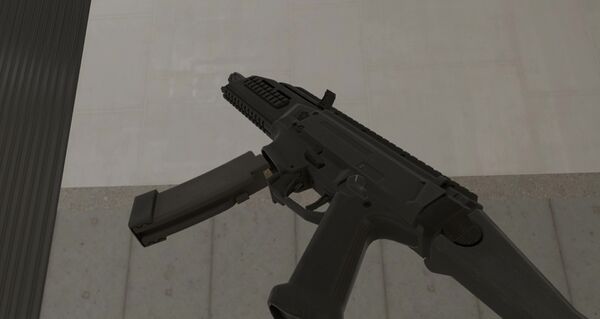
...shoving in a 20-round magazine...
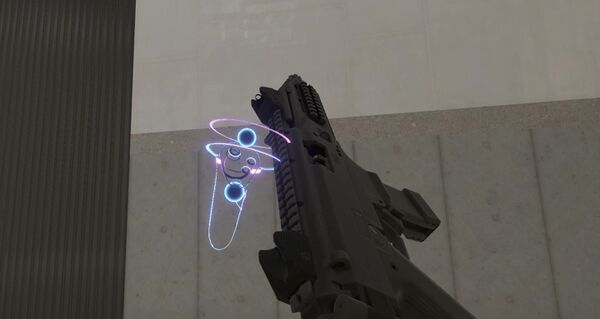
...and quickly slapping some sights onto the upper rail. Let's just pretend those were there the whole time, okay?

Disengaging the safety, and getting a good look at the main (i.e. pretty much only, outside of the markings) thing that distinguishes this from the regular Evo 3: the lack of any selector positions past semi-auto. As the size of the rectangle around the two positions left shows, this was about as forward-planned as this section.
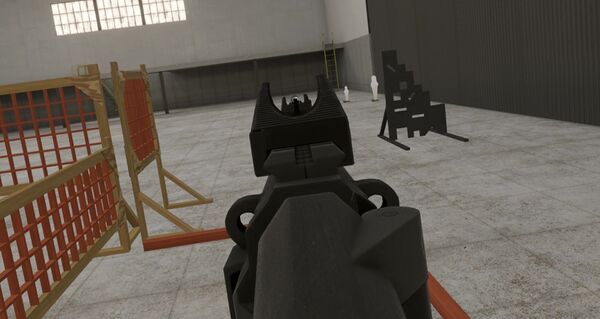
Speaking of, it seems that those sights might've been slapped on a bit too quickly.

Shrugging and firing anyway; nice as the new spent case models are, with their proper headstamps, burnt mouths, and struck primers, they still serve as something of an unfortunate reminder of how long it took to remember to take these shots.

20 of the other kind of shots later, the gun locks open...
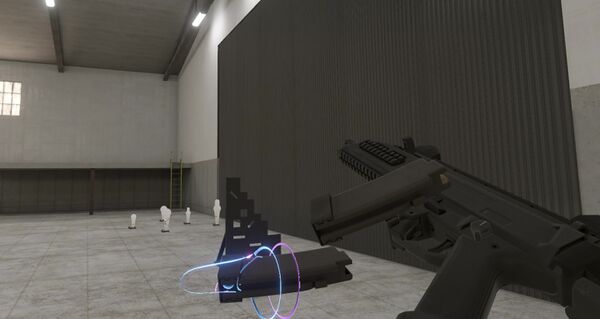
...prompting at least an attempt at a magazine-retention reload. Prior to the days of the mag-palming system, this was the best you could do - assuming you didn't mess it up and put the new mag on top of the old one, as seen here.
CZ Scorpion Evo 3 S1 Carbine
The final CZ Scorpion Evo 3 variant added on Day 16 of the 2022 Meatmas Advent Calendar event was the S1 Carbine, the longer-barreled counterpart to the S1 above.

Scorpion Evo 3 S1 Carbine - 9x19mm Parabellum
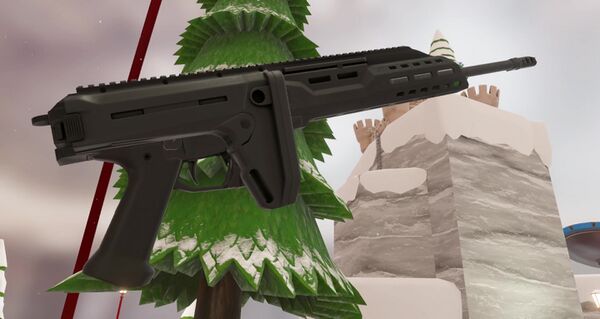
Hope you haven't gotten tired of these things yet. If you have, well, you've only got 10 more image captions to get through.
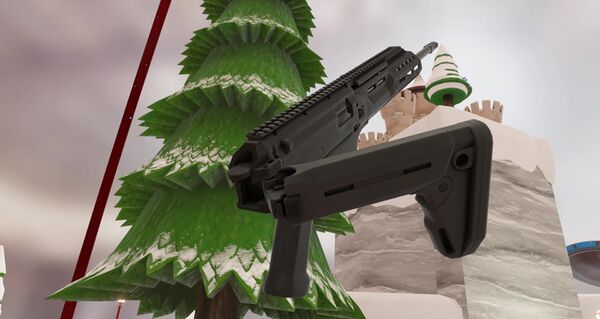
Counting this one. But not that one. Which - ah, forget it, here's the stock doing the thing that it does.

This makes the gun substantially more usable, at the cost of making it harder to fit in frame. One of the perks of having long arms, I suppose.

Once more, same as before, locking back the charging handle...

...and being made sad by the actions of politicians.
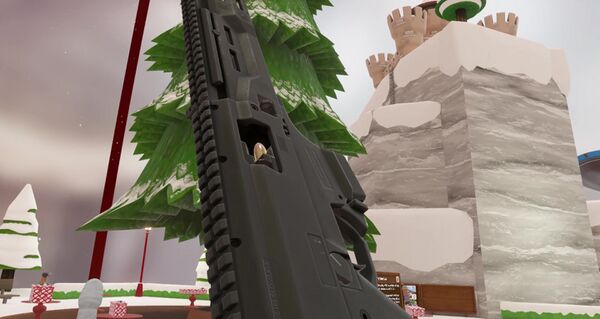
Without the fun of a normal-capacity magazine, it's understandably rather hard to work up the enthusiasm for a proper slap - hence the gentler chambering seen here.

Disengaging the safety, after remembering to install a set of sights; these are the concurrently-added "LPA" variety, as opposed to the standard set.

Taking aim at a tree, in the hopes of clearing some of that snow off.

This works about as well as you'd expect, take or take about 5.3 standard effectiveness units.
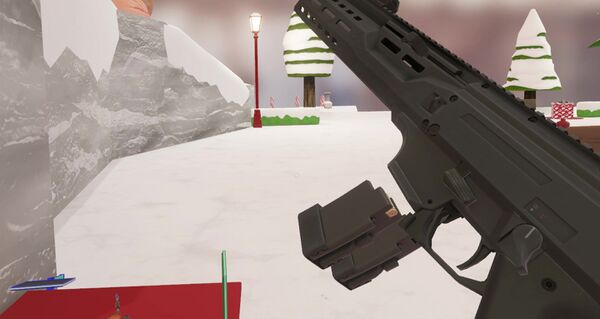
Needless to say, a lack of effect-on-target combined with the aforementioned undersized magazines quickly leads to this. Or rather, leads to the situation that demands this, that being an empty gun.
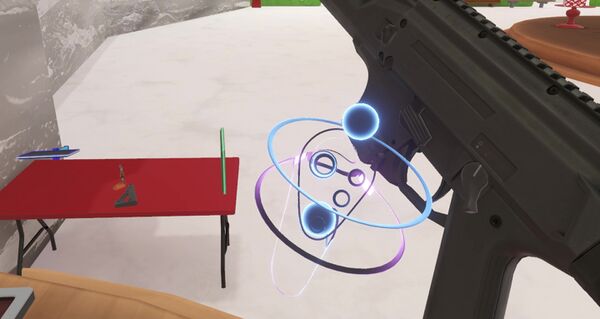
That, in turn, leads to a situation (a loaded gun with a locked-back bolt) that demands this (pushing the bolt release). And with that, the Scorpion Saga finally comes to an end.
De Lisle Carbine
Update #76's first alpha added the De Lisle Carbine, an integrally-suppressed Lee-Enfield derivative chambered in .45 ACP, intended for use by British special operatives during the Second World War. Despite the name, it is categorized with the bolt-actions rather than the carbines in-game, on the basis of its action.

De Lisle Carbine - .45 ACP

A De Lisle Carbine sitting on a table, alongside several other bolt-actions of the same approximate period (albeit far more normal ones).
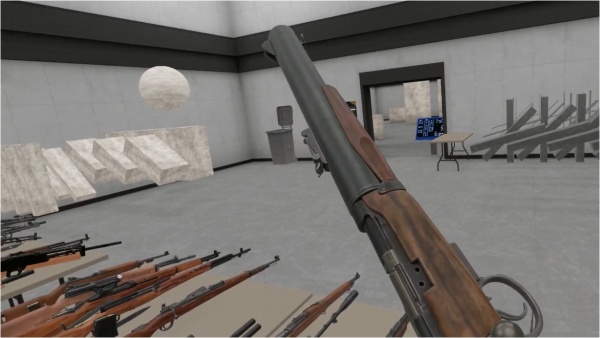
...before noticing that the magazine apparently decided to just take a break.
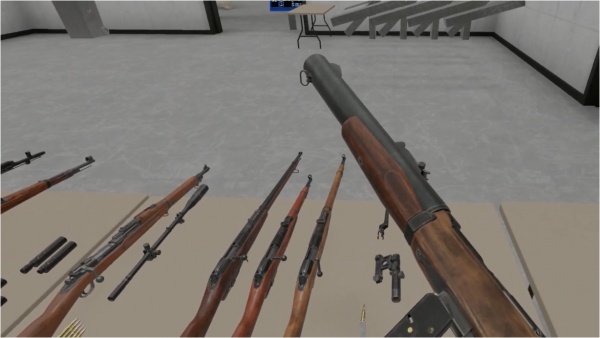
Rectifying the above issue, by reminding the mag that it's not part of a union, and can be fired at the employer's discretion. This is a specially-modified
M1911 magazine, intended for use with the De Lisle.
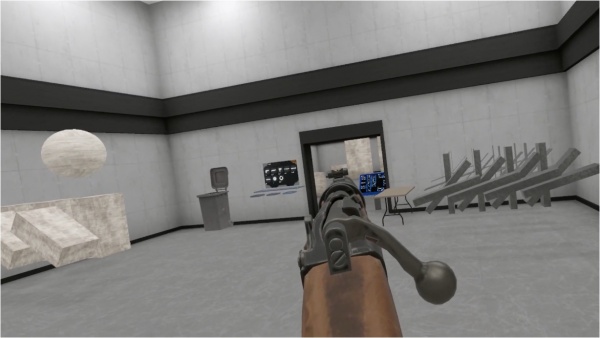
Giving the sights a try; these are rather obviously different from normal Enfield sights, being meant for a subsonic cartridge and attached to something other than the original barrel (which isn't even a part of the gun anymore, as the .303 barrel was replaced with a modified barrel from a
Thompson as part of the conversion process).

Firing off a shot. Given the
incredibly soft report (the De Lisle is the quietest firearm in the game, and one of the quietest ever created), the nonexistence of a muzzle flash, and the lack of any automatic cycling system, the only real indication that a shot has been fired (other than effect on target) is the dropping of the striker, as seen here.

It's so quiet, in fact, that the process of cycling the bolt is actually louder than the gun firing. Not that you can tell from a still image, of course.

Adjusting the carbine's sights; given .45 ACP's rainbow-like trajectory (and the weapon's intended role), these only go from 50 meters to 200, in 50-meter increments.
Desert Eagle Police Carbine
Day 10 of the Meatmas 2022 advent calendar event brought a large selection of new .50 caliber Desert Eagles; the standout among them though was the extremely rare (and thus previously unportrayed) Desert Eagle Police Carbine. As the name suggests, it was marketed primarily towards law enforcement, though it never found much commercial success, if any. The in-game model is a fictional Mark XIX version of the carbine; the real carbine was only made in Mark I model.
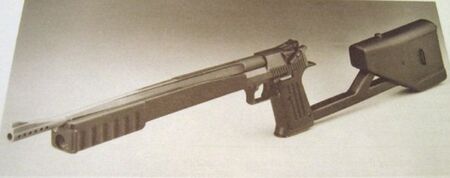
Magnum Research Desert Eagle Police Carbine - .357 Magnum
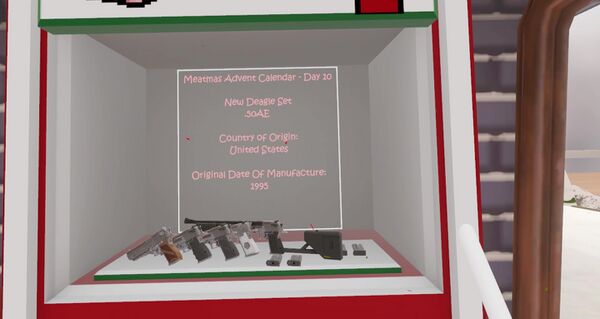
Hey, you remember this picture from a few sub-pages ago? No? Good, because otherwise there'd be no reason for me to put it here.
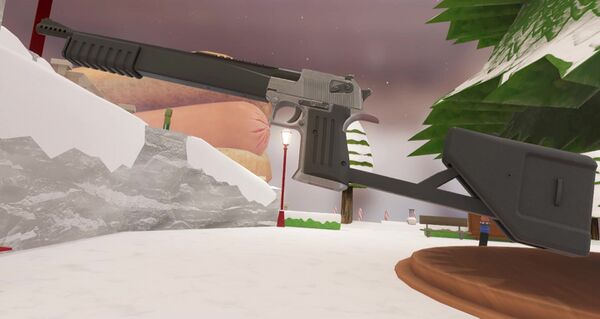
Anyway, here's the biggest thing from that box: a gun that, in a very technical sense, doesn't exist outside the context of this game.
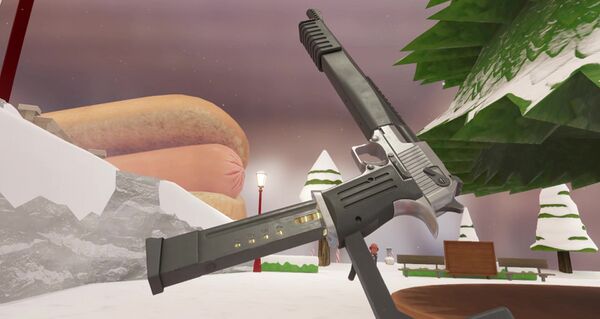
Loading in a 10-round magazine; while some such magazines exist, they're only for the .44 variants (and, by extension, any similar cartridge that'd fit into a .44 Magnum magazine), and they lack the polymer base, so these are (sadly) likewise a work of fiction.
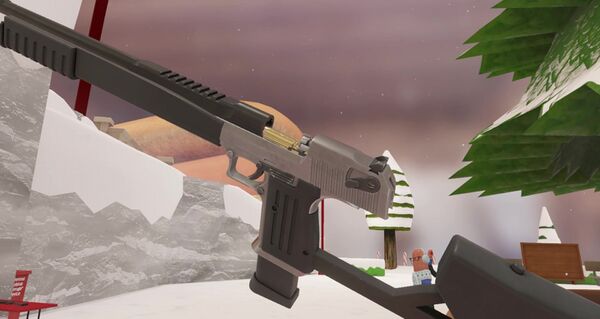
Racking the slide - not something often done strong-handed, but then again, very little is done often with such a weapon as this.
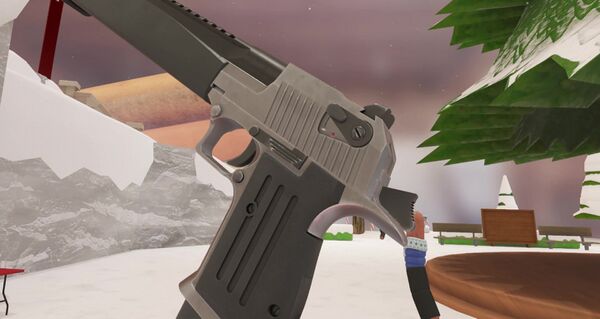
Finally remembering to disengage the safety...
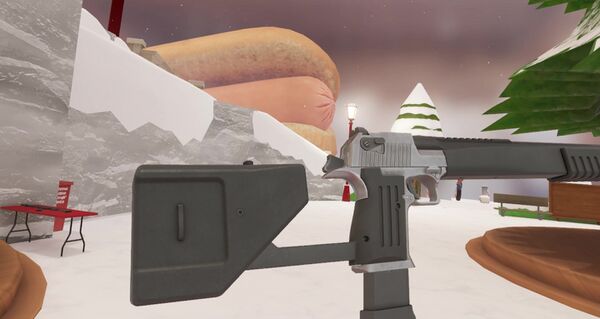
...and fiddling with the adjustable stock. Which, coincidentally, also doubles as the closest thing you're getting to an actual right-side shot. (Hey, in my defense, you're not missing much - the thing's about as close to symmetrical as a magazine-fed firearm can get).
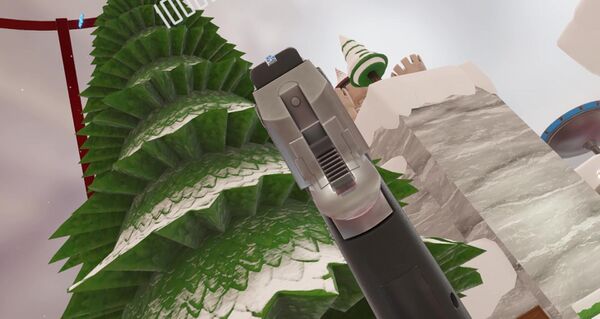
Aiming at a distant crystal snowflake; the sights are about the same as the normal variants, though (like the other elongated Deagles) their relative widths don't account for the increased sight radius.
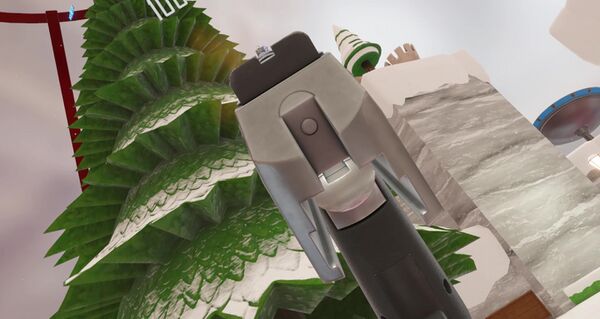
Still, they get the job done.
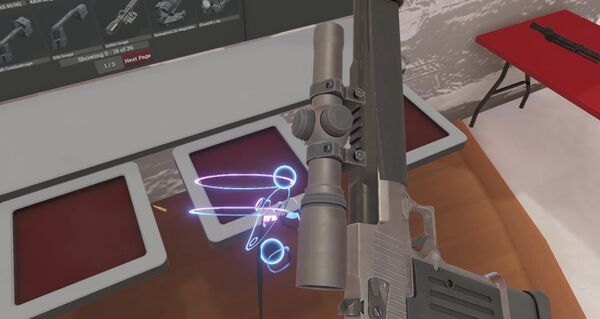
If you're not satisfied with that, why not try an optic? This particular scope (simply called the "Deagle Scope") was added when the new Deagles hit the main branch; while intended for the Desert Eagles (as the name would imply), it works quite nicely on most things.
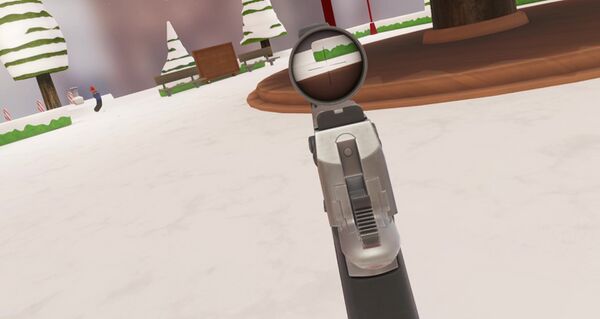
The reticle's a simple, fine crosshair, with just enough magnification for a carbine chambered for a round right at the top end of what could reasonably called a pistol cartridge. It definitely helps in allowing the Desert Eagle to achieve its fullest potential - the lofty heights of "somewhat practical".
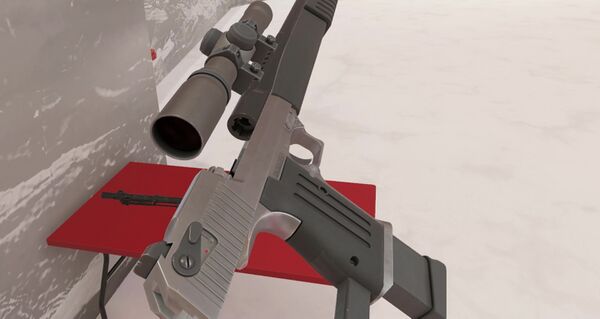
Though, as anyone in a ban state can tell you, mags that top out at 10 rounds will always be a limiting factor in terms of practicality.
Diana Model 27
Added on Meatmas Day of 2022, a long-requested Air Rifle was added to the game; specifically, a spring-piston air rifle that appears to be a Diana Model 27.

Diana Model 27 (post-WWII; Dembro-manufactured) - .177 pellet
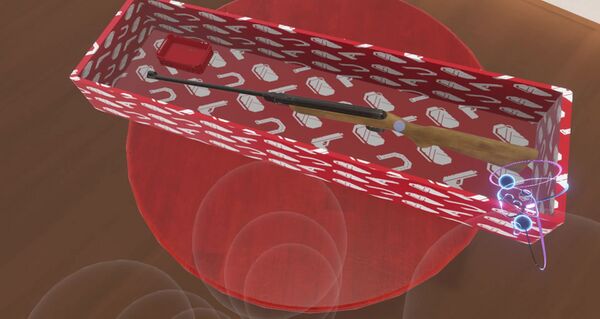
Opening up a gift box beneath the Meatmas tree to reveal... probably the most reasonable thing thing of the bunch to actually find in one of these, really. Perhaps barring the tiny milk-crate full of pellets.
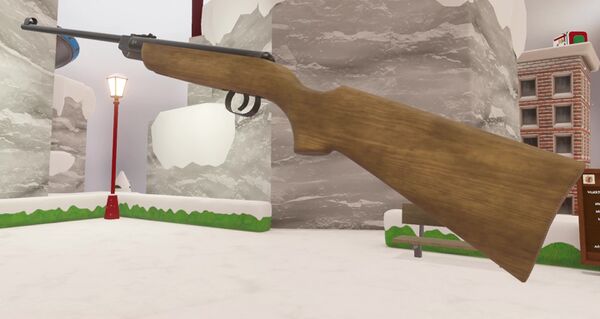
Taking a good look at the Diana.
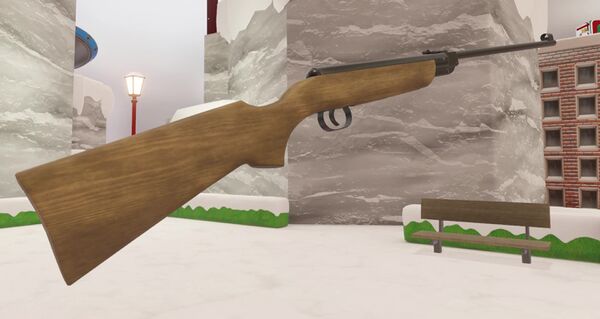
She's a nice-looking gal - very symmetrical features.

Cracking open the pellet gun; unlike the game's other break-actions, this has to be done manually, as (aside from there being no locking lever within easy reach of the firing hand) the weight of the barrel isn't enough to overcome the tension of the piston's spring, requiring additional force to fully cock it.
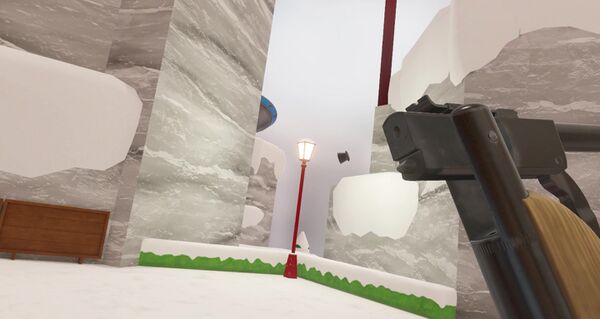
Loading in a .177-caliber pellet; this is technically the smallest-caliber projectile the game has to offer, beating out the previously-tiniest 4.6x30mm HK round. The pellet itself is a typical diabolo-shaped design, which improves efficiency in ways that would probably require several semesters of fluid dynamics classes to explain or understand.
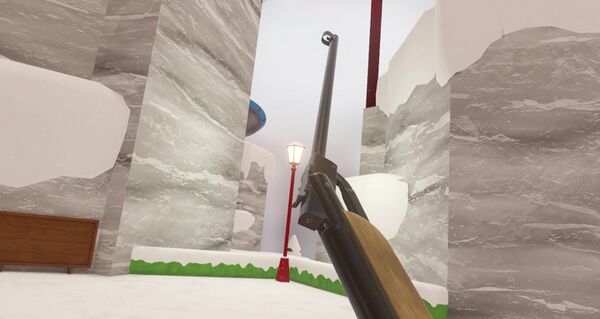
And, seeing as I have neither the motivation nor the Adderall necessary to go through with that, we'll just stuff it in and move on.

Aiming at a wall; the sights aren't technically properly aligned here, but this at least gives a good idea of what they look like. And, with the drop on these pellets, actually hitting things at reasonably-long ranges will probably require aiming like this anyway.

Alternatively, you can just cheat and use bullet trails, as seen with this hit on one of the few things in the game fragile enough to be destroyed by a .177-caliber air rifle pellet.
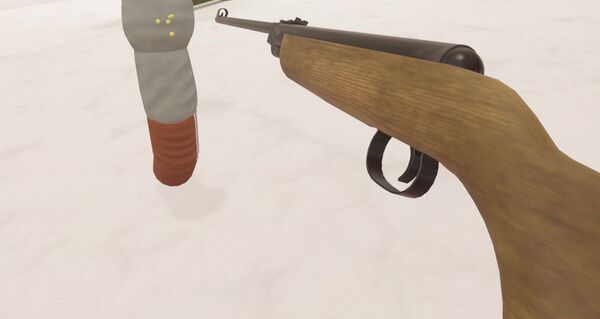
With another being the casing of a nearby Sosig. At least it doesn't have any
eyes to worry about.
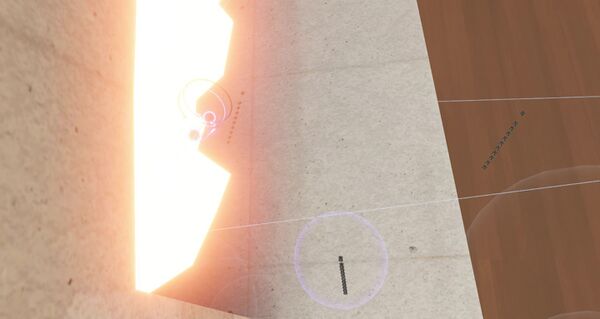
The aforementioned bullet trails also allow for a demonstration of a rather curious property of the pellets: being treated as "ammunition" in-game, they share the same basic properties as self-contained cartridges, right down to their ability to cook off in response to heat or impact, despite being little more than solid pieces of lead with no associated propellant. This behavior is also shared with other propellant-lacking projectiles, such as the earlier-added 50mm potatoes, or the later-added tungsten-rimmed armor-piercing potato chips. Yes, you read that right.
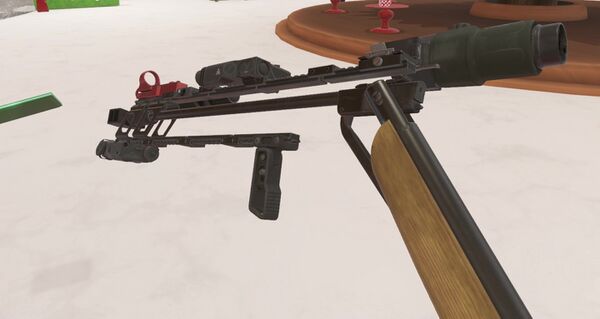
Of course, this being
H3VR, the pellet gun can take attachments. Its only means of doing so is via the muzzle; as such, an already-silly configuration can become even sillier upon attempting to load it. For the especially brave (or just impatient), a later update even added the ability to swing the gun shut with a flick of the wrist; with this much weight hanging off the end of the barrel, it's hard to imagine that being good for the barrel hinge or the user's arm.
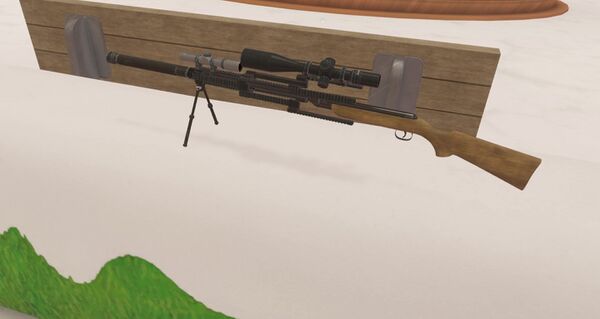
Oh, and it's not just muzzle rail adaptors and brakes, either - suppressors work too, in case you want to try and tame the deafening concussion of a .177-caliber air rifle.
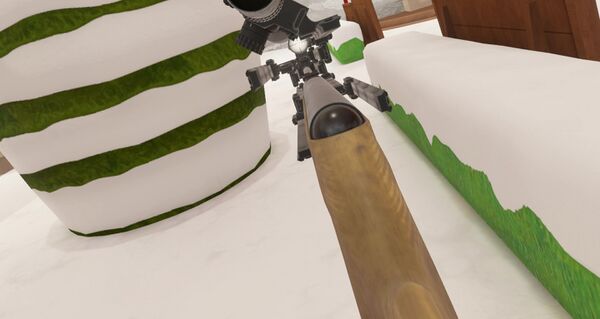
Trying out the lower of the two scopes on this monstrosity. The spiraling rail mounts don't serve any real purpose; they're just there to look neat.
FightLite Raider
The FightLite Raider, a civilian semi-auto AR-15 "pistol" (i.e. legally considered a pistol by US gun laws, but not really a pistol from a technical or logical standpoint; the game also classifies it as such) based on Ares' traditionally-stocked SCR lower, makes its media debut in H3's 58th update.

FightLite Raider - 5.56x45mm NATO
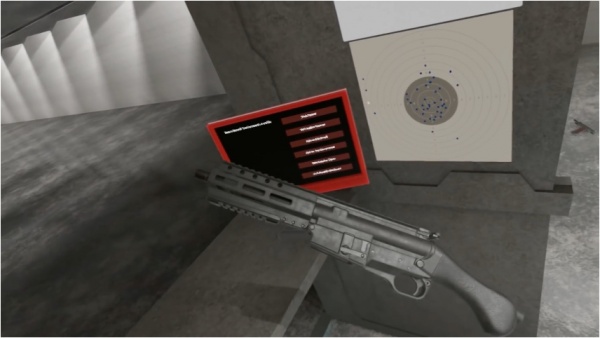
Taking a look at the downright bizarre concept that is the Raider.
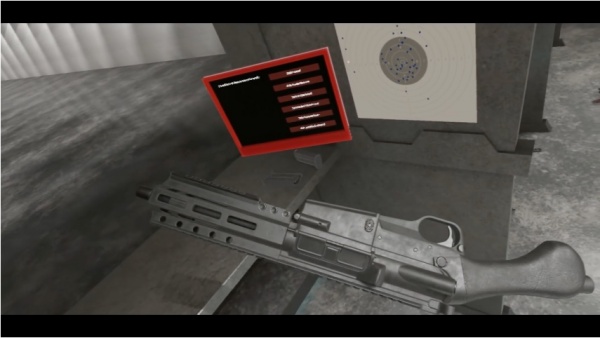
The right side, which is just as strange as the left.
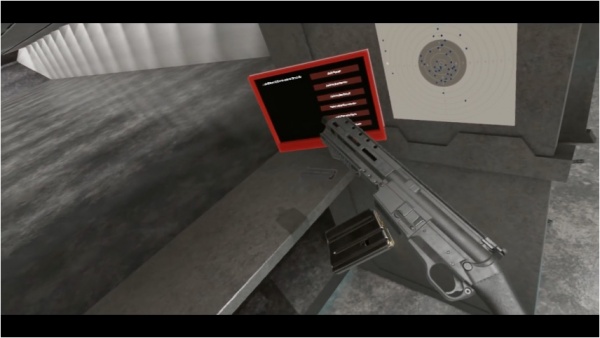
Loading in a 10-round magazine, for maximum legal compliance.
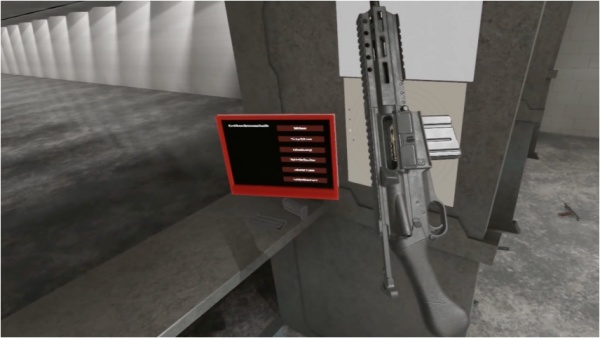
Pulling back the charging handle; as with the game's other AR variants, the dust cover correctly pops open.
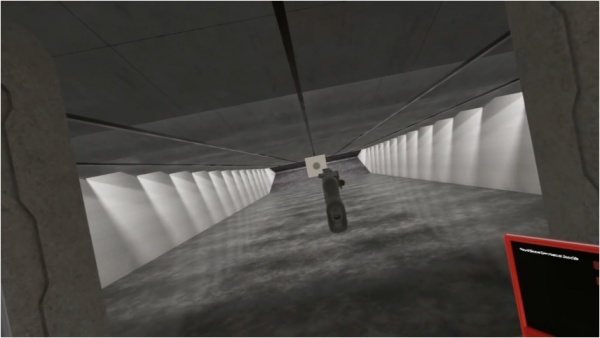
"Aiming"; the top rail can be used to mount irons or optics, but doesn't come with any by default, not that a stockless rifle with the ergonomics of a flintlock pistol is something that one expects terribly good accuracy out of, anyway.
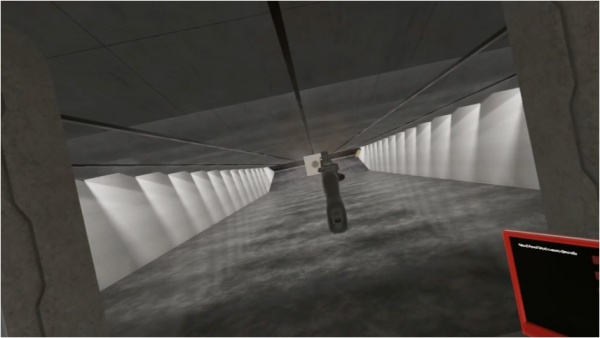
Firing the Raider. Being a short-barreled rifle in every sense except that of the law, the Raider produces a suitably impressive muzzle flash; however, this isn't exactly something that can be captured well in a still frame.
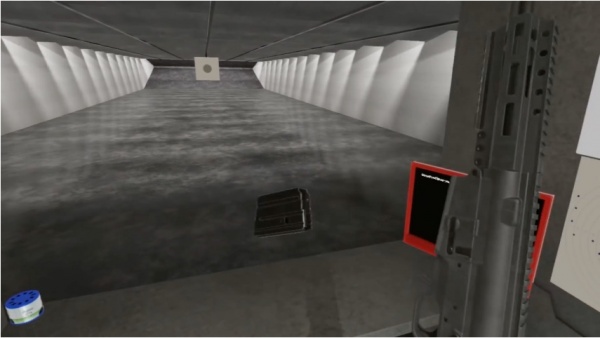
Removing the now-empty magazine; while these drop free from most AR-pattern rifles, the Raider's grip is too far back for the magazine release to be accessible with the firing hand, so the magazine has to be removed manually.
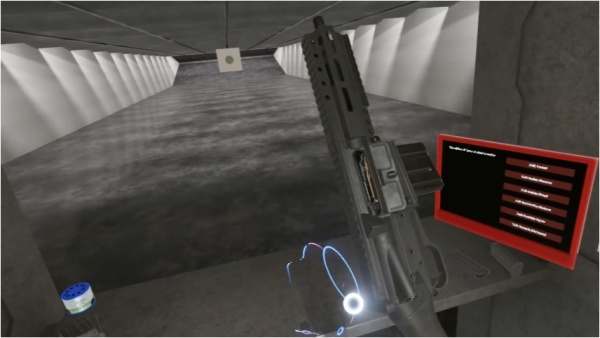
Furthermore, while the bolt does lock back, the Raider doesn't actually have a bolt release.
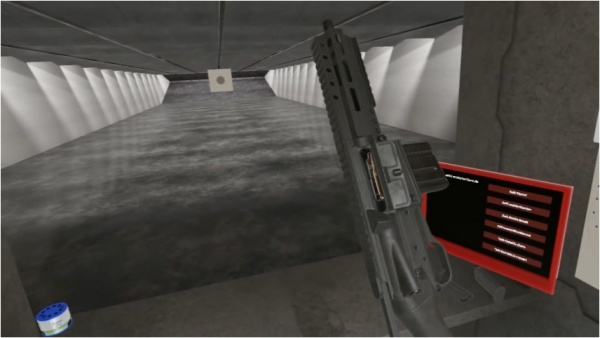
As such, the bolt must instead be returned to battery with a quick tug of the charging handle.
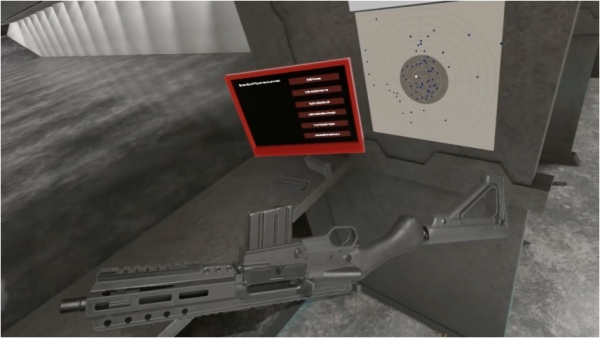
As if the whole situation wasn't strange enough already, the Raider in-game is compatible with all of the stocks that can be attached to actual handguns, allowing for the creation of odd-looking carbines like this.
Girandoni Air Rifle
The Girandoni Air Rifle was added in the Meatmas 2023 update. This is its first known media appearance; the game accurately simulates not only its manual of arms, but also the refilling process for the air reservoir.

Girandoni Air Rifle - .46 caliber

After finishing up the rest of the circle, we come to the ultimate box. Paralleling last Meatmas, there's a little plastic tray for some air rifle... "pellets".

Yep, despite appearances, this thing's not a simple musket. Not even an air musket - fully rifled and everything.
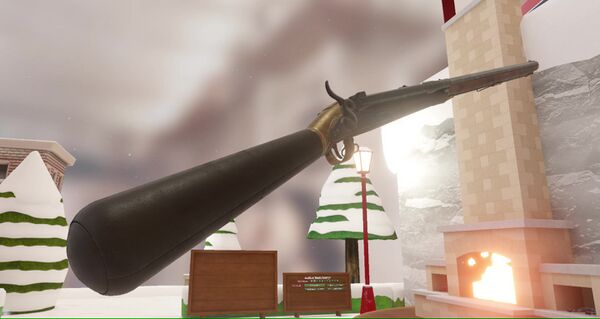
Furthermore, dating to the late 1700s, it's one of the oldest guns in the whole game. To give perspective, this thing hails from the
Holy Roman Empire.

To load it, pop open the end of the magazine tube...
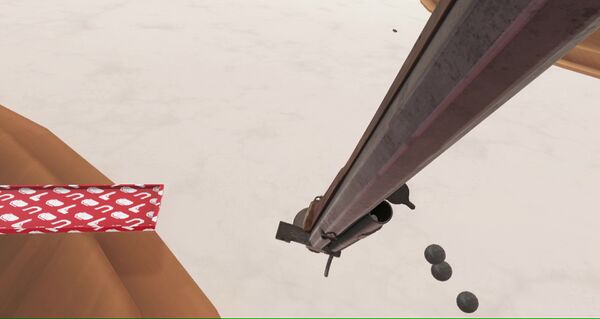
...and dump in some .46-caliber lead balls (20, to be exact). While .46 isn't an unheard-of caliber for conventional muzzleloaders, nothing else in the game uses them at the moment.

Make sure to close it up when you're done - the tube's contents respond to gravity, so a quick tip can lead to this unfortunate sight.
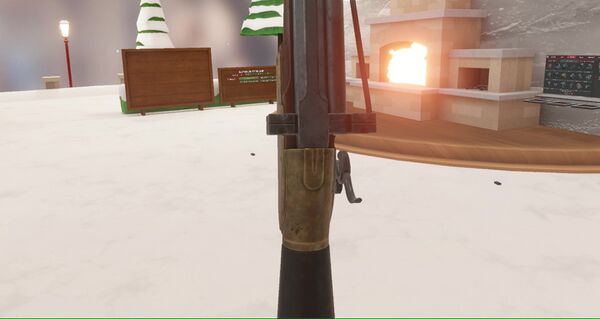
This also means that you have to tilt it back to chamber a ball, as the magazine lacks a spring; pushing this block over to the right brings a hole (not visible here) into line with the magazine instead of the barrel, allowing a ball to fall in. Once released, the flat spring that runs alongside the magazine pushes it back, bringing the ball into line with the barrel (and the small hole at the back of the breechblock into line with the air valve); this makes it the oldest weapon in the game (and, indeed, one of the oldest of all time) to be capable of storing an extra round in the chamber.
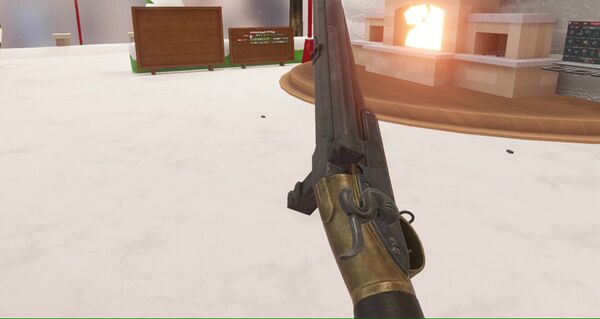
Cocking the hammer; this sets the trigger and cocks the springs for the internal valve system (allowing a brief pulse of air to escape the reservoir). The actual strike face of the hammer doesn't do anything, mind you - it's simply set up this way for the sake of familiarity to its flintlock-wielding target market.

Taking aim at a steel plate. For a gun around 240 years old, it's got pretty decent irons.
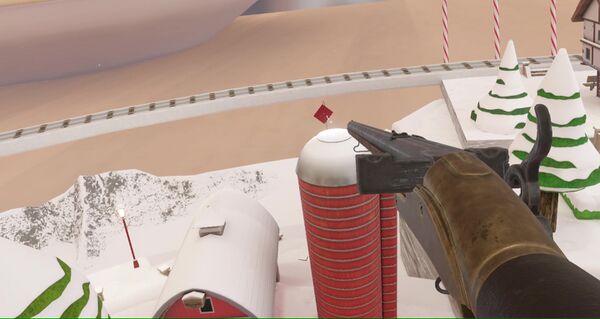
Splattering a lead ball against the target. While it doesn't have a tremendous amount of muzzle energy, 20+1 quickly-cyclable rounds on tap with zero muzzle flash and nearly no sound is nothing to sneeze at in-game; for the 1780s, it was utterly unheard of. Sadly, it came at a cost, rather literally - the tolerances required for air-tight seals are rather tight, and were even harder to reliably make in the 18th century, making the Girandoni a very expensive (and very wear-susceptible) gun.
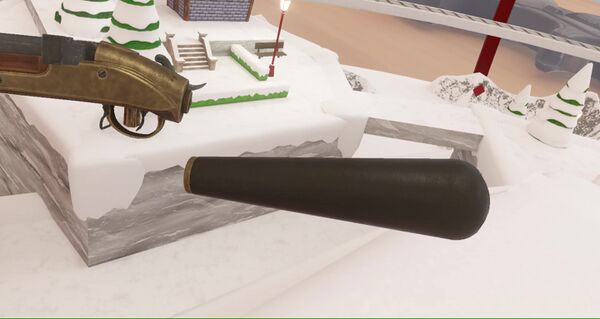
Oh, and if you're wondering why the stock looks like that, it's not just a stock - it's a threaded-on air tank, good for about 30 shots (albeit with decreasing energy for the last 5 or so - the guns were expensive enough as-is, without having to add in some sort of complicated variable-volume constant-pressure air reservoir).

While these can be spawnlocked and duplicated infinitely in-game (in a manner that the Austrians could only dream of in the 1780s), for those wishing to go the extra mile, the in-game gun comes with a pump - just screw it in, and get to work.
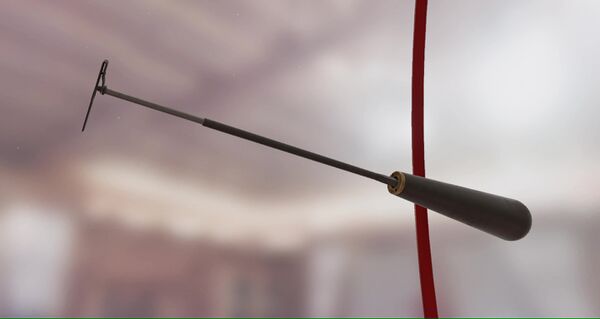
"Work" being the operative word - completely filling this thing takes about 1,500 full strokes of the pump, which is exhausting even without having to fight actual air pressure. At least it's working properly now - upon introduction, the pressure was calculated incorrectly, leading to an exponential increase in pump requirements that turned a full charge into a multi-hour affair.
Heckler & Koch MP5SFA2
Interestingly, Update #63's collection of Heckler & Koch MP5 variants included the MP5SFA2, a variant of the MP5A2 with a 2-position safe-semi fire selector, developed as a pistol-caliber carbine for police use.
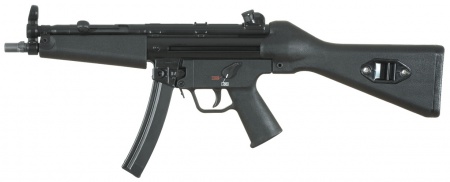
Heckler & Koch MP5SFA2 - 9x19mm Parabellum
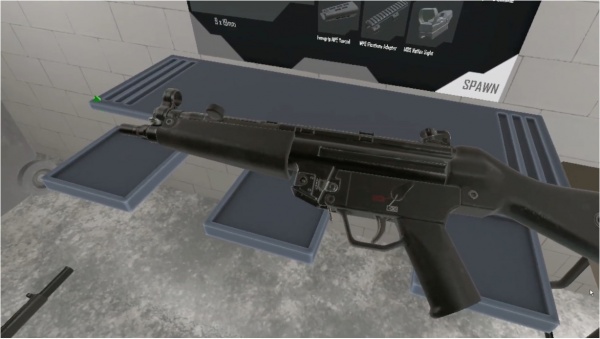
Examining the MP5SFA2. Like an MP5A2, but, y'know, SF.
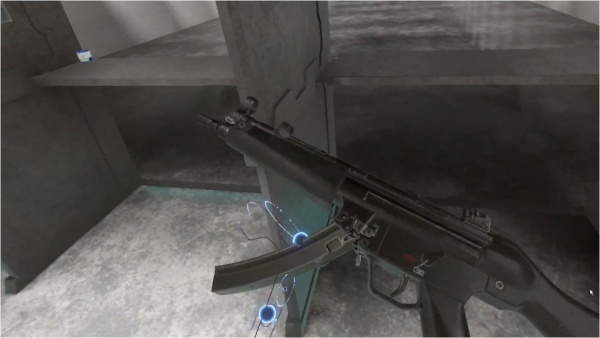
Loading in a standard 30-round magazine.

Pulling back the charging handle.
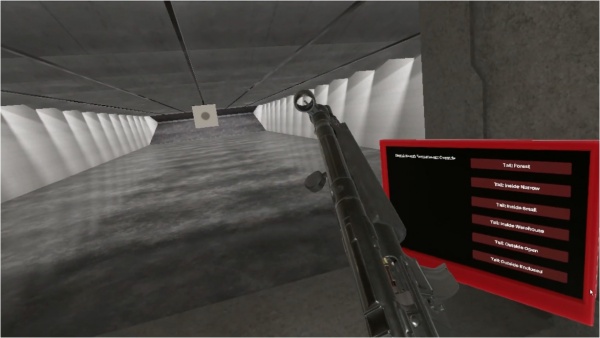
This is followed by a quick brass check. Just to be sure.
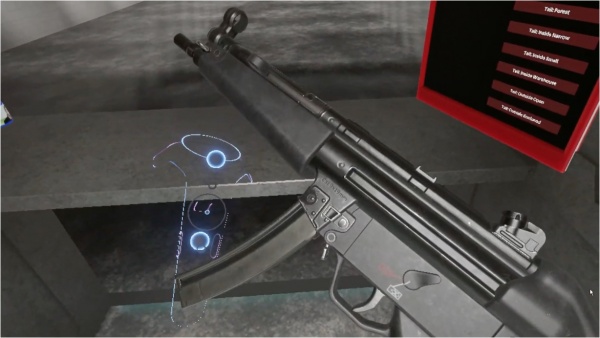
Taking a look at the lower, and flipping the selector switch from the first of its 2 positions...
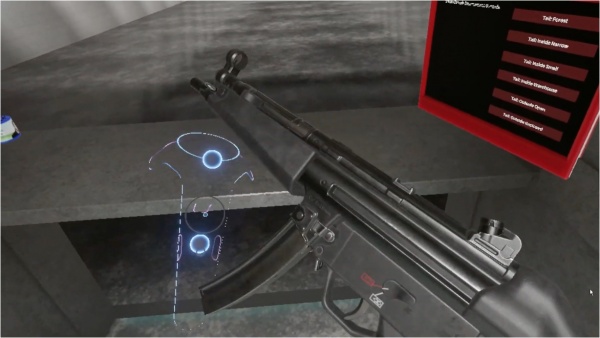
...to the second. Apparently the selector also doubles as a lightswitch.
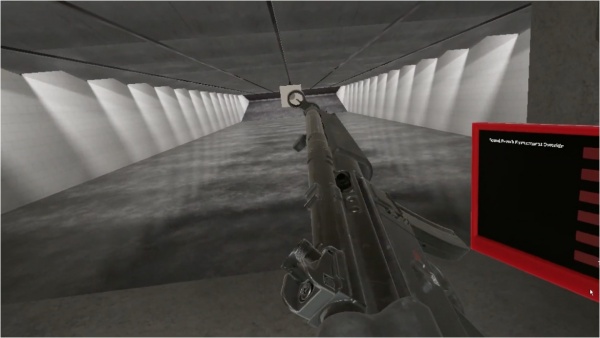
Checking to make sure that the safety's still off on this side, too. And also seeing that the bolt has somehow locked itself open.
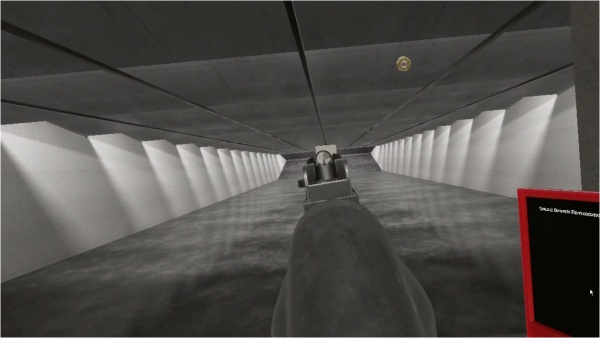
...and laying down the law, one round at a time.
Heckler & Koch MP5SFA3
Complimenting the MP5SFA2, the MP5SFA3 (a semi-auto carbine version of the Heckler & Koch MP5A3) was also added in Update #63.
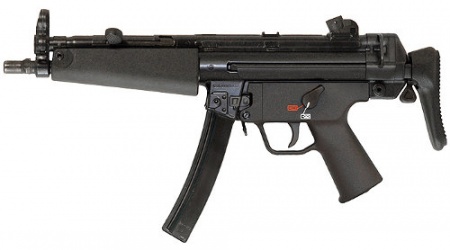
Heckler & Koch MP5SFA3 - 9x19mm Parabellum
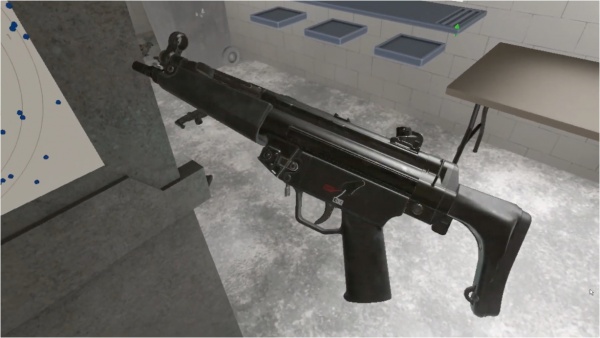
Examining the MP5SFA3. Like the MP5SFA2, but, well, A3.
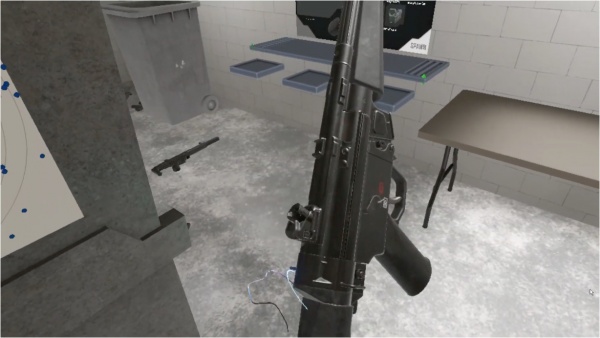
Flipping the carbine over...
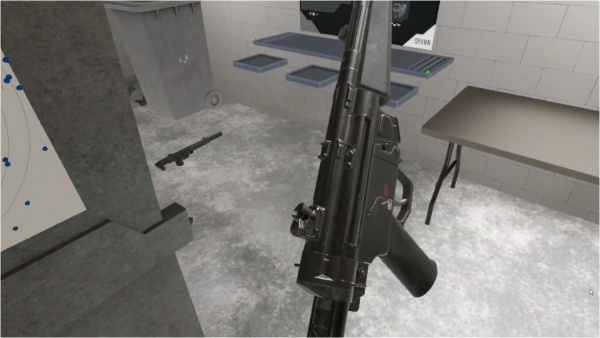
...extending the stock...

...and disengaging the safety.
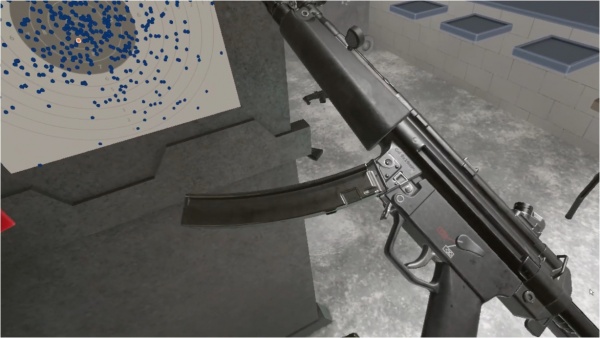
Once more, same as before, loading in a 30-round curved magazine.

Giving the charging handle a quick tug, while observing a target that probably should've been cleared a couple hundred rounds ago.

Attempting to line up the sights, and...
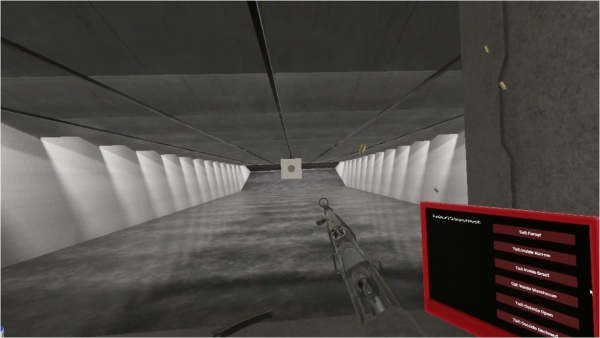
...
"Bah, to hell with it."Henry 1860
The Henry 1860 was added on day 10 of the Meatmas 2020 Advent Calendar event.
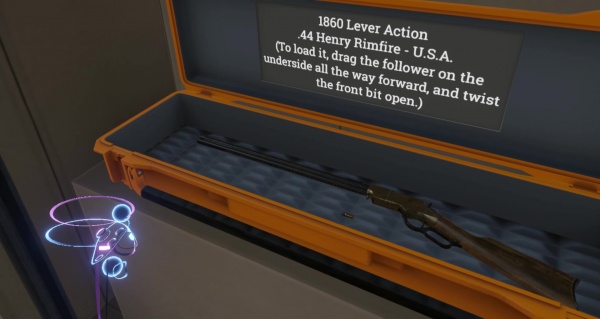
The Henry in its box - another oft-requested addition, in the game at long last.

Taking a step outside the bunker to admire the Henry: this is the left side...
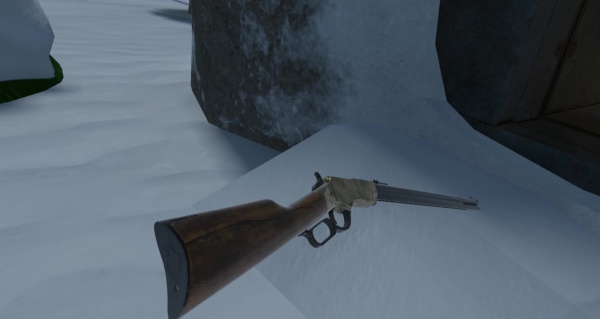
...and this is the near-identical "opposite" side, because the site won't let me create a file that calls it the "right" side for some reason.

"Alright, now how do I load this damn thing again?" 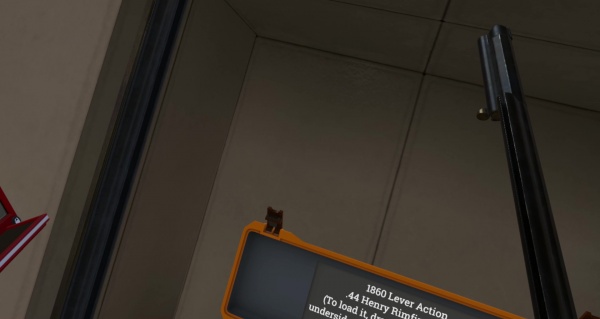
Following the instructions helpfully printed on the inside of the box, and twisting the pushed-forward follower to the side - it'd be easy to not understand this at first, given that the mechanically-similar
Volcanic Repeater (which was the Henry's direct predecessor) used a simplified system at first; it was later adapted to (correctly) work the same way.

Loading a single .44 Henry Rimfire round - added along with the rifle - into the magazine tube. Fourteen would later follow it.
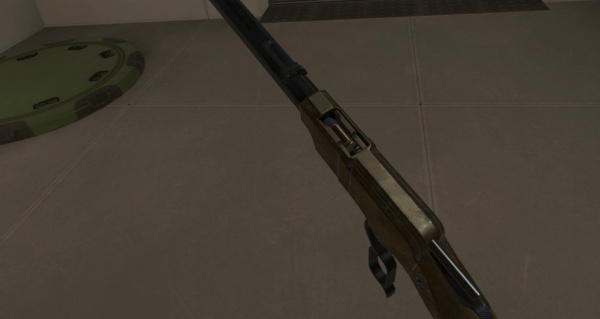
Chambering this round, with the magazine now closed; note the visibly-moving cartridge elevator. If you so desire, you can re-open the magazine to add a sixteenth round, but this is generally not considered worthwhile - if 15 rounds of .44 don't solve your problem, it's doubtful that 16 will.

Aiming the Henry at one of the bunker's walls; the sights are a nice, clear notch-and-post arrangement.

Which is good, because the muzzle flash and black-powder smoke cloud the rifle produces can obscure your view of your target for a moment - and in the Winter Wasteland, that can be a serious problem.

Cycling the Henry's action.
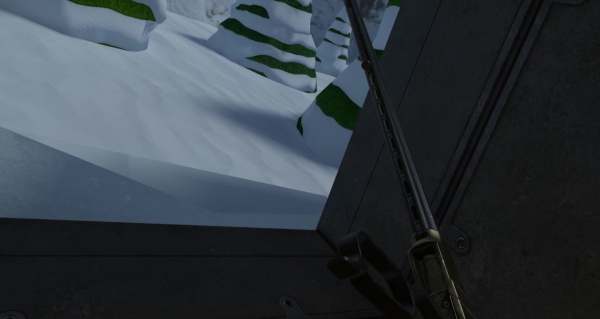
Doing so a few more times produces a picture like this; the open bottom and exposed follower of the Henry's magazine allows for a quick check of how many rounds are left in it. Also note the bottom of the elevator, which is currently busy elevating a round. Or, since the rifle is upside-down at the moment, depressing it.
KRISS Vector CRB
The KRISS Vector CRB, a long-barreled civilian carbine variant of the full-auto Vector, was added at an unclear point (presumably post-Update #53, since that was when the long-barreled full-auto Vector was removed from the game); it cannot be attained normally, instead showing up in Take & Hold as a rare drop when playing as Ricky Dicky Random, or as a slightly less rare drop from 3-point pistol-caliber carbine rolls when playing as Zombiehunter Zeke. Like the older version, it is a Gen I Vector, but fitted with the barrel shroud of a Gen II Vector CRB Enhanced, along with an AR stock adapter to which a Magpul MOE fixed carbine stock is attached.

Gen II KRISS USA Vector CRB Enhanced - .45 ACP / 9x19mm Parabellum
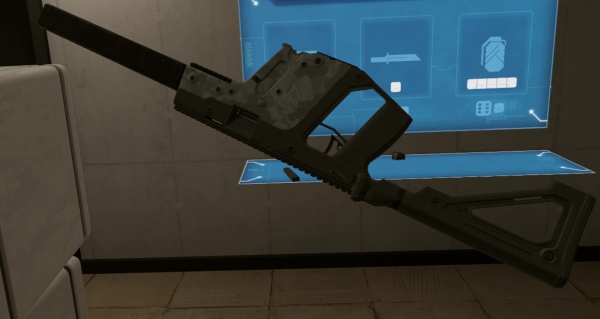
Rolling for a random gun, Ricky finds himself surprised by the inexplicable presence of a gun removed a couple dozen updates ago.
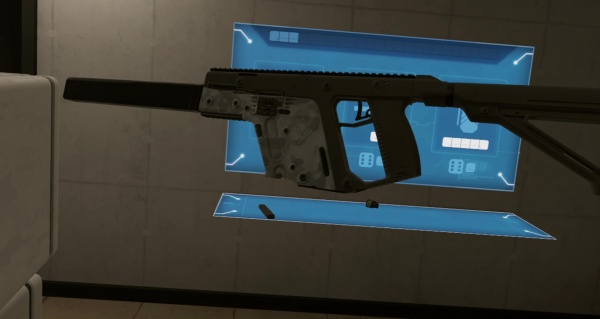
Still, he can't help but feel like there's something missing from it.
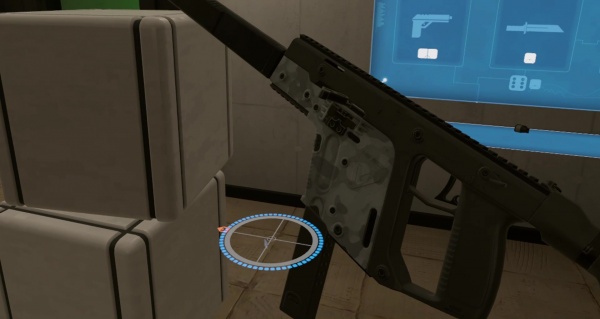
And no, it's not just a shot of the thing being loaded.
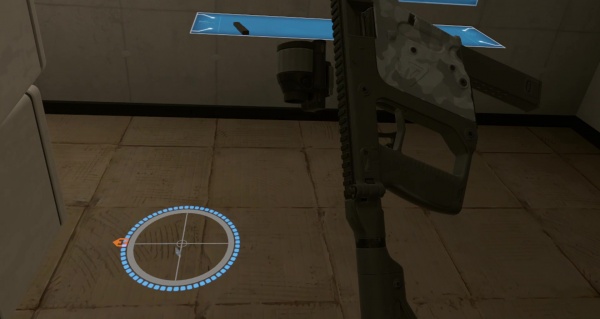
You could say "sights", but those were always missing from the Vectors. You could also say "the foregrip that they used to have", and you'd be right, but that's not the joke that this section is working towards, so please don't say that.
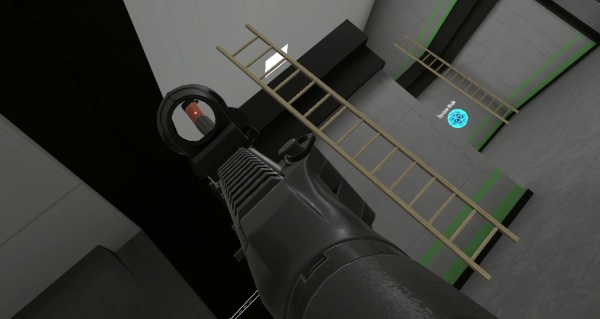
Aiming through the now-affixed Trijicon SRS-2 red-dot sight at a point-guarding Sosig...
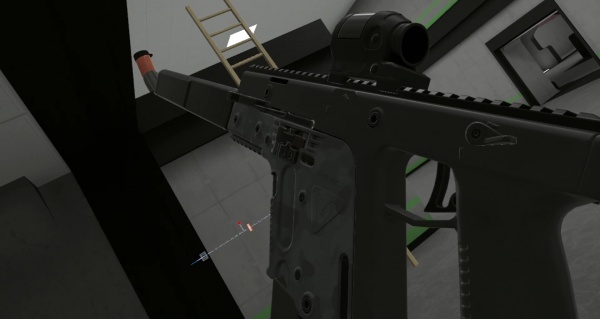
...and then, as is tradition, belatedly remembering to turn off the safety.
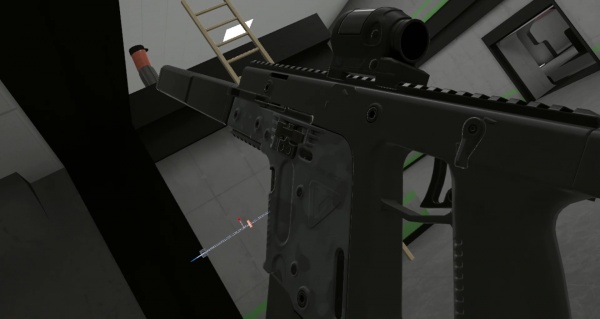
In doing so, Ricky realizes the bit that's missing: a second switch. The original long-barreled Vector was simply an SMG with a CRB's barrel and shroud, whereas this one is a proper semi-auto-only carbine.
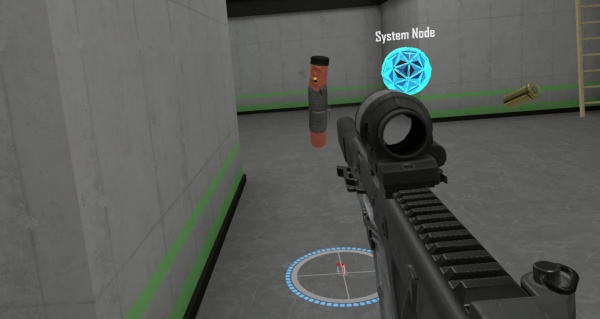
Popping another guard with the carbine; the relatively small muzzle flash and low recoil make it a bit hard to show what's going on at times.

Having finished a hold with it, Ricky concludes that the carbine Vector is, apart from the 16" shrouded barrel and lack of a giggle switch, pretty much identical to the SMG version. Case in point: both have side-folding AR stock adaptors.
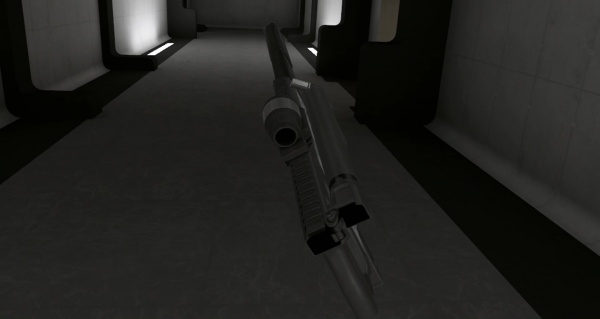
And, just like the regular Vector, actually folding this stock does rather interesting things to the ejection pattern.
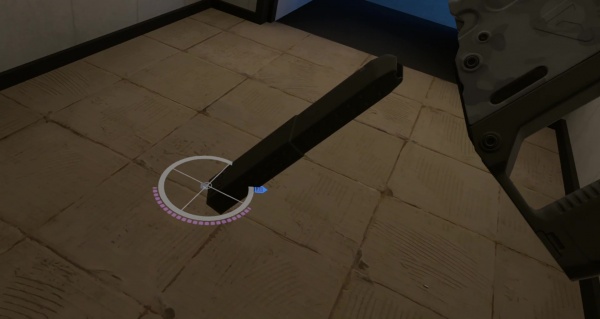
Having run dry after a supply-point clearing that was far more frenetic than it needed to be, Ricky pulls an empty magazine out of his Vector.

He then crams in
a loading shot, since this page was missing one a fresh mag, full of .45 ACP armor-piercing incendiary rounds. Yes, you read that right.
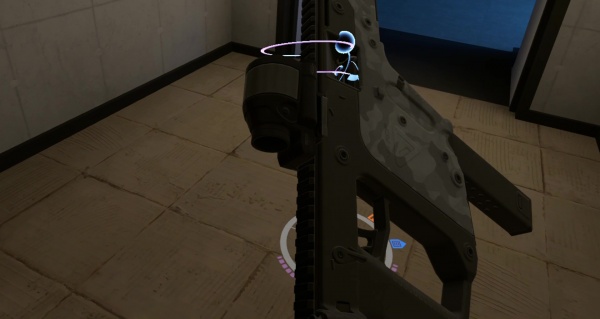
Chambering one of these rounds with a smack of the bolt release; since the player's hands aren't physical in-game, clipping them through a weapon as seen here is common enough to be the
de facto norm.
Lee-Enfield No.4 Mk.I
The Lee-Enfield No.4 Mk.I, the standard rifle of the British Army and the armies of the Commonwealth during the Second World War, was added to H3 in Update #52. Update #76's first alpha build included, among other things, a bayonet for the rifle, an attachable scope, the ability to remove and replace the rifle's magazine (correct, though as they were only issued with one magazine there was little point in doing so in the field), and a fixed wooden cheekrest, the latter of which effectively turned the rifle into the No. 4 Mk.I (T) variant. It also included two other versions: a sawn-off variant (a la the "Obrez", though some earlier Mk.III SMLE rifles were sawn off in a similar manner for trench fighting during WWI), and a variant with a leather cheekrest/cartridge holder, a shortened barrel, and a positively enormous integrated suppressor; being an invention of the Enfields' modeler, the Swedish 3D artist Stefan Engdahl, the latter is referred to as the "Swede Mod".

Lee-Enfield No.4 Mk.I - .303 British
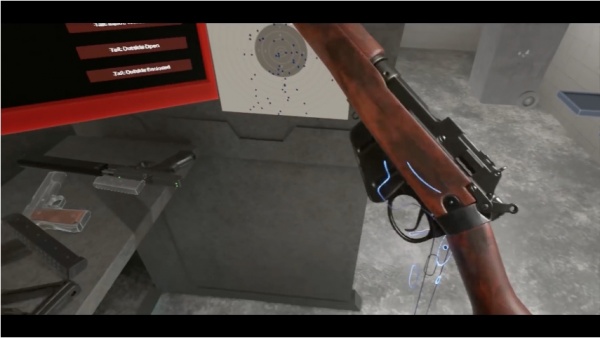
A good closeup view of the No.4's action.
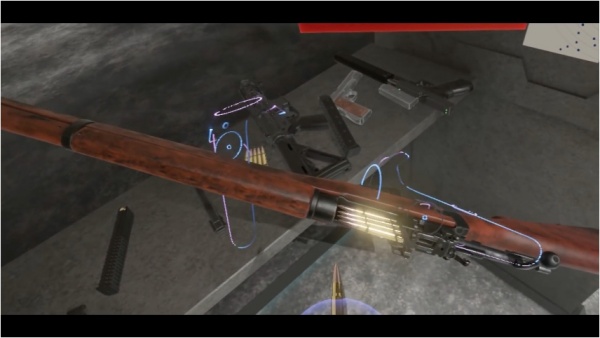
Loading the rifle with the first of two 5-round stripper clips.

Sending the bolt into battery, and a .303 round into the chamber.
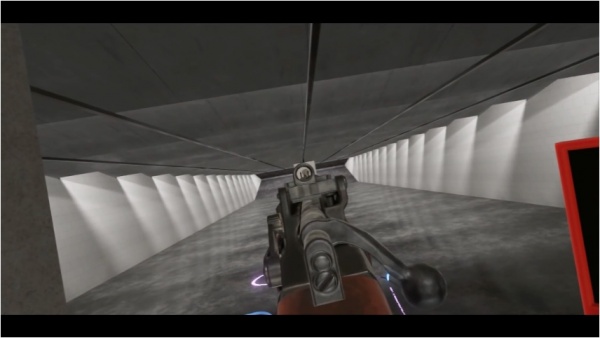
Taking aim at the target. In the period between this shot and the previous one, the safety was turned off.

To maximize the weapon's rate of fire, one can use this...
interesting technique.

Lee-Enfield No.4 Mk.I (T) - .303 British

A shot of the various Lees on a table, displaying the distinctive (T) stock of the updated No.4.
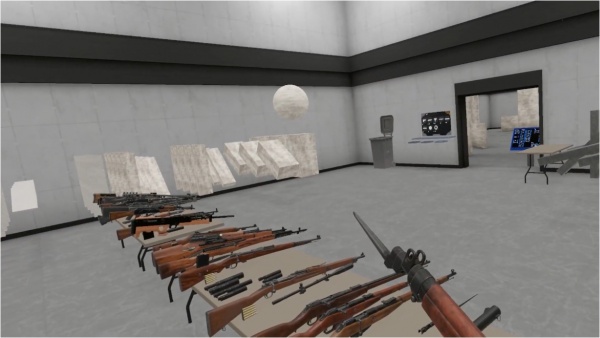
Affixing a bayonet to the Mk.I (T)...
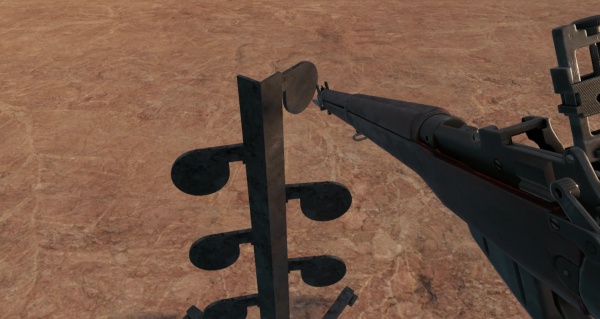
...before teleporting to a different place and time, and stabbing a dueling tree.
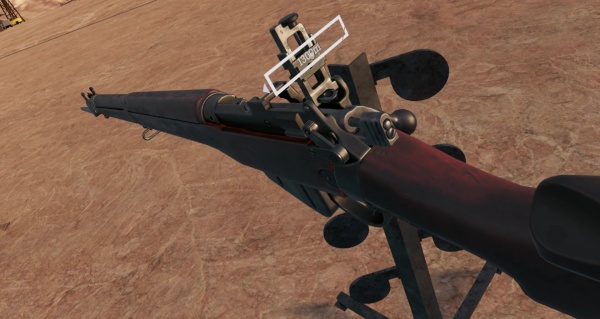
The time is more relevant, though; following Update #99's sixth alpha, the Lee got an adjustable rear sight. The default flipped-down position is a 100-meter battlesight, while the flipped-up ladder goes from 200 meters to 1,300 in 100-meter increments.
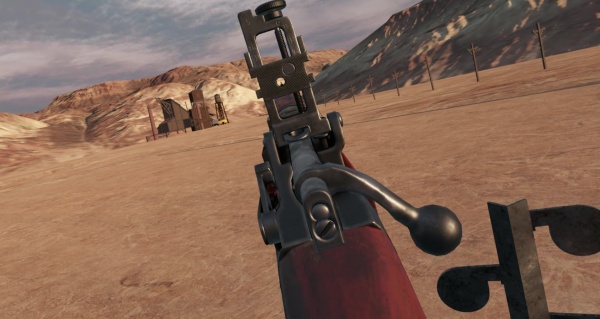
The resultant sight picture is adequate, if a bit obstructed by the rather large rear plate.
"Lee Enfield Obrez"
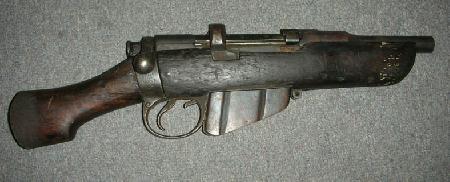
Sawn-off Lee-Enfield No. 1 Mk.III SMLE - .303 British

"Wait a minute... what are you?" 
Yep, this is a thing. It's not quite identical to the reference image (being a No.4 instead of an earlier SMLE, since the role that a sawn-off rifle would fill had largely been superseded by submachine guns by the time WWII rolled around); it also still has its front sight, for reasons unclear.
"Lee Enfield SwedeMod"
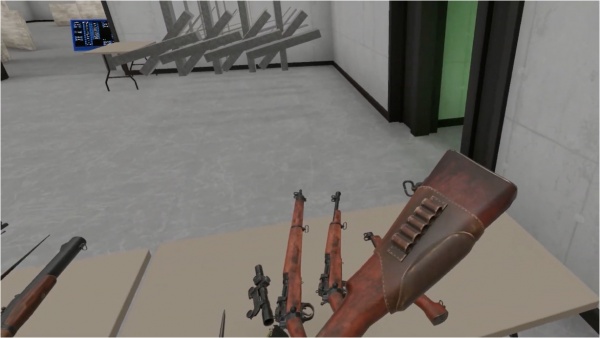
Meanwhile, we have what appears to be a mostly normal-looking Lee-
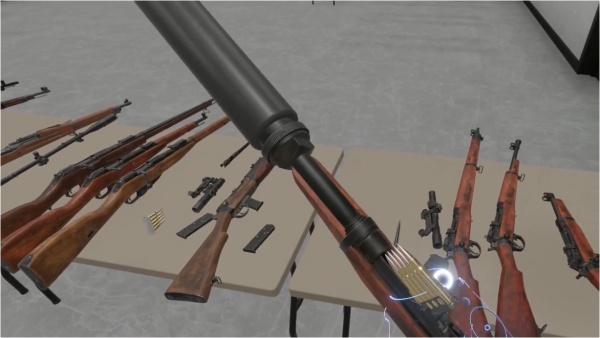
Attempting to load the rifle with a stripper clip.
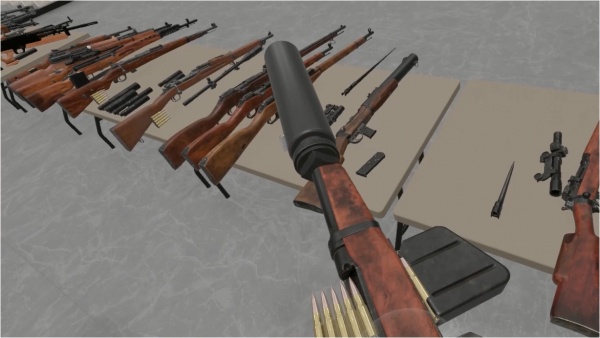
There being no magazine in the rifle, this is met with limited success. The magazine going in in this shot is also fully loaded, so the whole stripper clip affair would prove to be quite unnecessary in the long run.

Giving the sights a try; with the sheer size of the integral suppressor, the rear sight has to be set to one of its longer-ranged positions just to get a picture.
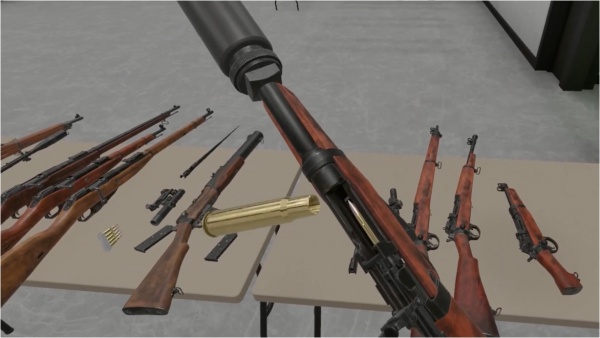
Working the action to eject a spent case, which makes the rather dramatic move of throwing itself directly at the camera.

If you don't find the raised sights to be to your liking, the modified Enfield is also compatible with the same No.32 scope as the Mk.I (T).
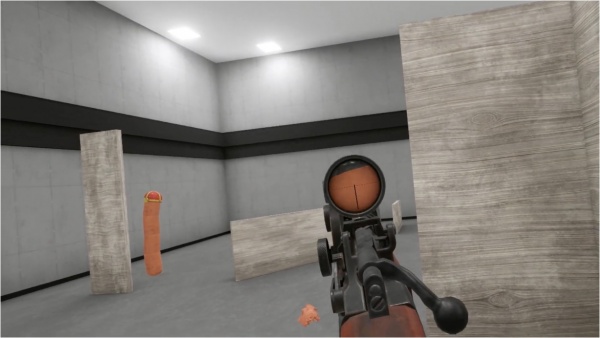
Aiming at a Sosig's head through the scope...
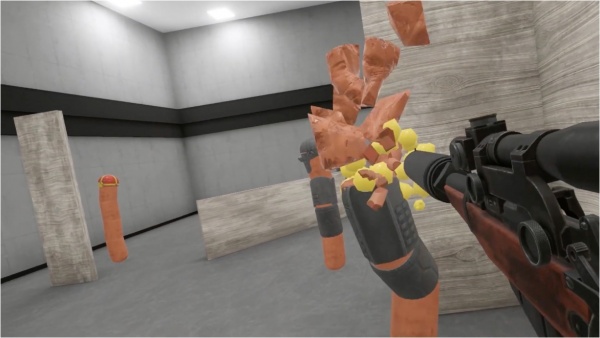
...before ignoring everything in the above shot altogether.
Lee-Enfield No. 5 Mk I "Jungle Carbine"
Along with the aforementioned variants, the 1st alpha of Update #76 added a Lee-Enfield No. 5 Mk I "Jungle Carbine"; like the De Lisle Carbine, its action takes priority over its length, and it is thus classified as a bolt-action rifle rather than a carbine.

Lee-Enfield No. 5 Mk I "Jungle Carbine" - .303 British
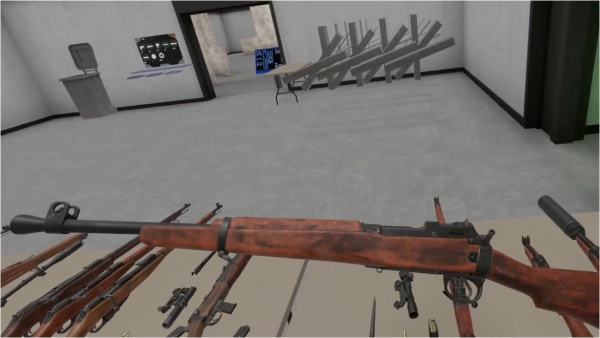
Inspecting the Jungle Carbine's left side.

As for the right side, the Carbine couldn't afford to get its own full set of screencaps, so it had to share a table shot with the No.4s. Tragic, I know.
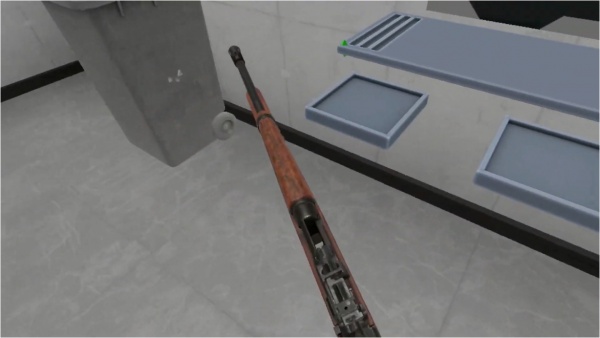
Luckily, after a few months of work at the sawmill, the No. 5 managed to scrape together enough money for screencaps of its own. Here's one of the bolt being opened...
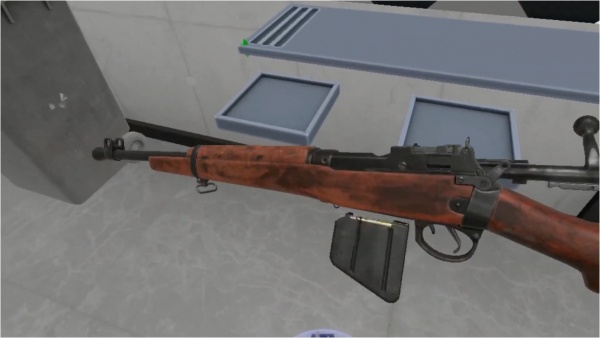
...and another of a magazine being loaded...

...and a third of a round getting chambered! All done by a fancy, big-city man, with one of those new-fangled... what're they called again? Chimeras?
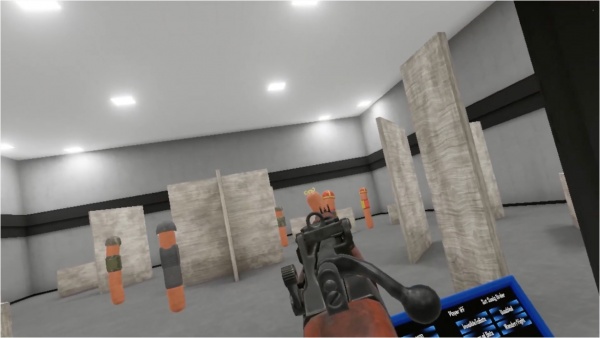
Looking past the sights at a Sosig; the No. 5 uses the same aperture/winged post setup as the full-length No.4 upon which it was based.
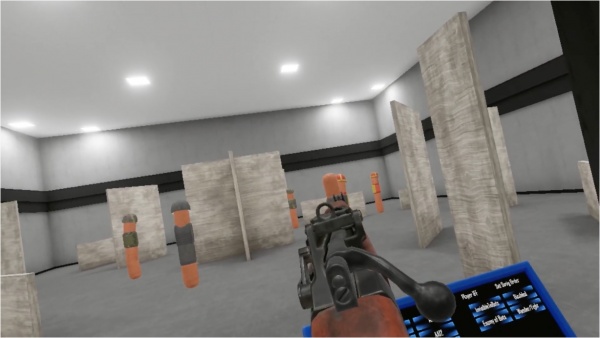
Switching off the safety...
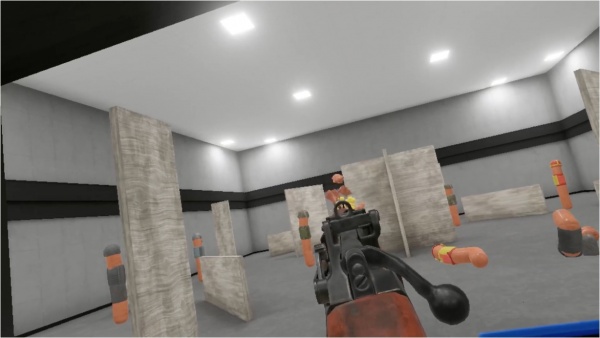
...and shooting a different Sosig, this time at least attempting to align the sights.

Like its full-length counterpart above, the No. 5 got an adjustable rear sight in Update #99's sixth alpha - 100 meters flipped down, or 200 to 1,300 in 100-meter increments flipped up.
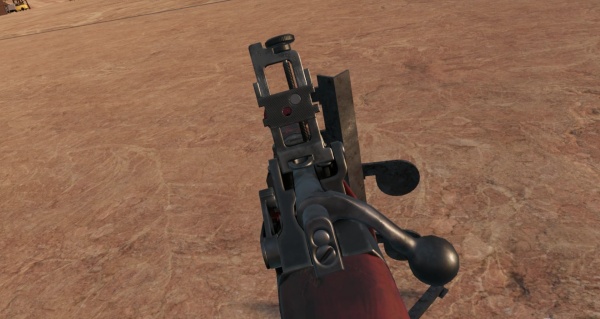
The latter position is rather excessive for this, but it's not as though you can really miss from this range either.
Luger 1902 Carbine
The last of the 3 Update #52 Luger variants is a rare full-stocked carbine. The in-game model lacks the real Carbine's grip safety.

Luger Model 1900 Carbine - 7.65x21mm Parabellum
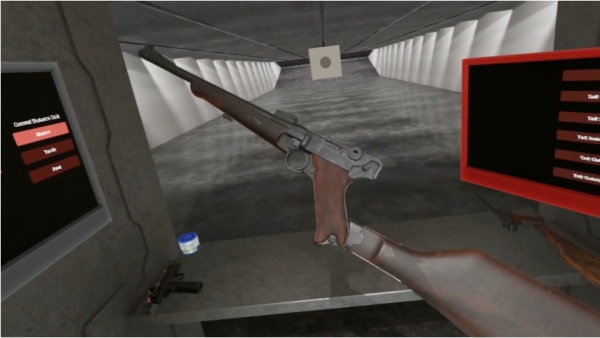
Admiring the Luger Carbine. If it's good enough for Kaiser Wilhelm, it's probably good enough for you.
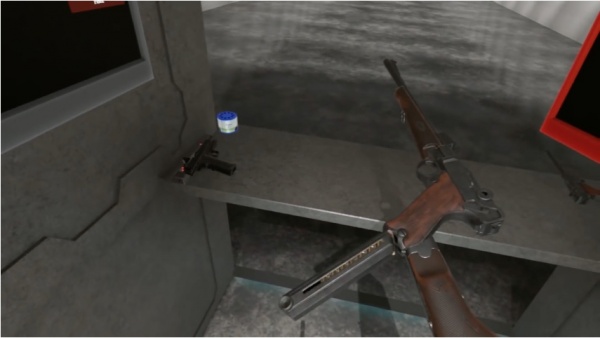
Loading in a full magazine of 9mm Luger; the vast majority of Luger Carbines are in 7.65mm Luger, but at least one 9mm version is confirmed to exist.
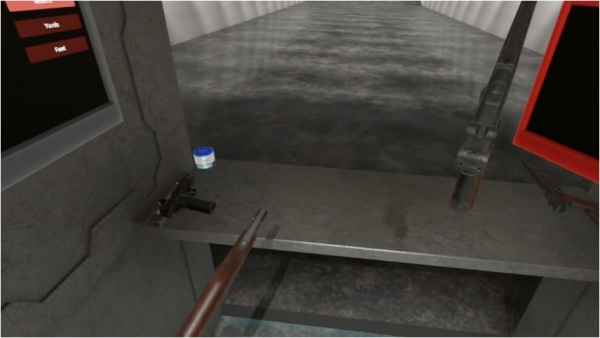
A quick check reveals that the stock is, in fact, detachable; this is one of many new mechanics and features coming in Update #52.
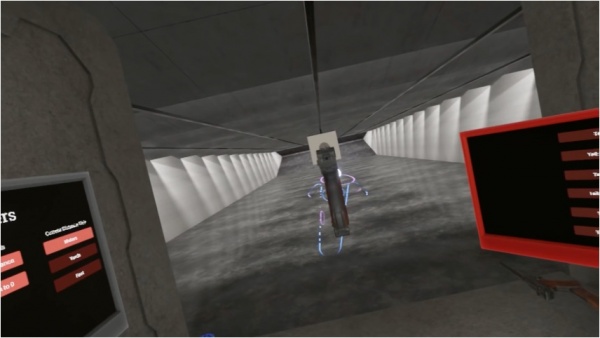
Taking aim with the carbine, sans stock.
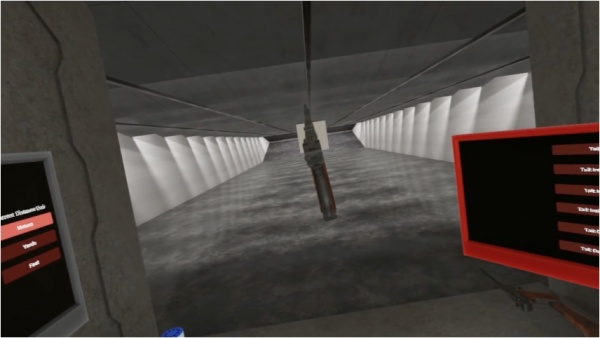
Firing a round at the target.
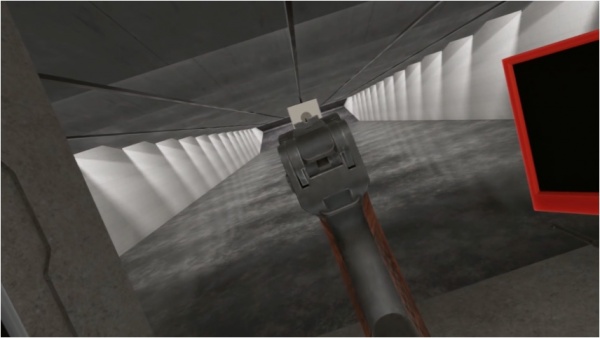
"Well, that was a terrible idea."
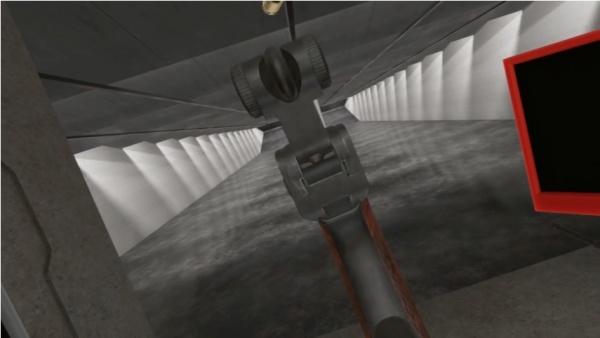
After realizing the mistake of doing without, the carbine is fired properly - that is, with a stock attached.
M1 Carbine
Update #48 added the M1 Carbine. It is a late-war/post-war model (with a bayonet lug and adjustable aperture sights), and can accept either 15-round or 30-round magazines of .30 Carbine. Update #51 made a variant with a permanently-attached M84 scope available as well; Update #52 replaced this with an attachable version of the scope.

M1 Carbine (late-war/post-war) - .30 Carbine
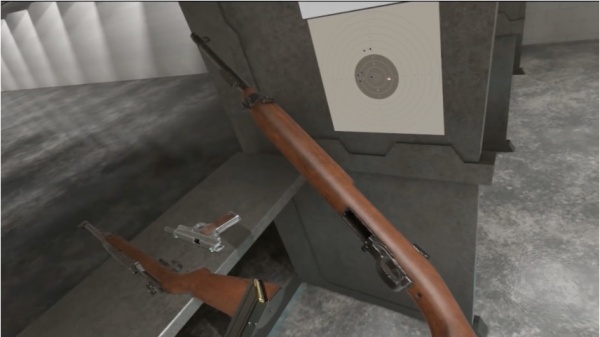
"Wait, where does this thing go again?"
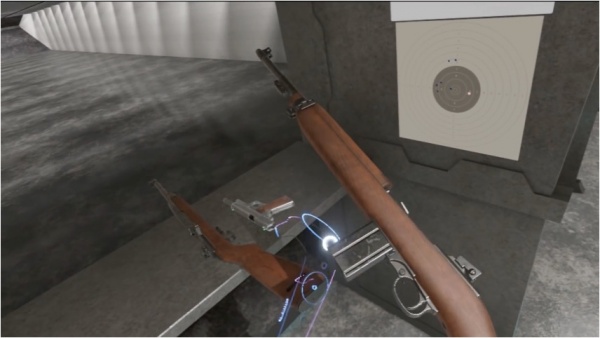
"Oh, okay. Yeah, that makes sense."
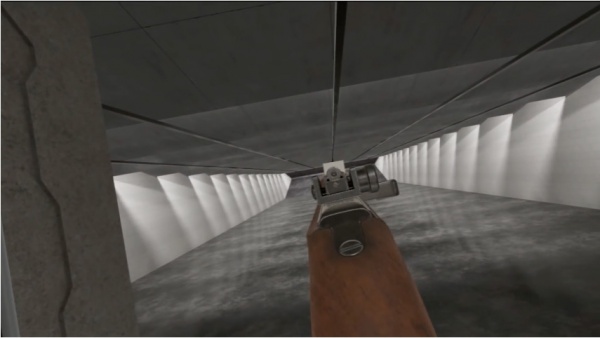
The Carbine's sights. They're a bit small, but quite usable.
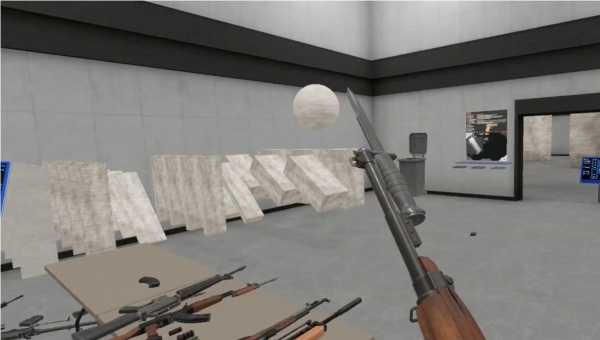
With the release of Update #76's 1st alpha, the late-war bayonet lug became more than just an aesthetic feature, allowing for the attachment of an M4 bayonet (also compatible with the M2 below, for obvious reasons).
M2 Carbine
Along with the M1 Carbine came its select-fire relative, the M2 Carbine. The M2, like the M1, has the late-war pattern of sights and a bayonet lug. It also has a metal heat shield; this was likely both due to the increased amount of heat that the M2 is likely to produce, and to make the M2 more visually distinctive. As with the M1, the M2 gained a variant with an M84 scope following Update #51; also like the M1, this variant was removed, and replaced with an attachable version of the M84 scope.

M2 Carbine (with sling and 30-round magazine) - .30 Carbine

M1 Carbine with heat shield - .30 Carbine. Image provided to show the metal heat shield used on the in-game M2.
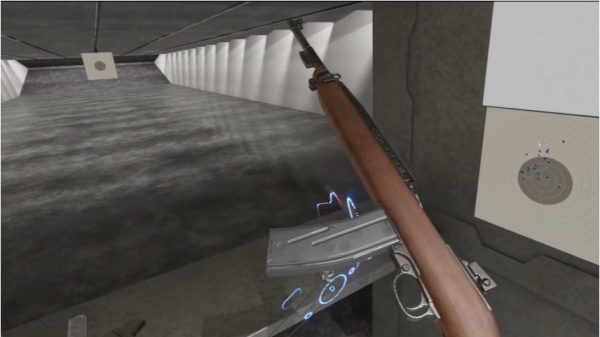
The M2 Carbine, complete with 30-round magazine.
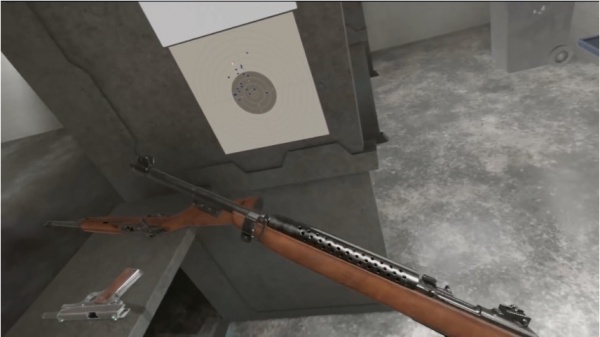
Taking a look at the M2's metal heat shield. Note also the bayonet lug and adjustable sights, confirming both this and the M1 (which also has these features) to be late-war models.
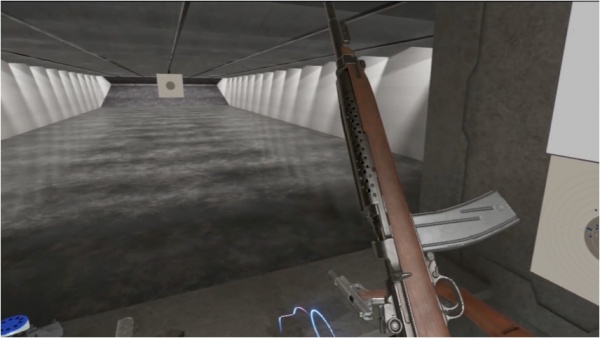
Letting the M2's charging handle drop into battery after pulling it back.
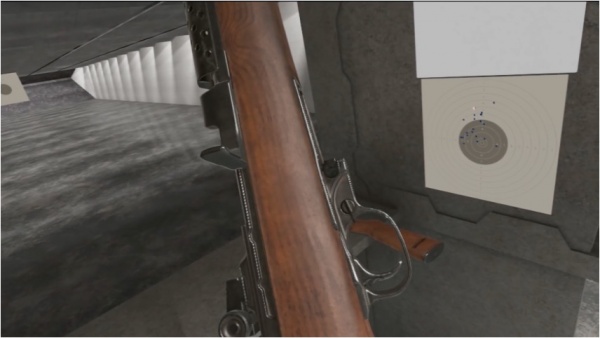
Manipulating the Carbine's safety. This control is the same on both the M1 and the M2.
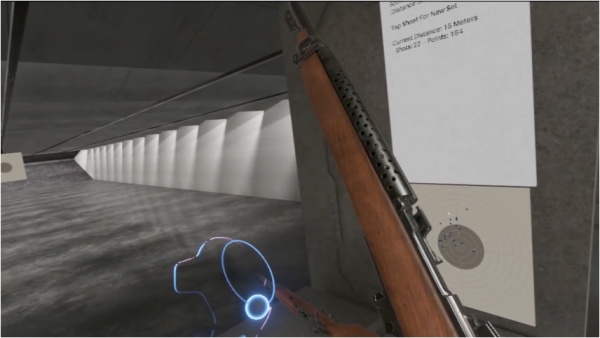
This one, however, isn't. This is the fire selector of the M2 Carbine, currently pushed forward for rock n' roll.
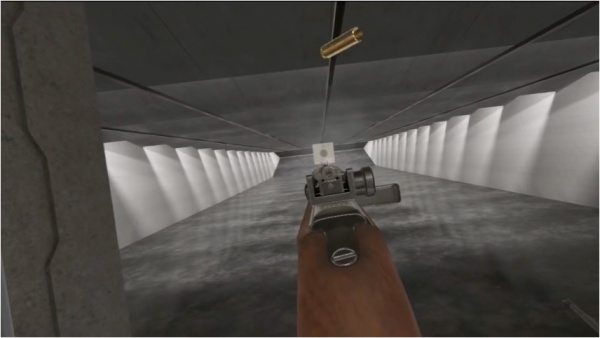
Opening fire with the M2.
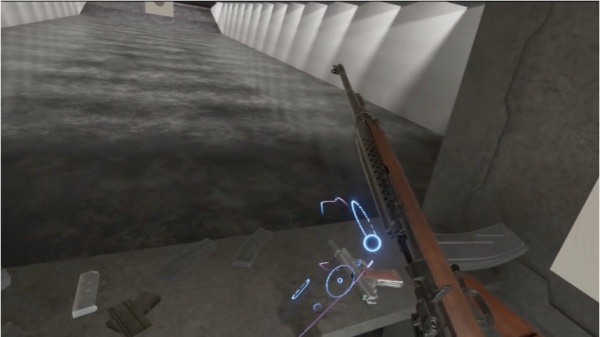
One quick mag change later, a quick tug of the charging handle to release the bolt is merited, seeing as it locks open when the weapon runs empty.
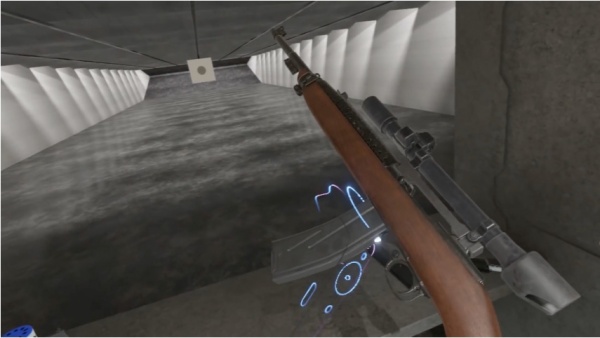
An M2 Carbine with an M84 scope attached. An unlikely combination, but not an impossible one by any means.
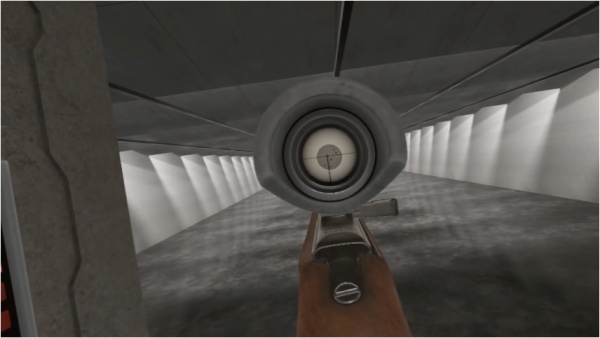
Looking through the M84 scope at a paper bullseye target.
M4 Survival Rifle
The M4 Survival Rifle was added on day 5 of the Meatmas 2022 advent calendar event. This marks its first known appearance in media.

M4 Survival Rifle - .22 Hornet

Opening up day 5's box, and discovering a different M4 than the one people usually talk about.

Taking a closer look at the M4.
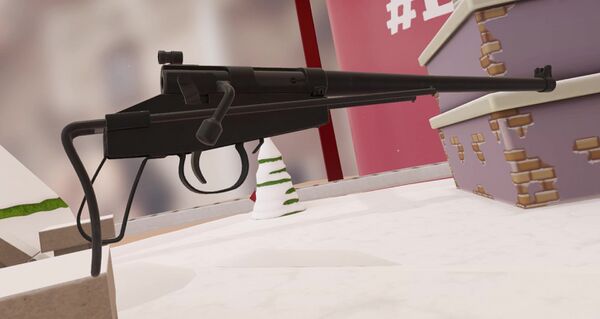
It's... well, it certainly is.
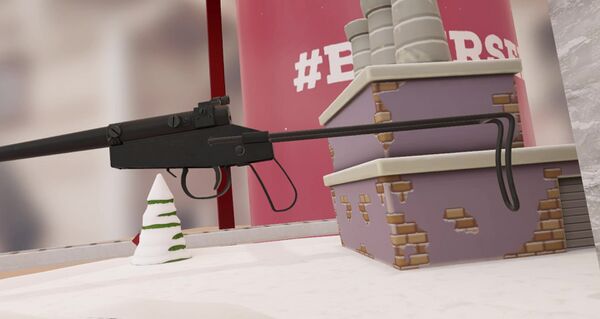
Extending the stock, which helps the rifle look at least a bit more respectable.

Loading in a 4-round magazine...
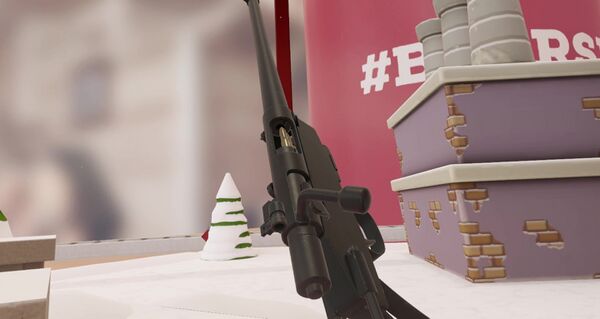
...and chambering a .22 Hornet round; this is the first weapon in
H3 to use it.

Disengaging the simple stamped safety lever. Though that's a bit redundant on a gun composed near-entirely of components that are either simple, stamped, or both.
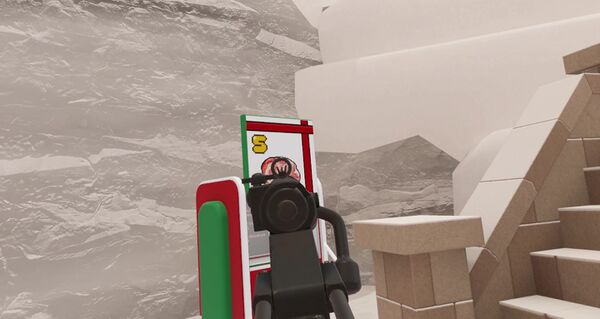
Taking aim at a fresh chunk of meat; the aperture/post sights are clear and quick to acquire.
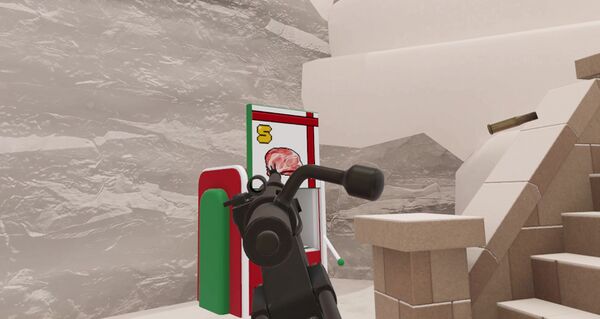
This attempt, understandably, is met with little success.

Guess that means it's steel for dinner again. Which, of course, necessitates collapsing the stock again.
M6 Aircrew Survival Weapon
Complementing the M4 above, the M6 Aircrew Survival Weapon was added on Meatmas Day 2022. It bears the distinction of being H3's first firearm to use two different cartridges; while some prior weapons have secondary barrels using different ammo types (e.g. the special "Sustenance" variant of the MP7A1 and its integrated grenade launcher), these have always been treated by the game as separate, distinct firearms on one level or another - the two differently-chambered barrels of the M6 are attached to a common receiver.

M6 Aircrew Survival Weapon - .22 Hornet/.410 bore
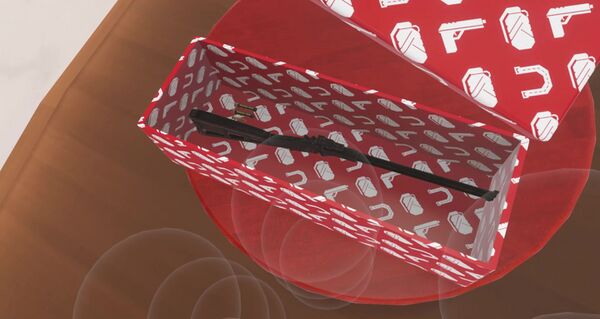
His sleigh having been shot down by Denier forces, one of Santon's cargo pilots finds his survival kit amongst the wreckage, and checks to see what he's working with.
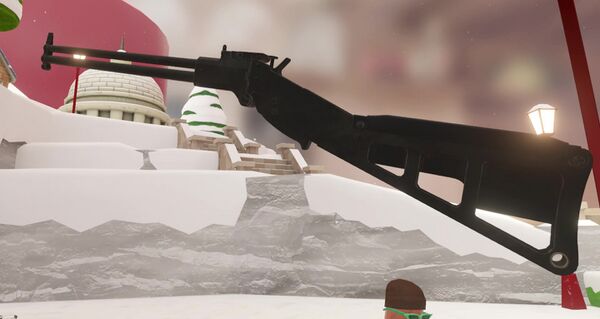
Or maybe it was someone's present. Hey, not his fault they use the same boxes for everything.
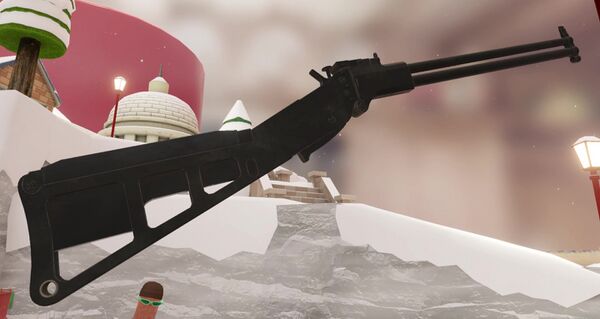
The M6's other side; it has the uncommon distinction among firearms of being near-perfectly symmetrical.

Cracking open the M6, and...
"...wait, why isn't it stopping?"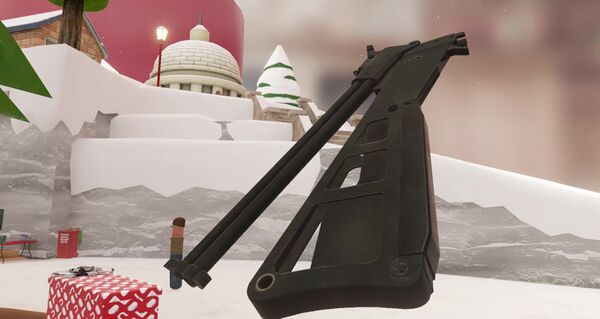
Eventually, after sweeping out a rather impressive arc, the barrels finally stop moving. This is one of the M6's special features - it more or less folds in half, allowing it to take up less space in a survival kit. Which, come to think of it, lends some credence to the idea that that box might not have actually been the survival kit...
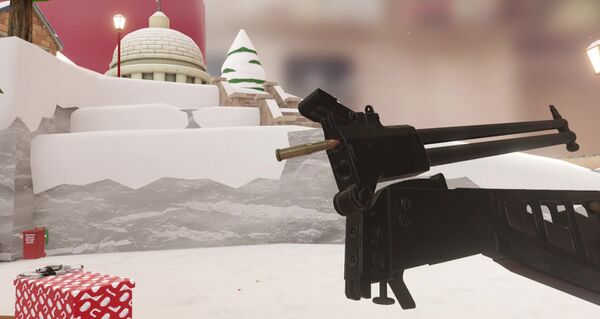
Loading a .22 Hornet tracer round into the top barrel...

...and a .410 buckshot shell into the bottom barrel.

After taking a moment to bask in the wonders of a true multi-caliber firearm, the pilot comes to what's left of his senses and snaps the gun shut. And probably flags himself in the process.

Trying to ignore the hallucinatory companion his concussed mind is already forming, he distracts himself with the neat little hinged bit on the stock.

This hides a series of holes, into which cartridges can be inserted - 9 rounds of .22 Hornet, and 4 of .410. Again, this would probably already be the case if this were an actual survival kit, but to be fair, it's not like that kid was gonna get it at this point anyway.
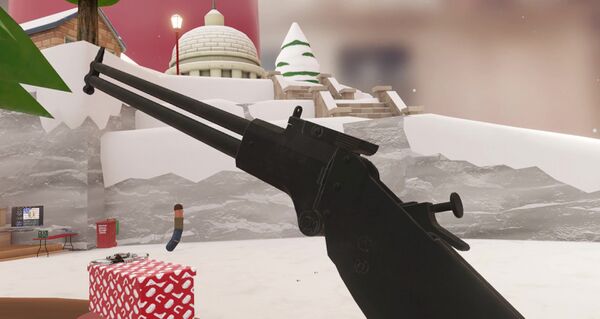
Cocking the rather large, simple hammer; it's designed that way intentionally, to make it easier to use when wearing gloves. Y'know, like the ones this pilot would be wearing if he had physical hands.

Spotting a lone steel plate in the distance, and taking aim; like the prior M4, the sights are a simple aperture/post setup.

Pulling the mitten-friendly trigger, and securing a plate for the plate tonight.

Excitedly cracking open the gun to take another shot, only to remember that it has two barrels and non-selective ejectors.

Following the retrieval of the dropped shell (a process which involved a fair few choice words), the pilot moves on to the gun's only other control: this plunger on the top of the hammer. Said plunger is actually the firing pin; pushing it in or out changes which barrel it lines up with.

Hearing an etherial clinking above, the pilot quickly turns his aim skyward, and sights up a passing flock of crystal snowflakes...
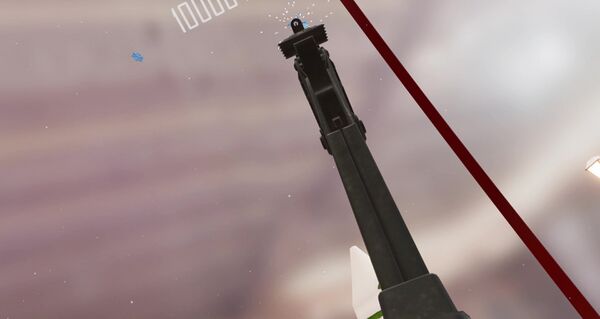
...before nailing one out of the sky, celebrating with an already-not-quite-okay-sounding shout.
"Tonight, we dine like kings!"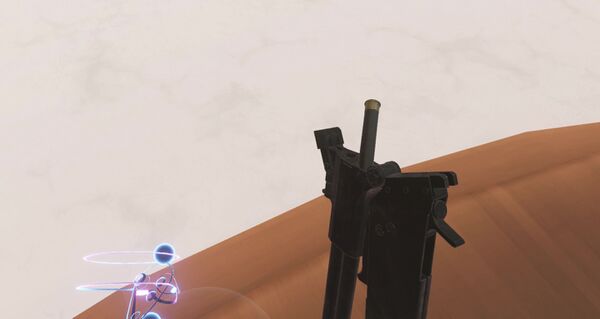
"Oh, so now you don't want to eject the shell. I see how it is." M1903 Springfield
Update #52's 10th alpha build added a transitional-variant M1903 Springfield rifle to H3.
Screenshots courtesy of Reddit user Shubishu.

M1903 Springfield (interwar transitional) - .30-06 Springfield
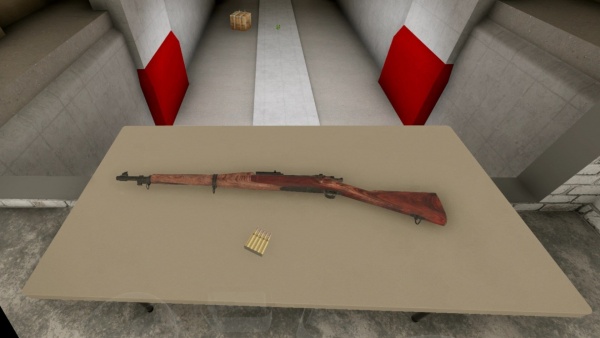
An M1903 Springfield and a 5-round stripper clip on a table, inside the Sniper Range. Competition-oriented rifle or not, iron-sight sniping is a daunting task.
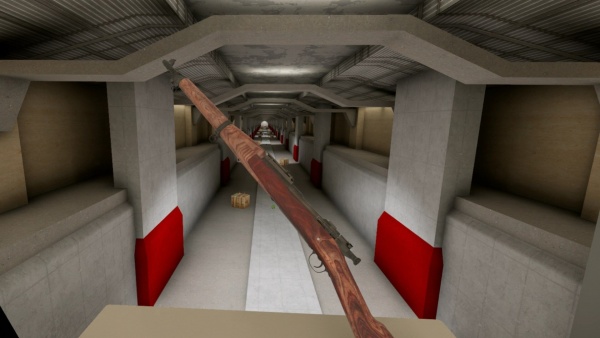
Examining the Springfield. The barrel-mounted rear sight, straight-wristed stock, and lack of grasping grooves in the forend peg this rifle as a somewhat more seldom-seen transitional model, manufactured between the WWI-era original and Mark I variants, and the later M1903A1.
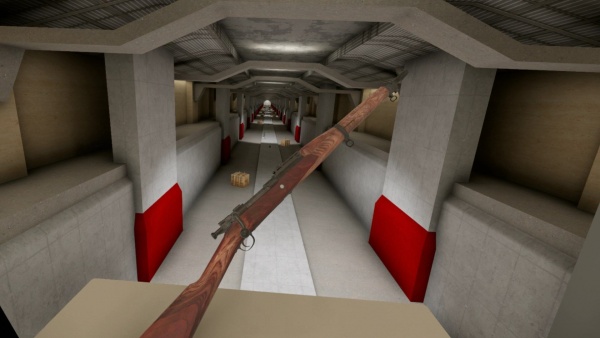
The other side. Note the interesting pattern of the stock's wood grain; this mis-matching could possibly indicate that the rifle was repaired at some point in its lifetime, possibly a personal restoration of a sporterized surplus rifle to its former glory.
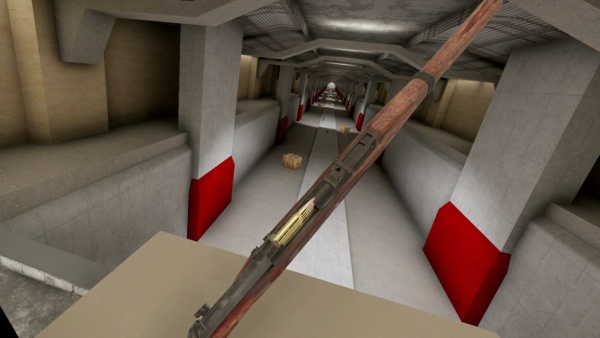
Then, in a surprise plot-twist, the stripper clip that showed up a few screenshots ago turns out to be incredibly important to the central plot! This shocking twist surprised... absolutely nobody.

Disengaging the
Mauser-type flag safety, common to rifles of the era. It especially makes sense on the Springfield, since it is, for all intents and purposes, a Mauser-pattern rifle.

Aiming the M1903; being designed in substantial part for long-range competition target shooting, the M1903's sights are small and precise. This is nice and all for long-range shooting, but can be a bit tricky to use for closer, faster shots.
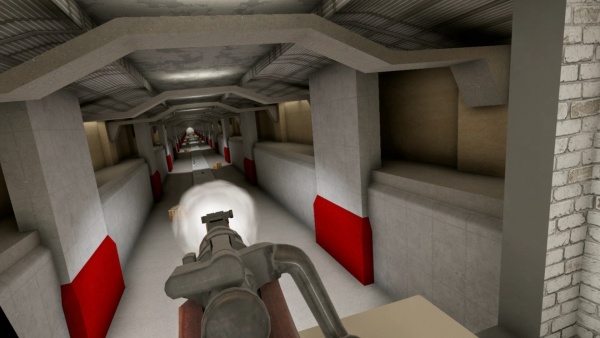
Putting an end to the squint-fest of aiming by firing off a shot; note that the striker, previously off of the bottom of the shot, is now in full, plain view.
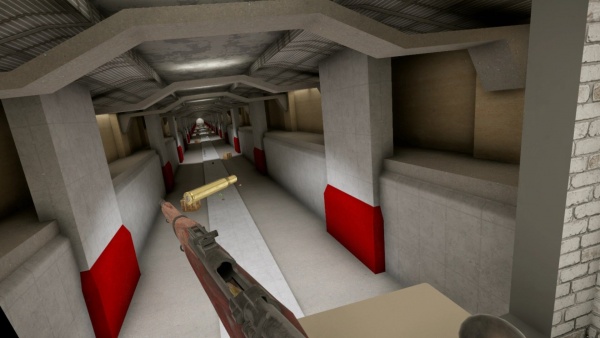
Observing the damage done to the targeted watermelon whilst cycling the rifle, preparing for another.
M1903A1 Springfield
The release of Update #76's first alpha replaced the aforementioned transitional M1903 with a later M1903A1 Springfield, complete with an attachable Unertl scope.

M1903A1 Springfield - .30-06 Springfield

M1903A1 Springfield with 7.8x Unertl scope - .30-06 Springfield
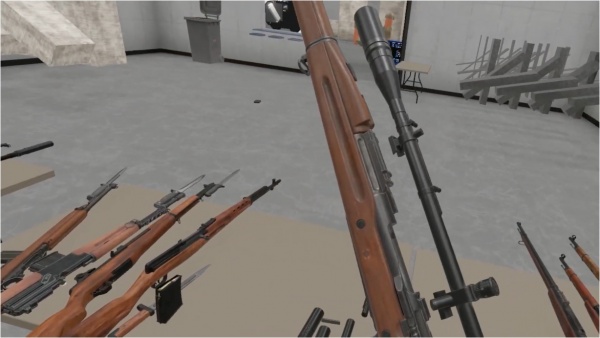
Affixing the rifle's proprietary Unertl scope...
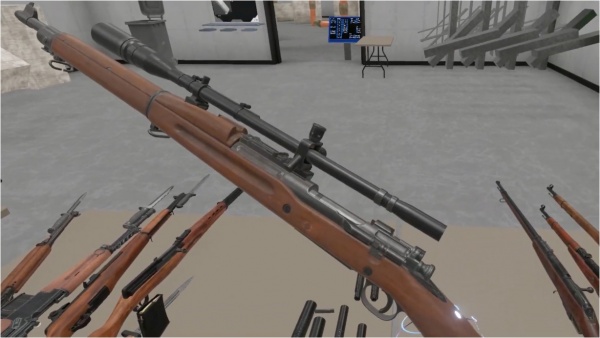
...which stretches across the entire receiver, and most of the handguard to boot.
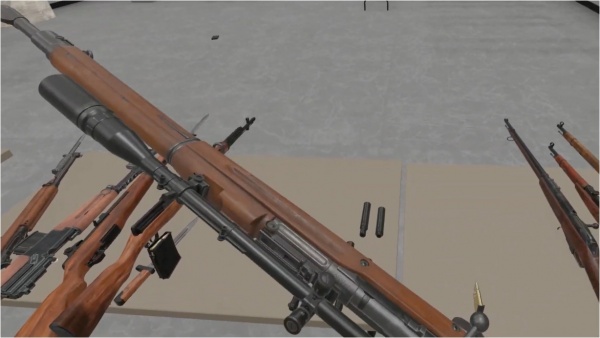
The rifle's other side, showing off the bolt handle and receiver.
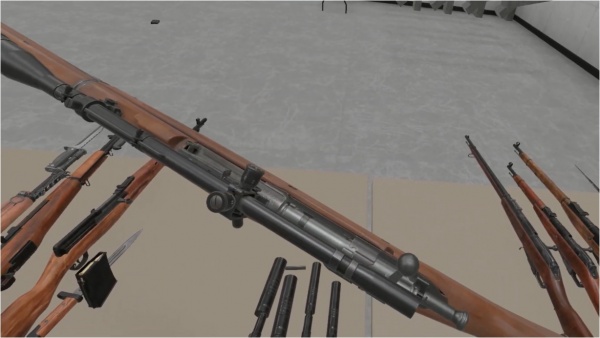
Opening the bolt; being a later-pattern
Mauser-type design, the M1903 cocks its striker when the action is opened.

As is common for scoped rifles of the era, the M1903A1's scope blocks the stripper clip guide, forcing the user to single-load.
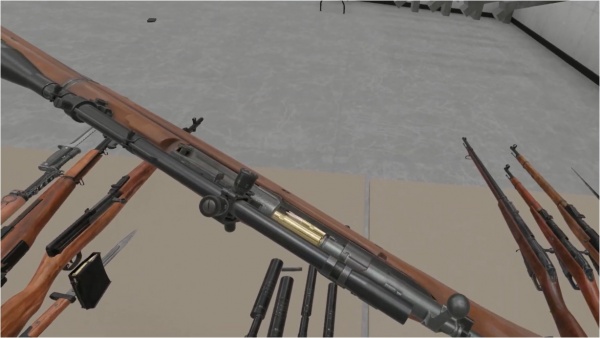
Sending a .30-06 round into the chamber.
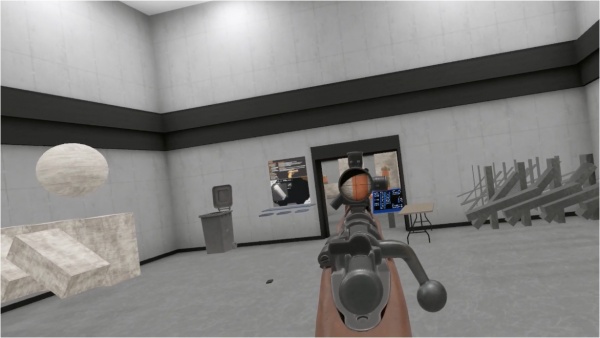
Aiming at a Sosig; even with the aim-steadying Virtual Stock system, the Unertl scope's combination of a small objective lens and a high magnification (7.8x) makes target acquisition rather difficult, as the black area at the top of the scope demonstrates.
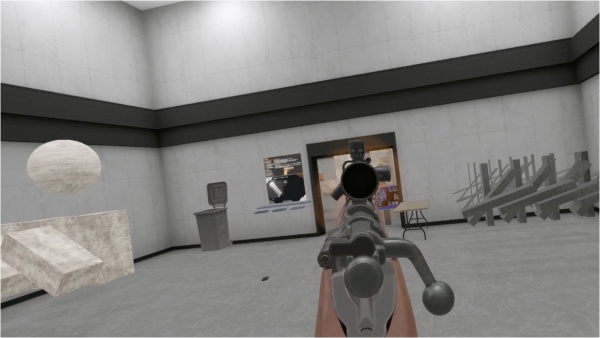
This also means that, upon firing, the rifle's vertical recoil upsets the sight picture entirely, making it difficult to tell whether or not a shot has hit its mark.
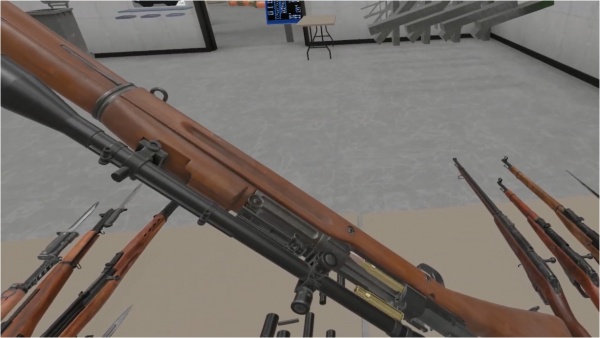
To top it all off, the position of the optic over the action tends result in cases going straight into the scope tube, as seen here.
Martini-Henry Mk. II
Another gift from the 2019 Meatmas update was a Martini-Henry rifle (more specifically, a Mk. II variant), a long-requested addition. It is categorized as a lever-action rifle in-game, owing to its lever-operated falling block mechanism; this makes it the first rifle in the category to not be magazine-fed.

Martini-Henry Mk. II - .577-450 Martini-Henry

Examining the Martini-Henry; at 49 in (124.5 cm) in length, it's a rather difficult rifle to fit on the screen.
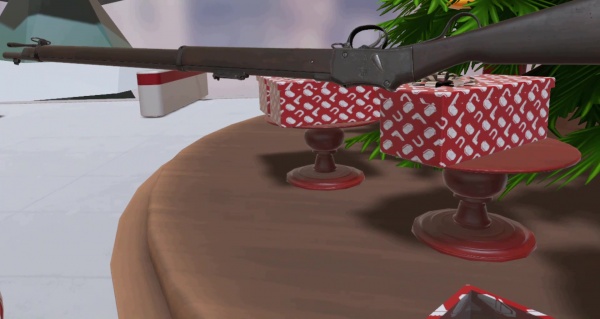
Hence why you shouldn't bother. The large-ended cleaning rod seen above, coupled with the large-sized indicator visible below, peg this as a Mk. II variant.
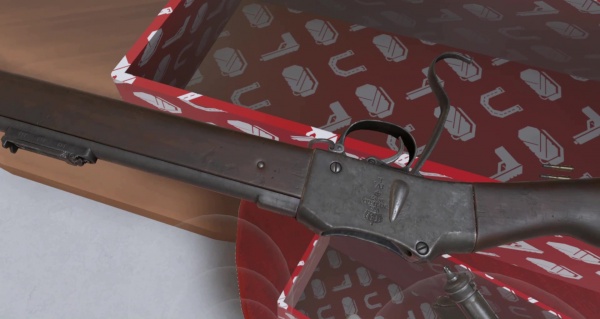
Said indicator indicates when the rifle's internal hammer is cocked; this is a useful thing to have on a rifle with no safety. The rifle's proofmarks are also visible here; perhaps one of our Australian users could lend a hand in translating them.
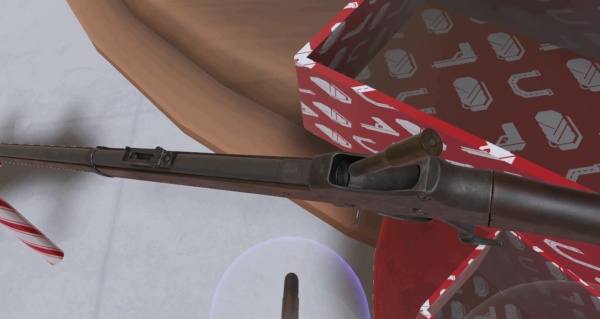
Loading in a single .577-450 round (so named for its use of a .45 caliber bullet in a necked-down .577 Snider case); these are only available in one type, that being a period-standard bottle-nosed unjacketed lead bullet.
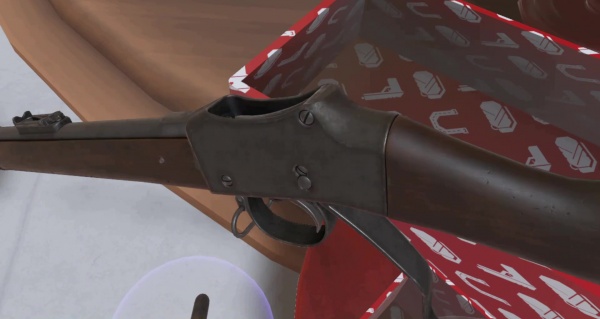
Closing the Martini can be a bit tricky, often requiring a fair bit of force; a general rule of thumb is to shake it, not stir it.

Aiming at a particularly tribal-looking snowflake. The sights are surprisingly readable; this is especially relevant on a rifle where every shot needs to count.
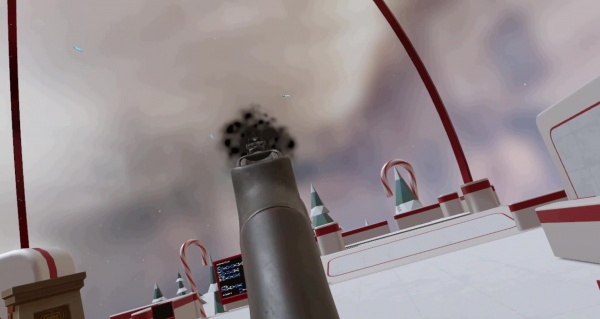
Making the shot count, and slotting the charging crystal; even if the recoil didn't obscure the target, the large cloud of black-powder smoke it produces certainly would.
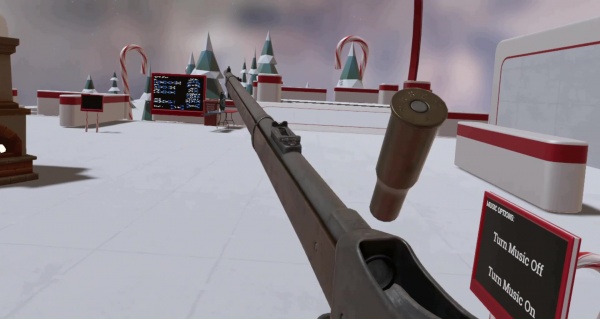
Ejecting a spent (but unfired) case, showing the "BSE" marking on its head; slightly more concerning is the "DP" marking visible on the chamber, which stands for "Drill Purpose", and denotes a rifle not considered suitable for anything beyond basic training drills (i.e. often of dubious safety to actually fire). This marking was later removed.
Mauser 1918 T-Gewehr
The Mauser 1918 T-Gewehr was added on day 12 of the Meatmas 2020 Advent Calendar event in Update #99. It is the first classic anti-tank rifle added to the game (i.e. predating modern anti-materiel rifles like the Barrett M82, and having been intended for use against actual tanks); it is also the game's oldest anti-materiel rifle, and will remain so, seeing as it was the first purpose-made anti-materiel rifle ever created.

Mauser 1918 T-Gewehr - 13.2x92mm TuF
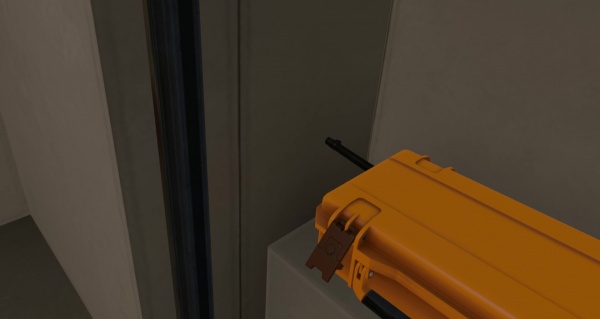
It's worth noting that weapon crates in
H3 are actually empty until the latches are popped; upon doing so with Bunker A-12's crate, it immediately becomes apparent that something is amiss.
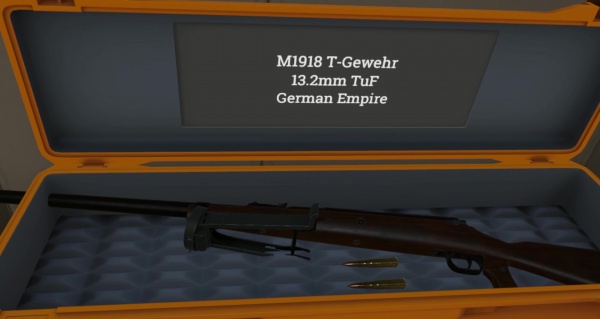
Popping open the crate's lid reveals the source of the issue: a gun that doesn't actually fit.
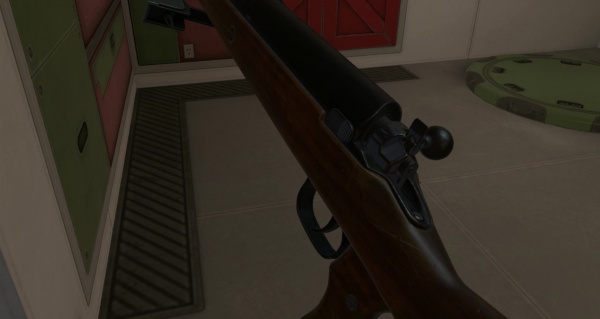
Despite its massive size, a theme you'll see throughout this section is that the T-Gewehr is essentially a scaled-up
Mauser Gewehr 98; one clear example of this is the near-identical bolt, right down to the flag-style safety.
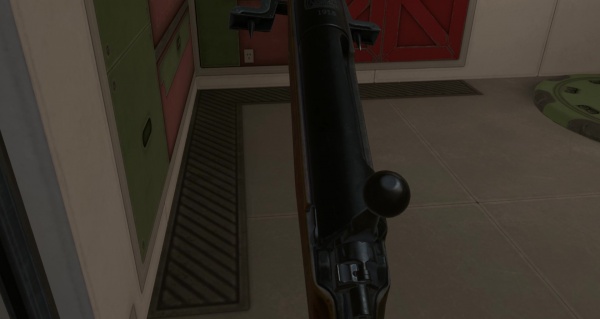
Unlocking the bolt. Note that the striker is now cocked; this makes sense, as the Mauser 98 and its derivatives are cock-on-open actions.

Loading in one of the weapon's massive (and proprietary) 13.2x92mm TuF rounds; "TuF" stands for
"Tank und Flieger", German for "Tank and Aircraft", since the German word for tanks would remain "tank" until the emergence of the term
"panzer" during Germany's interwar re-militarization.

Shoving the round into the chamber.

Stepping outside the bunker for a better look at the rifle; since it's hard to fit the whole thing on-screen, here's the front of the left side...

...and the back of the right.
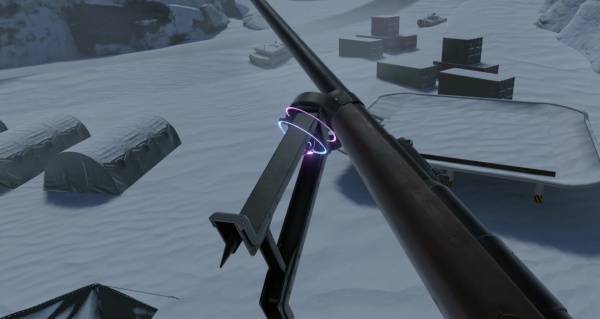
Deploying the weapon's
MG08/15-based bipod up on top of an S-COM tower; being put together in a remarkable hurry, the T-Gewehr uses a variety of pre-existing and/or slightly-modified components to minimize its toll on the already stretched-thin industrial capacity of the German Empire.
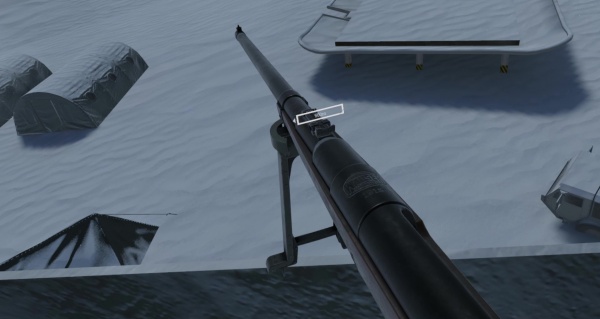
To that end, it also uses what seems to be a pre-existing tangent rear sight marked for the drop of the 13.2mm round; it could slide much further out than 500 meters' worth of elevation, but this wasn't ultimately deemed useful, given that the round likely wouldn't be effective against period tank armor out past 500 meters anyway. The T-Gewehr's receiver markings are also visible here; presumably due to the continued existence of Mauser as a company, this is apparently a "WAUSER" rifle.

Having set the sights to a range about 400 meters more than is useful, the marksman takes aim at a tank at least 62 years too modern to be vulnerable to the T-Gewehr, and an indeterminate number of years too long-abandoned to render the activity worthwhile.
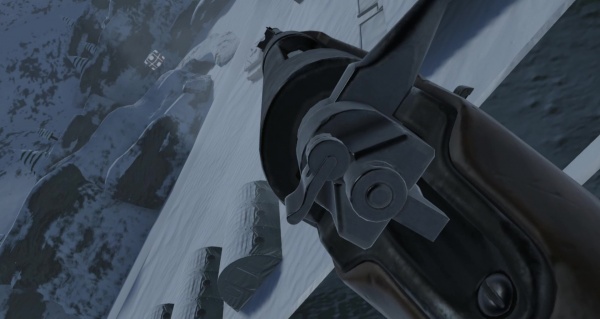
Firing in spite of all this; suffice to say, a giant anti-materiel rifle with no muzzle brake kicks rather hard.

Ejecting a spent casing, and going off in search of another target.
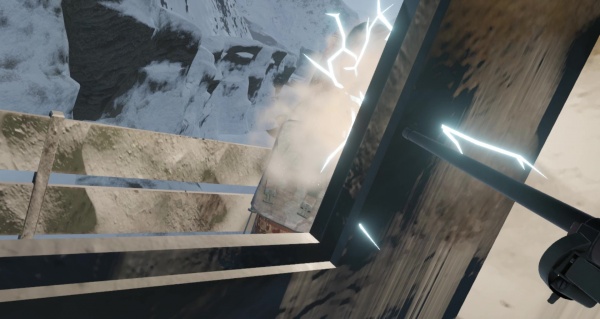
Turns out, the marksman doesn't need to look far. While it might not be useful against modern MBTs, the T-Gewehr is certainly capable of shooting through other forms of armor, like the thick metal walls of S-COM towers.
Mauser Karabiner 98 Kurz
Update #52 brought along a Karabiner 98k, furthering the game's collection of World War II-themed weaponry.

Mauser Karabiner 98k - 7.92x57mm Mauser

A clear look at (most of) the K98k. Note the earlier-pattern stock nosecap and cleaning rod, showing that this is an earlier-pattern rifle, and not the later "Kriegsmodell".
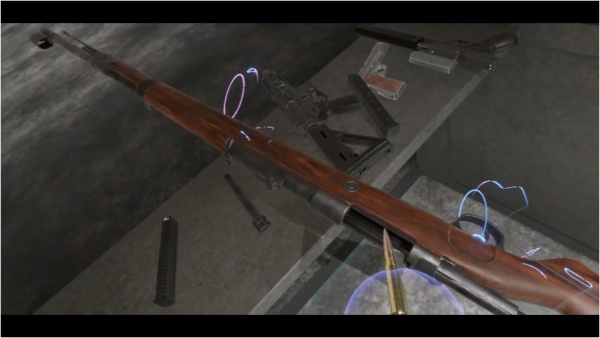
The other side of the rifle, with the bolt open.
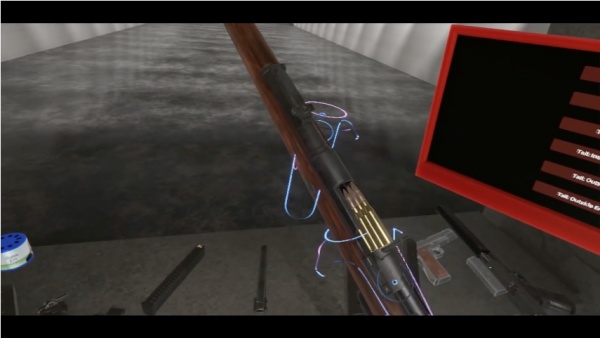
Loading the rifle with a 5-round stripper clip.
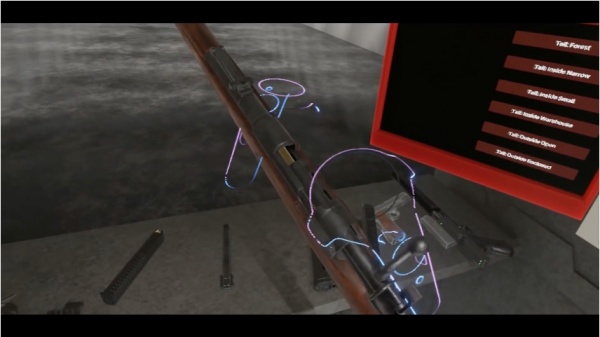
Chambering a 7.92mm round.
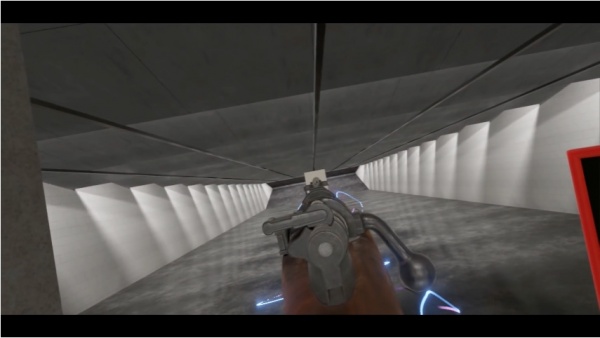
...and remembering to turn off the safety. The color of the target is conspiring with the picture's resolution to make the front sight hood virtually invisible.
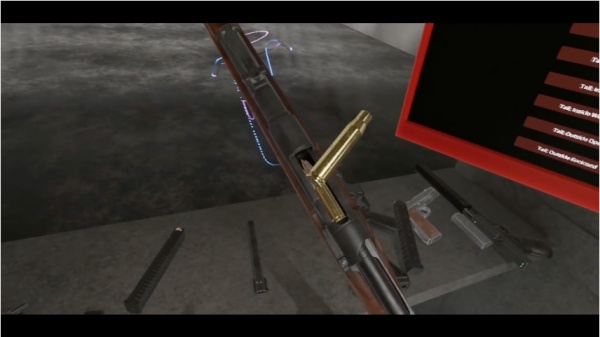
Ejecting a spent case. One down, 4 more to go.
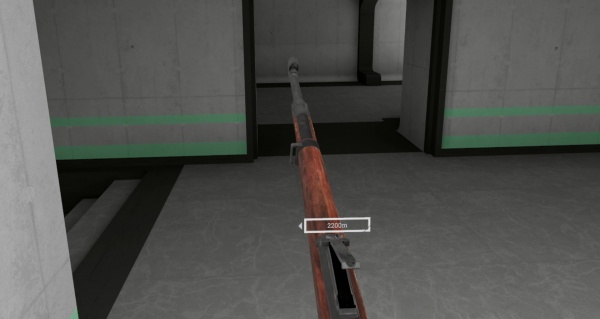
The Mauser was one of several guns that got an adjustable rear sight in Update #94, which goes out to 2,200 meters in 100-meter increments. Extremely helpful for the notoriously long-ranged engagements of the original Take & Hold map.
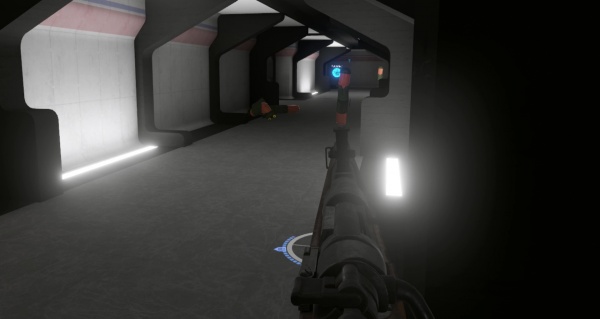
Should you wish to actually hit something at a shorter range with the sights set like this, you're going to need a rather substantial 6 o'clock hold, and a fair bit of luck.

Mauser Karabiner 98k with Zeiss ZF42 scope - 7.92x57mm Mauser
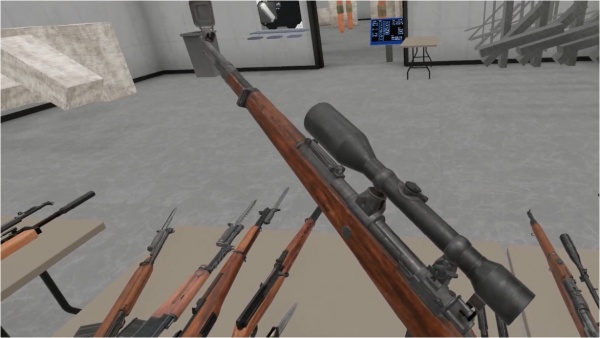
Update #76's 1st alpha build added a scope for the Karabiner (specifically, a Zeiss ZF42), another long-awaited addition.
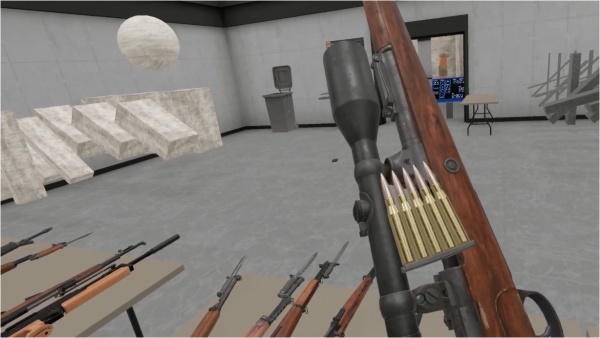
Unfortunately, the centerline placement of the scope makes the use of stripper clips all but entirely impossible; as seen here, they don't physically fit between the scope tube and the receiver.
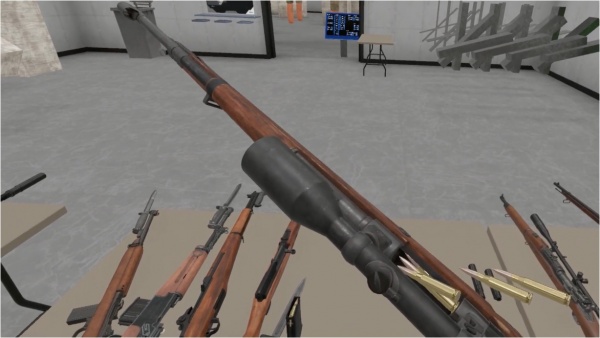
As such, the only way to load the scoped 98k is one round at a time.
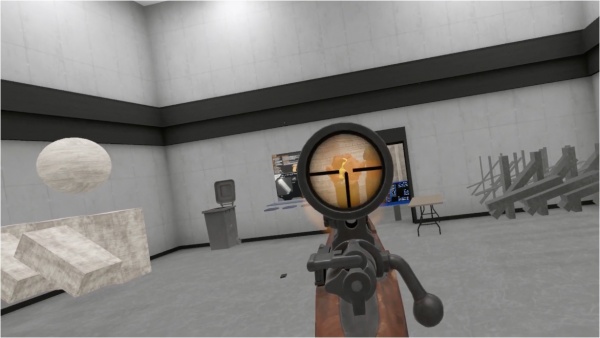
Plugging a Sosig in the noggin; this shows off the scope's 3-line reticle, common for scopes of the era. Note the hole in the scope mount; this allows the iron sights to be used with a scope mounted (though the resultant sight picture is somewhat cramped, as one might expect).
Mauser M1917 Trench Carbine/Mauser C96 Carbine Hybrid
The last of Update #52's C96 variants is a rare M1917 Trench Carbine, a variant developed (but not issued) during World War 1 for German sturmtruppen. The weapon in-game is hybidized with attributes of a slab-sided Mauser C96 Carbine listed on iCollector in 2011; the in-game weapon is chambered in 7.63x25mm Mauser rather than the correct 9x19mm Parabellum, has a slab-sided receiver, a standard C96 trigger, and a standard C96 slide. The in-game weapon also has a greatly extended barrel, which is seen on some C96 Carbines (though not the slab-sided one).
It seems likely that the weapon model was originally a C96 Carbine model modeled after the 2011 slab-sided C96 Carbine, before being modified and repurposed to have M1917 Trench Carbine traits.
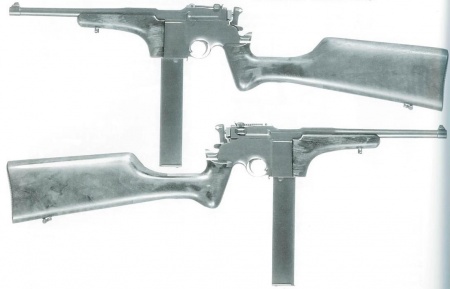
Mauser M1917 Trench Carbine - 9x19mm Parabellum

Mauser C96 Carbine (slab-sided) - 7.63x25mm Mauser. For reference.

Mauser C96 Carbine - 7.63x25mm Mauser. Reference for the long barrel.
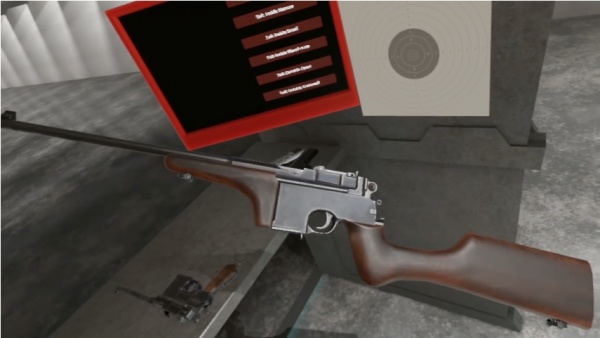
Examining the Trench Carbine. Note the hybrid traits from the M1917 Trench Carbine and the C96 Carbine. Its grip-stock is mounted in a slightly different way compared to the M1917 Trench Carbine reference image, but some of the Trench Carbines have their grips mounted like that.
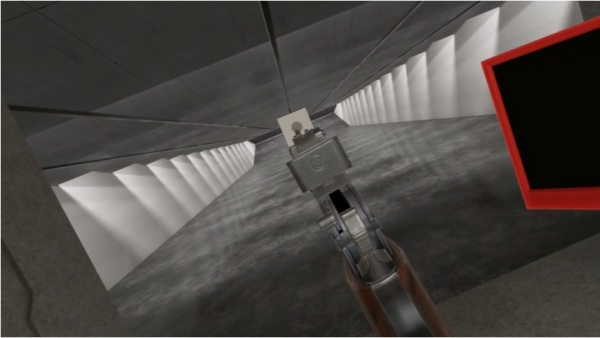
Taking aim at a bullseye through the M1917's iron sights.
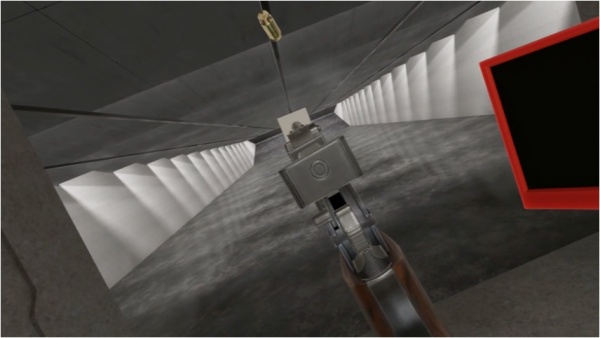
Firing a shot; as one would expect from a pistol-caliber carbine, this doesn't produce much recoil.
Mosin-Nagant M1891
The first alpha build of Update #76 brough along some new Mosin-Nagant variants, one of which being an original M1891 long rifle.

Mosin-Nagant M1891 - 7.62x54mmR
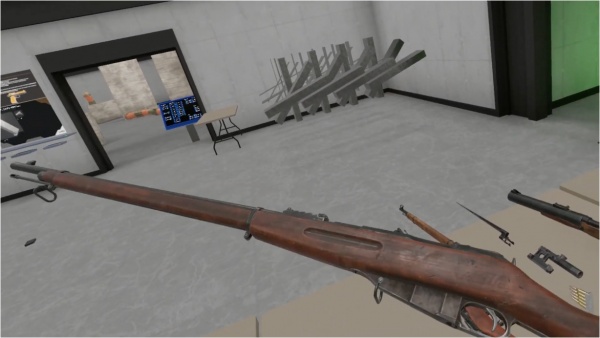
Admiring the M1891 Mosin. It's in somewhat rough shape, sure, but what can you expect out of a rifle that's lasted well over a century?
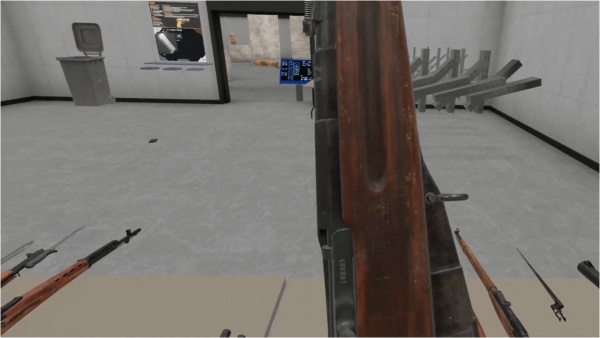
A close-up of the rifle's other side; here, the older-styled rear sight can be seen, as well as the serial number on the bolt.
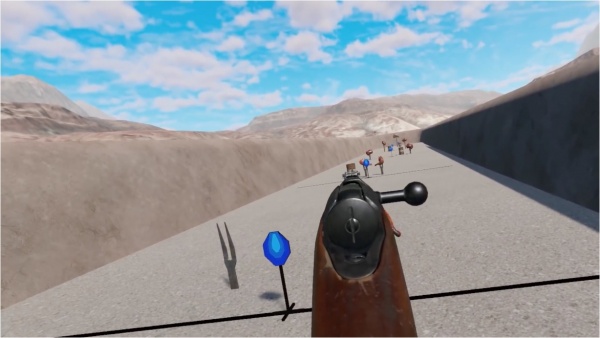
Aiming down the aforementioned vintage sights, while punching some holes in the Sampler Platter's "Hot Bar" area.
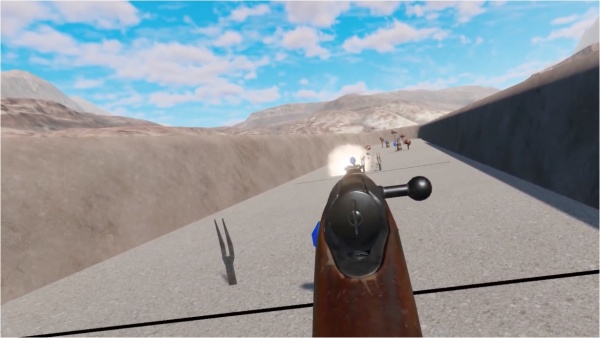
A rather apt name, considering the nature of the targets present.
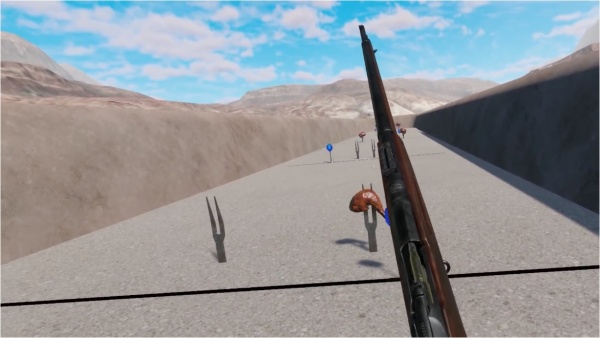
...and slamming a fresh round into battery.

Update #94 added a couple of new features to the Mosins; for starters, they all got a safety (which consists of pulling the uncocked striker back and twisting it, preventing it from going forward).

On top of that, they got adjustable rear sights; interestingly, the M91's rear sight is (correctly) graduated not in meters, but in arshins, an obsolete Russian unit measuring exactly 28 inches. If you want to do any long-range work with this gun, you're probably going to want to bring a calculator.
Mosin-Nagant M38 Carbine
First seen in the Alpha 1 build of Update #52, the Mosin-Nagant M38 Carbine is available for use in H3; like the later-added Lee-Enfields, it is categorized as a bolt-action rifle, not a carbine. Amusingly enough, it is found near the trashcans in the Friendly45 scene, referencing one of the Mosin's unflattering nicknames, The Garbage Rod.

Mosin-Nagant M38 Carbine - 7.62x54mmR

Opening a loot crate in Take & Hold mode reveals a Mosin, and a 5-round stripper clip. With the exception of some bugged instances, weapons in Take & Hold generally spawn with some form of appropriate ammunition. Granted, "appropriate" ammunition does include things such as 5-round magazines for assault rifles, and shotguns with confetti-filled shells.
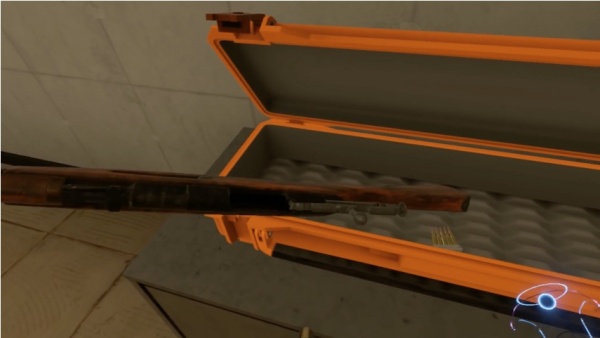
Opening the Mosin's action.
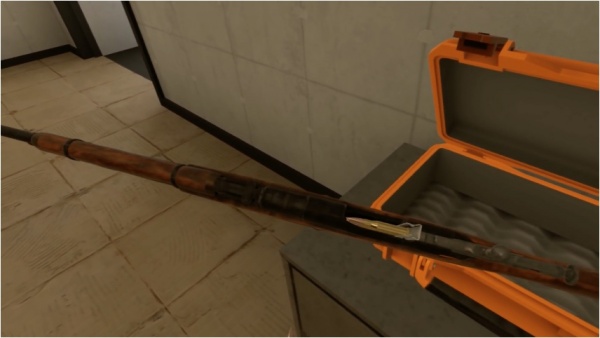
Loading the rifle up with 7.62x54mmR rounds, with the aid of the aforementioned stripper clip.
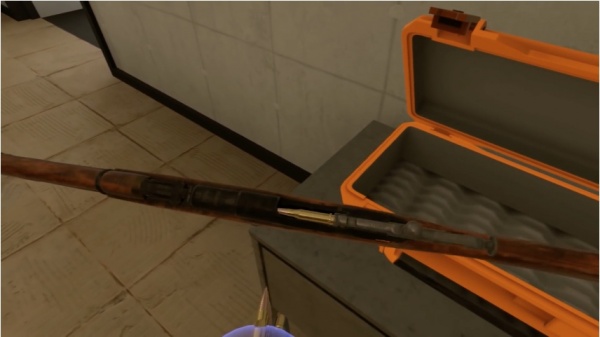
Chambering the first of the rifle's 5 rounds, and heading off to battle.
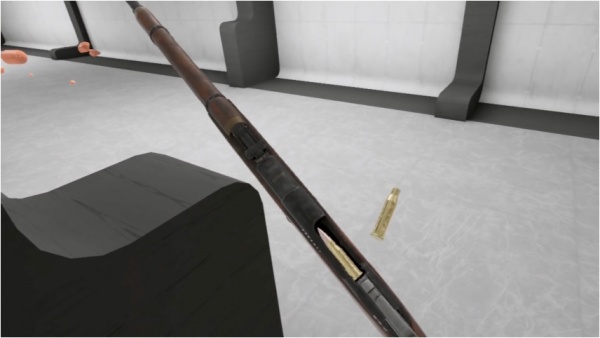
The threat to the motherland dealt with appropriately, our invisible Red Army soldier (or possibly /k/ommando) cycles his rifle, and ejects a spent casing.
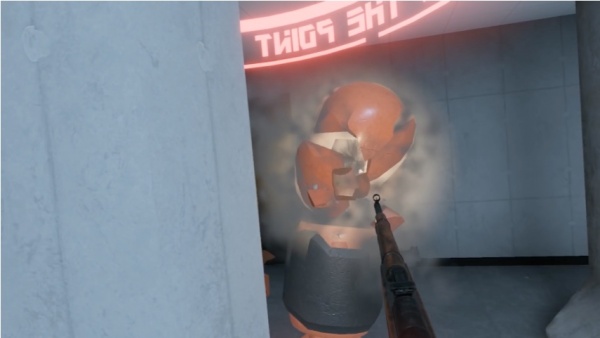
Following the discovery that Weinerbots don't terribly like it when you try to take their points, our protagonist finds himself face-to-face with a bot that clearly doesn't understand the meaning of the phrase "personal space", and decides to teach him a copper-jacketed lesson.
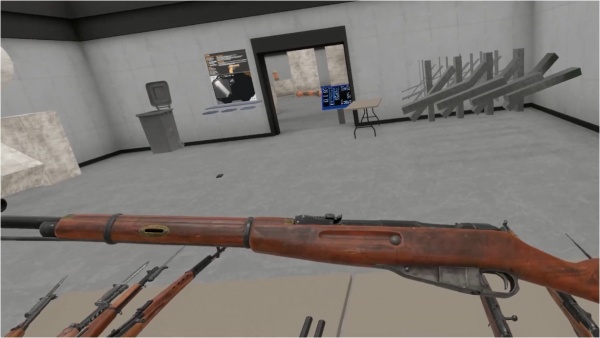
On a different note, Update #76's 1st alpha build gave the M38 a new, somewhat more worn-looking texture, complete with some rather nice (and appropriate) brass fittings.

The M38's post-Update #94 safety position. Note the firing pin, which appears to be either brass-coated or simply covered in leftover Cosmoline.
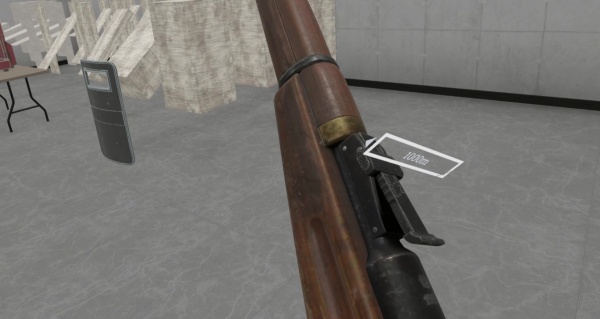
And, courtesy of the same update, its adjustable sights; these go out to a kilometer in 100-meter increments, with a 100-meter base zero.
Mosin-Nagant M91/30
The other Mosin variant added in Update #76's first alpha build was a Mosin-Nagant M91/30 configured as a sniper rifle, with a downturned bolt handle and a side-mounted dovetail rail for an also-added PU scope.

Mosin-Nagant M91/30 with PU scope - 7.62x54mmR

Examining the Mosin's left side, running an imaginary hand over the cutout in the stock in which the scope rail resides.
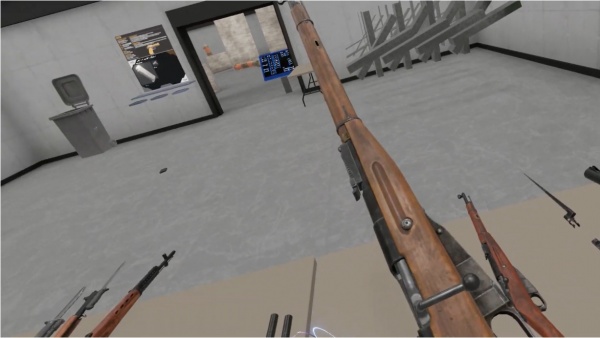
The right side, which shows off the downturned bolt handle.
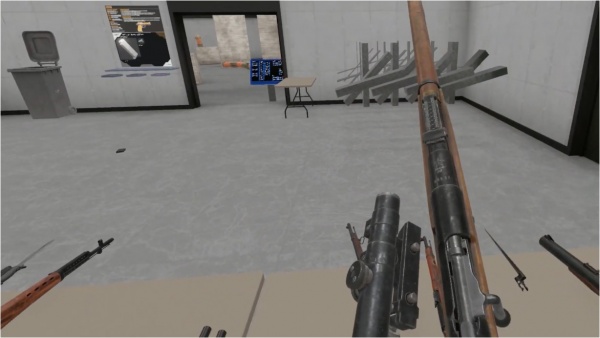
This is necessary, as when the scope is attached...
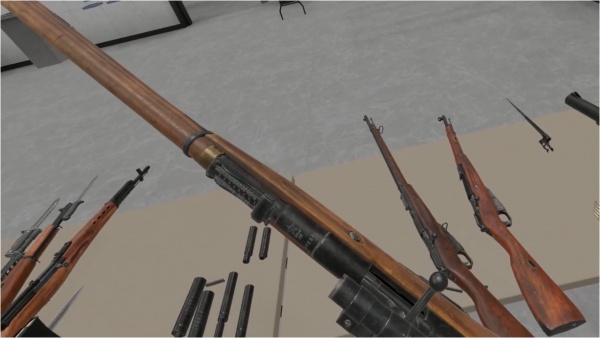
...a straight bolt handle would run into it before it could open all the way.
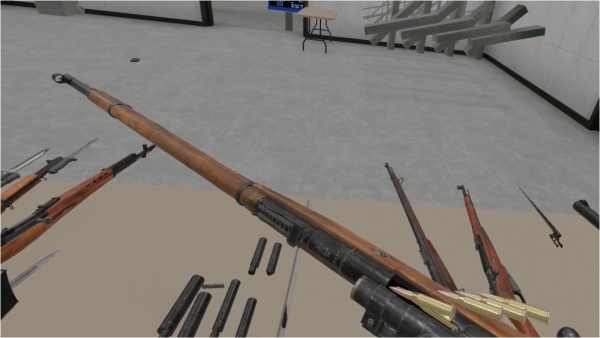
Likewise (and like most of the other scopes for this period's rifles), the scope blocks the stripper clip guide, making round-by-round reloads the way to go.
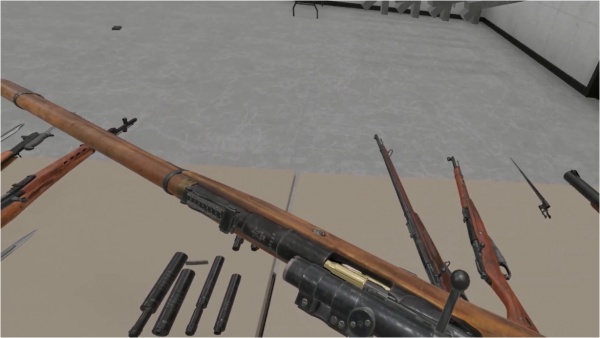
Closing the bolt, and sliding a round into the chamber.

Drawing a bead on a Sosig's head with the 3.5x PU; the high position of the scope allows the irons to be used as well.
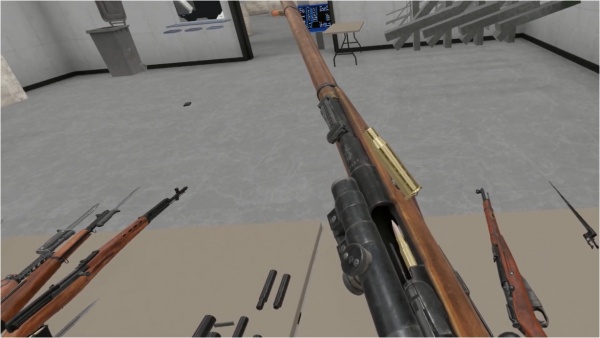
The enemy at the doorway defeated, our sniper cycles his rifle. Or is it "our" rifle?
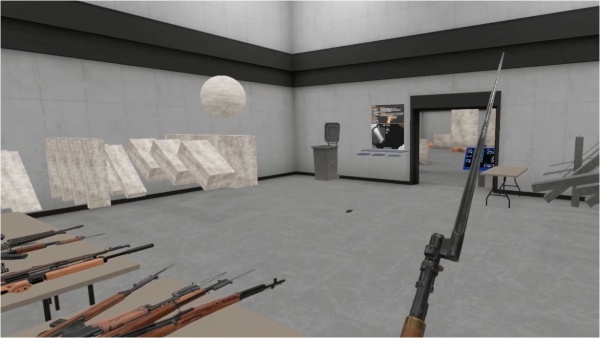
If long-range combat isn't your thing, the M91/30 can also accept the standard Mosin bayonet (as can anything that takes muzzle attachments), for maximum
"URAAAAAAAAAAA"-ing.
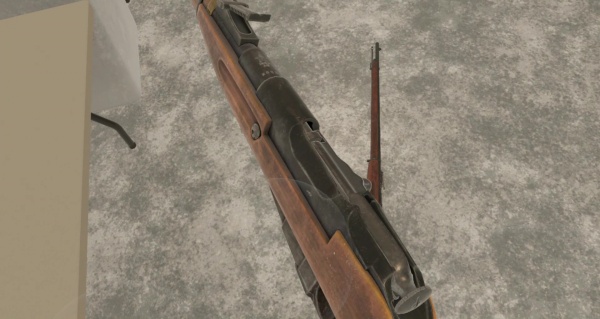
The M91/30, like the other Mosins, got a safety position for the striker in Update #94; unlike the others', the M91/30's safety position is bugged, in that the striker simply rotates without moving back, causing it to clip into the receiver.
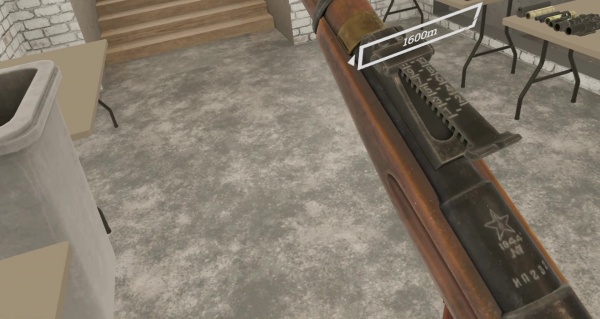
On the plus side, the rear sight is graduated in a unit that actually still exists. Also note the receiver markings; apparently, this rifle was made at the Tula arsenal in 1944.
Mosin Mini
Added in Update #95, the Mosin Mini is a version of the Mosin M91/30 chambered in .22 LR. It is the first bolt-action firearm chambered in .22LR. The Mosin Mini is one of the three "Cursed Guns" from the update that is based on a real-world firearm; its not uncommon for militaries to provide .22LR versions of service rifles for training purposes, though this particular rifle was made for the sporting market.

KSA 91/30 Mini Mosin - .22 LR
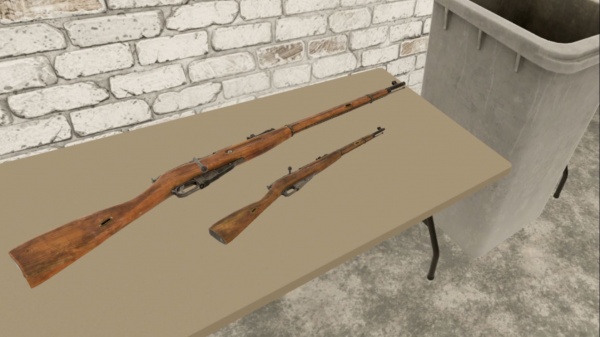
In case you wanted to know just how "Mini" the Mini Mosin is, its half the size of a normal M91/30.
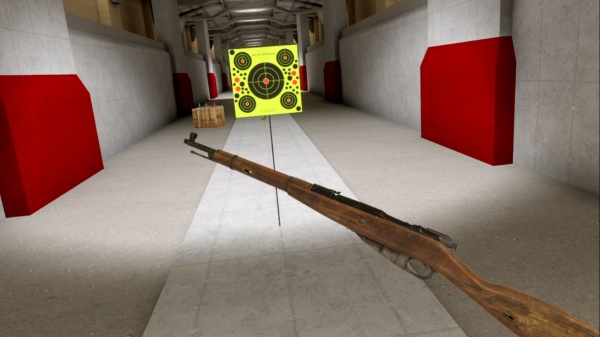
The left side of the Mosin Mini is identical to the Mosin Rifle.
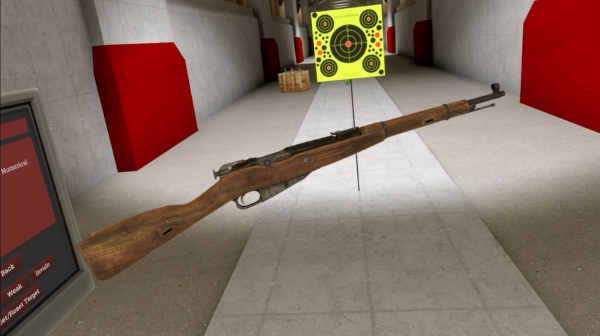
Ditto for the right side, though it uses the normal style bolt handle as opposed to the sniper style handle seen on the in-game M91/30.
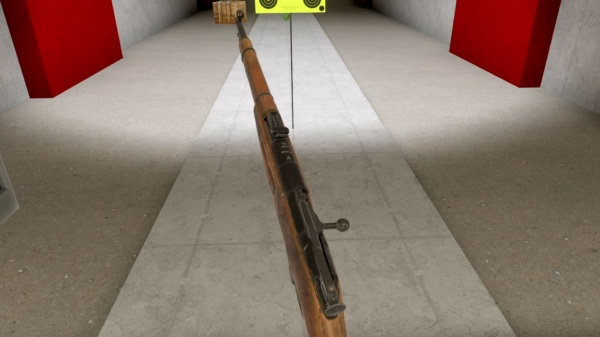
Like all Mosin rifles, the safety is a knob located on the back of the bolt, and is disengaged by pushing it in.
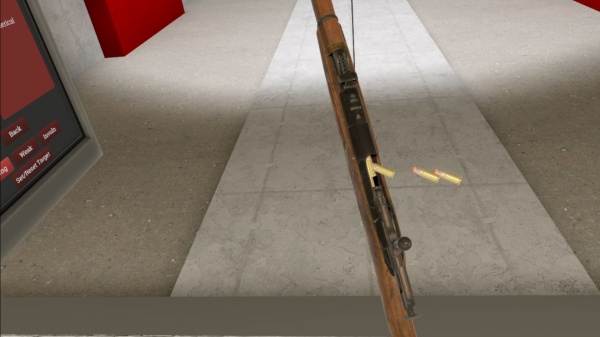
Since there are no .22LR stripper clips (yet), the tiny cartridges are inserted one at a time.
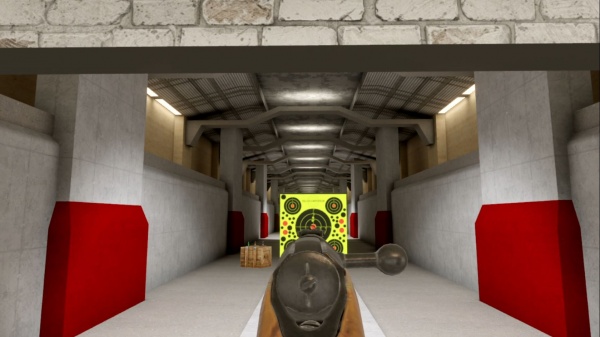
Standard sight picture for a very non-standard mosin.
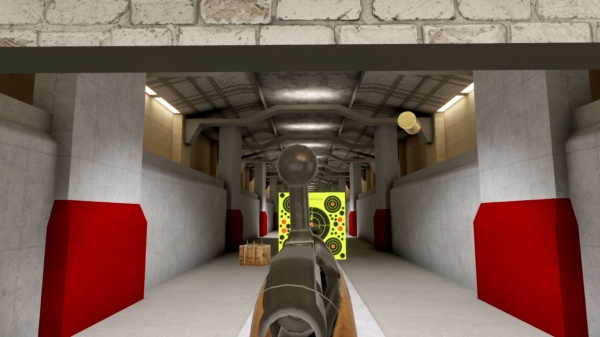
With virtually no recoil, its easy to fire all five rounds in quick succession with the help of quick-bolting.
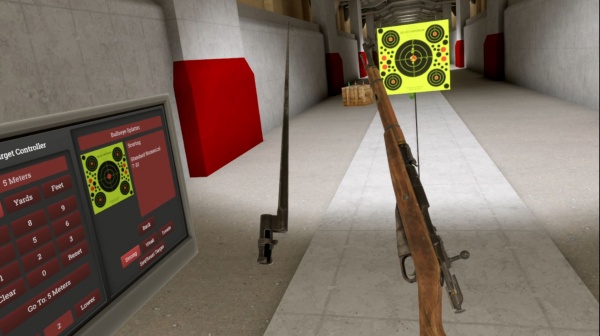
While the Mosin Scope can't be mounted on the Mosin Mini, the Mosin Bayonet can be. And as you can see, its almost half the length of the gun.

Even with the bayonet affixed, the Mosin Mini is still shorter than the M91/30.
Mosin-Nagant "Obrez"
Update #52's twelfth alpha brought along a sawn-off version of the Mosin, a configuration commonly referred to as an "Obrez" (Russian for "cut"). The entire stock is removed, and replaced with a homemade wooden pistol grip. Being a weapon meant to pad insufficient supplies of proper pistols among various underground groups, the Obrez is classified as one in-game.
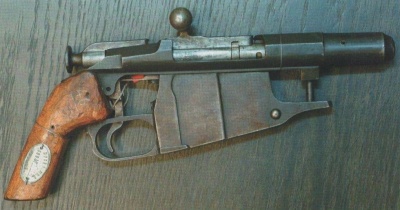
Mosin-Nagant "Obrez" with Pistol Grip - 7.62x54mmR
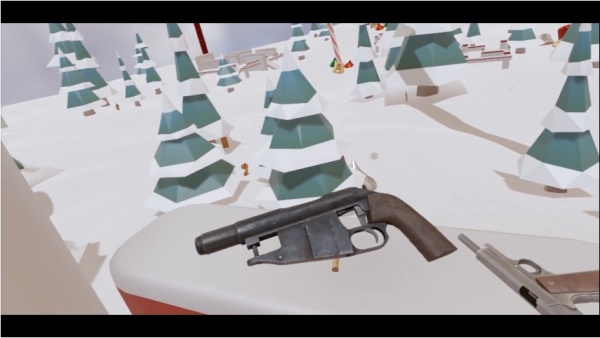
Well, it might be snowy, but at least it's not Stalingrad.
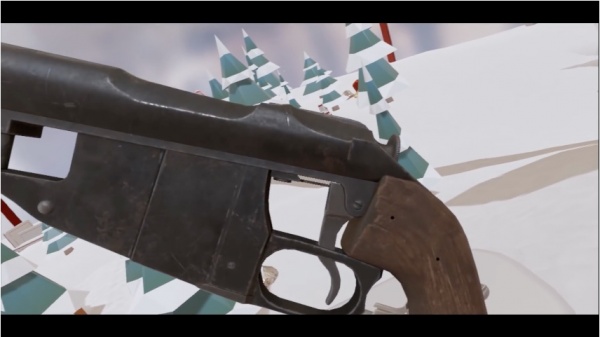
The absence of a stock shows off something interesting about the in-game Obrez:
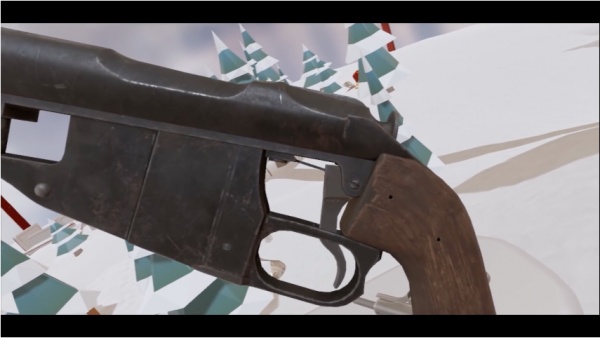
The trigger group is fully-functional, and all its parts move when the trigger is pulled.

Opening up the truncated Mosin's action...

...loading in a 5-round stripper clip...

...and sending the 1st of those rounds into the chamber, which constitutes more or less the entire barrel at this point.

"Aiming"; of course, considering the fact that both the front and rear sights are mounted on the now-near-nonexistent barrel, this is more a formality than anything else.
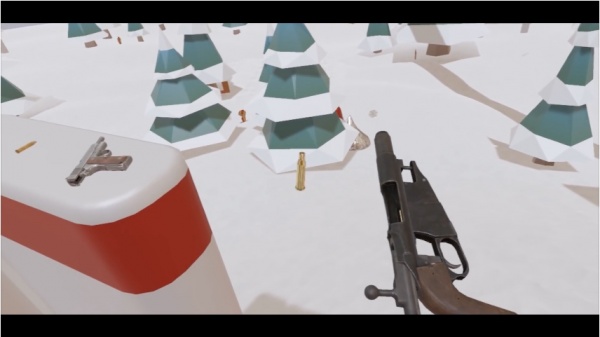
Ejecting a spent casing from the Obrez.

...and a little bit of that...
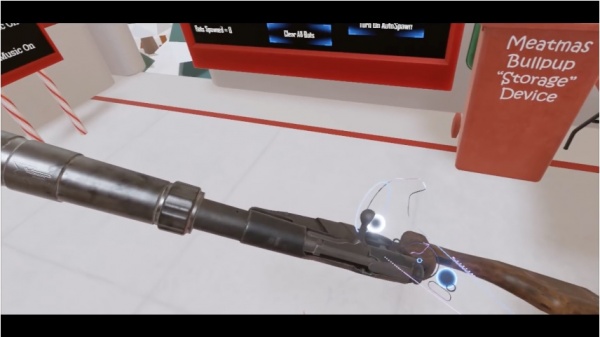
When Lovecraft spoke of something so innately wrong that it could drive men to insanity just by looking at it, one has to wonder if this is what he was referring to.
Quackenbush 1886
Update #56, AKA the 2018 4th of July Update, included an 1886 Quackenbush "Bicycle Pump" single-shot .22 carbine. Along with the Ruger 10/22 below, the Quackenbush marked the first addition of a firearm chambered in .22 Long Rifle since the addition of the Ruger Mk III back in Update #5.

Quackenbush 1886 "Bicycle Pump" rifle - .22 LR
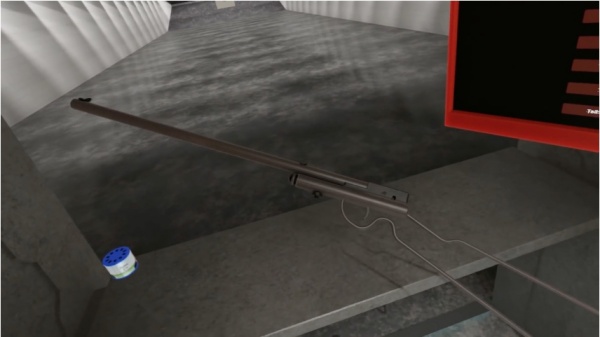
The Quackenbush. Yes, that's its real name.
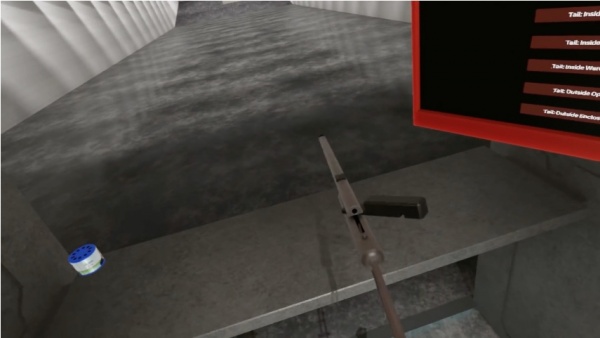
Opening up the Quackenbush's side-pivoting breechblock.
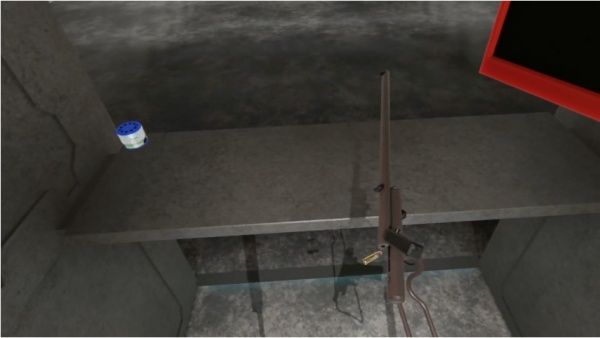
Loading in a .22 Long Rifle round; the red tip pegs it as a tracer.
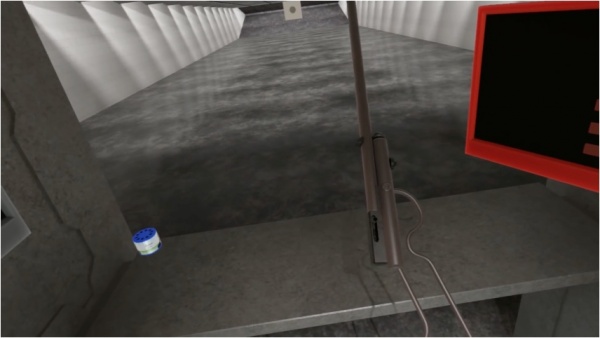
Flipping over the now-closed Quackenbush...
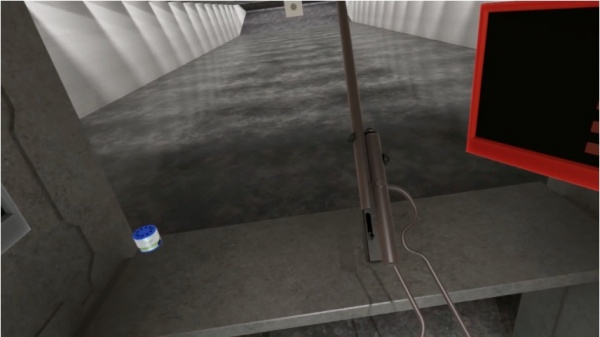
...and cocking the striker.
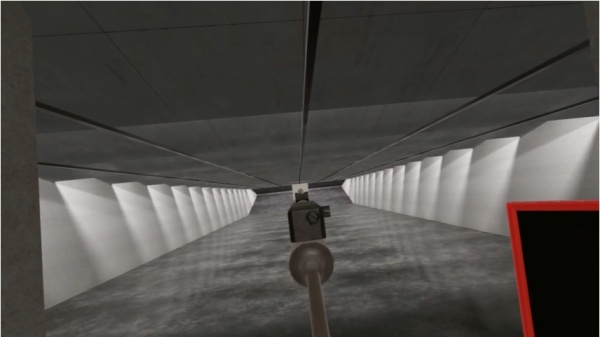
Lining up the simple notch-and-blade sights of the Quackenbush. That's just fun to say. Quackenbush, Quackenbush, Quackenbush...
Remington Model 7615P Patrol Rifle
The Remington 7615P Patrol Rifle was added in the Meatmas 2023 update. This is the first pump-action rifle added to the game (barring the fictional MP5 Shadow), and its first known appearance in a videogame.

Remington 7615P Patrol with
AR-15 stock and pistol grip - 5.56x45mm NATO

Opening up another gift box, and discovering this funky thing.

A familiar sight to those with the misfortune of living in a ban state. Or a ban country.
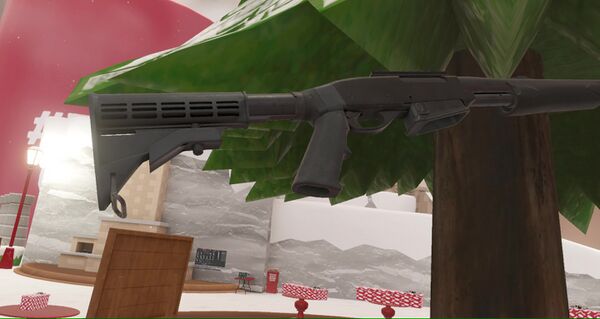
Fiddling with the stock; both it and the pistol grip are simple, basic
M4A1-style parts, with the stock being the later 6-position type.
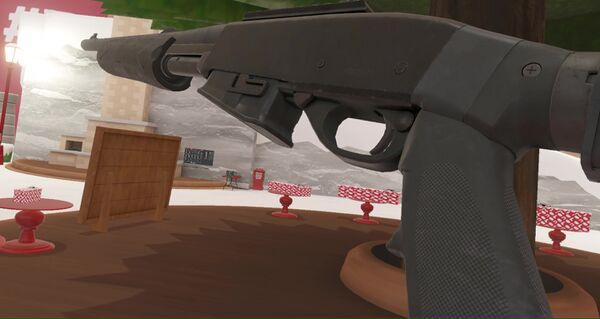
Being fundamentally based on the same company's
870 receiver, the 7615P has the same style of crossbolt safety. Even the furniture's compatible - the stock and grip are mounted to an 870 adaptor.
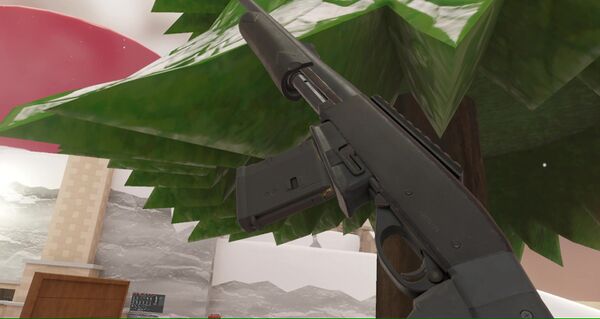
Popping in one of the provided magazines - a 10-round PMAG. Another sad necessity of certain locales, though the option's nice to have in-game.

Chambering a round, and making the rifle better resemble the reference image in the process. Couldn't say why that one has the action back, but it's the best image I could find of one configured like this.

Taking aim at a tree; the rear sight's rather small, and the base of the Picatinny rail doesn't exactly help matters. Nor do standard HMD resolutions.

Fortunately, it's a bit hard to miss a tree-sized target at this range.
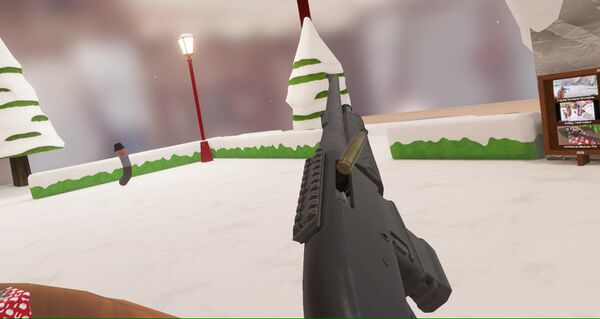
Ejecting a spent case. The 7615 has a distinctly different "feel" to it than the game's other pump-actions, shared with the previous year's
SPAS-15; this seems to be due to both using a different code-base than the rest of the weapons in their class.
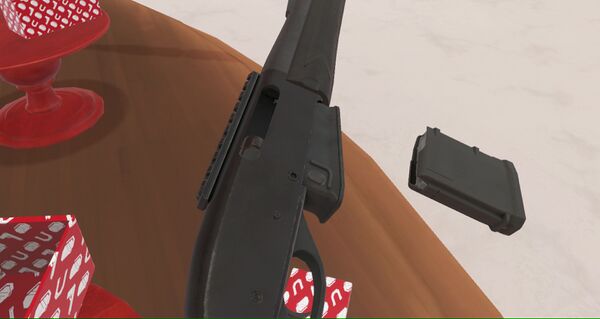
This also means that, upon running the meager 10-rounder dry, you can run the action back, swap mags...
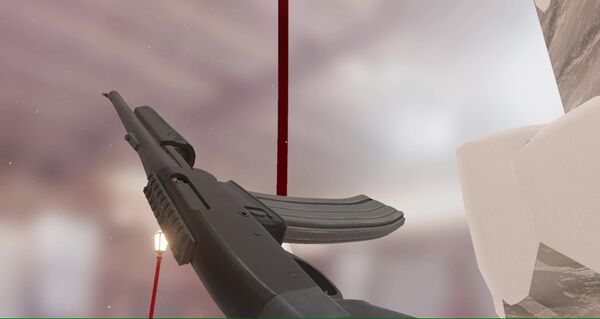
...and push a round straight into the chamber, no inexplicable second action stroke required. (What, did you think I'd stick with 10-rounders just for the sake of the bit?)

Putting on a scope also helps matters a bit. Unless the "matters" in question consist of ignoring your intrusive thoughts, in which case it actually kinda makes the temptation worse. Luckily for the fellow in the lens, "close" only counts in horseshoes and hand grenades.
Remington Rolling Block
Update #91 added two variants of the Remington Rolling Block; the first is a standard-pattern commercial carbine chambered in 8x50mmR Lebel (the first weapon in the game to use the round), and the second is the rare No. 1 "Creedmoor" sharpshooter pattern, equipped with an aperture sight and chambered in .45-70 Government. The two rifles are the first in a new sub-category (breech-loading rifles); by and large, they're functionally identical to the earlier-added Rolling Block pistol. With Update #94, mechanical accuracy for firearms was implemented, and the Creedmoor's ladder sights could be now zeroed to multiple ranges; between this and its superior accuracy to the standard Rolling Block rifle, the Creedmoor stands out as the better option for long-range shooting.

Remington Rolling Block - .32 rimfire. Similar to the in-game rifle.
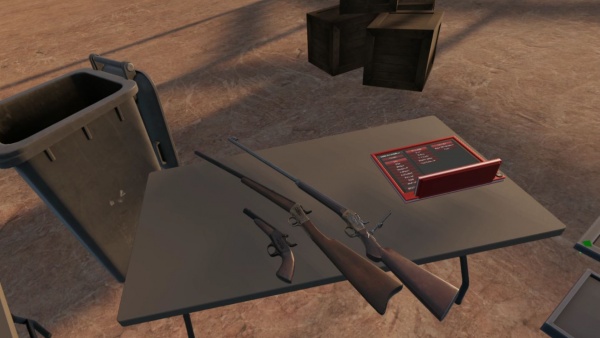
The Remington Rolling Block family - we've got mama bear, papa bear, and baby bear, all in one place.
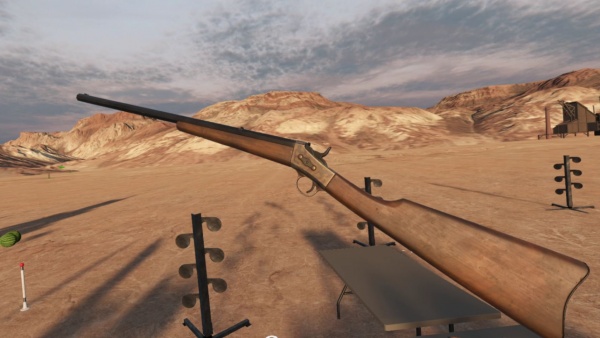
First is the standard Rolling Block rifle, which unsurprisingly, looks like a longer version of the Rolling Block pistol.
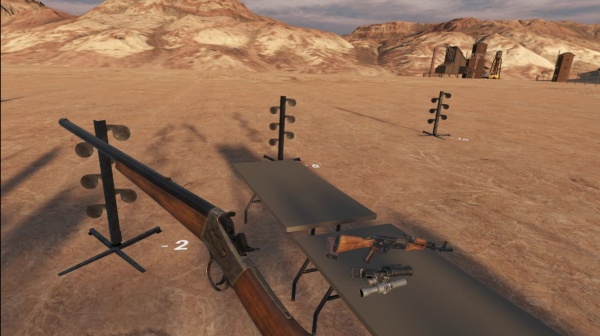
Cocking the hammer allows the breech to be accessed.
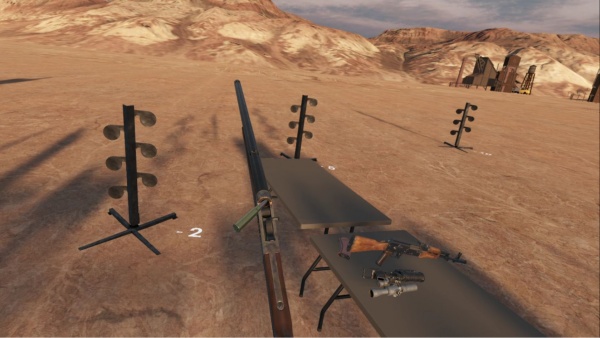
...and inserting a single 8x50mmR Lebel round.

Cartridge chambered, the breech can be closed, and the rifle is now ready to fire.
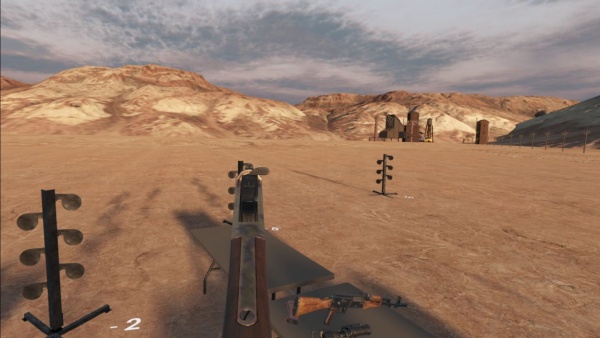
Aiming down the Rolling Block's simple sights.
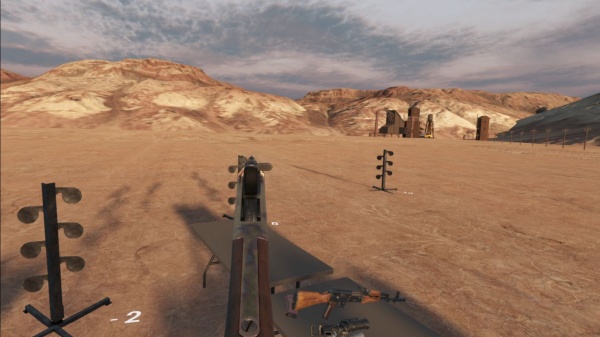
Firing the Rolling Block.
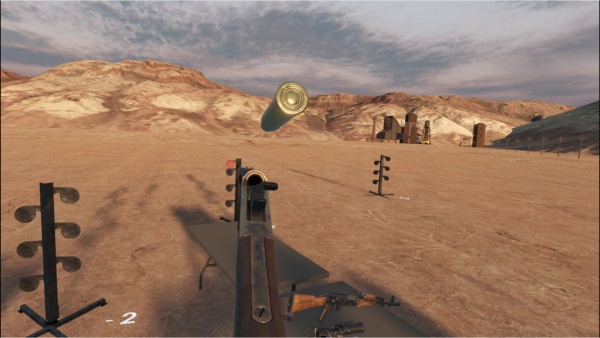
Upon opening the breech again, the poor cameraman was immediately struck by a hot brass shell. After all, there's no real point in opening the breach while still shouldered.
Remington No. 1 Rolling Block "Creedmoor"

Remington No. 1 Rolling Block "Creedmoor" - .22 rimfire
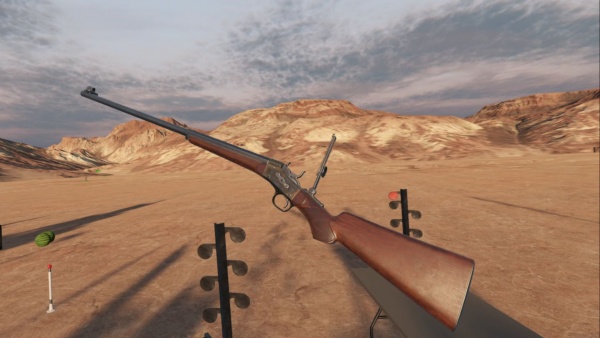
Next we have the Creedmoor, the Rolling Block's richer, fancier sibling.
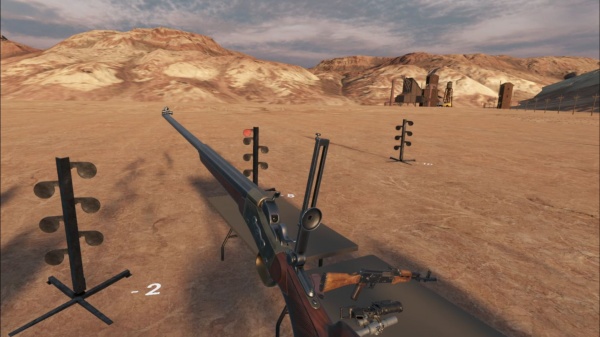
Cocking the Creedmoor's hammer.
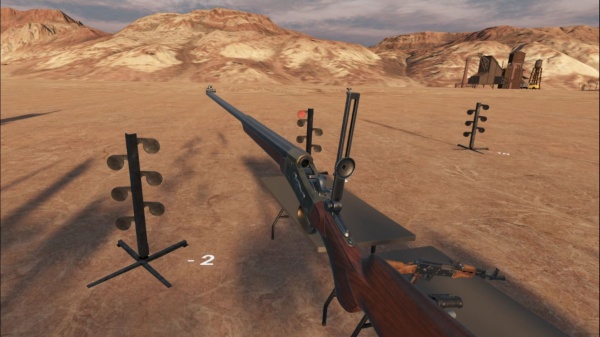
Opening the Creedmoor's breach.

This time we have a .45-70 Govt cartridge, an ideal cartridge for big-game hunting. Sadly there are no meaty safari animals to take this gun hunting with... yet.
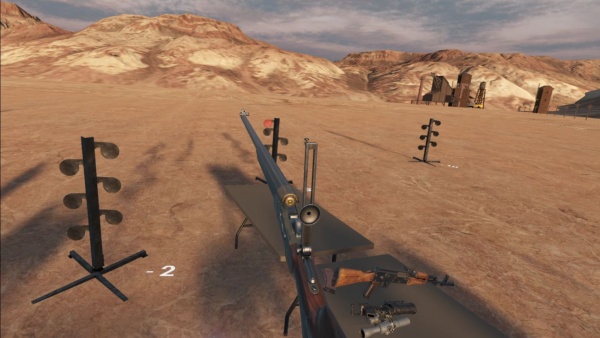
Chambered, ready to close the breach and fire.
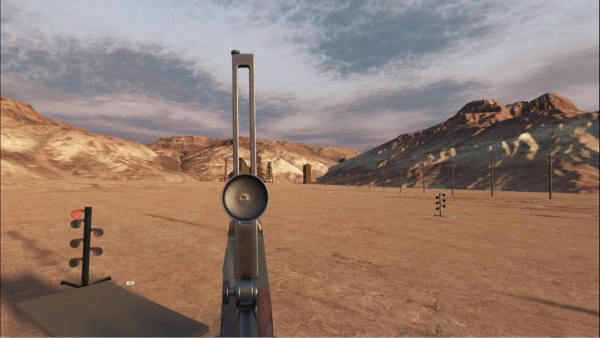
Aiming down the Creedmoor's aperture sights; the hole for the aperture is widened, as apertures do not work in VR as they do in real life due to the artificial focal plane. Instead, one has to center the front sight through the aperture to aim. Not the most accurate, but its a necessary compromise.
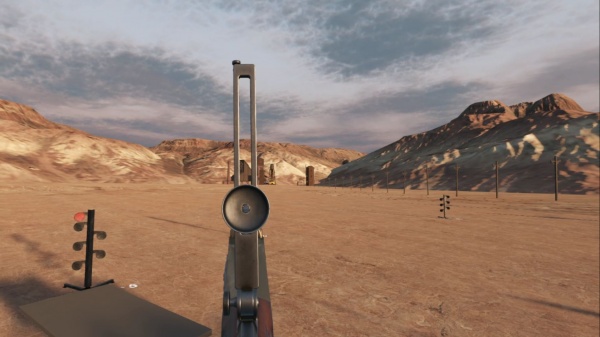
Upon firing the rifle, the sight picture is immediately obscured by the rear aperture. However, the clang of the metallic target being hit confirms the shot. Unfortunately, this doesn't come across in picture format.
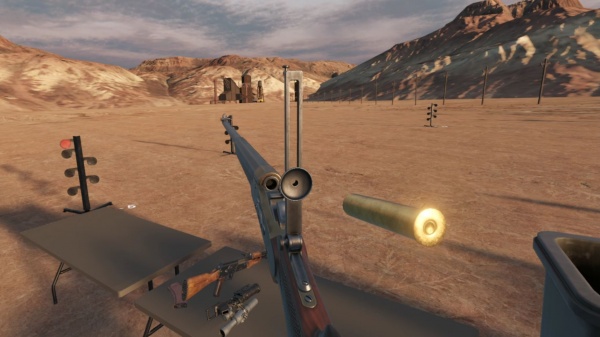
Ejecting the cartridge, this time ensuring that the cameraman's face is nowhere near the breach. Still a close call, though.
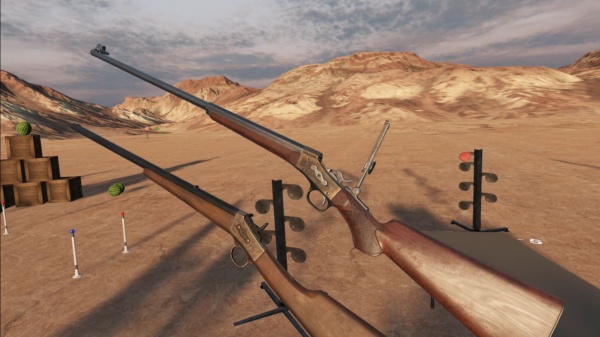
Another side-by-side comparison of the two rifles.

With the ladder sights now adjustable, the Creedmoor's default setting is at 100 meters...
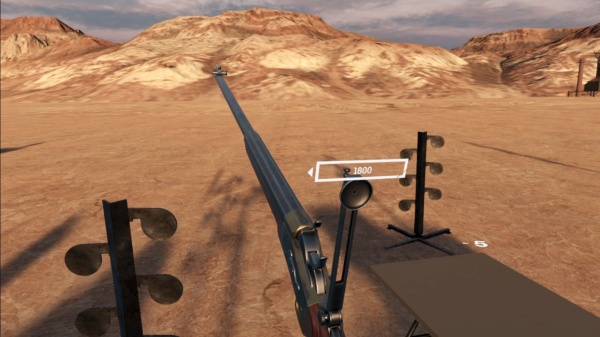
...with its maximum at 1800 meters.
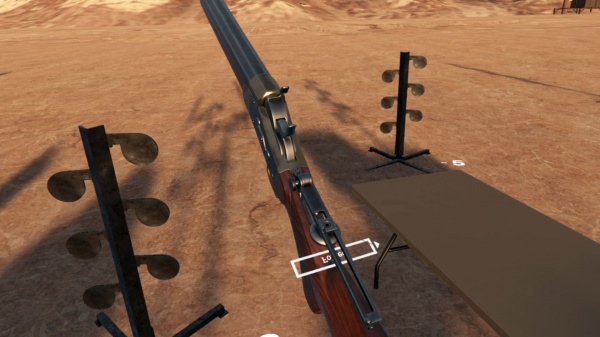
Or if you find the ladder sights too obstructive, you can opt to simply fold them out of the way. This takes away any rear sight to aim with, but assuming your target is a lot closer than 100m, its not too difficult to aim with. It also makes loading the rifle less fussy since the ladder gives you less space to work with.
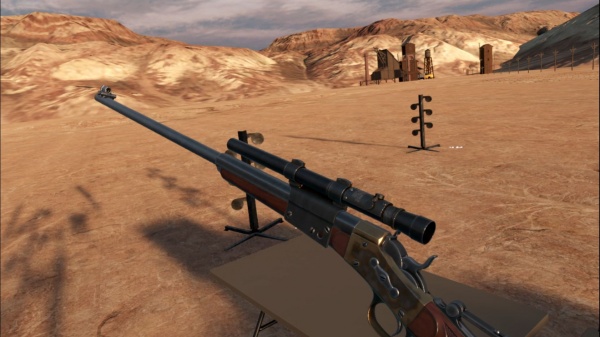
An earlier update allowed you to attach the Weaver 330 scope to both versions of the Rolling Block, as well.
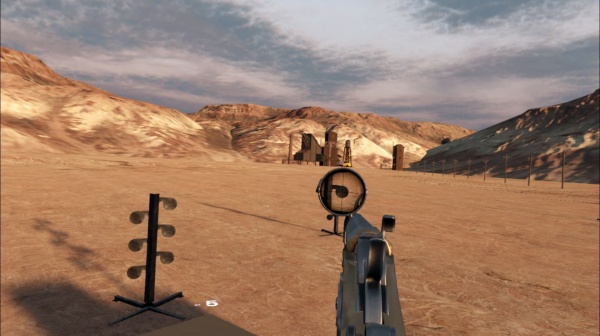
Even though the scope is offset enough that the ladder sights wouldn't interfere, having it folded down still gives you better peripheral vision.

Of course, the Weaver scope isn't the only attachment point; anything can be mounted on the muzzle, including this new wrapped suppressor.
Rossi Rio Grande
Update #75 added two variants of the Rossi Rio Grande lever-action rifle to H3, both of which are chambered in .45-70; this fulfilled a long-standing community desire for a lever-action in the cartridge. Both are known in-game as the "Rio Big-Bore", with the non-suffixed version having synthetic furniture, a receiver-mounted scope rail (a Rossi factory option), and a custom lever, while the wood-furnished "Salvaged" variant is a "Mare's Leg"-esque configuration, with an extended lever loop (another factory option), and a shortened stock, barrel, and magazine tube.

Rossi Rio Grande with extended lever loop and scope rail - .45-70 Government

Inspecting the tacticooled Rio Grande. On top of the pre-added modifications, this one's been fitted with a laser sight, a Trijicon MRO on a riser...
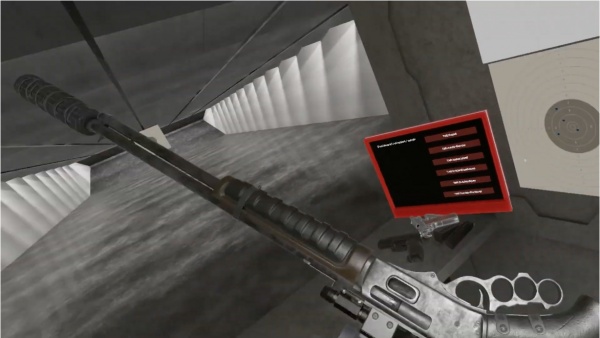
...and, as is visible here, a cloth-shrouded suppressor.
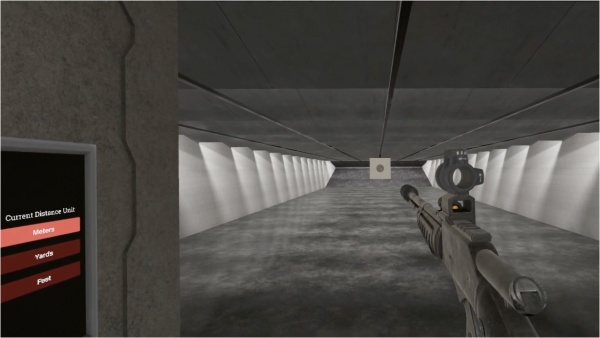
Opening up the action, while responsibly keeping the rifle pointed downrange.
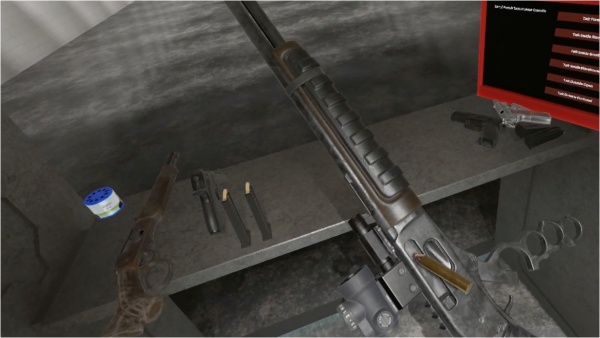
Loading a single .45-70 round into the ejection port.
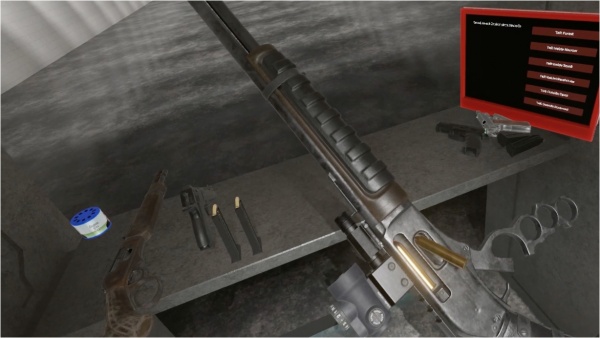
And a few more in the magazine tube.
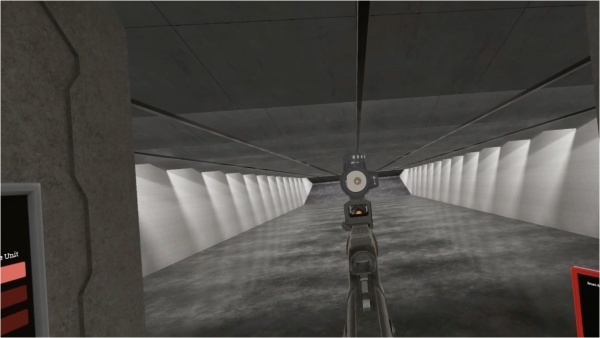
Aiming through the attached MRO.
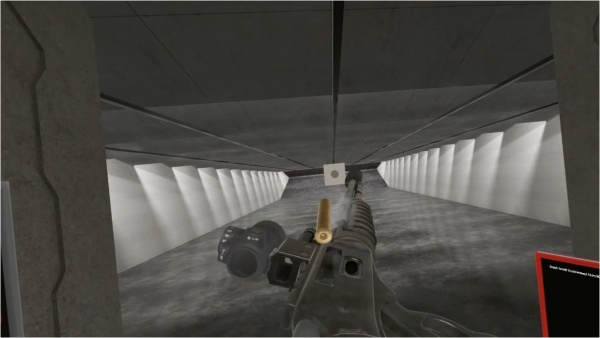
Working the action, and ejecting a spent case. As cool-looking as the brass-knuckle lever is, it's probably not all that comfortable. Especially for those with large hands.
Salvaged

The shortened variant. Looking at this image, it should be pretty obvious where it got the name "Salvaged".
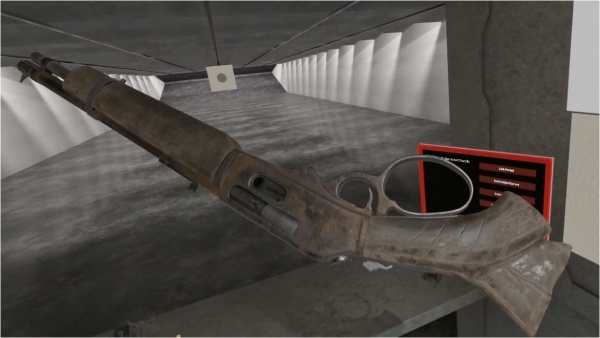
The abused rifle's other side, which shows off what seems to have been a rather poor attempt at applying stock checkering.
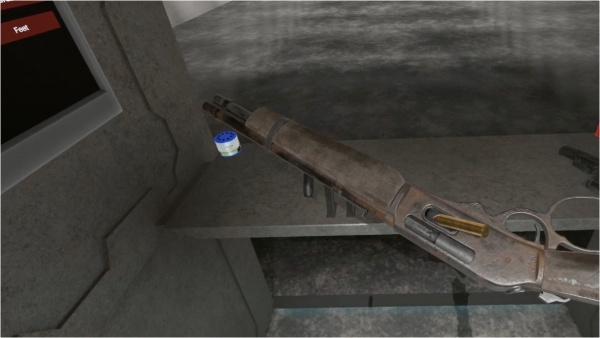
Loading a few .45-70 tracers into the Rossi's magazine tube.
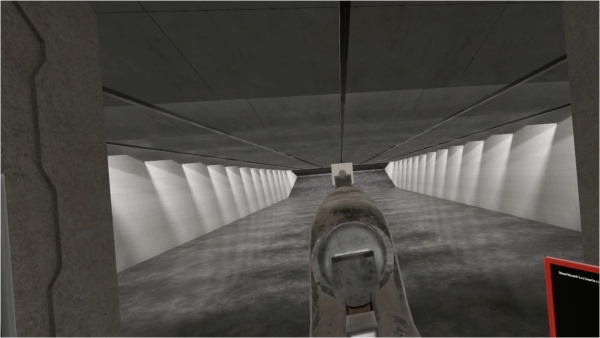
Lining up the simple notch-and-post irons...

...and letting a round fly. The next few frames consist of the wielder getting a serious case of Nosehammer Syndrome.
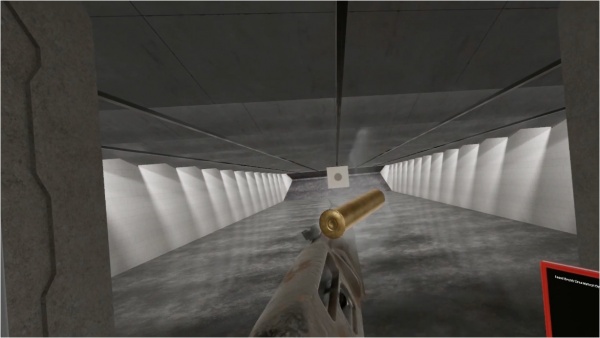
Cycling the truncated Rio.
Ruger 10/22
Update #56 (released July 4, 2018) added a synthetic-stocked Ruger 10/22 carbine. Along with the aforementioned Quackenbush, the 10/22 was the first .22 Long Rifle-chambered firearm in H3 since Update #5's Ruger Mk III. Update #105's 2nd experimental build replaced the model with two - a standard wood-furnished model (with an attachable scope mount), and a "Sport" model with more or less every factory component replaced with an aftermarket one.

Ruger 10/22 with synthetic stock - .22 LR
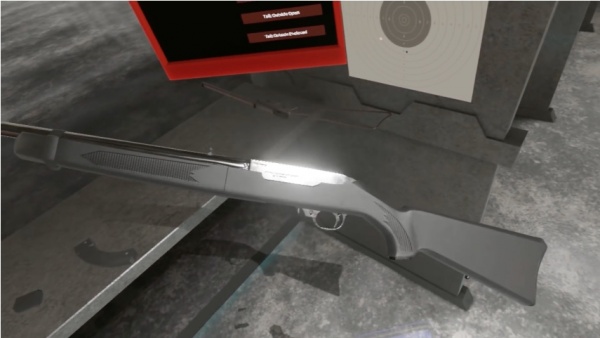
Examining the 10/22. The brightly-polished finish provides an interesting contrast with the matte black polymer stock.
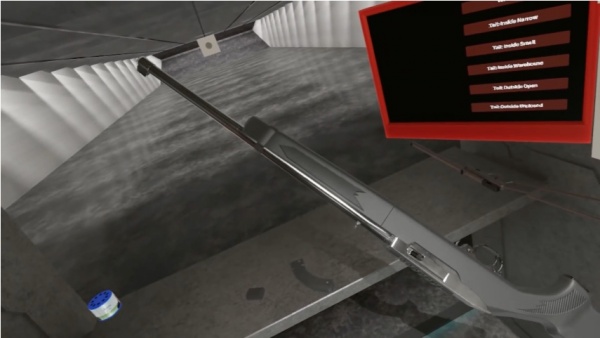
The rifle's other side. Note the line on the forestock; this denotes the rifle as a takedown (i.e. capable of being split in half for easy transport) model.
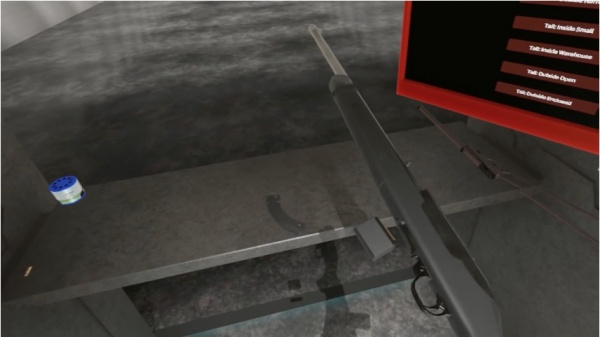
Loading in a 10-round rotary magazine.
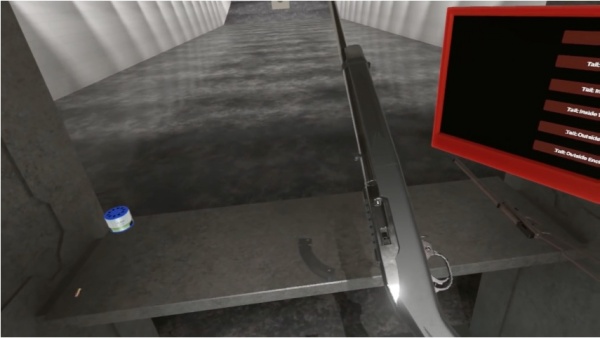
Pulling back the charging handle.
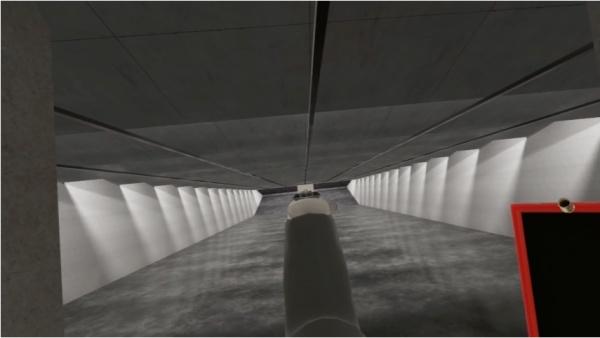
Plinking the target with a few .22 rounds.

"Sure, 10-rounders are fun and all, but I could really go for something with just a little more...
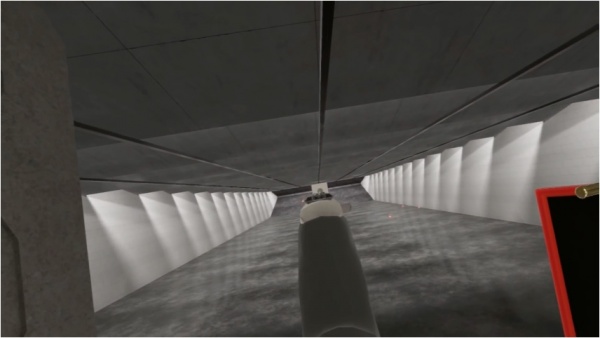
Perforating the target with the aid of 25 .22 tracers.

Ruger 10/22 with wooden stock - .22 LR

Taking a step outside, and getting some fresh air with the equally-fresh 10/22.

Well, "fresh" as far as its presence in the game is concerned; the barrel band, curved buttplate, and simple rear sight peg this as a pre-2005 model, making it at least 17 years old by the time of its implementation.

Loading in a magazine; the 10-round rotary design remains a distinctive feature.

Chambering the first of these 10...
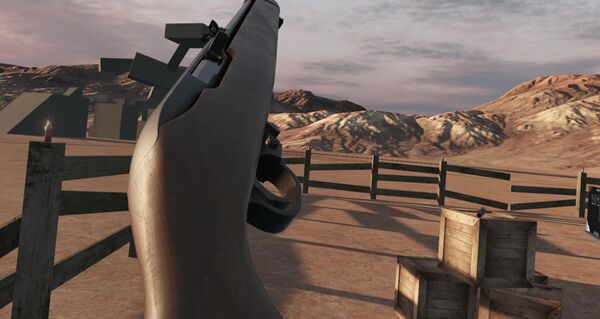
...and disengaging the simple crossbolt safety.

Aiming; while most of the 2005 update's changes were focused on simplification, its fiber-optic front sight does make aiming a bit easier than the earlier variant's simple notch-and-post setup.
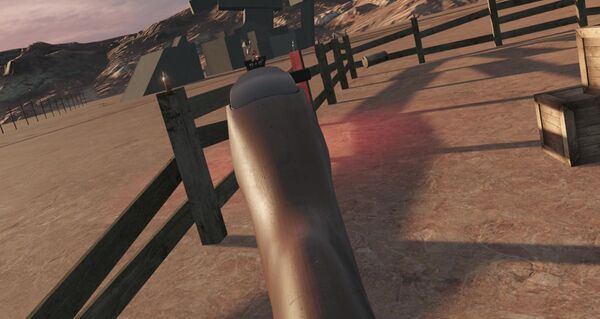
Still, the older sights get the job done just fine.
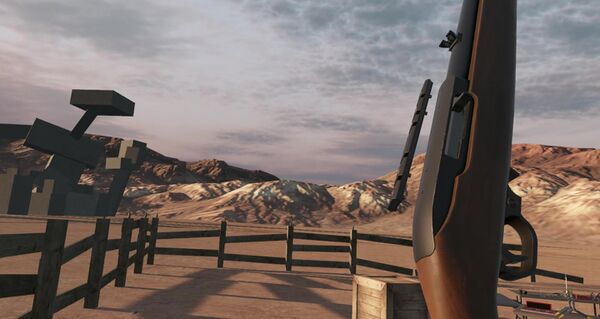
And if you were wondering what the holes in the receiver were for, here's your answer: the gun comes with a proprietary attachable scope rail.
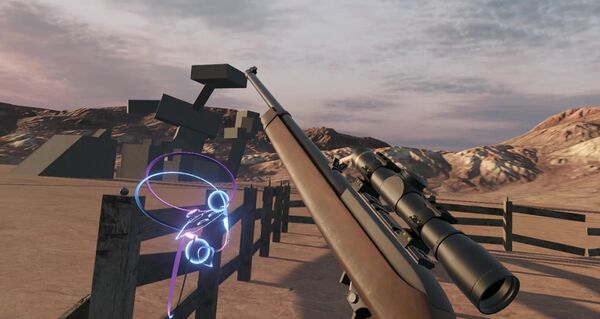
To which, as the name would imply, you can then mount a scope.
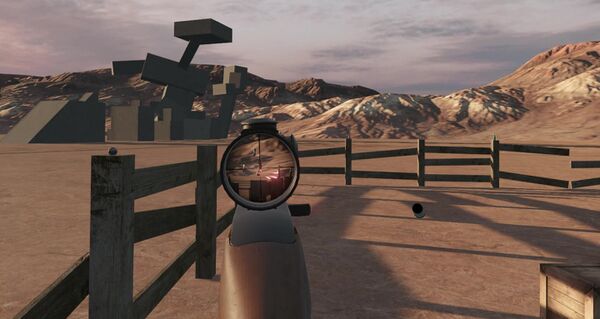
Perfect for all your glass-assassinating needs.

When you're having this much fun, it's easy to lose track of those 10 rounds. Good news is, the supply of .22 LR never dries up in virtual reality.

Tactical Solutions X-Ring VR with Magpul X-22 Backpacker stock - .22 LR
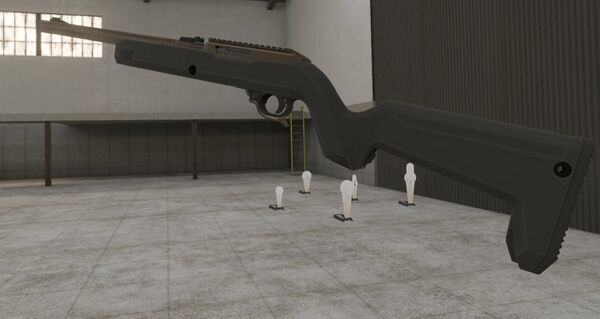
Taking a look at the fancy new 10/22.

If you can really call it a 10/22 at this point.

Loading up Theseus's 10/22 with a factory BX-25 magazine.

Giving it an underhand yank of the charging handle, the cutout in the receiver giving a good view of the bolt moving back.
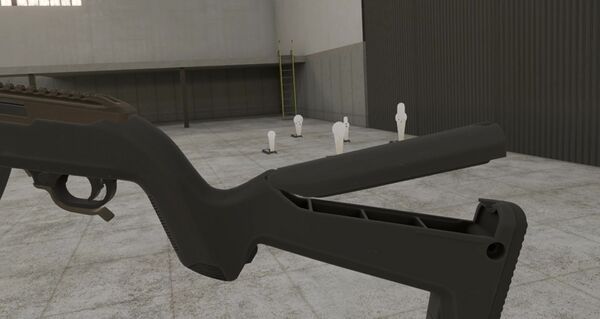
That's not the only place magazines can go, though...
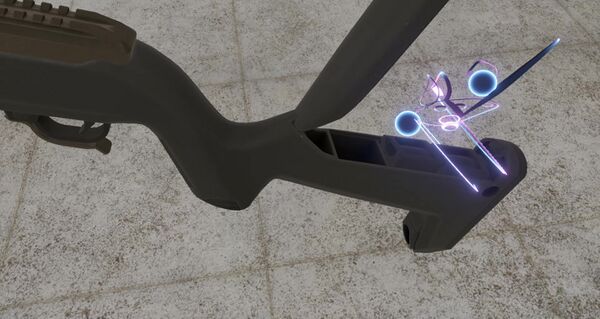
Shoving some magazines into the compartment in the stock - they might just come in handy later.

Taking aim at a steel silhouette; the illuminated fiber-optic sights make landing shots a bit easier.

Leaving the safety on, however, does not.

Firing at a slightly closer target, largely for the sake of getting a better look at the bolt again. What can I say - it's neat.

With the magazine having exhausted all 25 of its rounds, it can still serve one last purpose - to demonstrate that the Sport variant's extended magazine release is functional, allowing for magazines to be free-dropped with the firing hand.
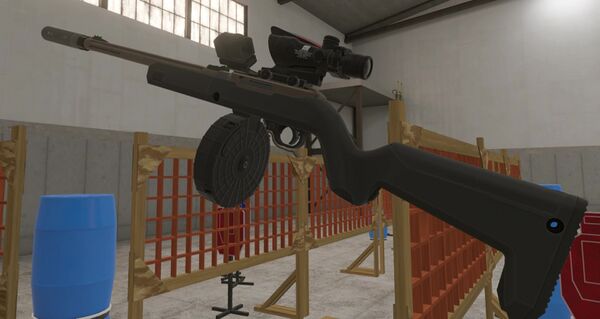
Of course, a gun like this is just begging for some mods, isn't it? Granted, a 50-round drum might be a bit over the top, but there's no plink like overplink.
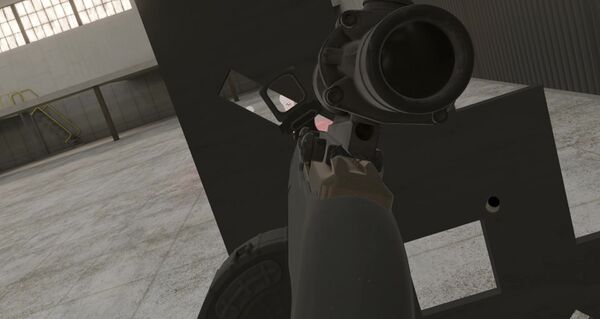
Aiming through the canted RDS, and becoming quite possibly the first person to ever fire a 10/22 from a - no, wait, that joke's been used already.
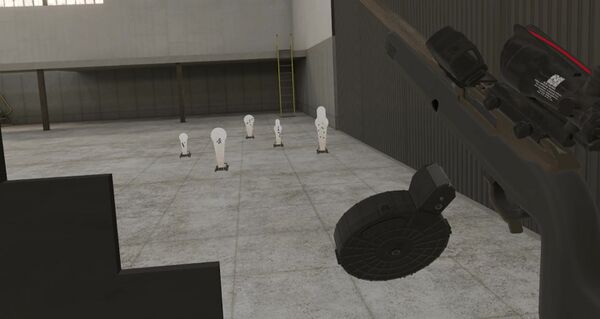
Much like the editor's supply of original jokes, the drum's supply of ammo inevitably runs out sooner or later.

Good thing about that storage compartment.
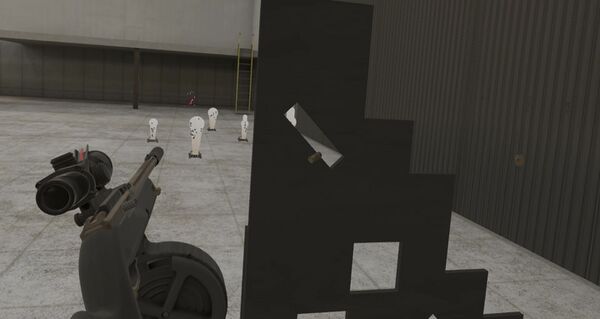
Now, the joke about the V-TAC barricade's been done, but there's good money on the idea that you've never seen someone bump-fire a 10/22 in VR before. Have fun figuring out how that works without actual recoil.
Ruger American Rimfire
A .22 LR-chambered Ruger American Rimfire was added in the second day of Meatmas 2022's Advent calendar.

Ruger American Rimfire - .22 LR

The American Rimfire in its box, showing off its abbreviated in-game name.
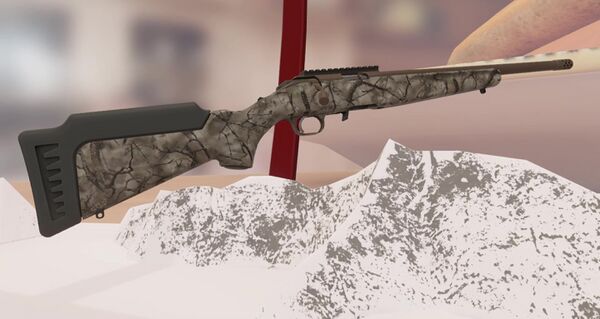
Taking a closer look at the rifle. The muzzle brake would probably be a bit more useful if the gun wasn't chambered in .22 LR.
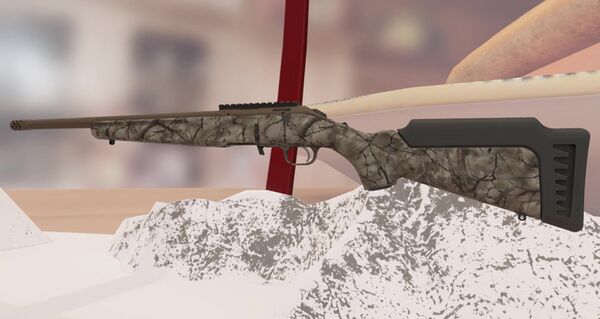
And the camouflage would definitely be more useful somewhere other than the inside of a snowglobe.

A close-up of the safety switch, mounted on the rear tang.
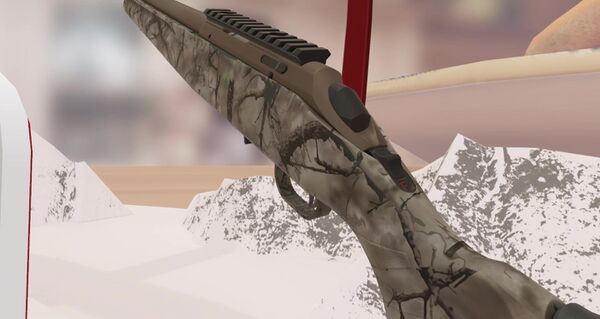
It functions pretty much as you'd expect, complete with markings that make sense to more or less anyone that speaks a Romance or Germanic-family language.
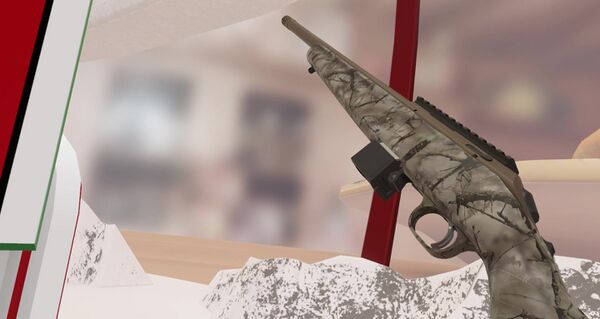
Loading in a 10-round mag. Being a
Ruger-made rifle in .22 LR, it naturally uses
10/22 mags, both OEM and aftermarket.
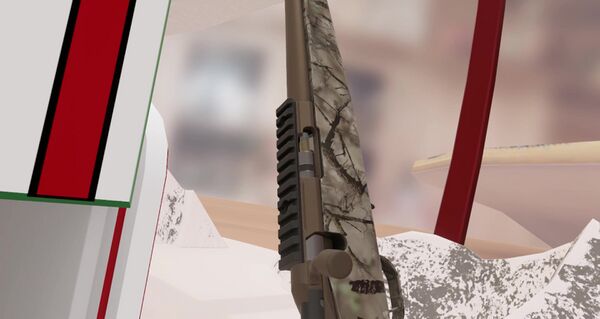
Chambering a round of everybody's favorite rimfire; as with many of the Meatmas gifts, the default rounds are tracers. Because, why not?

Attempting to aim at a distant snowflake, an attempt which ends pretty much the moment the gun's lack of sights is realized.

There we go, that's better. Fun fact: this shot was taken with my left hand braced against the ceiling - one of the few times when having a low ceiling in a VR room is actually an advantage.

This shot was also taken with my hand braced against the ceiling.
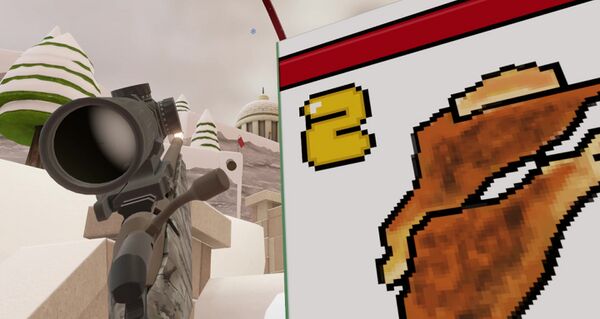
Cycling the rifle - this would be a far more dramatic shot if the spent casing wasn't so small.

Of course, when you're having this much fun plinking, ten rounds goes by all too quickly.
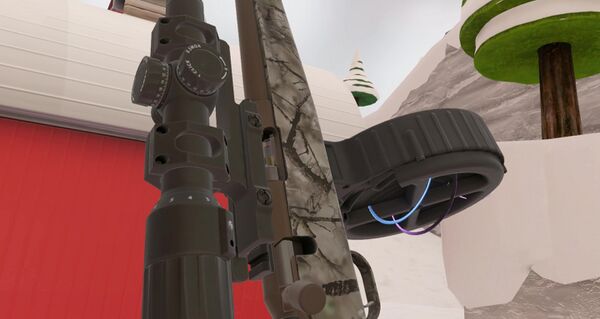
One hundred and ten, however...
Ruger Mini-14
The Ruger Mini-14 was added on the full release of Update #104, in two variations - the fixed-stock "Classic", and the folding stocked "GB".

Ruger Mini-14 (pre-2005) - 5.56x45mm NATO
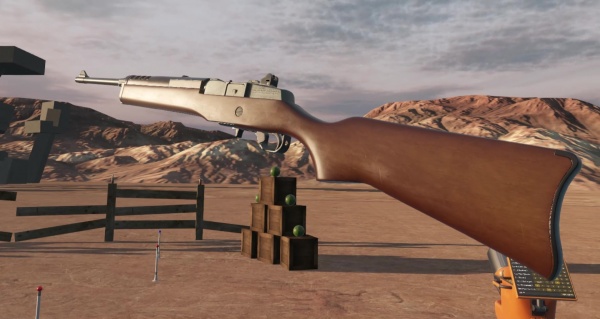
Admiring the Mini-14 out in the Arizona desert.
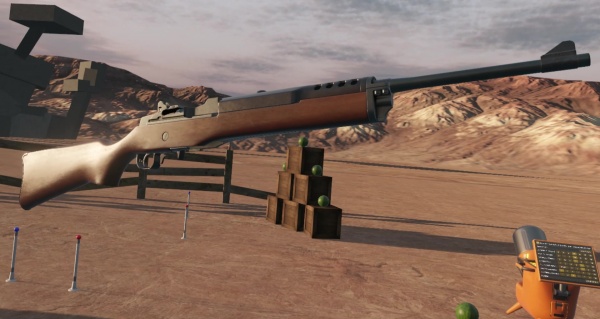
That would've been a joke about "the Ranch Rifle out on the ranch", but it'd be hard to farm anything other than dust out here.
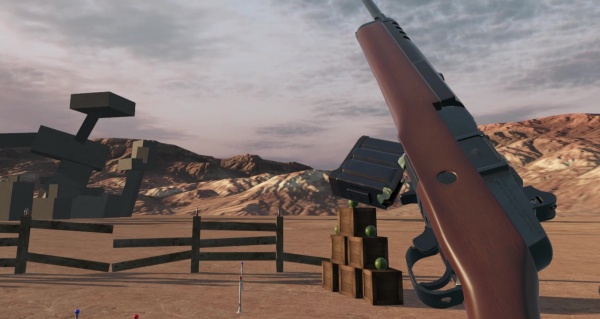
Rocking in a 5-round magazine; they don't offer much in terms of capacity, but they do fit flush against the bottom of the stock, so there's that at least.
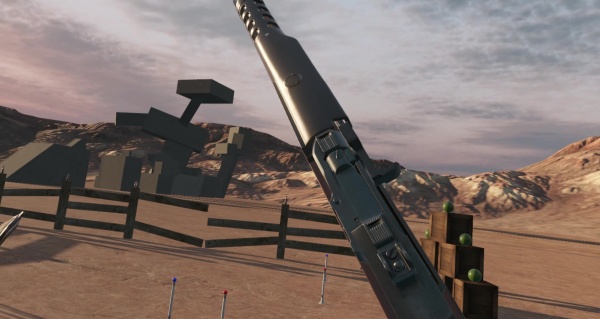
Just barely beginning to pull the charging handle; the bolt correctly rotates to unlock before it begins moving backwards. As a note of trivia, this detail (or rather, the ignorance of it) is why some games'
M14 variants' bolts clip through the backs of their receivers - the animators incorrectly assume that the bolt travels the same distance as the charging handle (which is generally shown going as far back as it can), causing the bolt to travel past its actual stopping point.
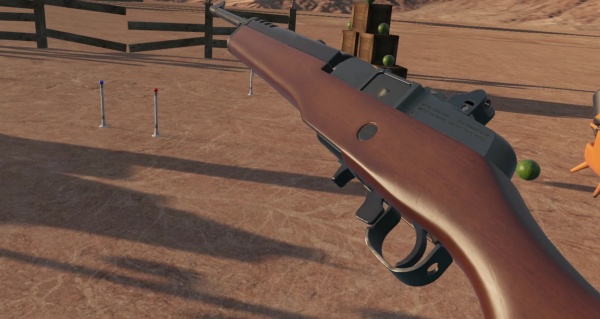
Disengaging the safety; being (as the name would imply) more or less a scaled-down M14, it uses a similar safety lever located in the trigger guard. Just push it forward, and you're ready to go.

The sights are likewise similar - a receiver-mounted aperture, and a simple front post on the end of the barrel (albeit without the M14's protective wings).
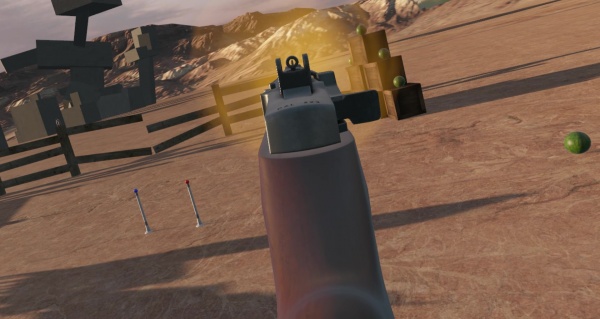
Shattering a glass bottle. This may well be one of the last times this particular bottle is ever broken - it was replaced in an update just after the Mini-14's addition.

Needless to say, those 5 rounds don't last terribly long.

Performing a quick reload with a fresh 10-rounder; the motivation here is less "tactical mag retention" and more "not wanting to wash dirt out of a dropped magazine". The markings on the side of the receiver were
originally completely accurate, but the Ruger logo and "STURM, RUGER & CO., INC" marking were removed for
H3's version, so they now rather unhelpfully say "BEFORE USING GUN - READ WARNINGS IN /
INSTRUCTION MANUAL - AVAILABLE FREE FROM / (blank space) / SOUTHPORT, CONN. U.S.A.".
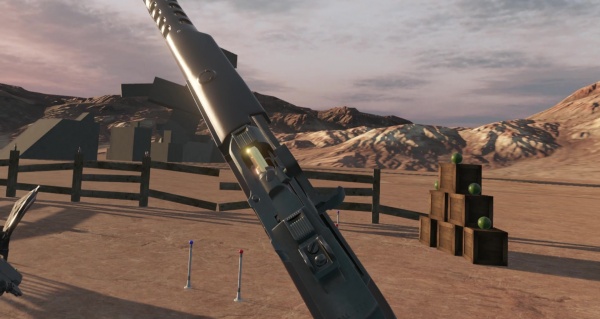
Giving the charging handle a tug, and releasing the locked-back bolt.

Ruger Mini-14 F - 5.56x45mm NATO

As darkness falls across the desert, and glowsticks of various colors cast an eerie glow, one age-old adage comes to mind:
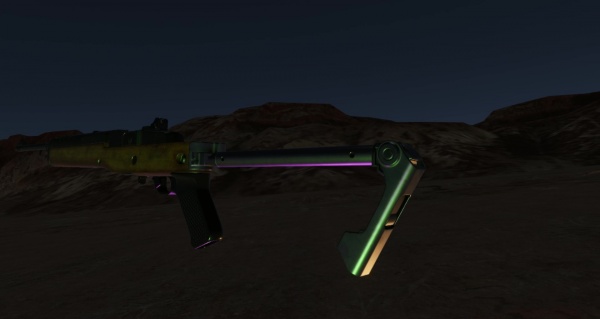
...and then unfolding it some more - the Mini-14's buttplate is treated as a separate component, and has to be folded/unfolded independently of the stock itself.

Rather dramatically rocking in a 30-round magazine - even if capacity restrictions were a concern in Arizona, civilization (and thus the law) is miles away and asleep, so all bets are off.
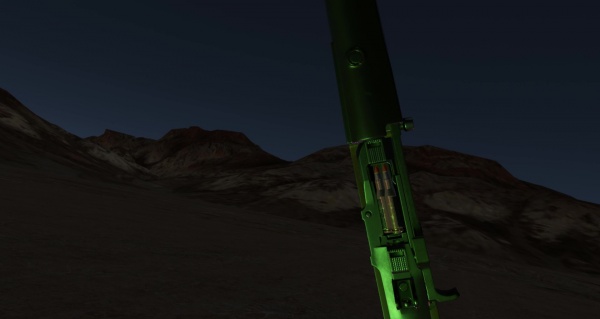
Accordingly, tracer rounds are also fair game. No RSOs out here to tell you off for sparks.

Giving the irons a try; they're functionally identical to the ones on the fixed-stock version.

That also makes them rather hard to use in the dark; luckily, a proprietary optic rail is available, for all your optical-sighting needs. Even if those "needs" involve aiming at a can of hairspray.

Needless to say, these make a fun target. The dramatic horizontal muzzle blast from the attached "StratBomber" muzzle brake (the brake from the
AR-50A1) is a nice added bonus.
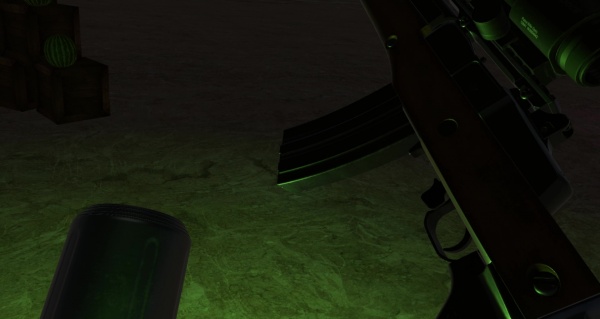
Disengaging the safety - given that the intended activity here is shooting hairspray cans (launched from the concurrently-added Thing Flinger, which can launch more or less anything) out of the air with 5.56mm tracer rounds, it's safe to say that safety as a concept has been pretty much disengaged all around.
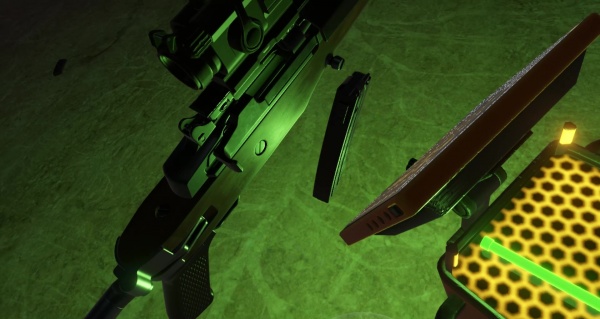
This is a shot of the rifle locked open. There would've been an awesome glamor shot of a Mini-14 spitting cases and tracers into the night under the light of multi-colored glowsticks as cans of hairspray exploded mid-air, but unfortunately, the desktop view (i.e. what actually got recorded) doesn't line up with what the user sees vertically, so all that colorful, fiery glory got wasted off the top edge of the screen. And I will never not be resentful about that.
Sako 85
A .308 Winchester-chambered Sako 85 is one of the available firearms in-game, added in Update #13. Rounding out the update's collection of shortened firearms, Update #46 brought us an Obrez-esque sawn-off Sako, classified in-game as a bolt-action pistol.

Sako 85 Hunter - .308 Winchester
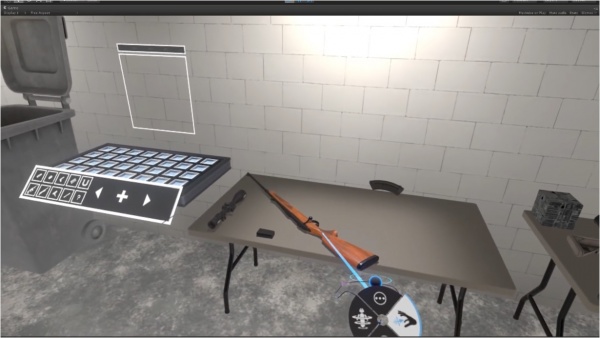
A Sako 85 sitting on a table. Considering the presence of a grab-laser, it's not likely to stay there for long.
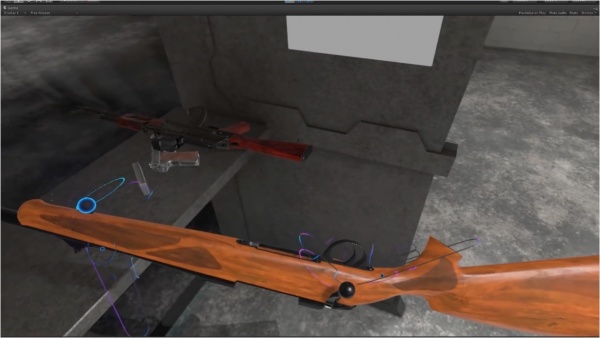
And indeed it doesn't, as evidenced by this close-up shot.
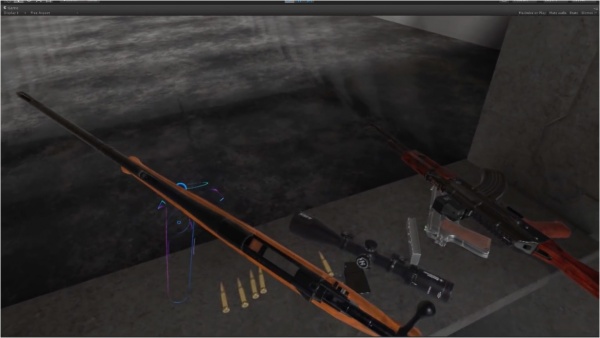
The Sako with its action open; since the magazine is detachable, removing just leaves a gaping hole underneath the bolt.
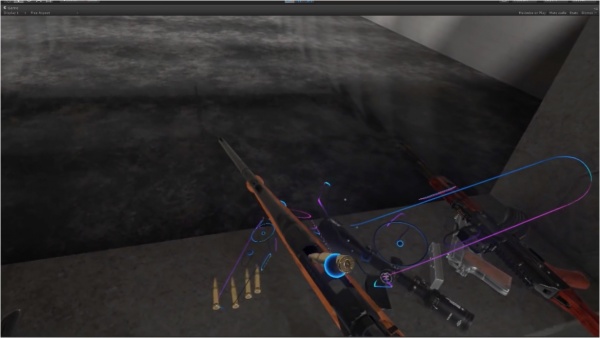
As with most of
H3's firearms, the Sako can be chamberloaded. Note that the round has a struck primer.
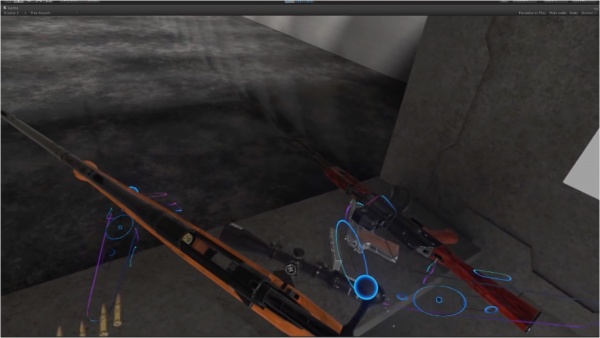
Doing so would (at the time of this screenshot) place the round into the chamber directly; Update #52 changed this to instead affix it to the bolt. Both are entirely feasible.
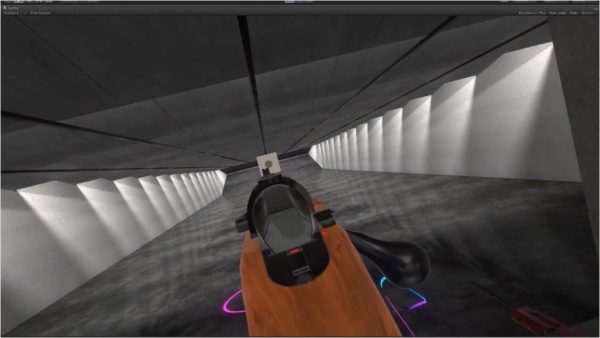
Aiming; the Sako 85's notch-and-post sights are serviceable, if a bit small.
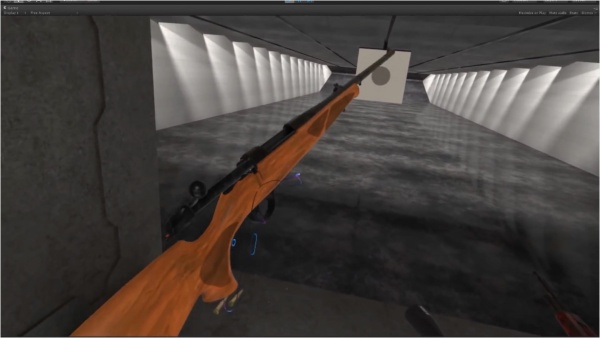
Of course, if single-loading isn't fast enough for you, there is another way...
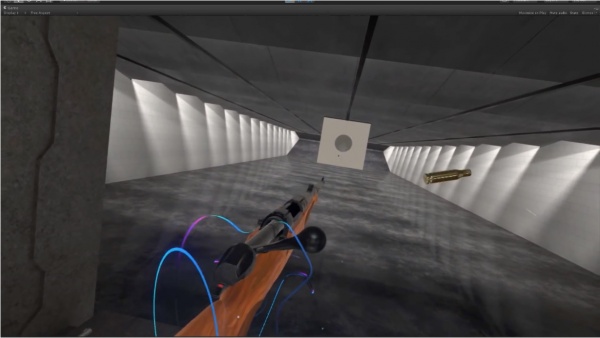
...that way being
H3VR's patent-pending Speed-Shooting Technique! Guaranteed to double your fire rate
and your group size! Order now! (Rifle sold separately).
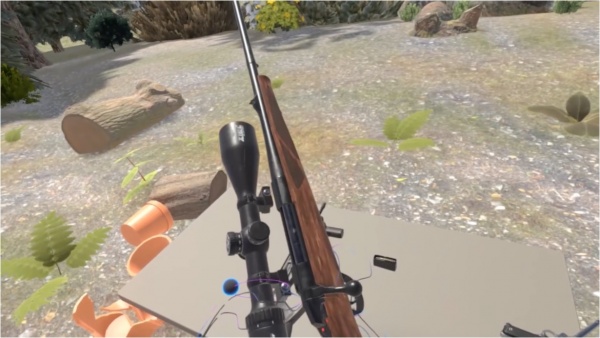
Having successfully hit the gong, Hick-not45 attaches a scope to his slightly darker Sako so he can hit that red plate over there.
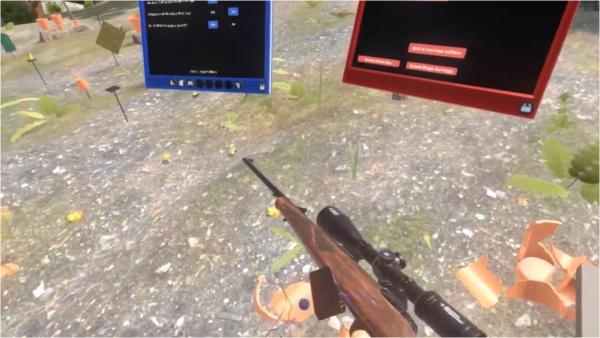
Of course, you can't hit a plate without something to hit it with.
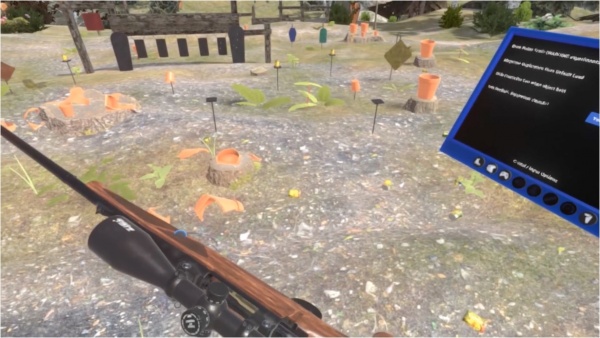
So, seeking to fix this, Hick-not45 opens up his Sako...
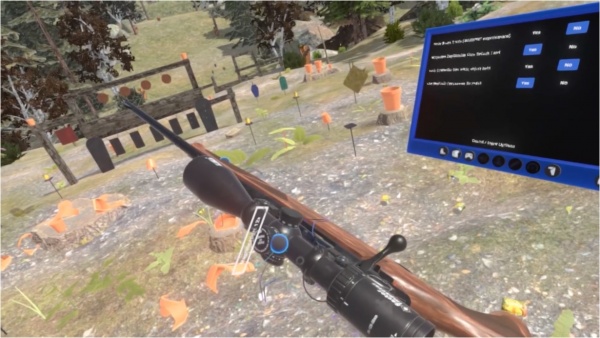
Realizing just how far away "over there" is, Hick-not45 decides to adjust his scope's magnification. This scope was introduced with the rifle; it is a 3-12x variable-power scope, supposedly made by "Ziel" (according to the markings).
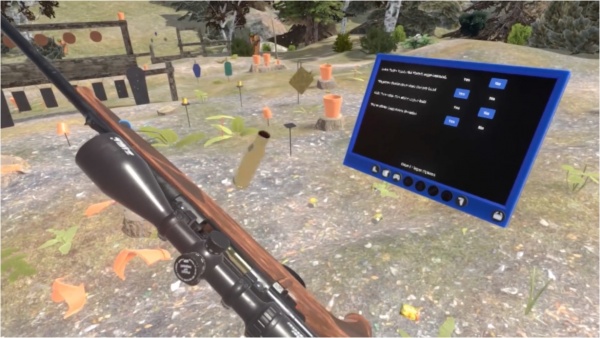
Having made his hit, Mr. 45 celebrates by ejecting a spent casing.
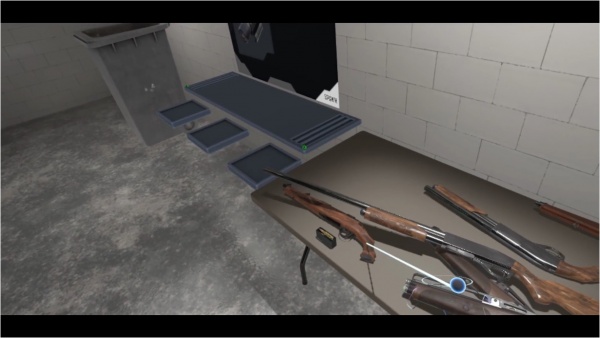
Meanwhile, back in the indoor range, something very bizarre appears to have happened to the Sako.
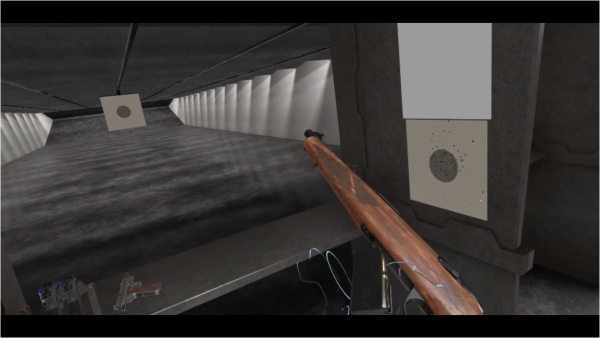
Said something seems to have been a severe curtailing of the Sako's, well... existence, really.
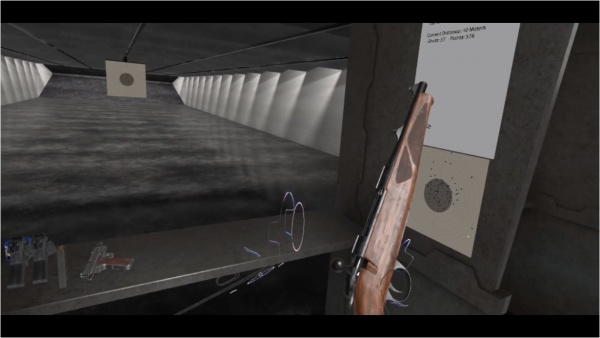
Fortunately, the action still seems intact.

And if the action's still in one piece, then the gun works.
Savage 99
The Savage 99 in .308 Winchester was added on Day 14 of the Meatmas 2022 Advent Calendar event. This is the first time that the Savage 99 has appeared in a videogame.
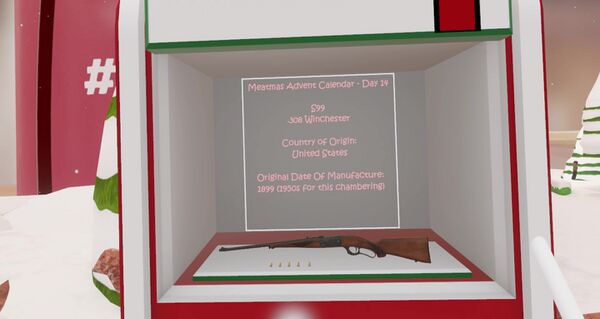
The Savage in its box, displaying a highly civilized level of concern for clarity regarding manufacture dates.
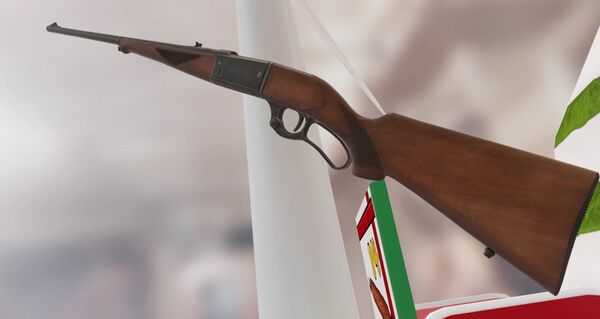
In fairness, "Savage" was just the company founder's name - Arthur Savage.
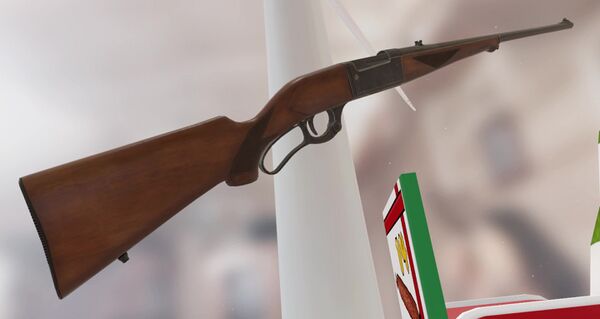
A man who, as a note of trivia, would go on to work in tire manufacturing, ultimately developing the now-standard radial tire. He had several ideas and business ventures, though guns and tires were by and large the most successful.

Getting back to the matter at hand, and opening up the action; note the distinct lack of a magazine tube follower or elevator...
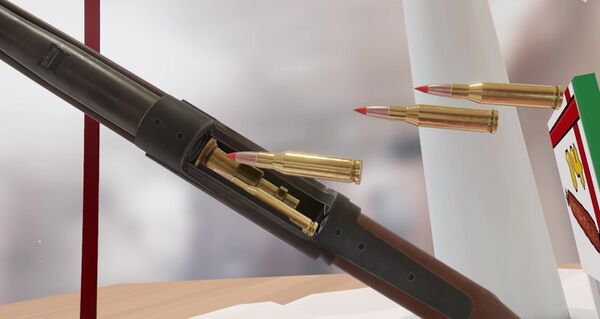
...since, unlike most of its lever-action contemporaries, the Savage 99 uses a completely different magazine system - a rotary box magazine, fixed into the receiver. This gave it the unique advantage of being able to chamber spitzer-pointed cartridges, including the much-later-offered .308 Winchester.

It also allowed for the addition of a convenient little round counter on the side of the receiver; this is directly connected to the central magazine rotor, functioning a bit like those rotary number counters on distance-measuring wheels and old odometers and whatnot.
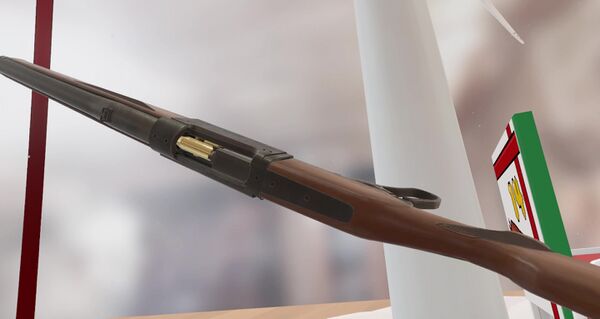
Of note is that this technically only counts how many rounds remain in the
magazine, not the number in the gun; as such, chambering the first round immediately takes it back down from 5 to 4.

Bringing the simple notch-and-post irons to bear on a crystal snowflake...
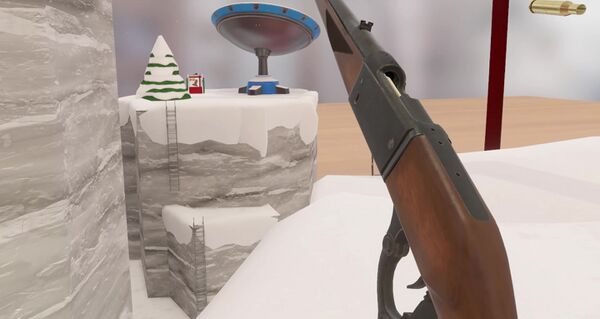
...and, having completely failed to get a good shot of it firing, quickly chambering a new round. Well, as quickly as the Savage's considerable lever-throw distance will allow, at any rate.
Sharps 1874 Long Range
The Sharps 1874 Long Range was added on day 6 of the Meatmas 2020 Advent Calendar event, chambered in the proprietary .45-110 Sharps cartridge.

Sharps 1874 Long Range rifle w/ 34" barrel, Vernier peep sight, and Lyman Beach front sight - .45-70 Government
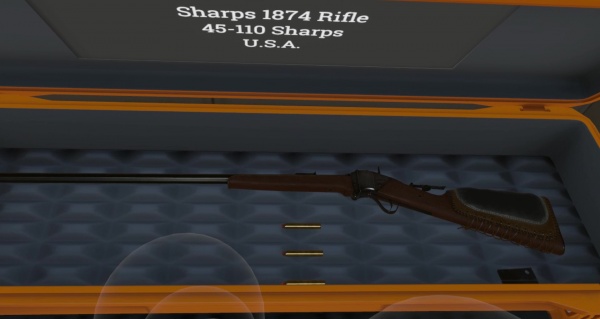
The Sharps' box. Not to be confused with an actual sharps box; this one's not full of biohazards. Probably.
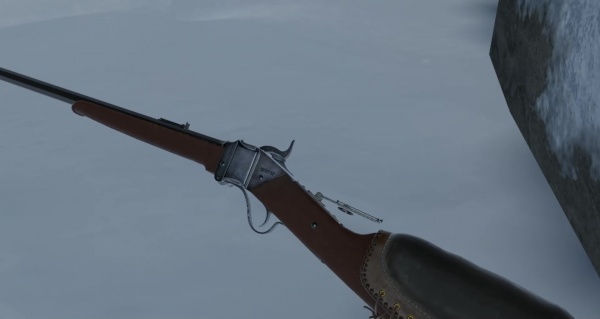
Taking a look at the rifle (or some of it at least - it's a rather difficult gun to fit on the screen); this set of shots was originally going to be just outside the bunker, but a missile-launching Swarm drone clearly didn't agree with that idea.
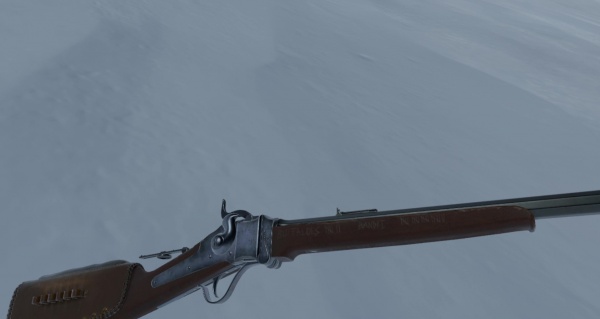
The other side; according to the tally marks scratched into the forend, the rifle's previous owner had taken seven buffaloes and twenty-two bandits with it.
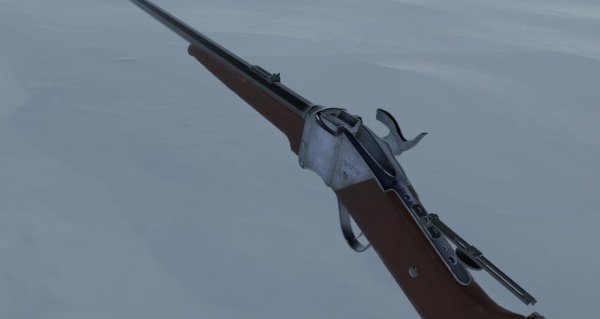
Cocking the hammer; there are some manufacturers' markings on the side of the receiver.
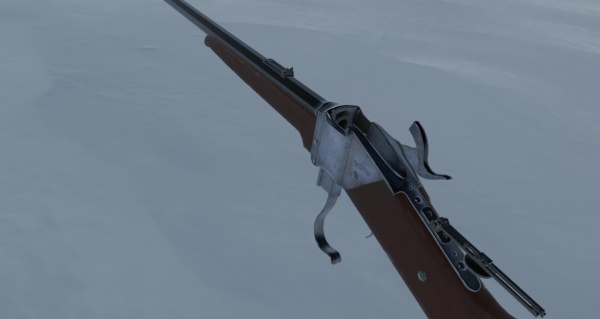
Opening up the rifle's falling-block action; this is based around a single touchpad click, constituting perhaps the strangest re-use of the
Orion Flare Gun's code to date.
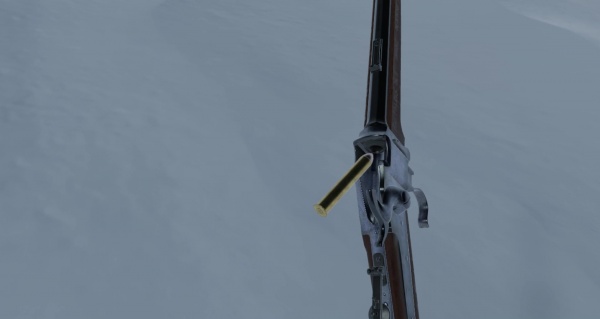
Loading in a single .45-110 Sharps cartridge - a tracer, to be exact. As a note of trivia, ".45-110" was never an official designation for the round (since the Sharps Rifle Company didn't tend to use blackpowder notation); it is instead derived from the factory loading of the .45 cal 2 7/8" Sharps round using 110 grains of black powder.
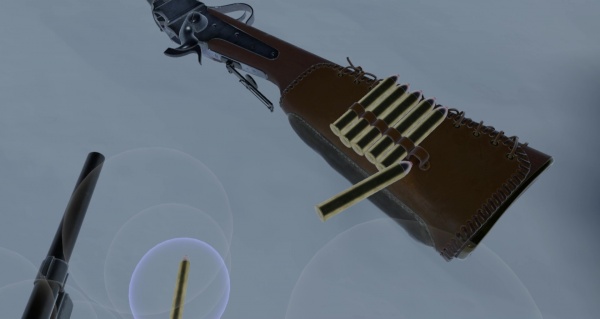
Shoving a few extra rounds into the loops on the Sharps' leather cheek rest. Notably, these rounds aren't quite lined up with each other; this is correct, as their rims would prevent them from sitting parallel side-by-side.

Trying out the notch-and-post irons on a snow-covered tree...

...before putting them to use against a Static drone; this produces far more smoke and recoil than drone fragments, unfortunately.
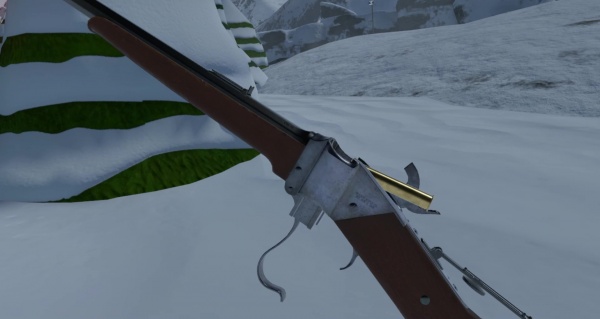
Opening the action again, and dumping out a spent case.
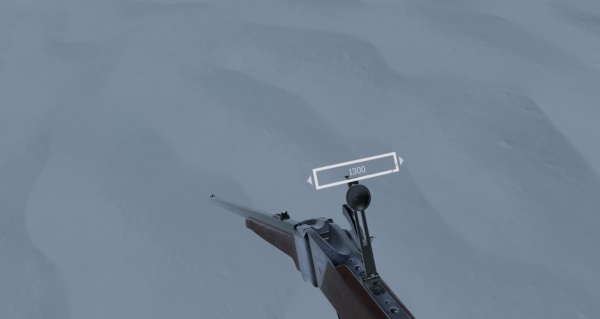
Should the standard irons prove insufficient for your purposes, the Sharps also features a stock-mounted flip-up aperture sight, adjustable out to an impressive 1,500 yards. Suffice to say, you'd have to be one impressive Sharps-shooter to make full use of it.
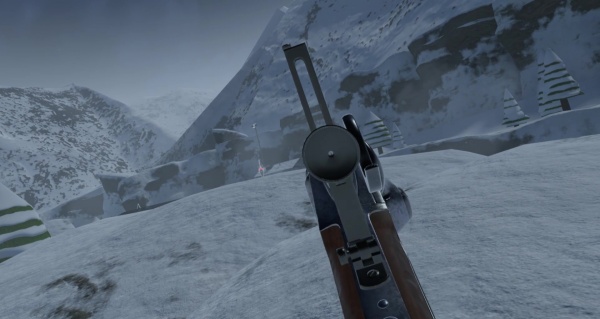
Trying to sight up an oblivious Junkbot with the aperture sight. Keyword being "trying"; while the small aperture has its uses, tracking moving targets as a relatively short distance isn't one of them.
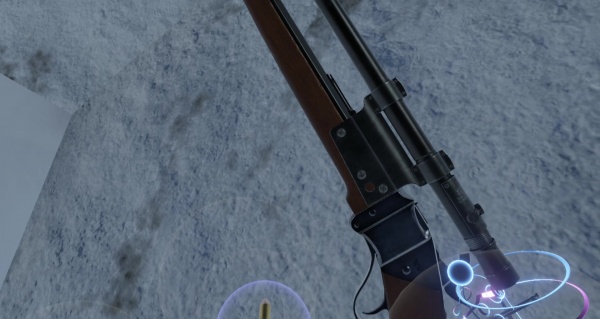
If irons aren't your cup of tea, why not try an optic? I mean, it comes with a Weaver 330 scope for a reason.
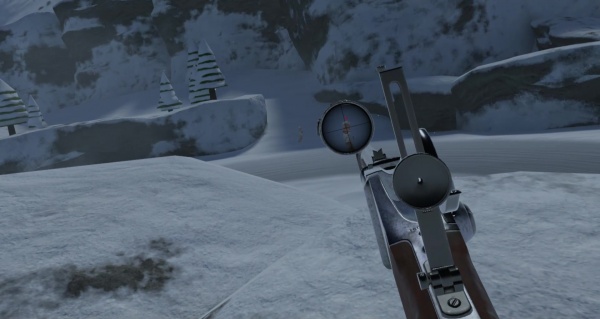
And that reason still isn't close-range combat.
SKS
The SKS is one of the available carbines in-game (added through Update #18), and is fitted with a Tapco stock and converted to use 20-round detachable magazines. With the release of Update #42, it was granted the ability to use 10-round stripper clips. Update #54 added a classic, non-Bubba'd variant of the rifle, much to the relief of milsurp purists everywhere; the addition of bayonets in the 1st alpha build of Update #76 gave the latter variant its integrated folding bayonet, bringing yet further applause.

SKS with aftermarket Tapco Intrafuse Stock System furniture - 7.62x39mm
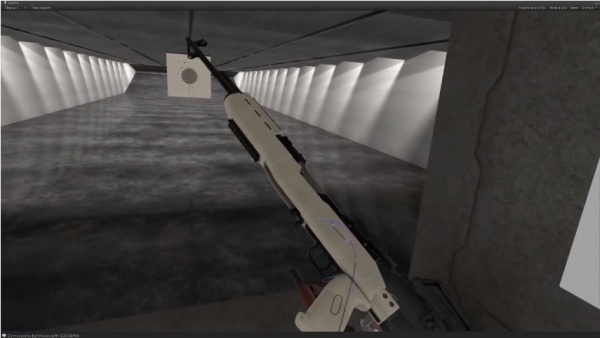
Examining the SKS. The bayonet was sacrificed to the benign Tapco gods in the sky; may they spare our milsurps the same fate.
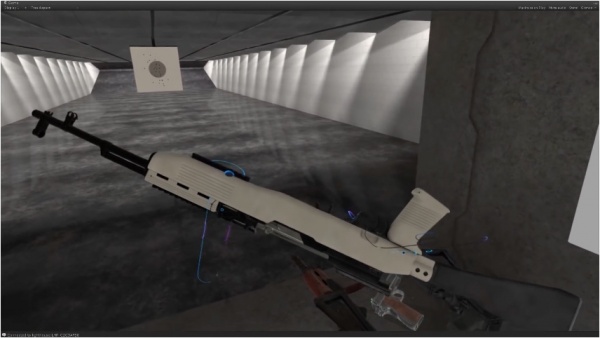
A more clear look at the rifle, which shows that it, unlike the reference image, has a solid polymer stock. Said stock is a different color than the rest of the rifle. The Tapco gods work in mysterious ways.
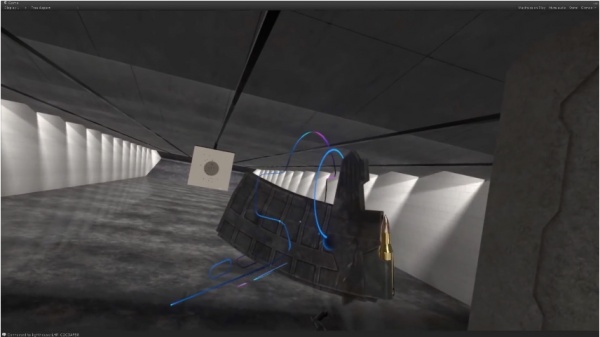
A closeup of one of the rifle's detachable 20-round magazines.
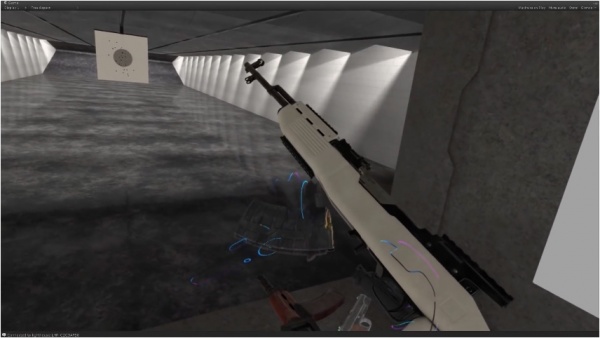
Loading in the aforementioned magazine.
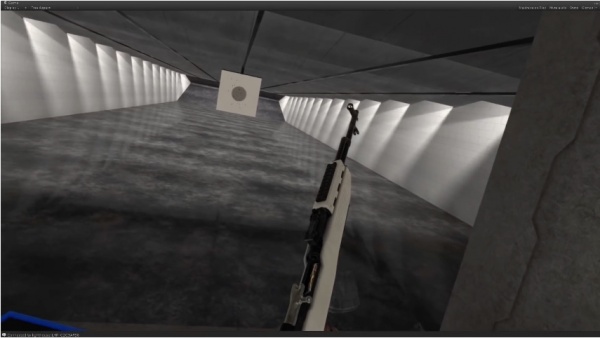
Chambering a 7.62x39mm round.
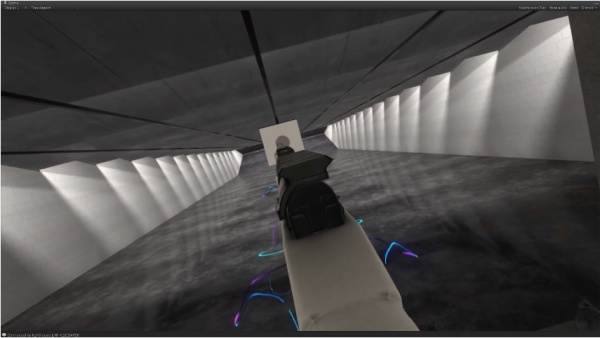
Making an effort to line up the sights...
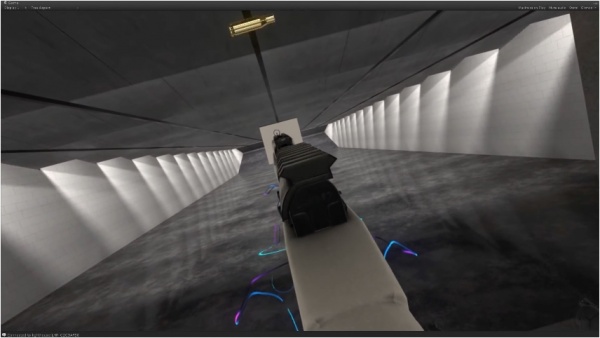
...and letting a round fly.
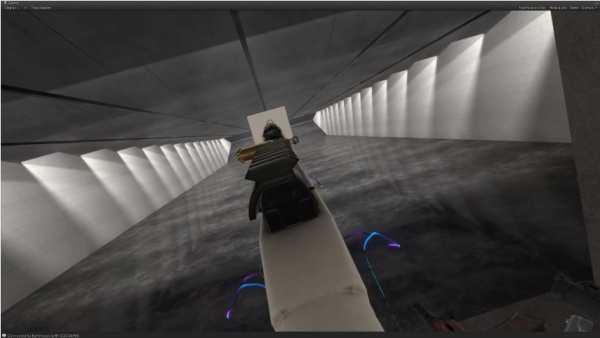
Rather amusingly, ejected casings from the SKS go straight up, and fall straight back down, often directly onto the rifle itself, as seen here.
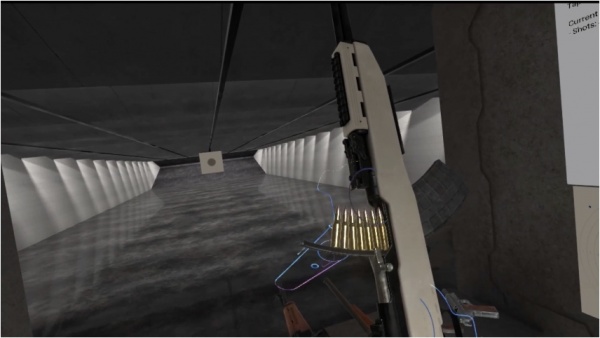
Doing something with the rifle it was actually intended to do, and reloading with a 10-round stripper clip.
Classic
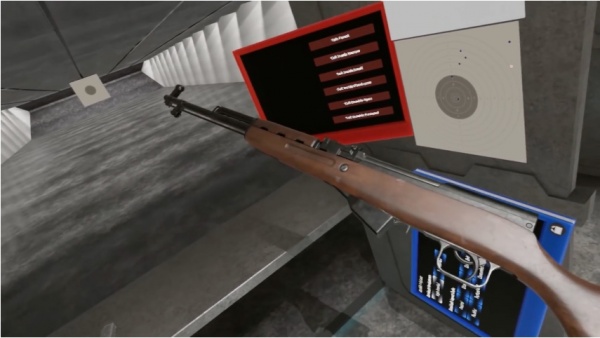
At long last, a classic, vanilla SKS for all of us to enjoy.
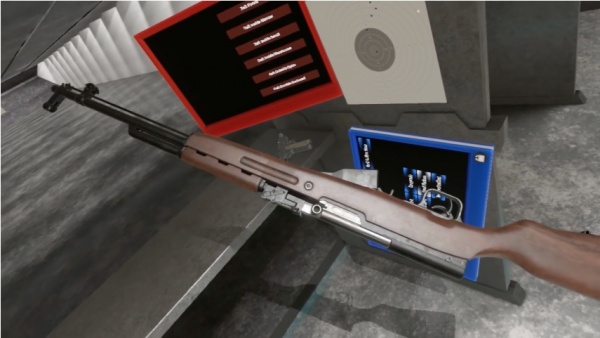
Some might say that vanilla is bland, but at least it tastes better than plastic.
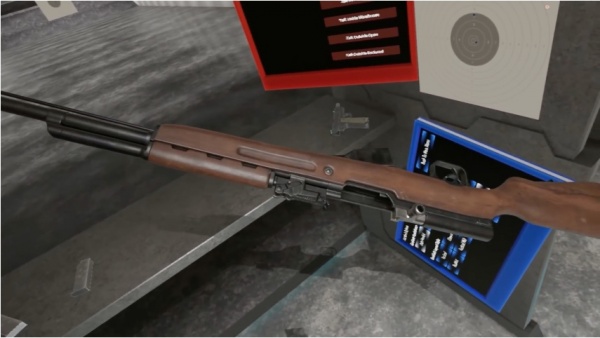
Locking open the rifle's bolt...
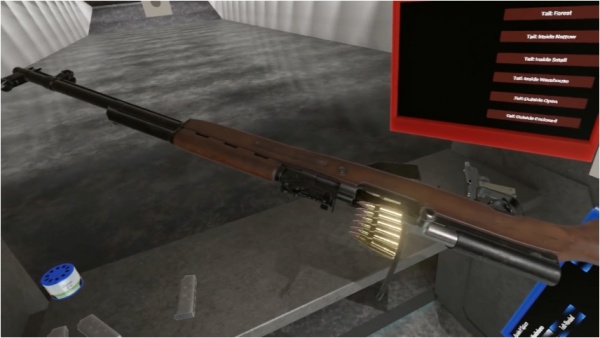
...pushing 10 rounds out of a stripper clip...
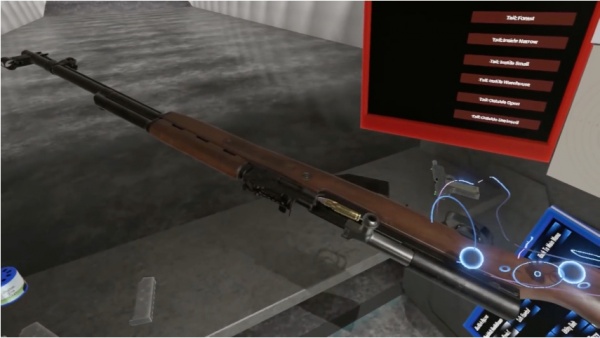
...and letting the bolt slam into battery.
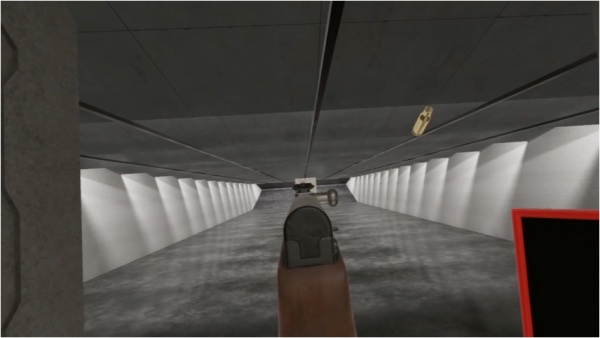
Taking a few potshots at the target.
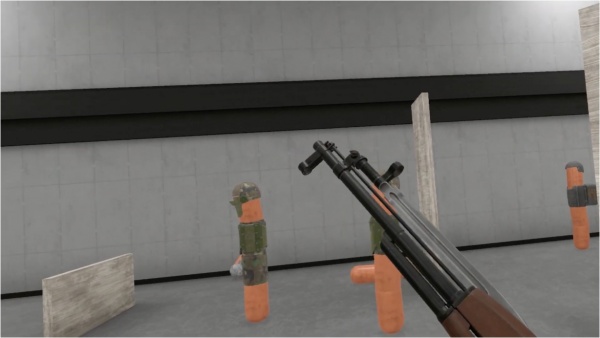
The updated SKS, folded bayonet and all. It can actually be used to slash enemies in this state...
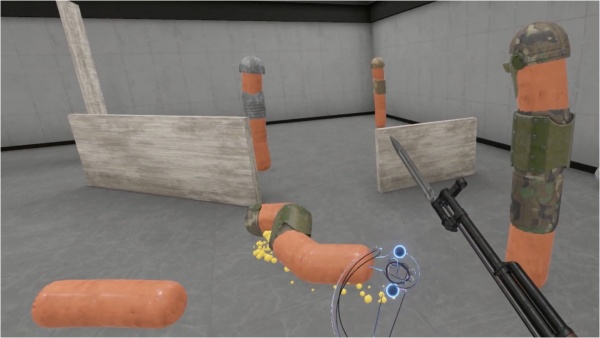
...though, as with many things, it's more useful when pointed
away from the user.
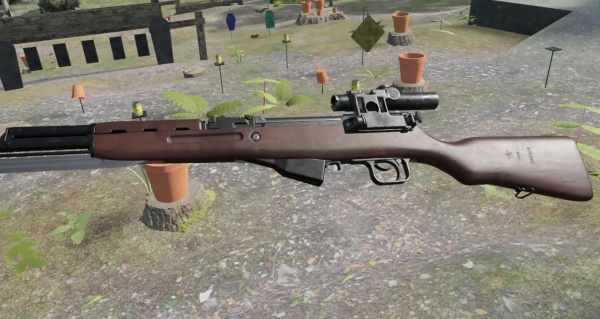
For those who want a little more range, a later update added the ability to mount the
Mosin-Nagant's PU scope on the SKS; this is a rather common modification IRL, though it was never done officially. The safety's also on, for what it's worth.
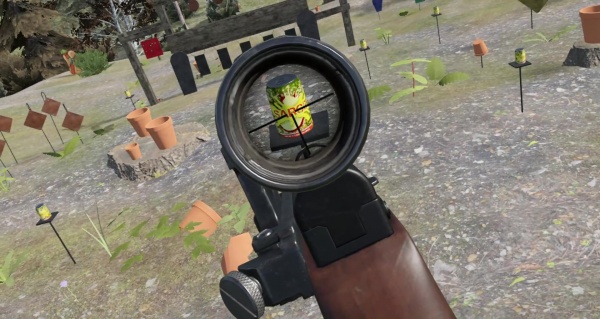
Taking full advantage of the added magnfication, and aiming at a soda can 6 feet away.
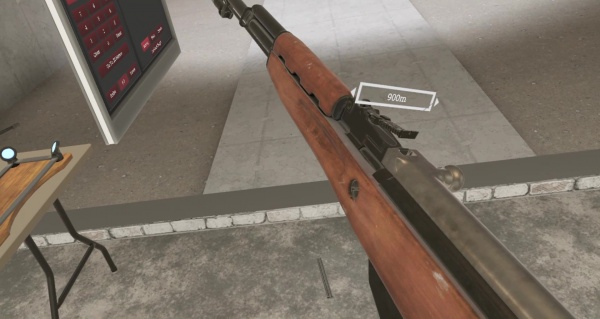
The classic SKS was another rifle that got an adjustable rear sight in Update #94; being chambered for a smaller, weaker cartridge than its 7.62x54mmR predecessors, it is "only" adjustable out to a kilometer.
Thompson Light Rifle
The Thompson Light Rifle, a prototype version of the M1928A1 Thompson submachine gun chambered in .30 Carbine, was added to the game in the 11th alpha of Update #52. It was developed for the US Light Rifle Program (which would eventually result in the adoption of the M1 Carbine), but was near-immediately rejected for being too heavy (over 10 lbs (4.5 kg), compared to the stated maximum of 5 lbs (2.3 kg).

Experimental Thompson "Light Rifle" Carbine - .30 Carbine
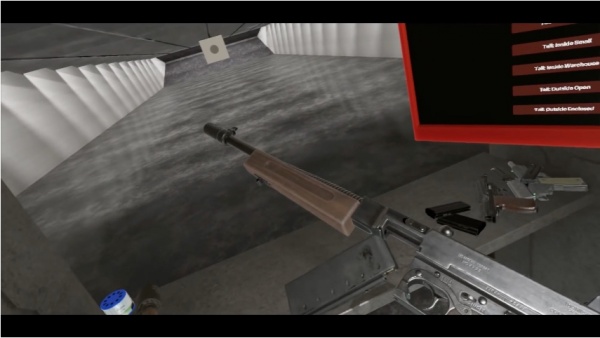
Loading a magazine into the Thompson, at an angle that is unlikely to result in anything good.

What a beautiful reject. Well, one man's trash is another man's inordinately heavy treasure.
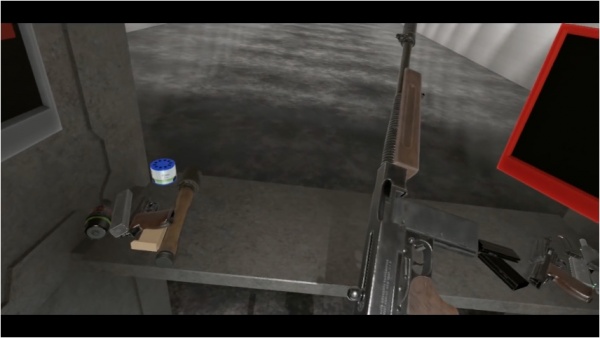
Pulling back the charging handle.
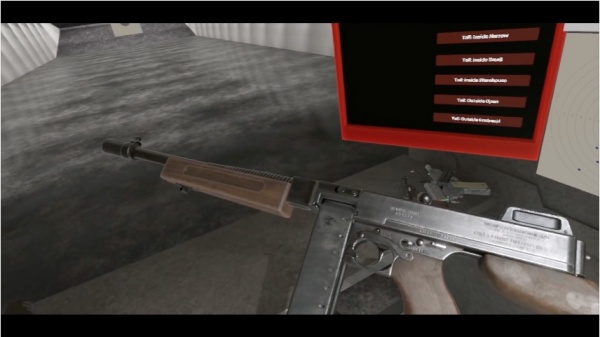
Flipping the safety to "FIRE"...
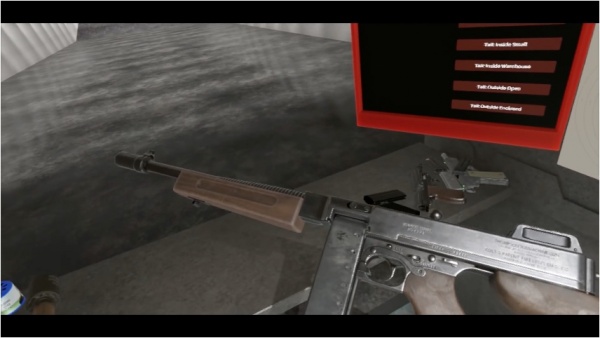
...and the selector to "FULL AUTO".
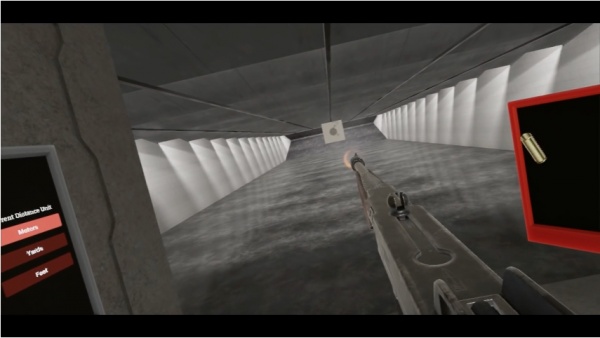
Firing the Thompson Carbine. With a high rate of fire and a 20-round magazine, it runs out of ammo pretty quickly.
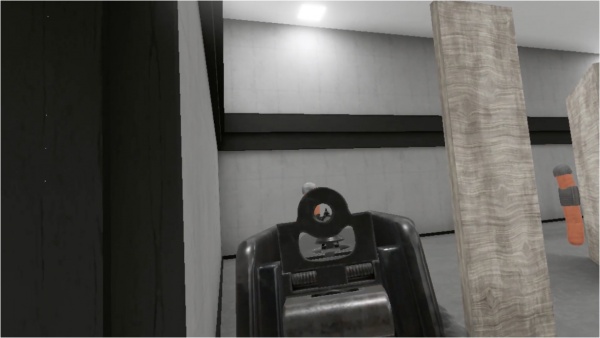
Giving the irons a try. Unlike the M1928 in-game, the Carbine's rear sight has its aperture flipped up.
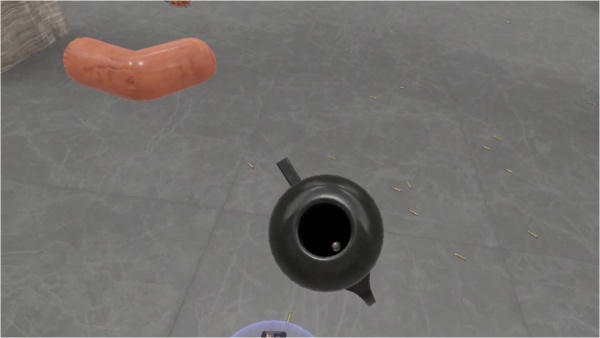
...before performing what is quite possibly the world's single most inadvisable brass check.
Winchester Model 1873
The Wurstworld update brought along a Winchester Model 1873 lever-action rifle, chambered in .45 Long Colt (a caliber not initially offered in the 1873, though it is available in modern reproductions; this does make some sense when one takes into account what Wurstworld actually is). 2 variants were initially available (a "Trapper" carbine and a longer short rifle); a "Mare's Leg" sawn-off variant was added later. All of the rifle's variants have buckhorn sights and octagonal barrels.

Winchester Model 1873 "Trapper" Carbine (Uberti reproduction) - .44-40 Winchester
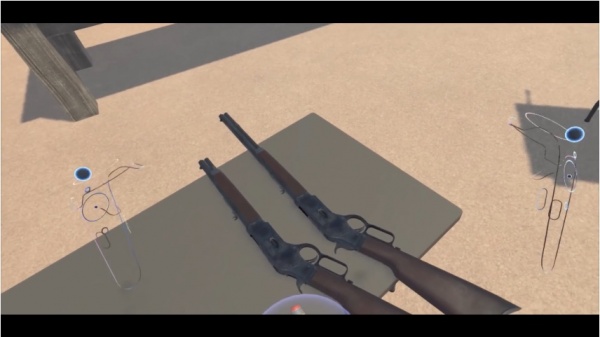
The two Winchesters, lying on a table.
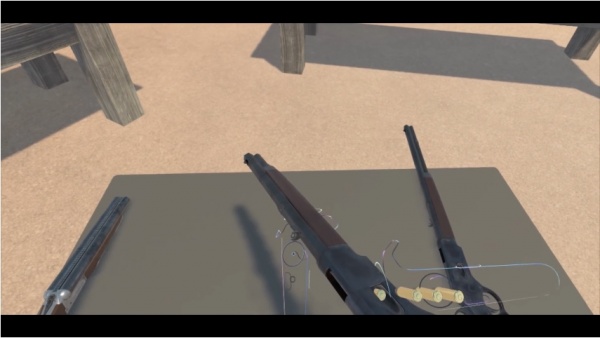
Loading in some rounds. Visible here is the game's round-palming mechanic; one can pick up multiple of the same type of round in one hand, which creates this orderly, self-advancing stack of cartridges.
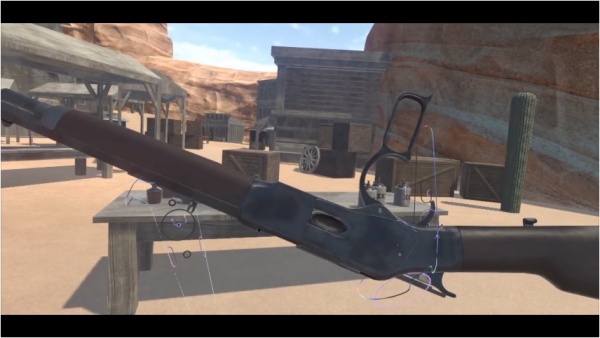
Chambering the first round in the 1873, upside-down.
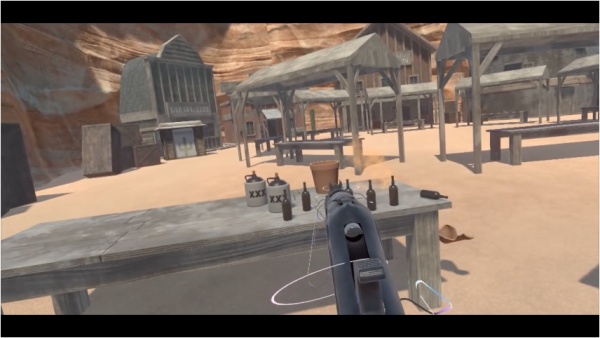
Taking aim at a clay pot, which gives a view of the rifle's buckhorn sights.
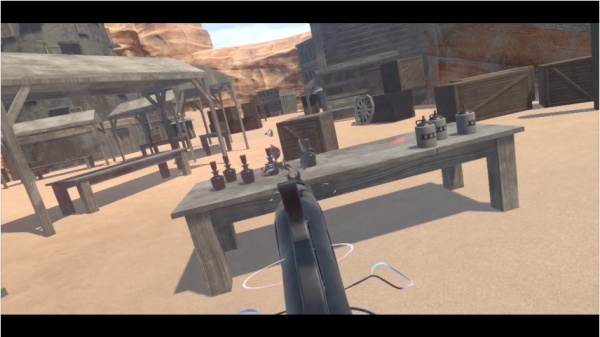
Shattering a decanter. Note the red streak to the right of the destroyed hooch-holder; this is a tracer round flying through the air. Tracer rounds are available for nearly all calibers in
H3.
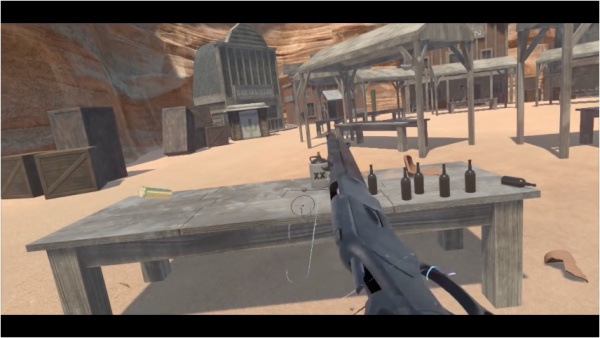
Working the rifle's action, ejecting a spent case and moving on to continue the glassacre.

Winchester Model 1873 Short Rifle - .44-40 Winchester
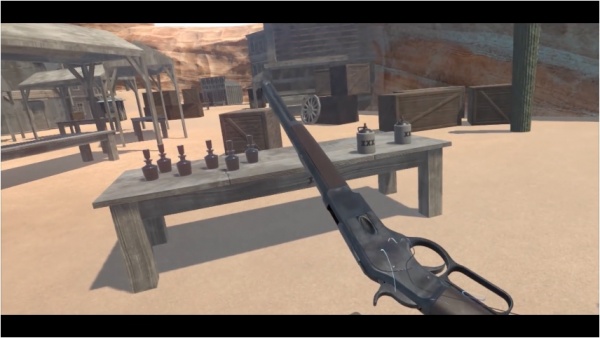
Examining the longer version of the rifle...
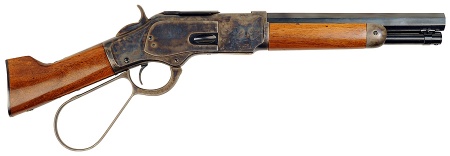
Screen-used Winchester Model 1873 "Mare's Leg" with octagonal barrel, extended lever loop, and case-hardened receiver, used in the movie
Wild Wild West.
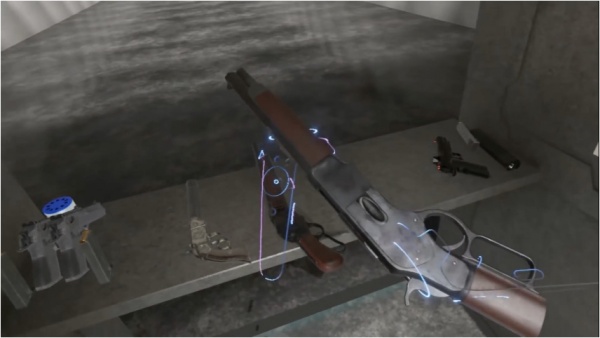
...and the shorter one, in a different place and a different time.
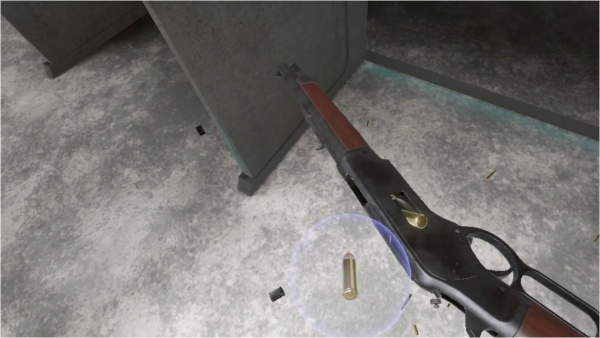
Loading the cut-off 1873; note that the loading gate is correctly shown as a separate, moving part.
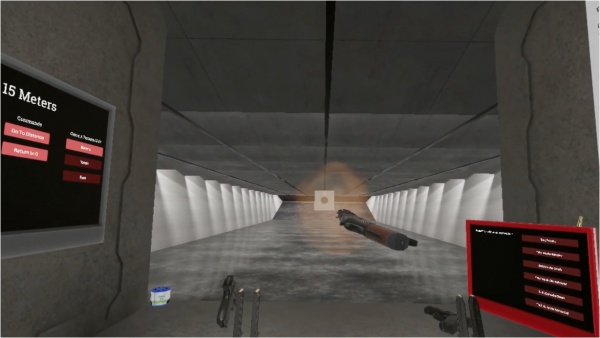
"So, when you say that you're part of a gang, do you mean, like, an inner-city street gang, or, like, a stagecoach-robbing bandit gang?"
"Yes."
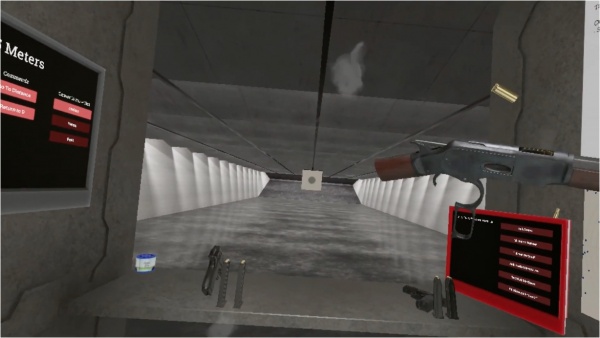
After this brief discussion comes the grand levergun tradition of breaking all your fingers - now, like the prior shooting, at a frankly absurd-looking angle.
Winchester Model 1892 "Mare's Leg"
A "Mare's Leg" configuration of the Winchester Model 1892 was added on Day 3 of the Meatmas 2022 advent calendar event.

Replica Winchester 1892 "Mare's Leg" - .44-40 Winchester
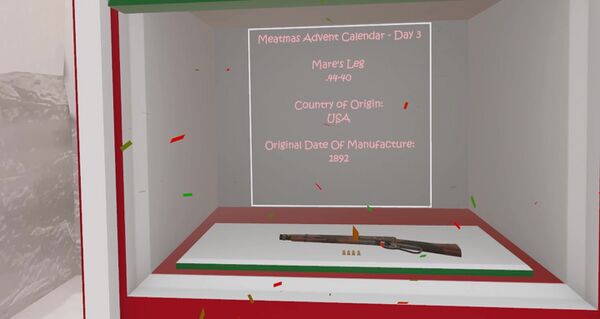
The cut-down levergun in its box; it is referred to simply as the "Mares <sic> Leg" here, though the production date gives its actual model number. Ah, the simple times, when those two things were one and the same...
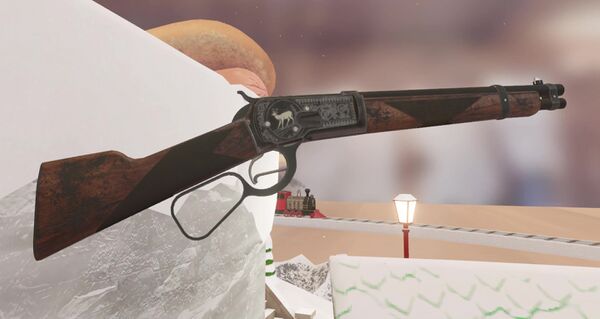
Pulling the Model 1892 out of its box, and giving it a quick once-over. It's a rather nice rifle.
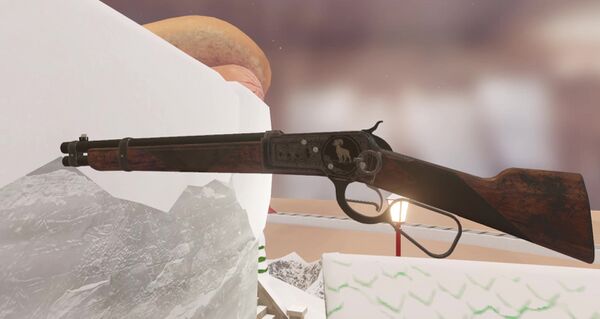
Or rather, it was cut down from one, unless someone decided to put hunting-style engravings on a cut-down pseudo-sidearm. Which, given that someone decided to put a seemingly-random metal bar into the trigger guard, could be the case - this bar serves no clear purpose, though it could conceivably be a screw-in trigger pin (a modification which, when screwed in far enough, pulls the rifle's trigger every time the action is closed, removing the need to actually fire each shot manually) that isn't screwed into its auto-firing position.
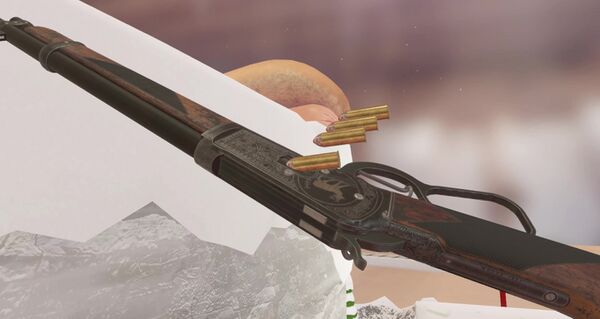
Cramming in some .44-40 cartridges - the tube holds 8, with a ninth in the chamber for those inclined.

Regardless of one's inclination, the gun won't exactly be all that useful with a full tube and an empty chamber. Working the action has two distinct phases - first, the locking bars descend...

...and then the bolt itself moves back. This system, originally used on the
Winchester Model 1886, was devised by John Moses Browning to address the inadequate locking strength of the simple toggle-joint systems used in prior Winchesters, allowing for more powerful cartridges to be used.
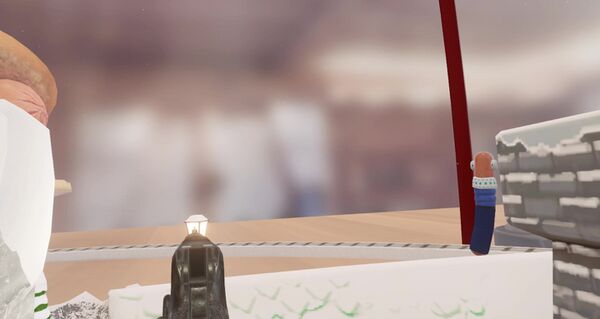
Aiming at a lamppost, in the hopes of forcing it to explain why its light is always on in broad daylight; while it would make sense for a cut-down rifle to have only one of its iron sights left, the fact that the front sight is the one still present is about two paces short of baffling - the portion of the barrel that's been cut away doesn't include the rear sight, so this modification would require either that the front sight be reinstalled on the new end of the barrel and the rear sight deliberately removed, or that the front end of the barrel be re-tooled to include receiver threads and a new chamber (a far more in-depth modification than simply retaining the back end of the barrel and re-crowning the new front - or simply re-mounting the rear sight, for that matter).
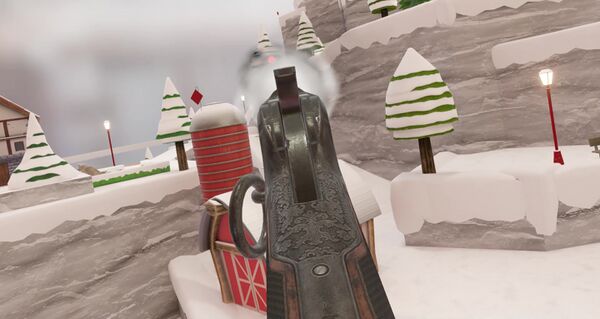
The practical upshot of all this sight-related tomfoolery is that the 1892 is incredibly difficult to actually aim; the fact that the hammer comes up after every shot and blocks the sight picture doesn't help, though this is the case for full-length variants as well (deliberately, to prevent any attempts at lining up a shot when the gun isn't actually ready to fire).
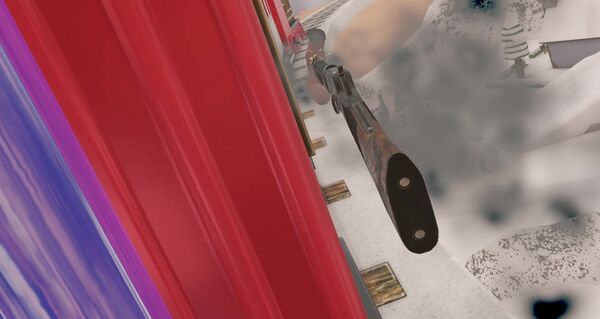
Then again, it's not like a Mare's Leg is really meant for long-range precision work, anyway. This seems a fair bit more appropriate.
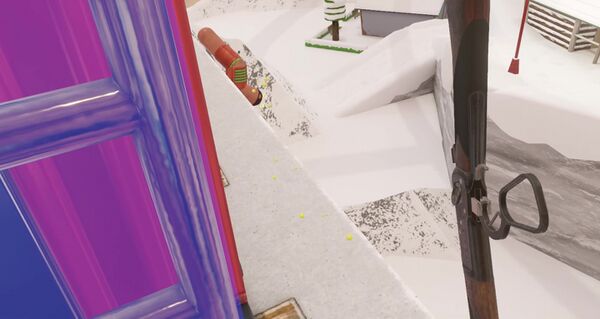
And no, in case you're wondering, this isn't as satisfying as it looks.
It's way,
way better. Seriously, if you haven't flip-cocked a lever-action and head-shotted a Sosig one-handed while hanging off the back of a moving train with the other hand, you haven't truly lived.
Winchester Model 1894
The 2018 4th of July Update (Update #56) added the quintessentially American Winchester Model 1894. It has a 10-round capacity, and is chambered in .44 Magnum (one of the numerous cartridges that the 1894 has been offered in).

Winchester Model 1894 - .44 Magnum

Admiring the Winchester's receiver. A thing of true beauty, that's for sure.
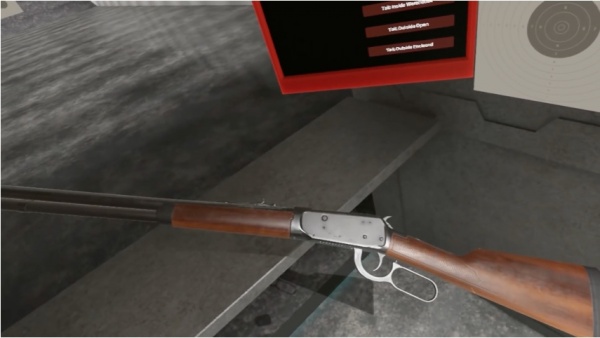
A look at the rifle's other side, which also shows off more of the stock and barrel.
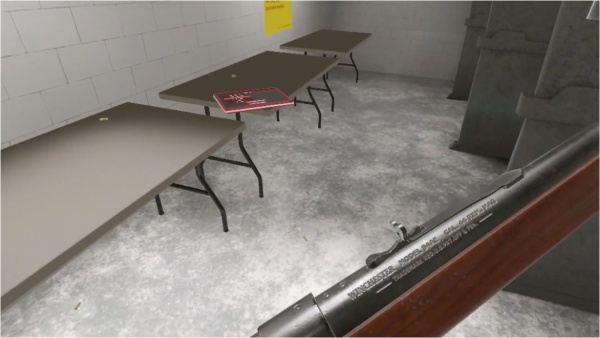
A close-up of the barrel, which shows off the rather detailed (and, interestingly enough, entirely un-obfuscated) markings; these read "WINCHESTER MODEL 94AE CAL. 44 REM. MAG" on the first line, and "TRADEMARK RED.U.S.PAT.OFF & PEN." on the second. The "AE" suffix in the model name is short for "Angle Ejecting"; this denotes that the rifle ejects upwards at an angle (rather than straight up), to allow for the use of a center-mounted scope. These markings have since been removed.
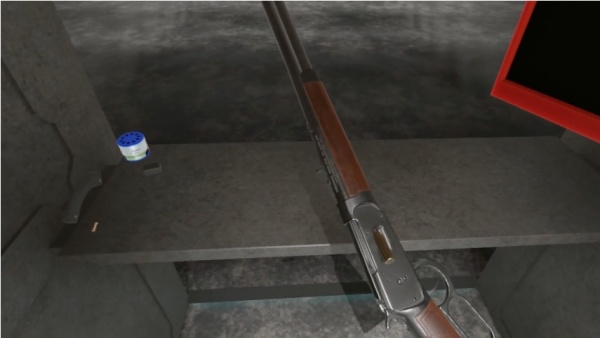
Loading in some .44 Magnum rounds.
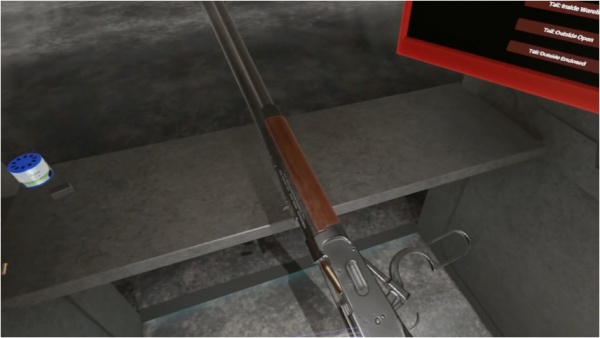
Chambering one of the aforementioned rounds. Note the pivoting baseplate of the receiver; this feature distinguishes the 1894 from the earlier
Model 1892, which was more or less externally identical, but used shorter, smaller rounds; the pivoting baseplate was John Browning's solution to the issue of getting enough action travel distance to chamber and eject longer, larger rounds while maintaining the same receiver dimensions as the 1892.
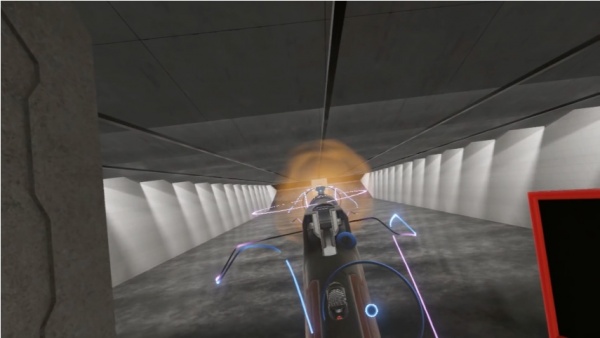
...and firing a shot, which somehow generates enough force to cause the user's controller outlines to spontaneously appear.
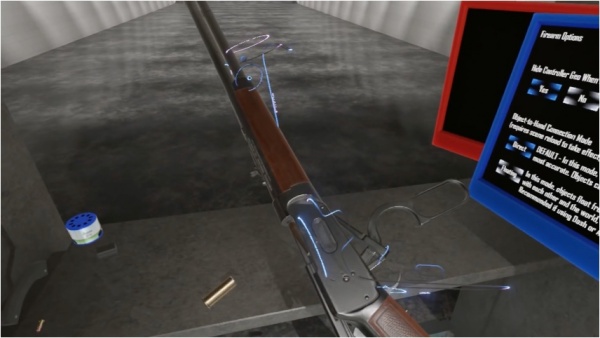
Deciding to just roll with it, USER_k0wboi ejects a spent case, and readies another round.

He then demonstrates something else interesting; y'know that whole "flip-cocking" thing that people do with cut-down lever-actions?
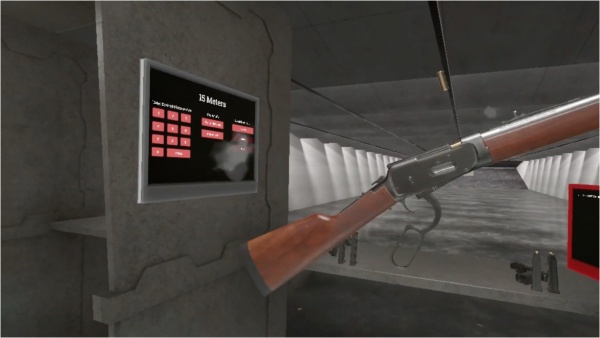
It works with full-length ones, too.
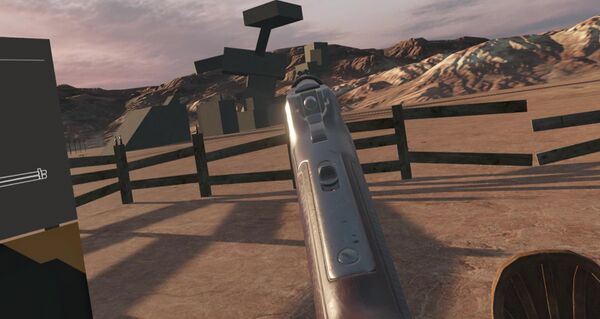
A fair bit later on, and in a substantially different locale, a slightly different 1894 makes its presence known; "slightly different", in this case, refers to the now-simpler u-notch rear sight, which replaced the earlier, less clear rear sight that the original model had.
Winchester Model 70
A pre-1964 Winchester Model 70 chambered in .30-06 was added in Update #52.

Pre-1964 Winchester Model 70 w/scope - .30-06 Springfield
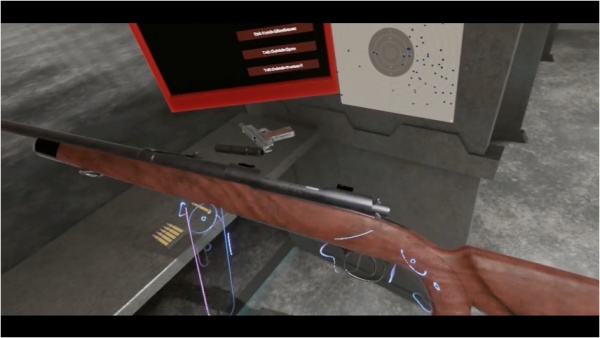
Taking a look at the left side of the Model 70...
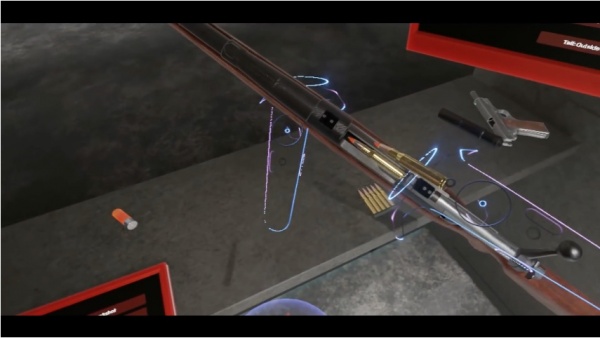
Loading in some rounds. The red tips on the rounds indicate that they are tracers.

Aiming the M70, after turning off the safety.
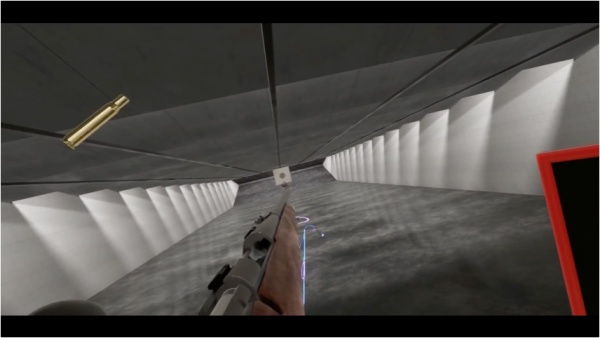
Cycling the rifle's action, and ejecting a spent case.
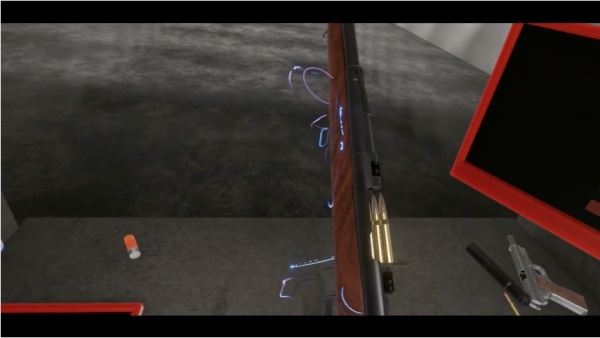
Loading the rifle again, this time with a stripper clip.











































